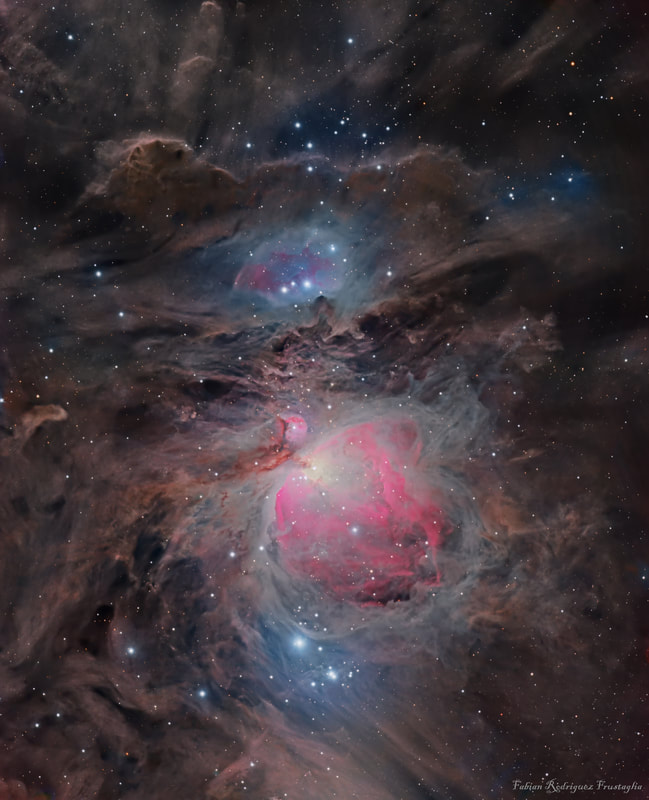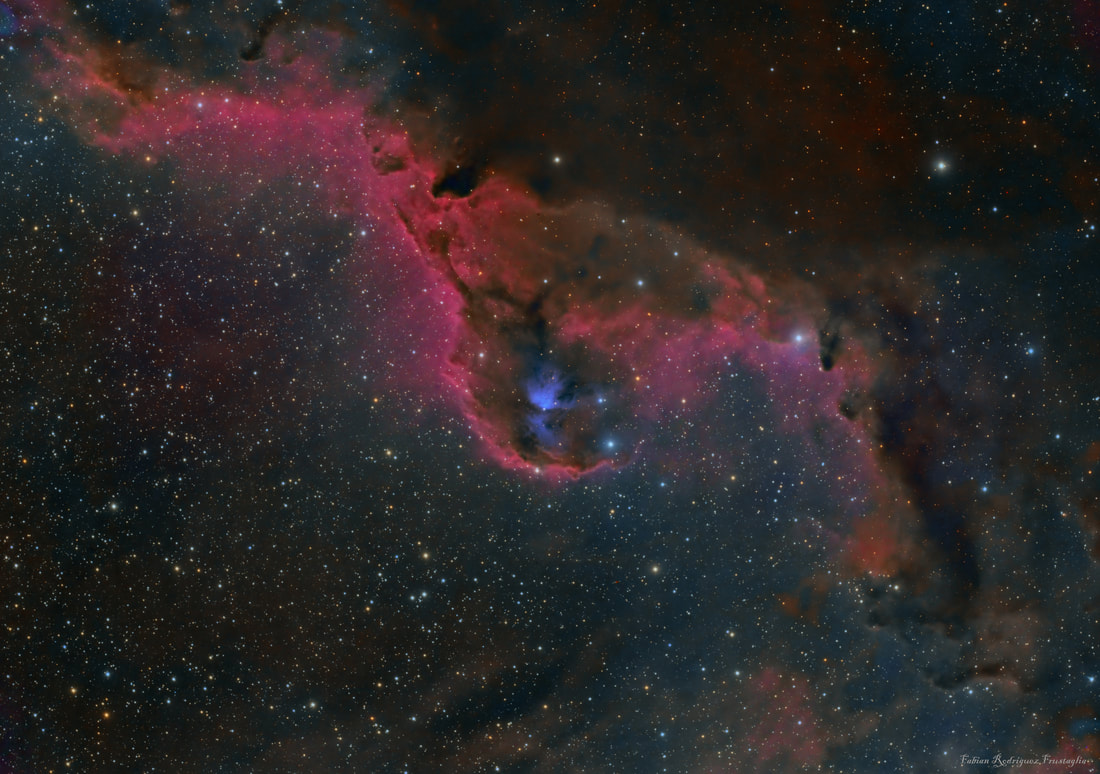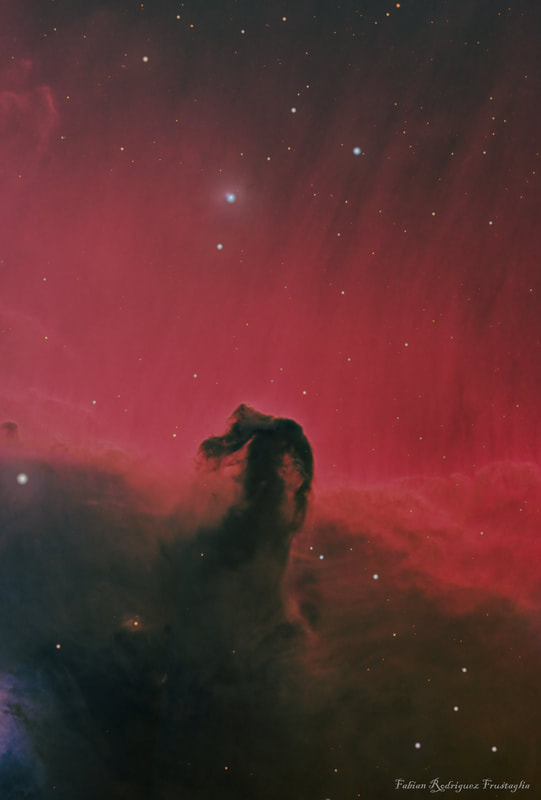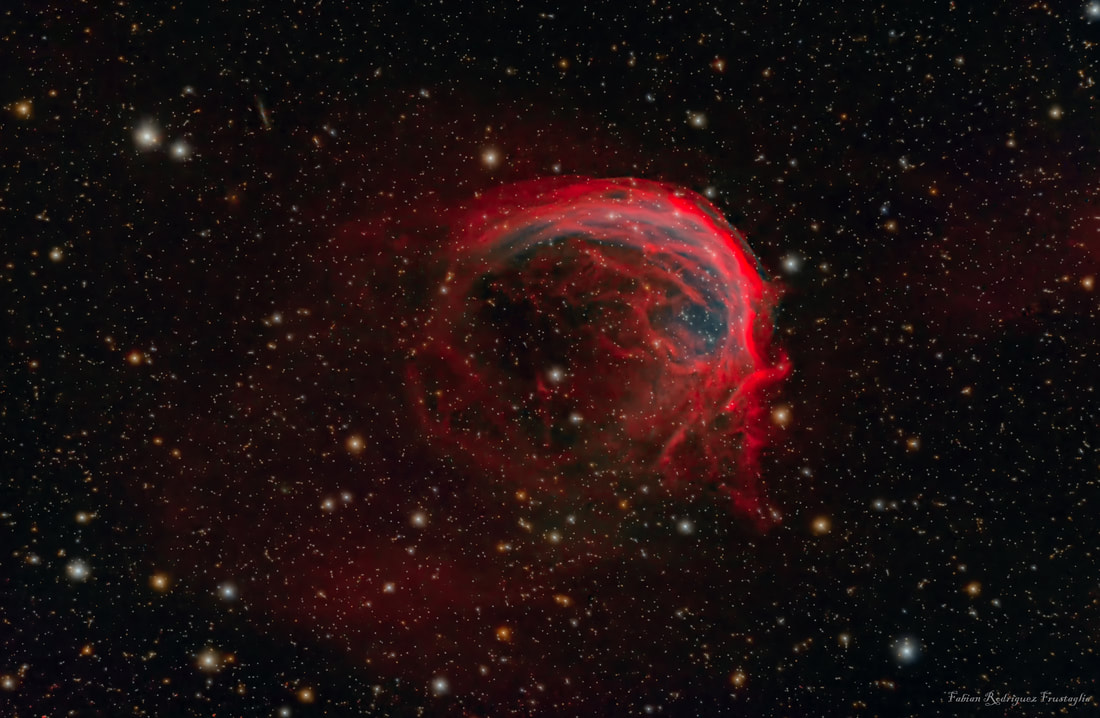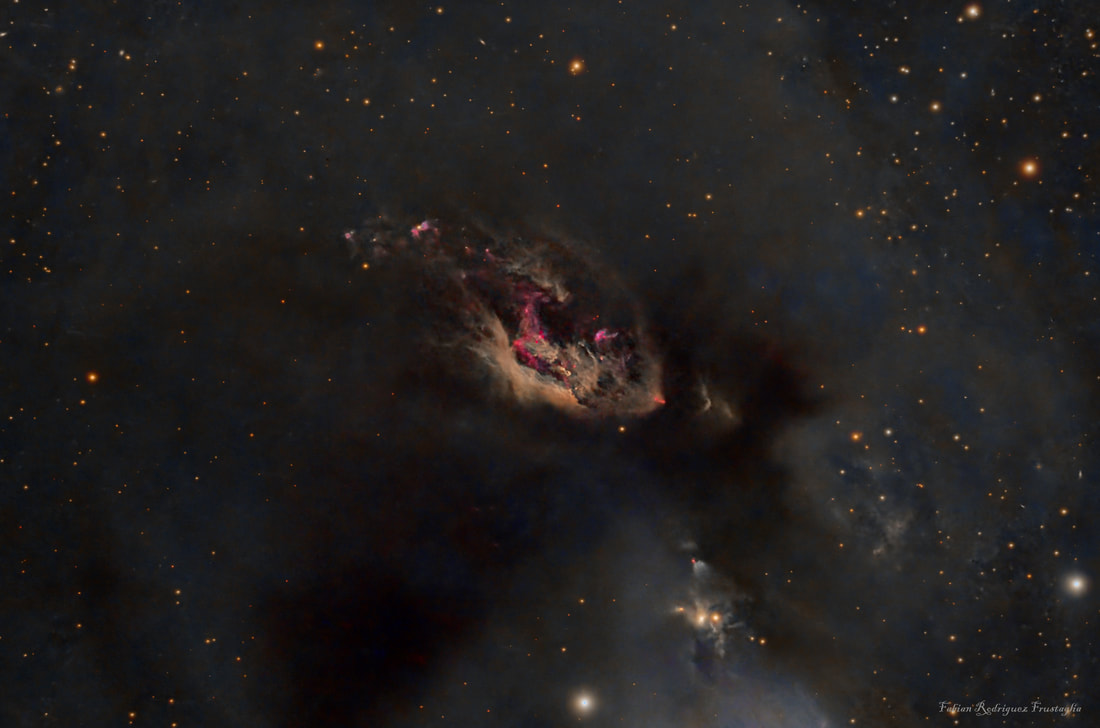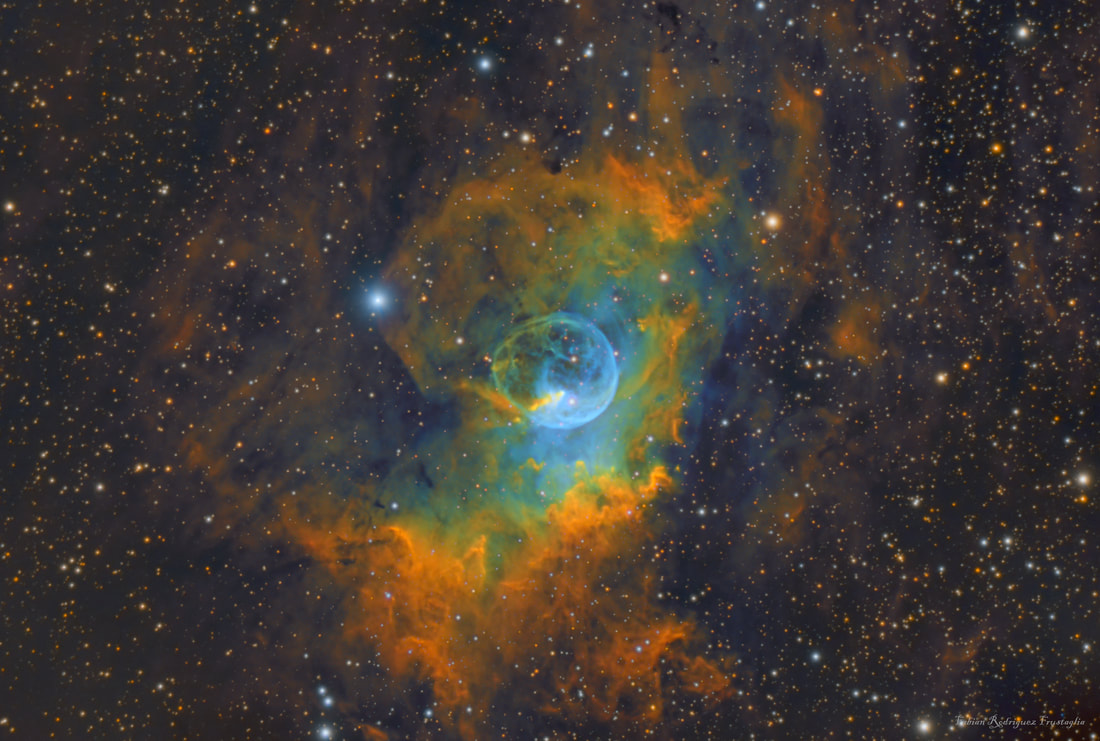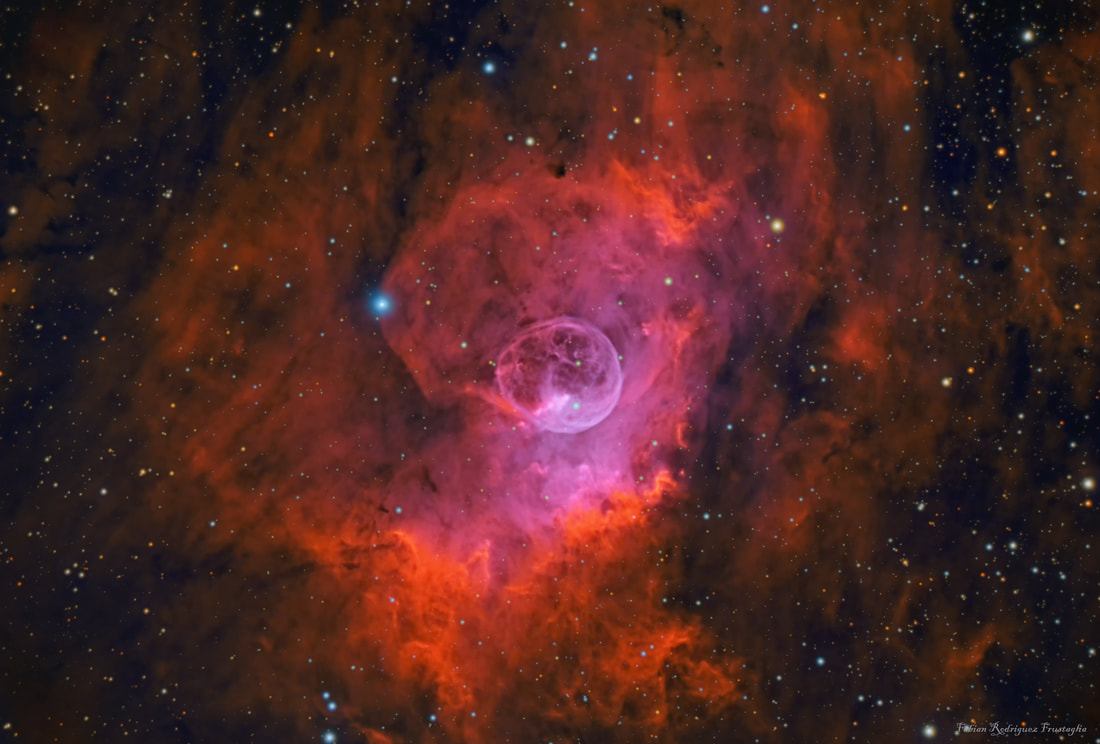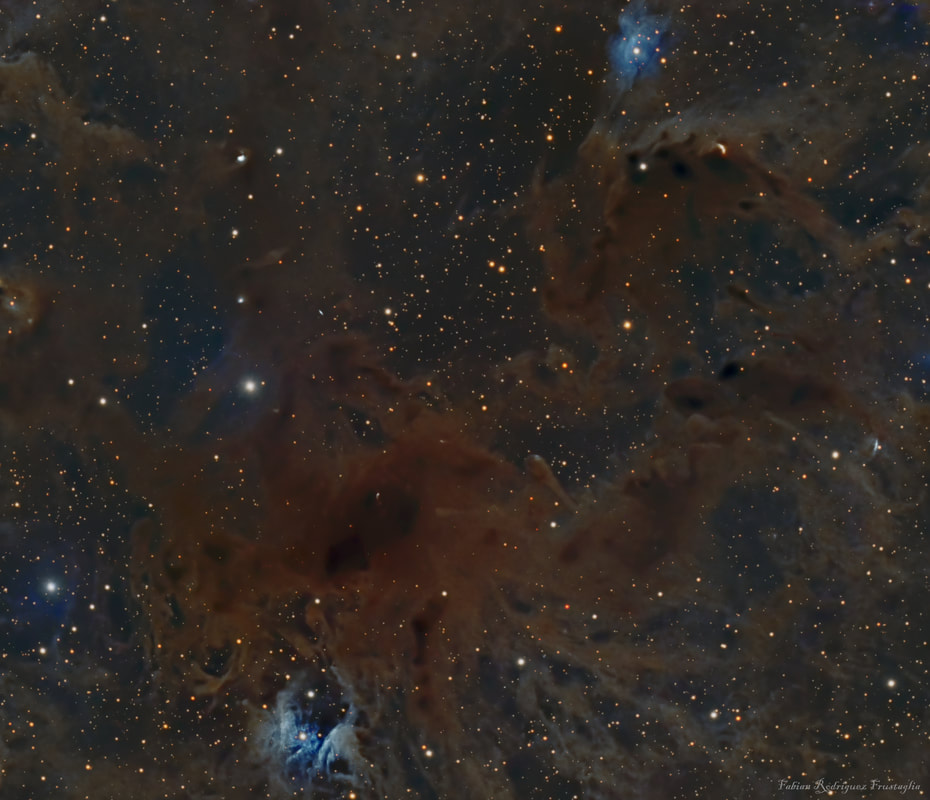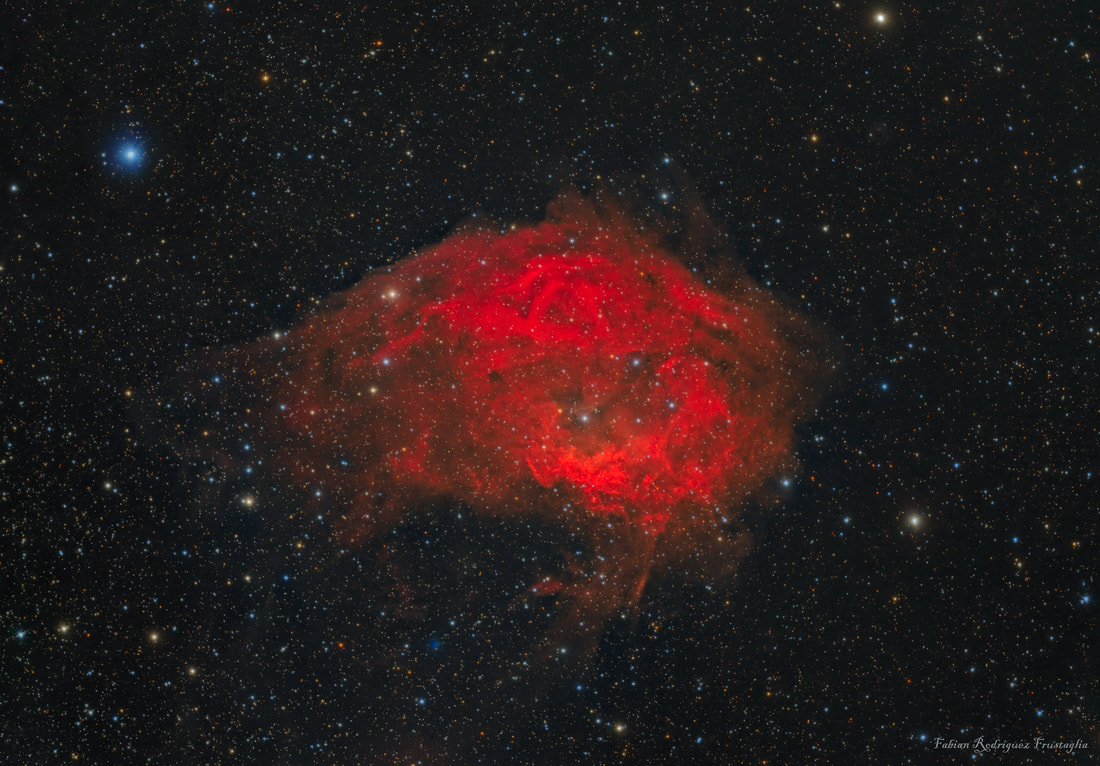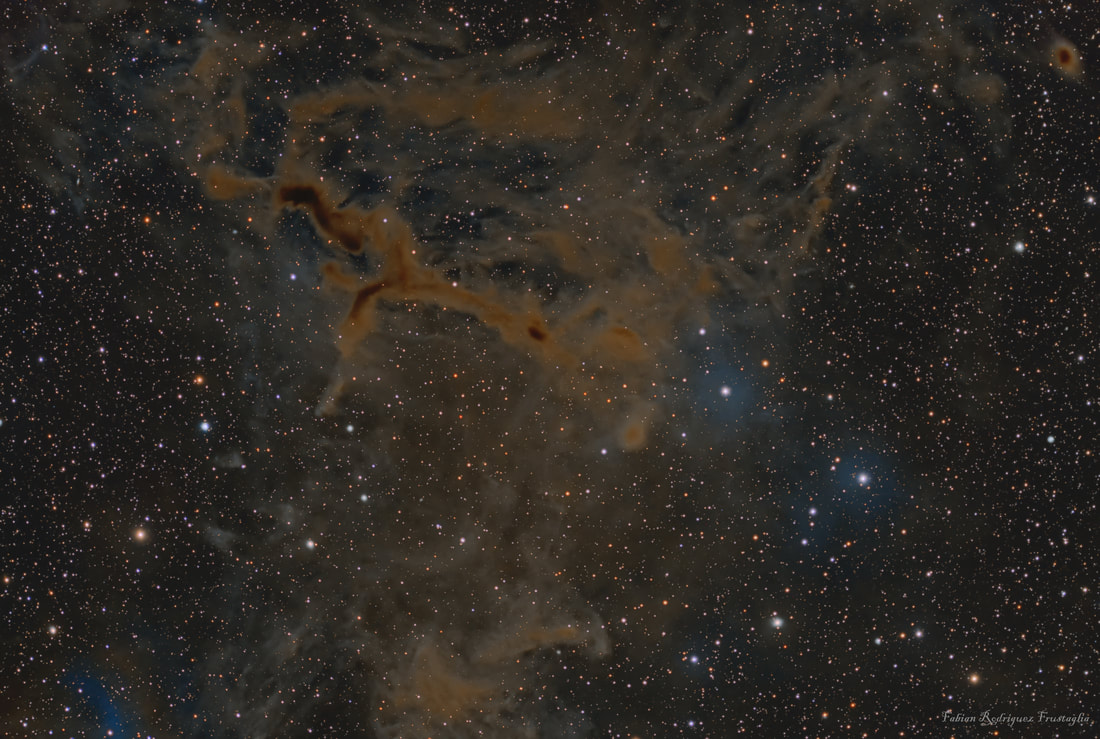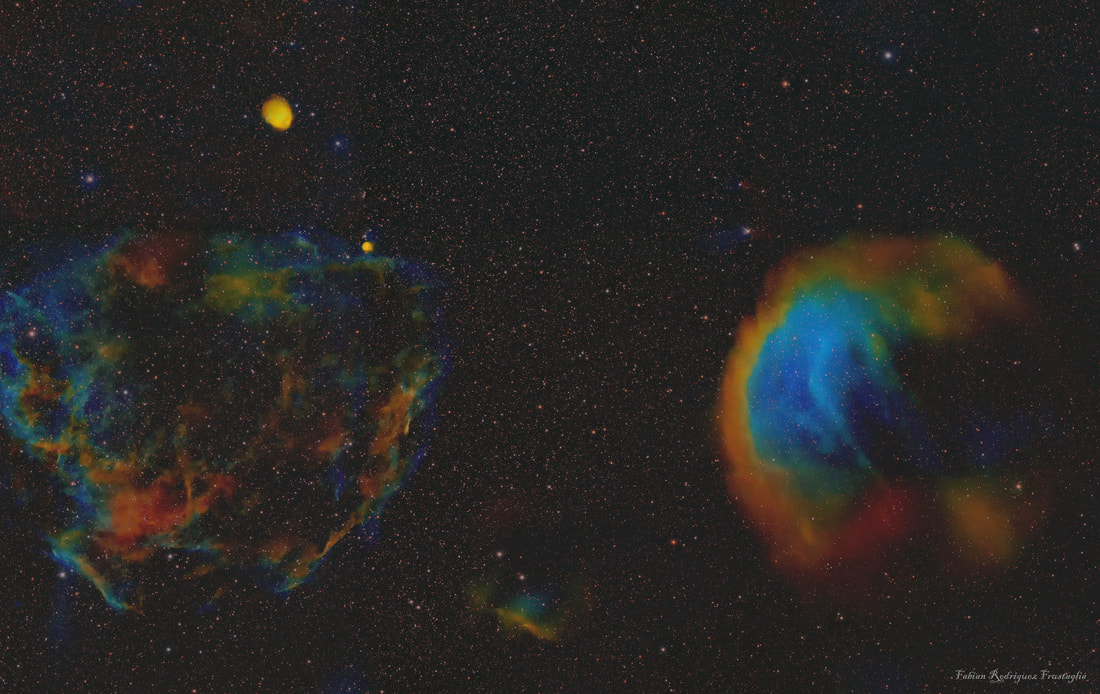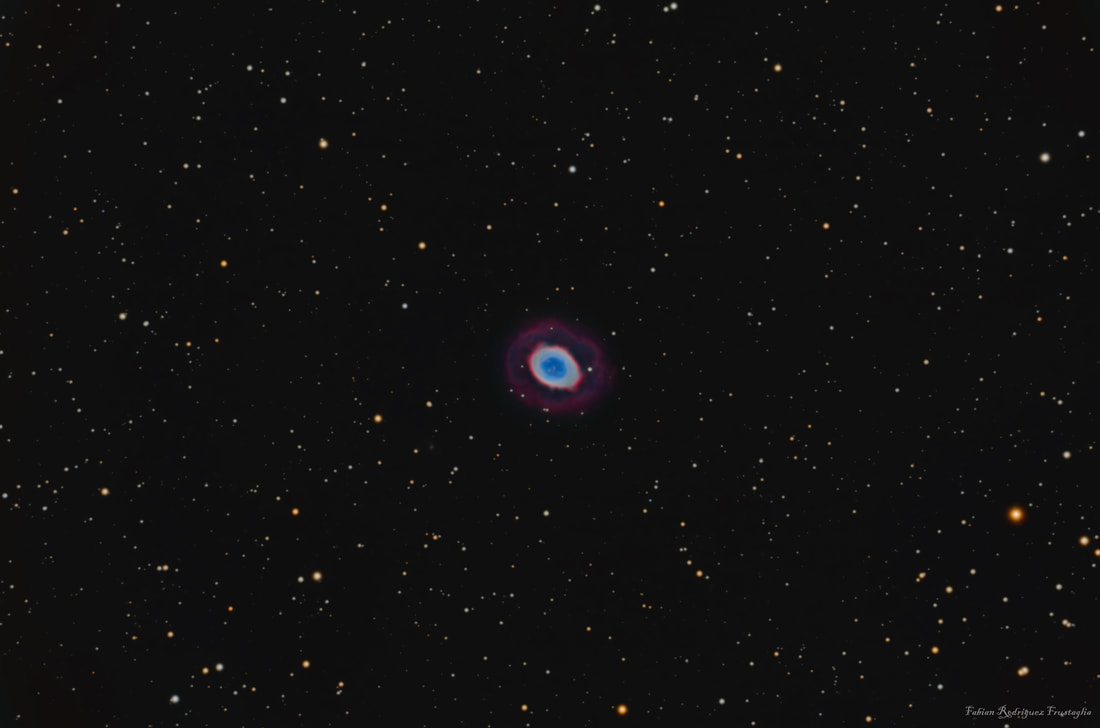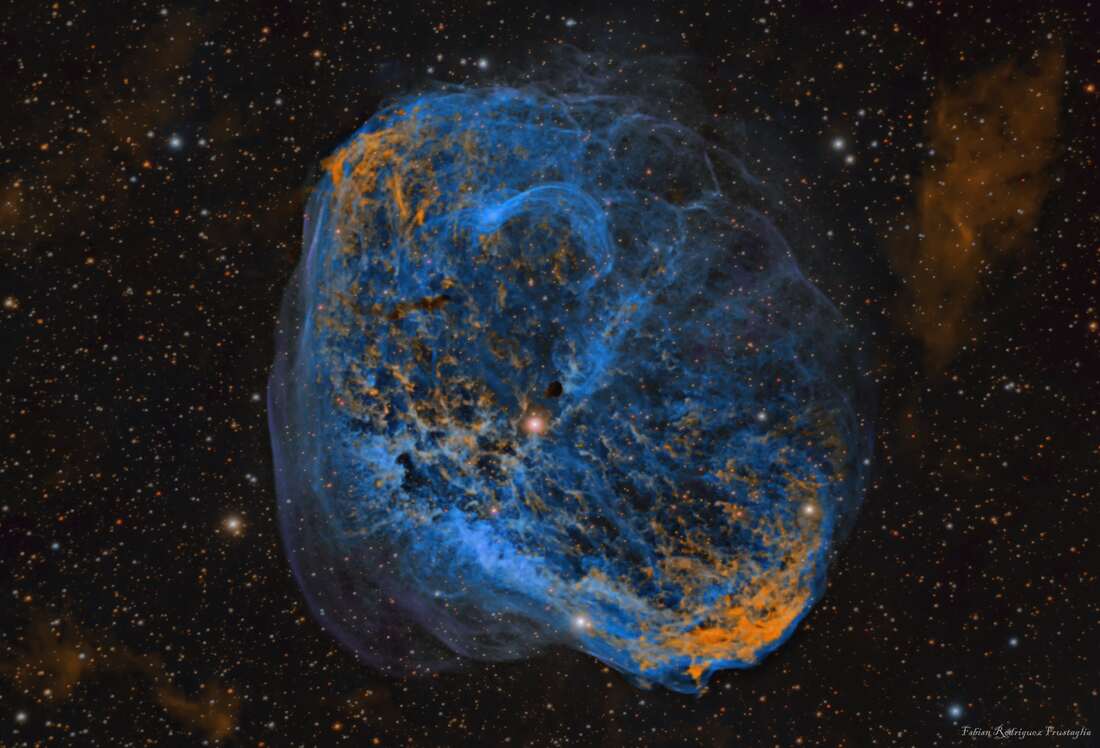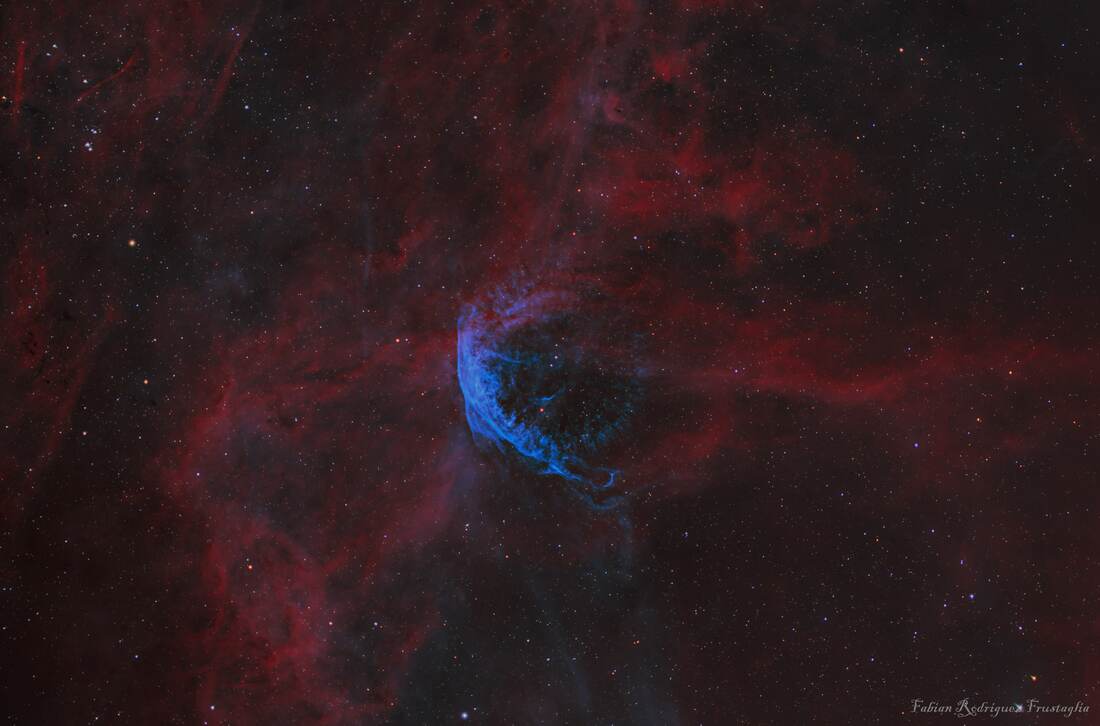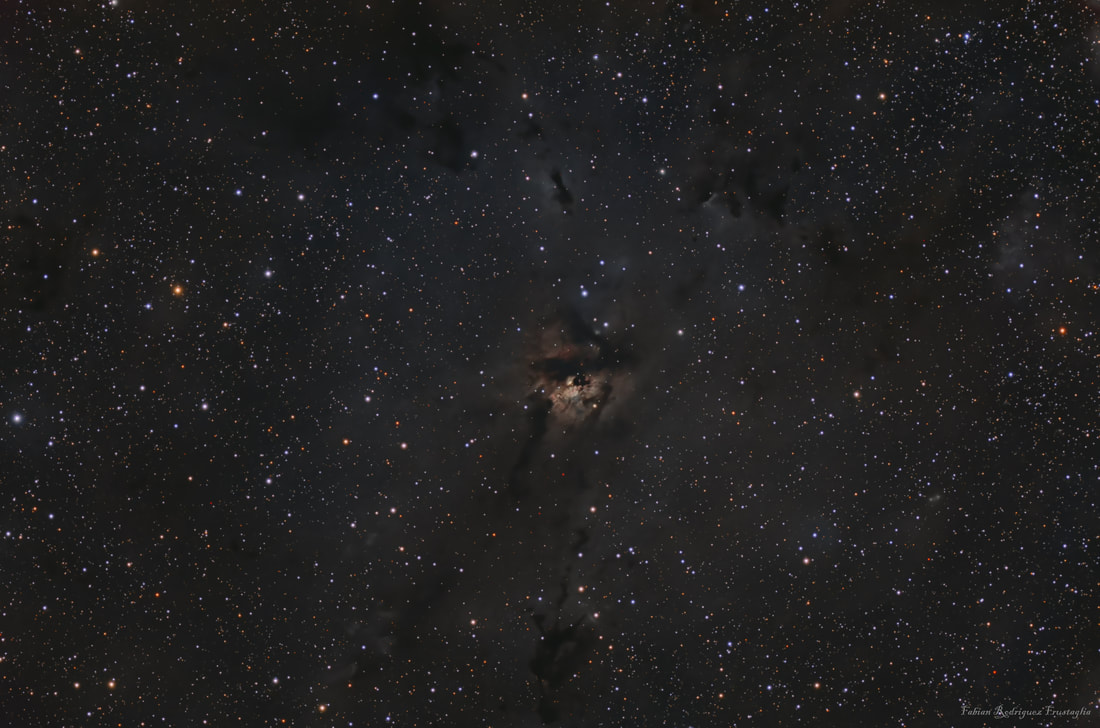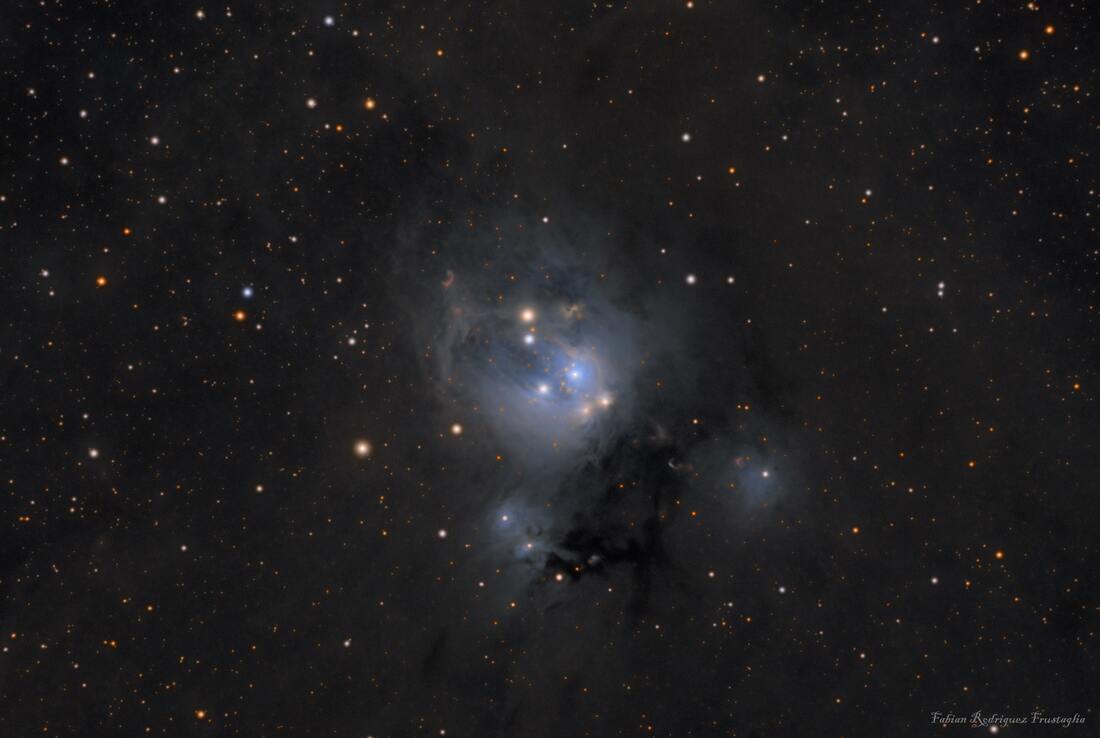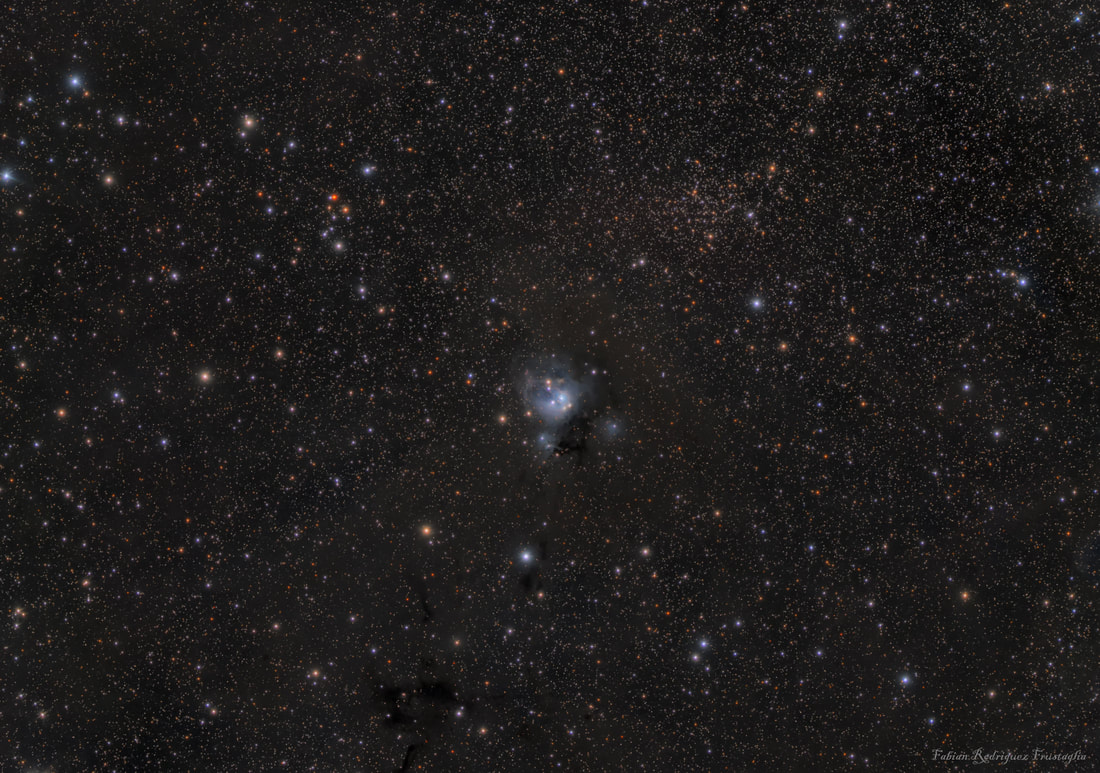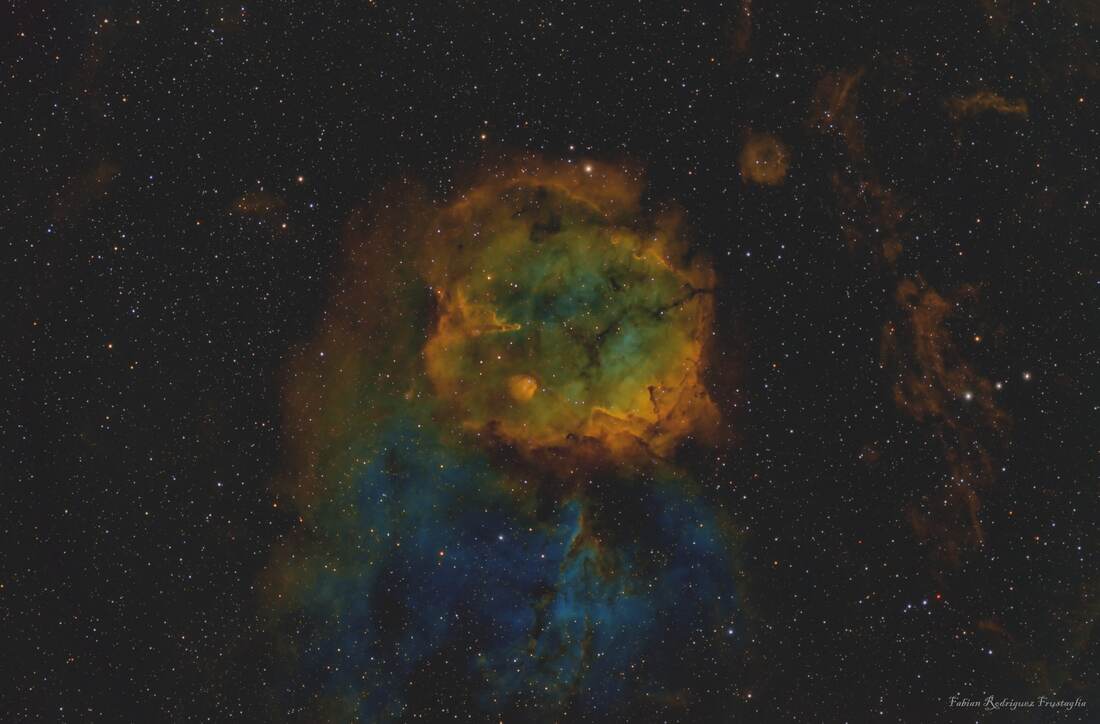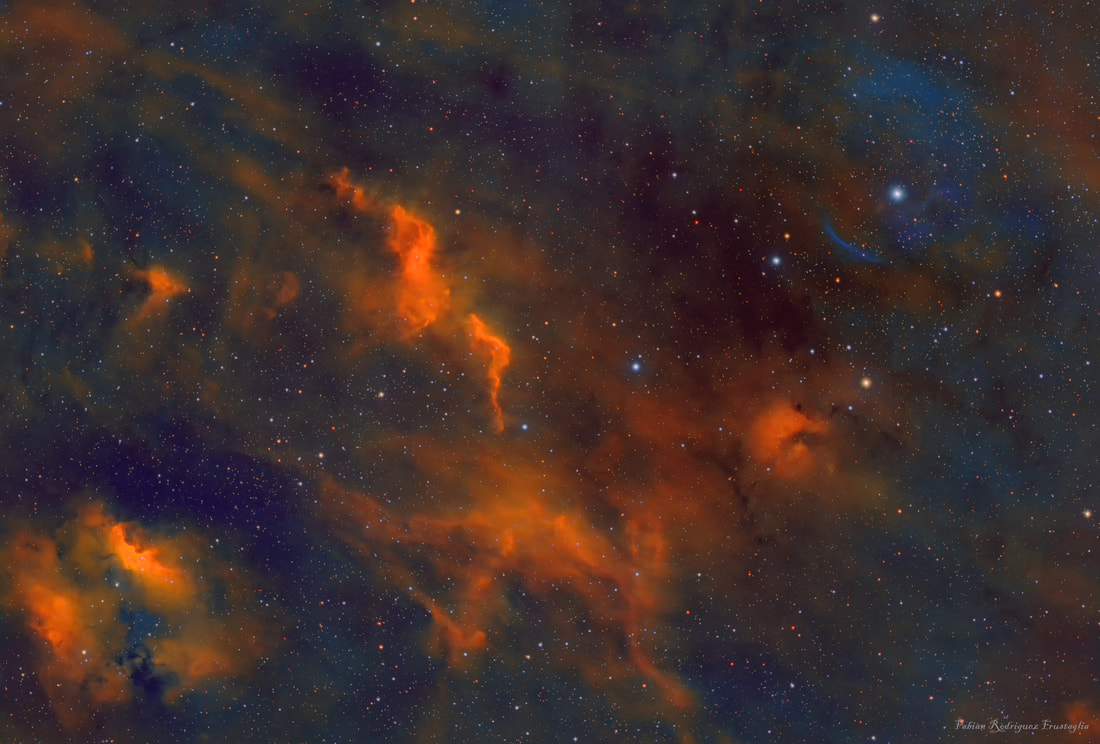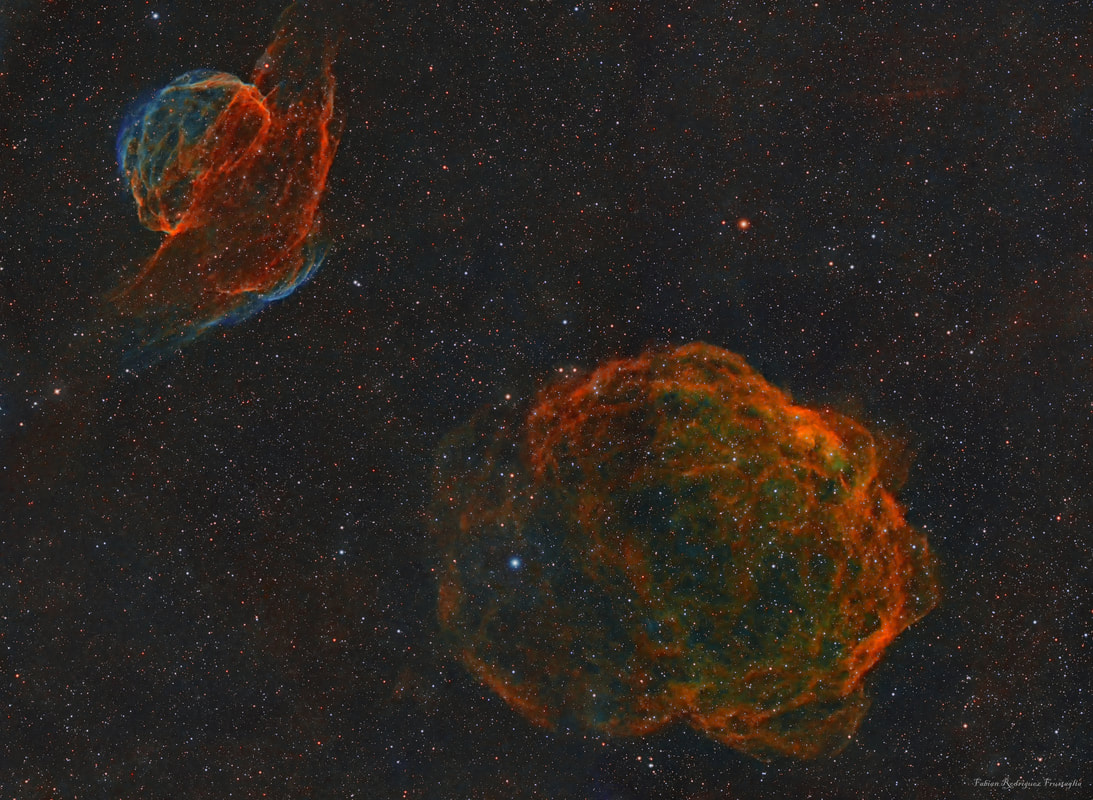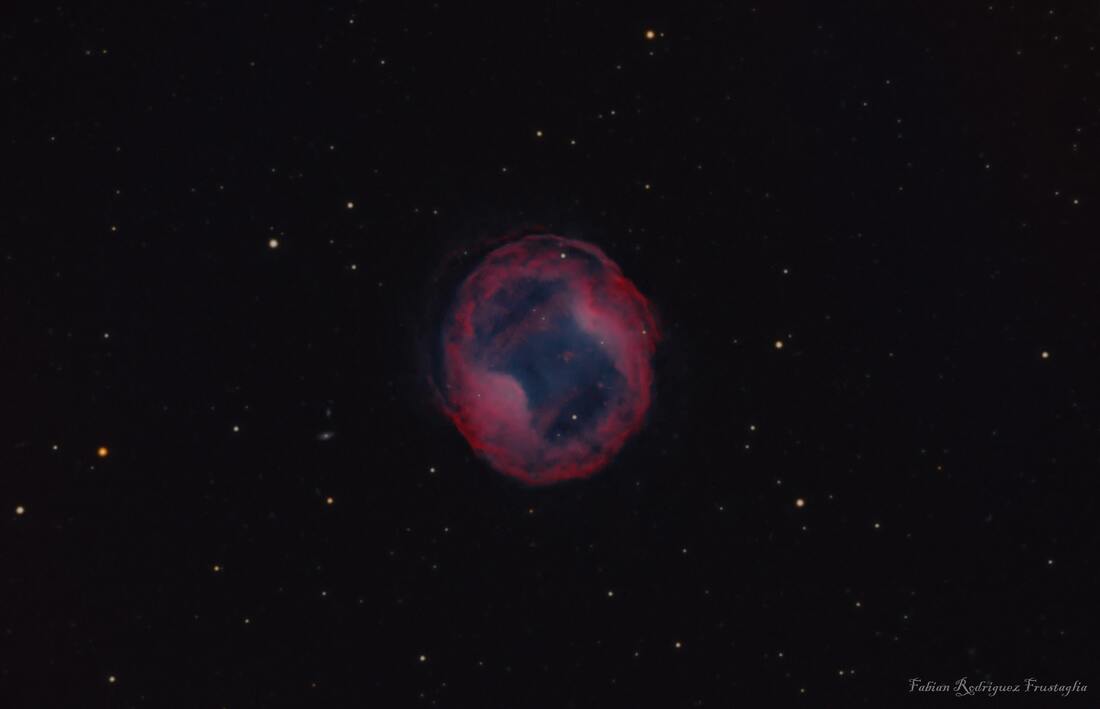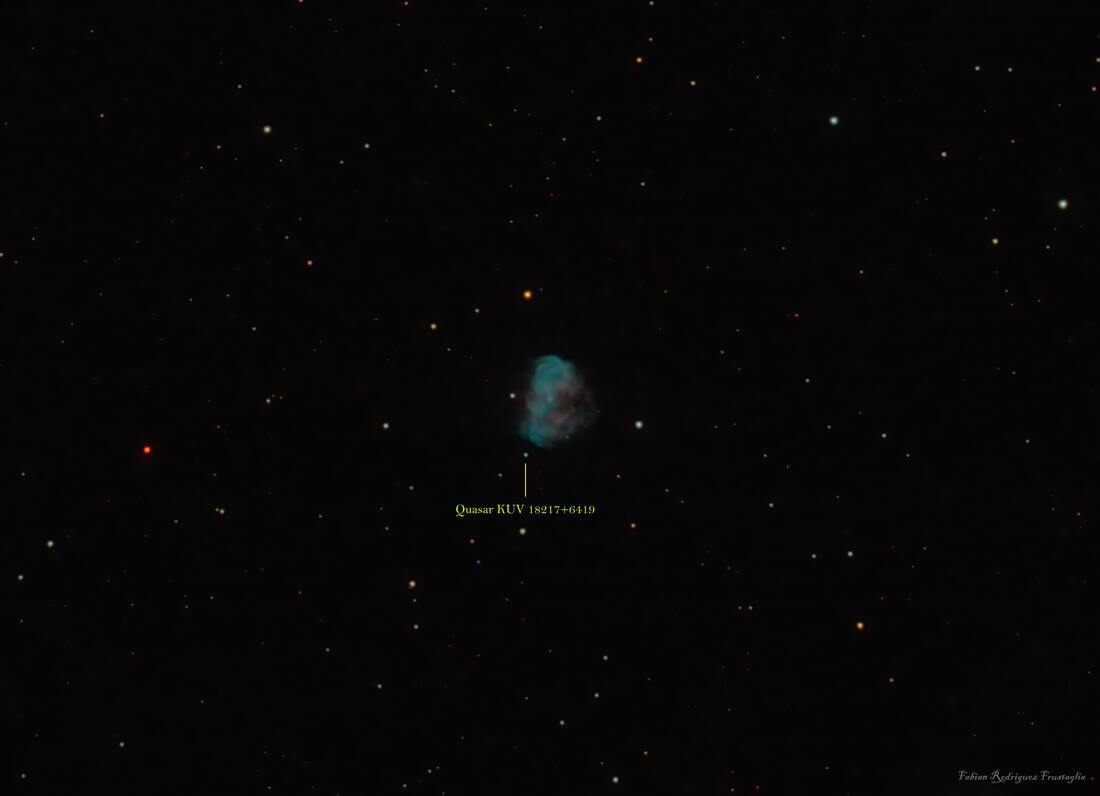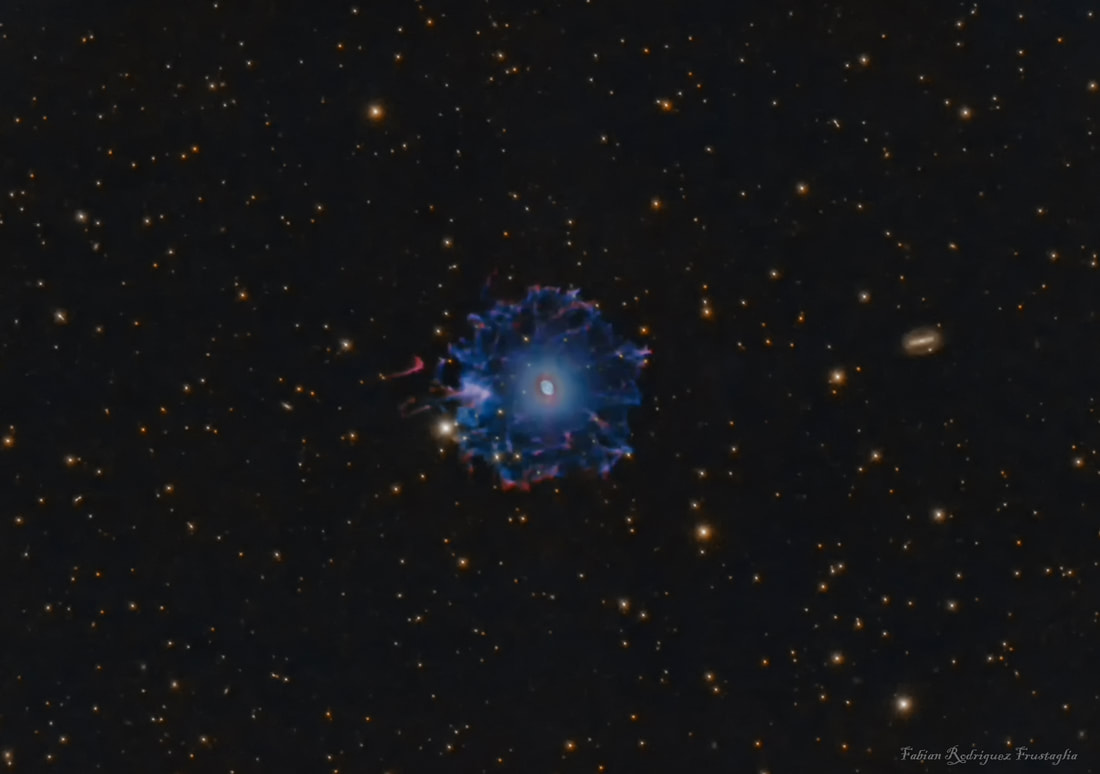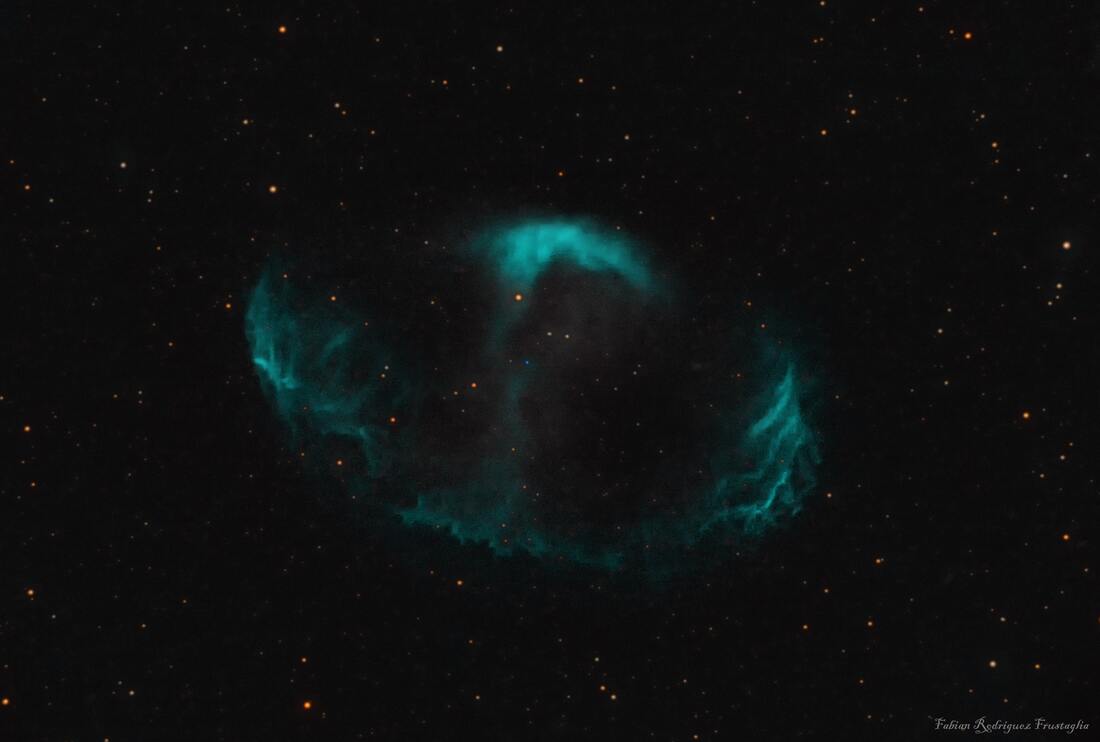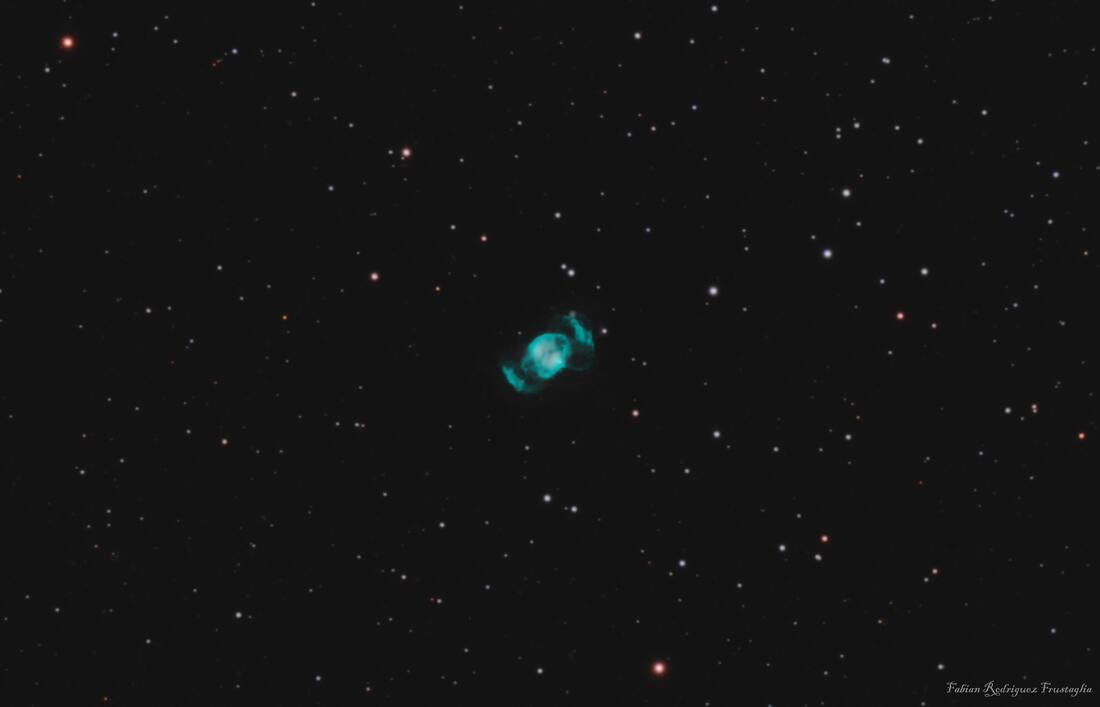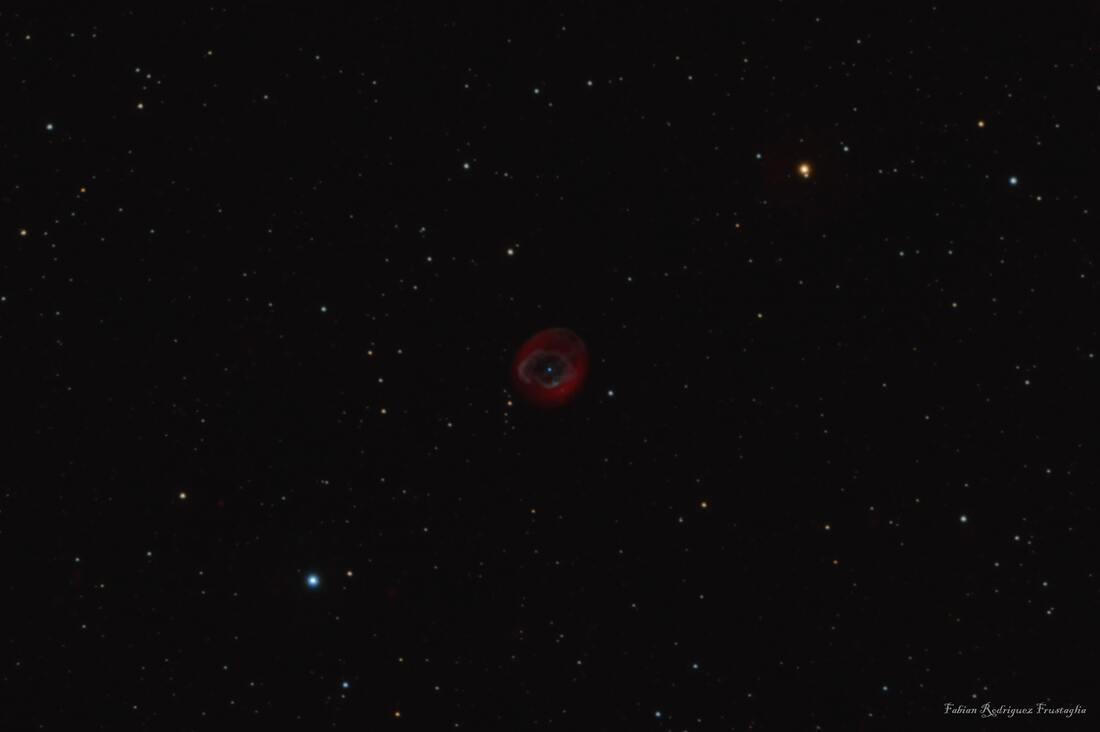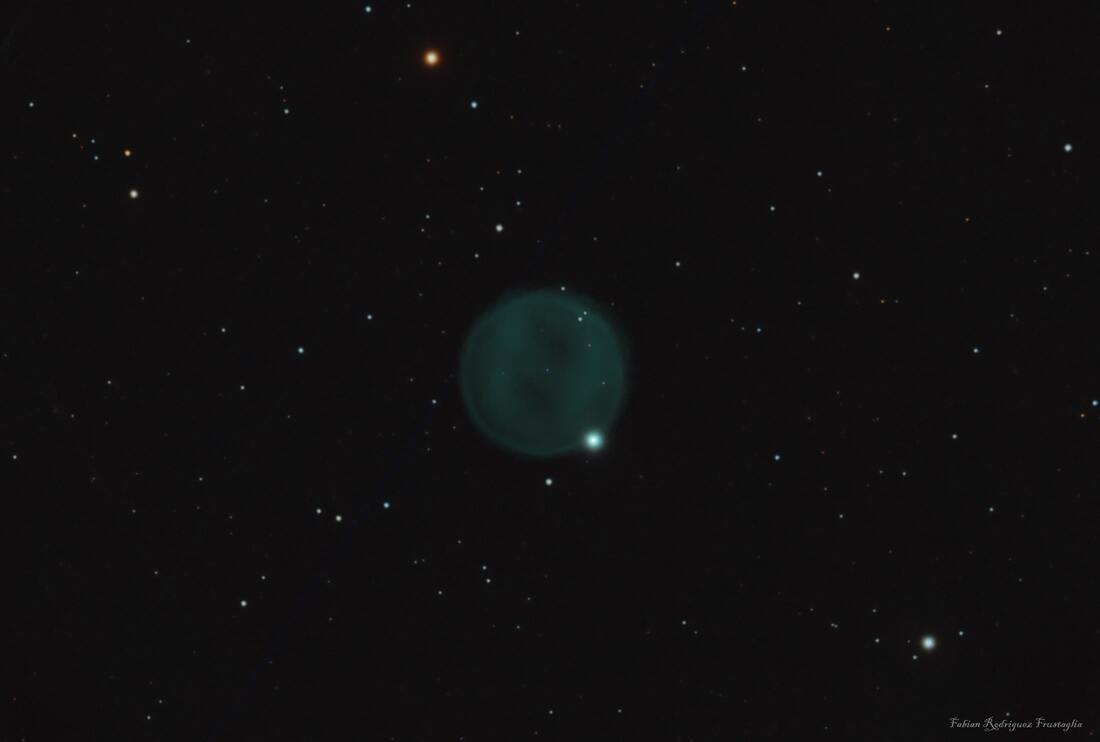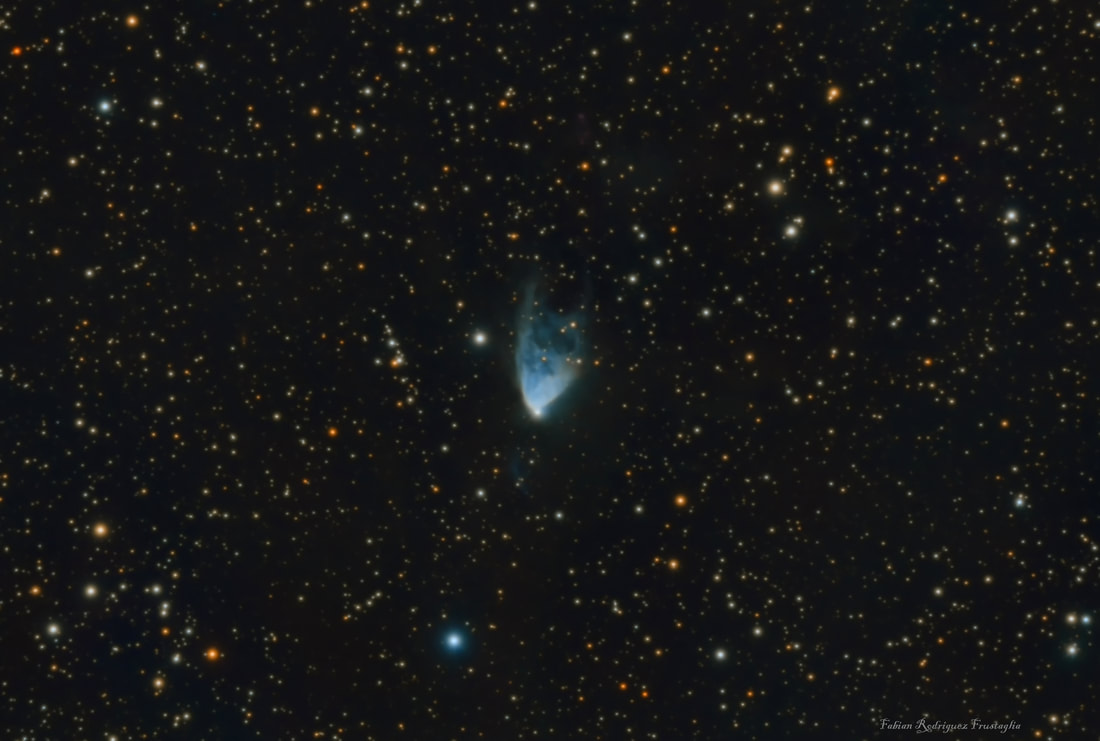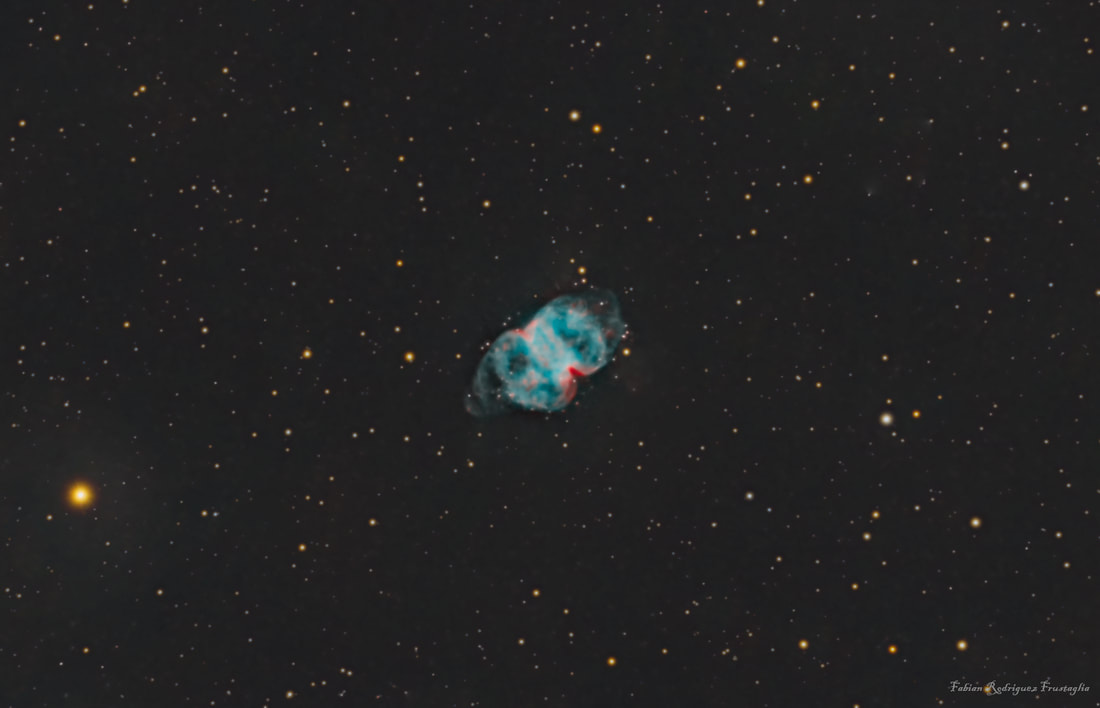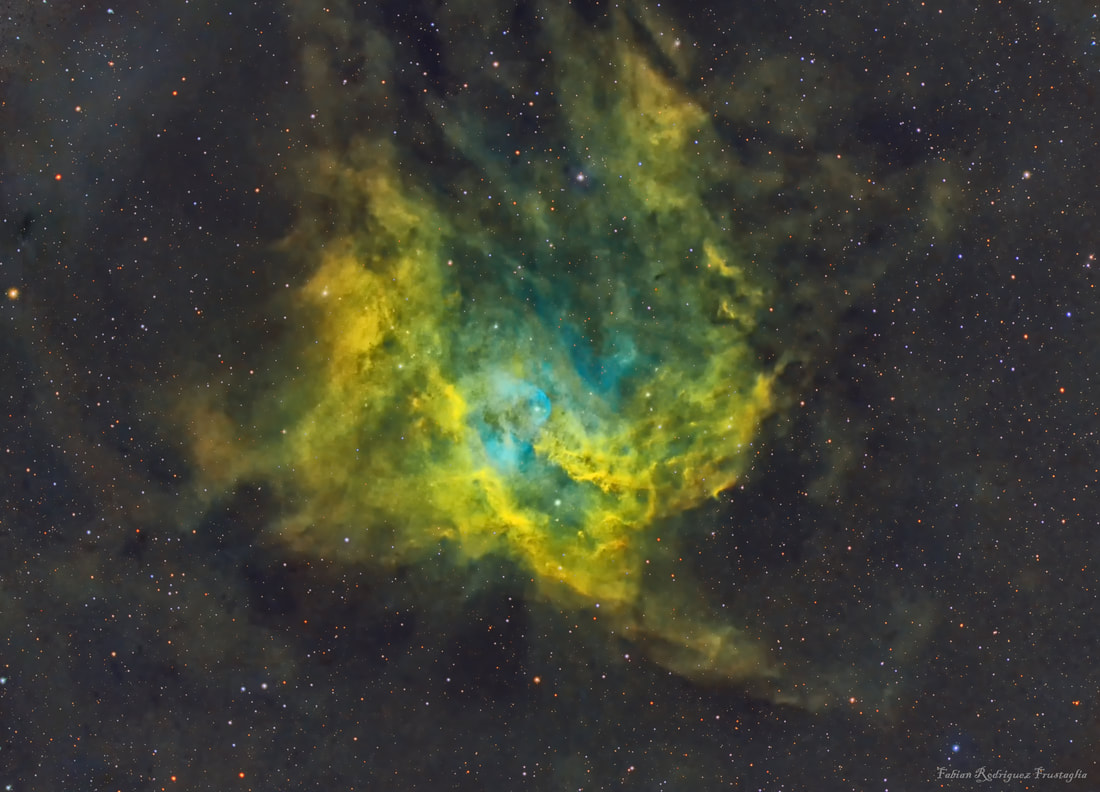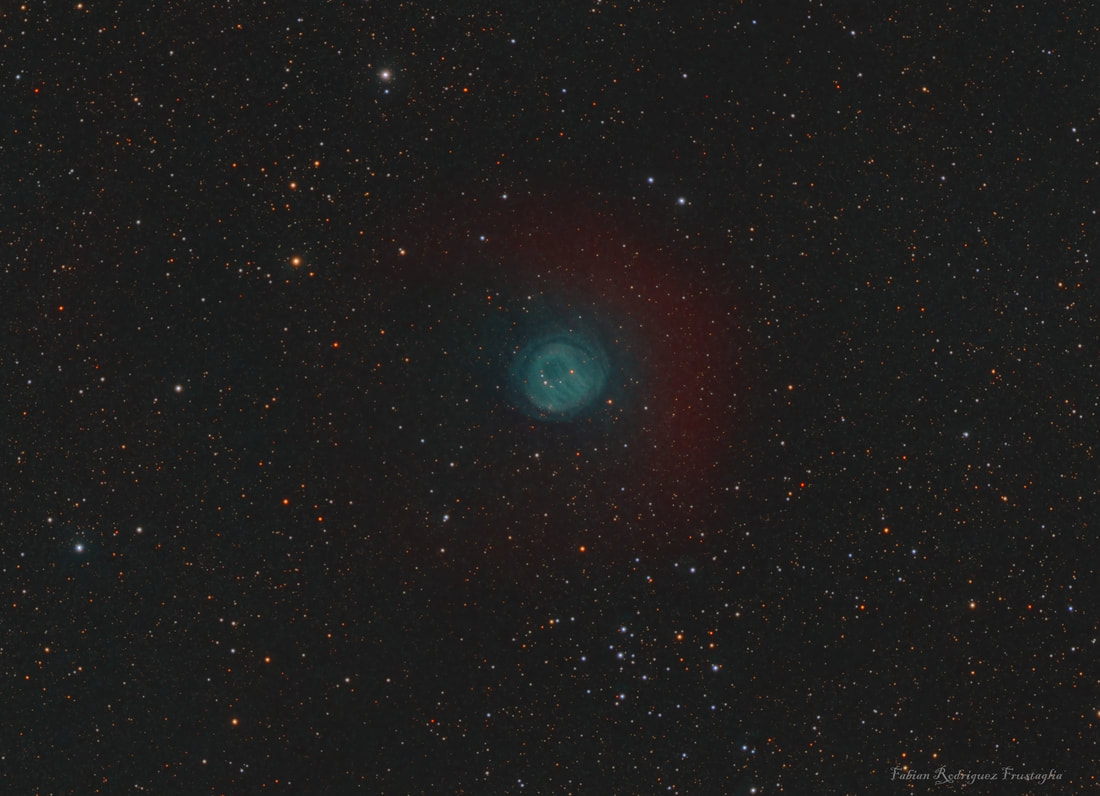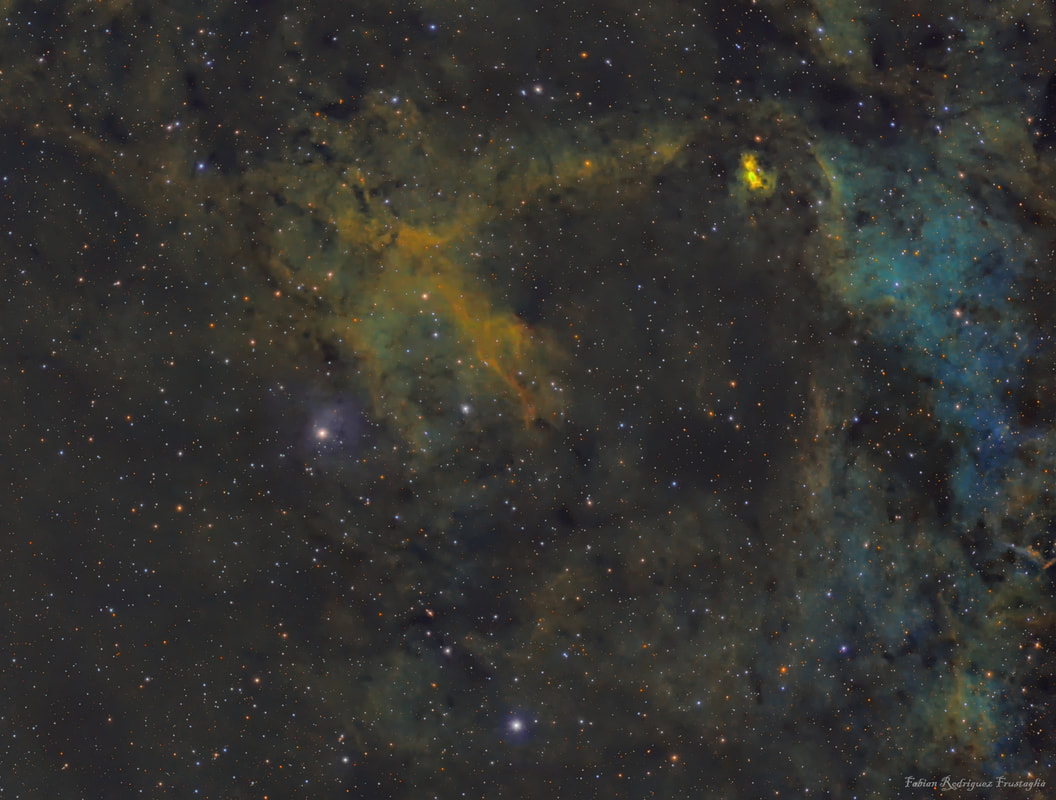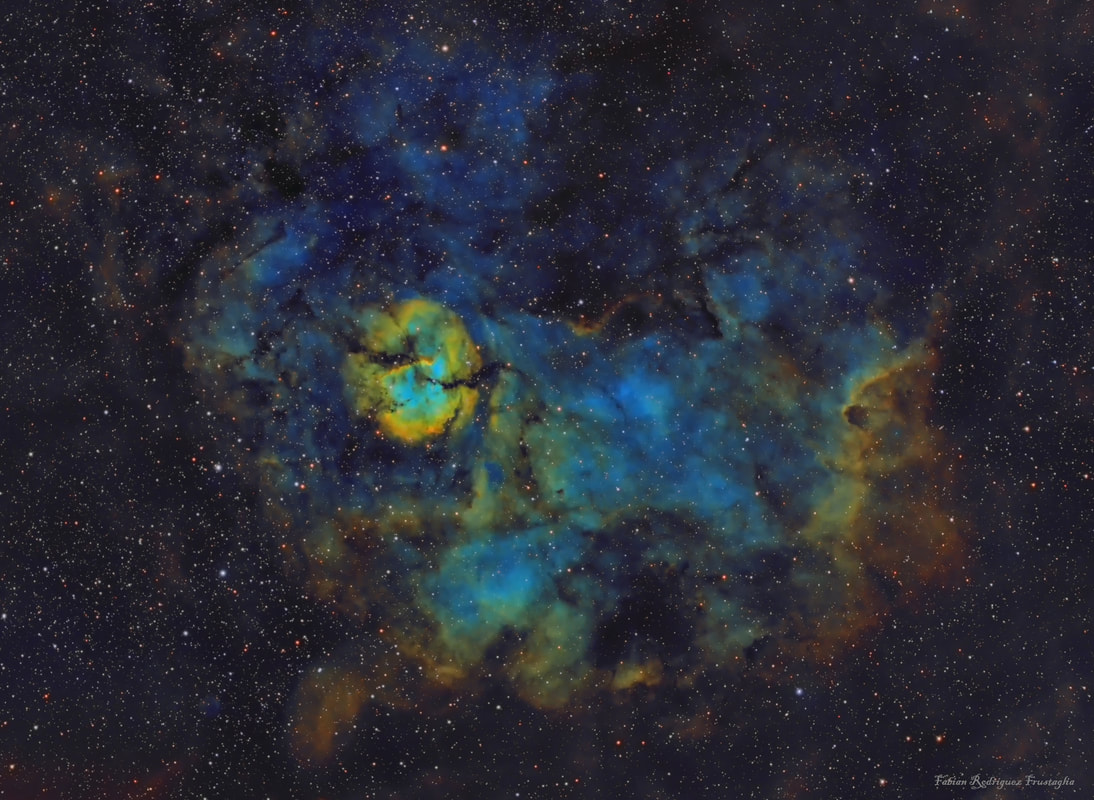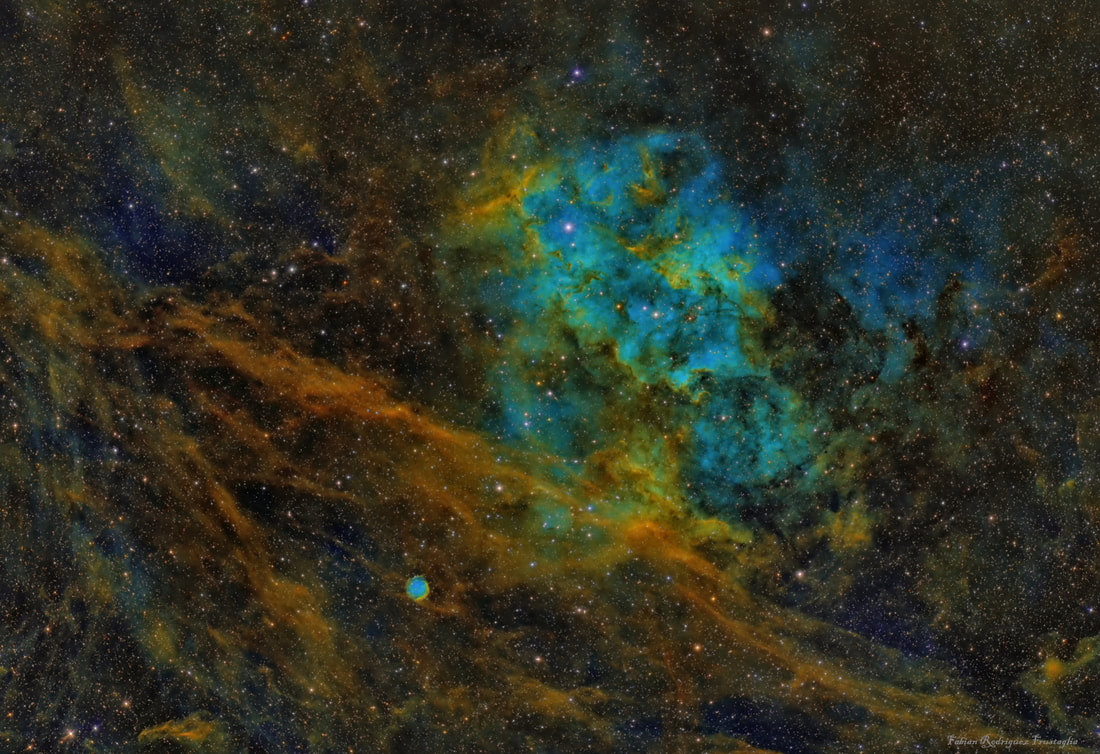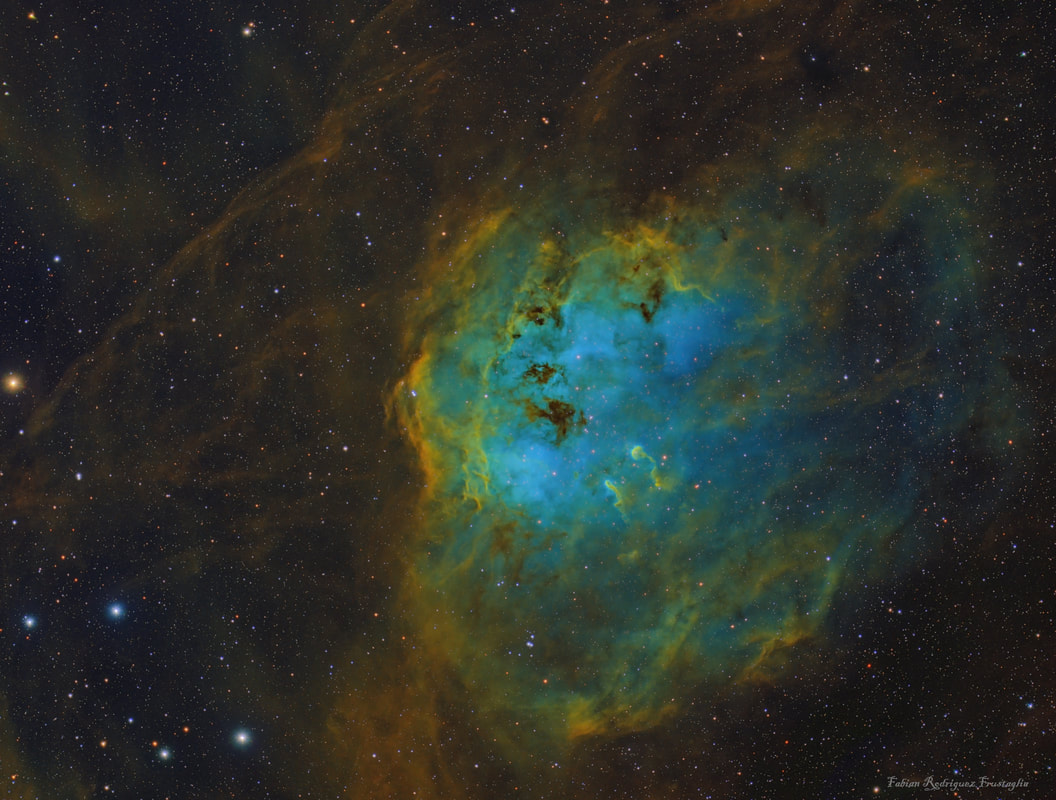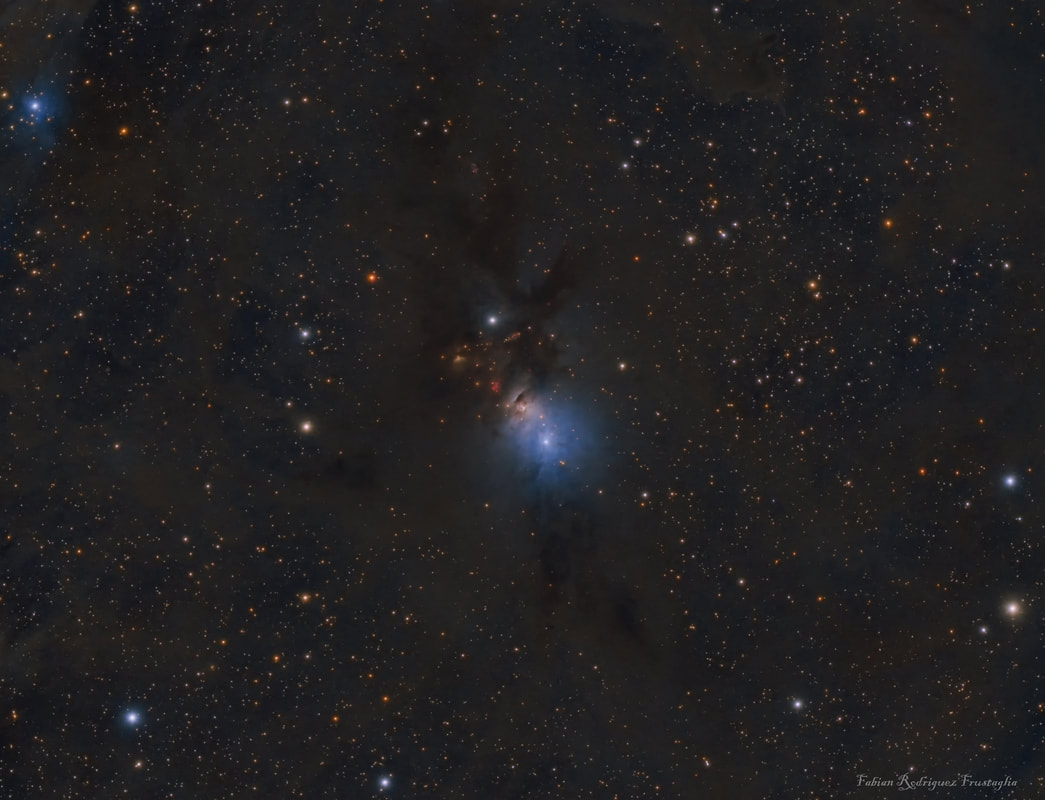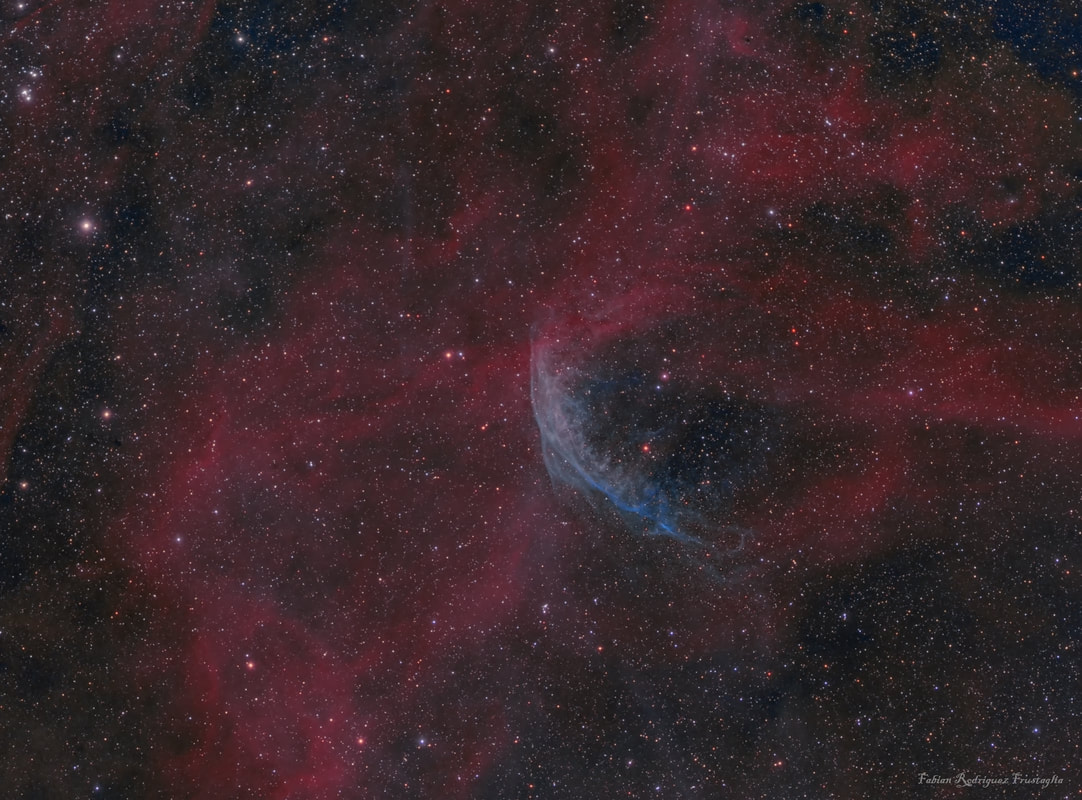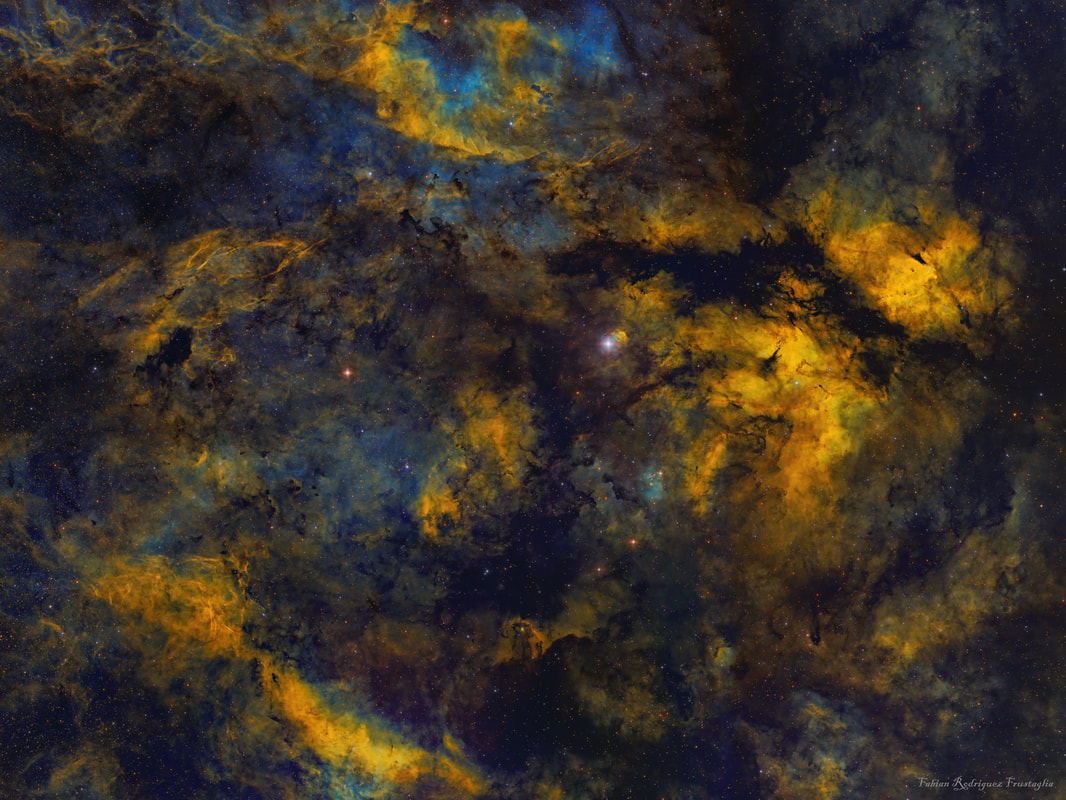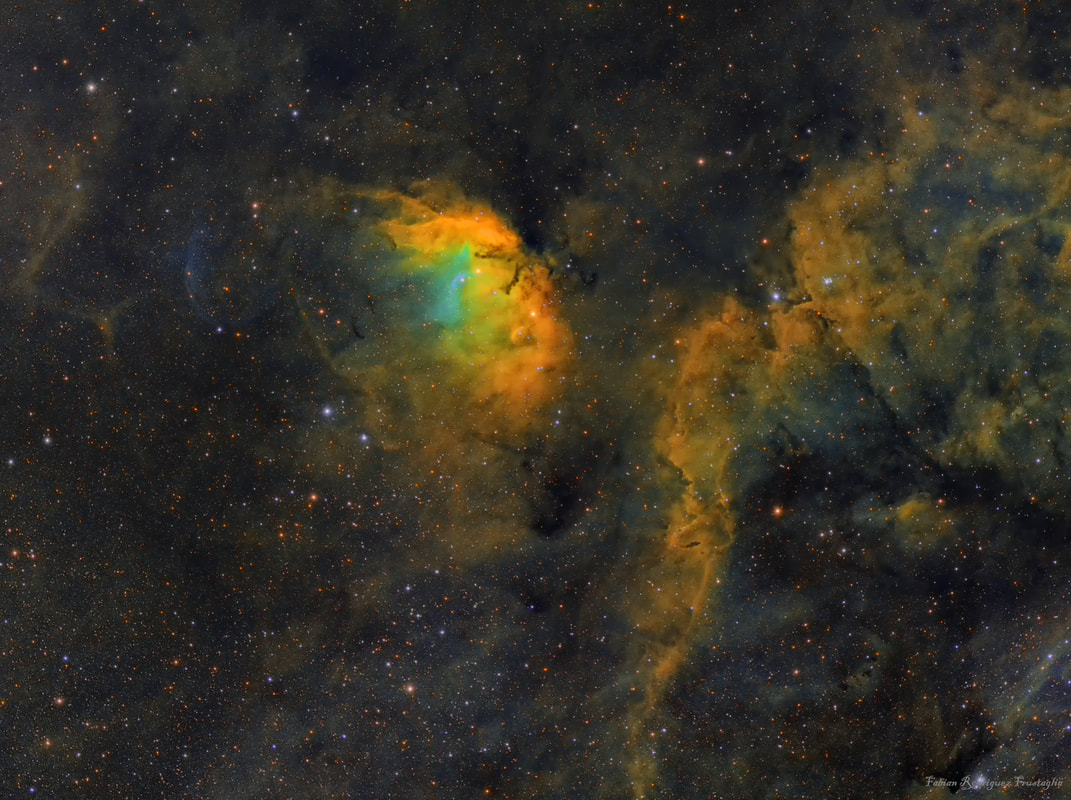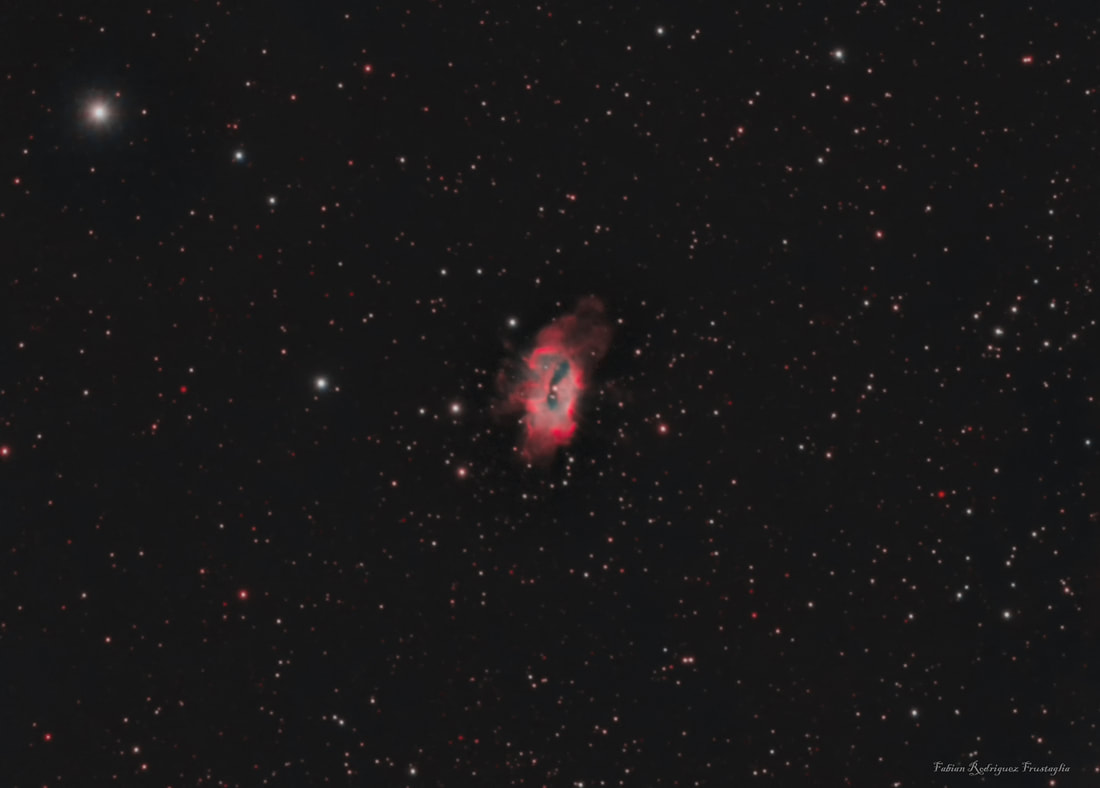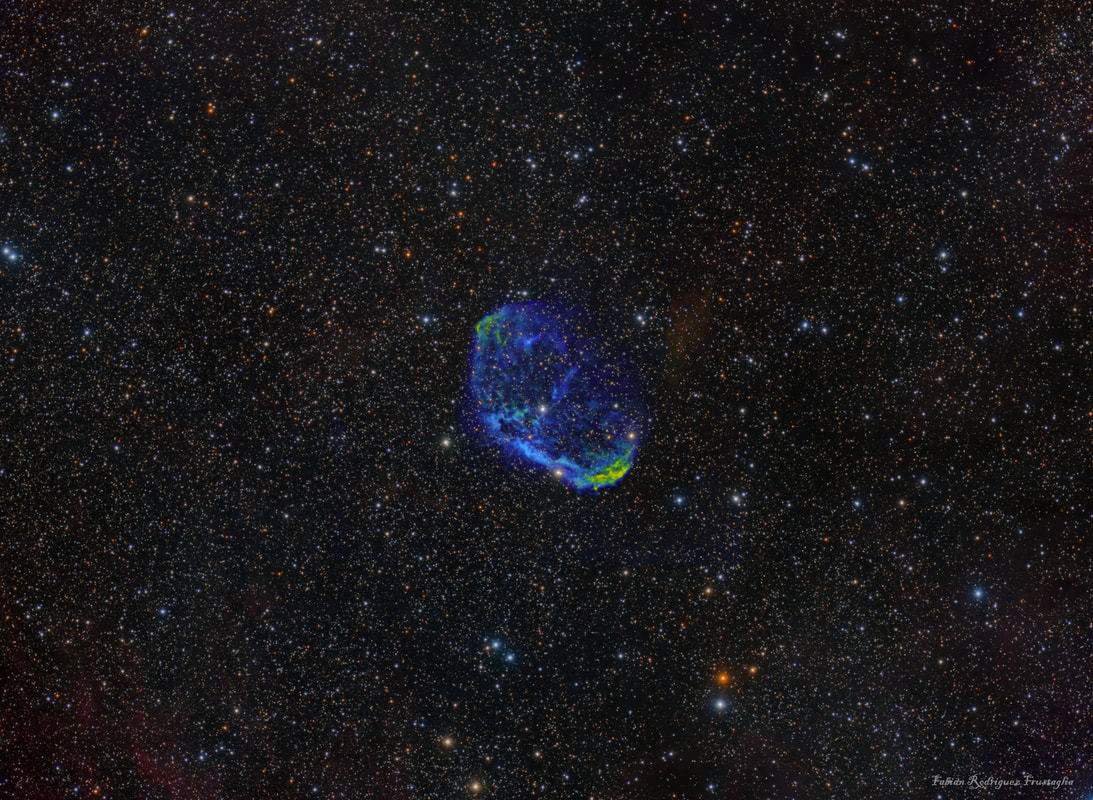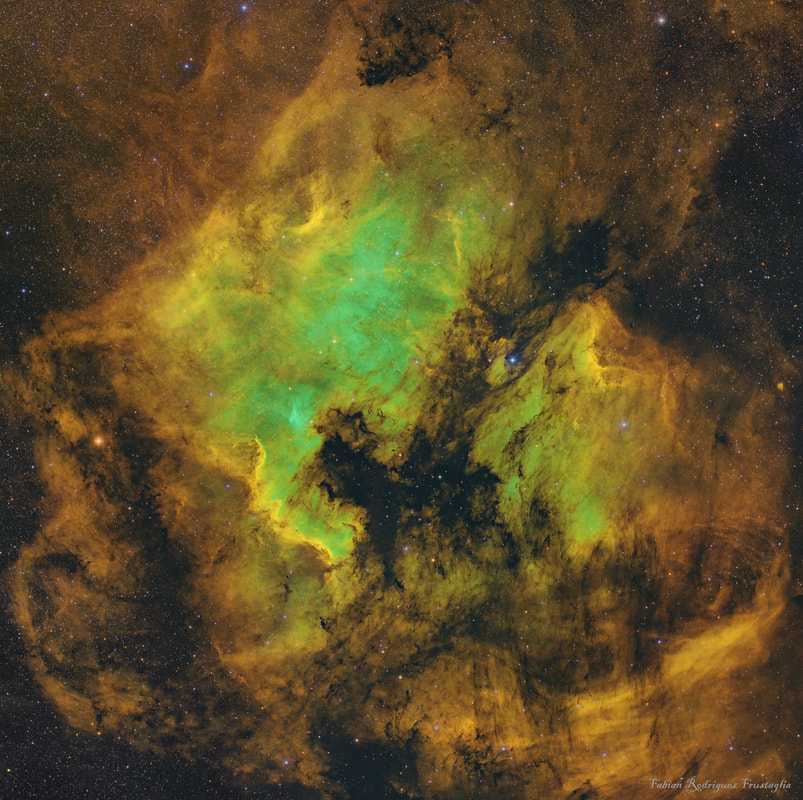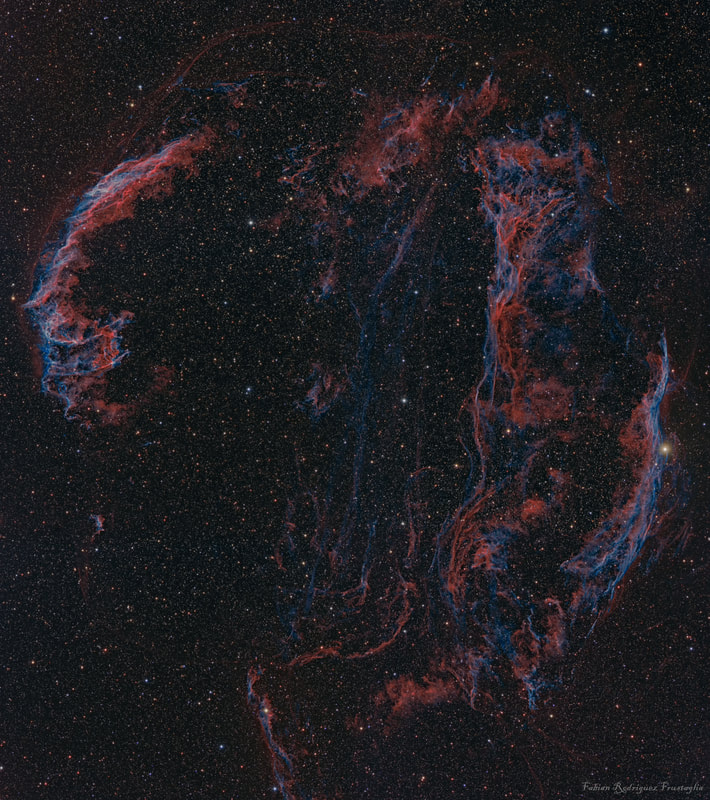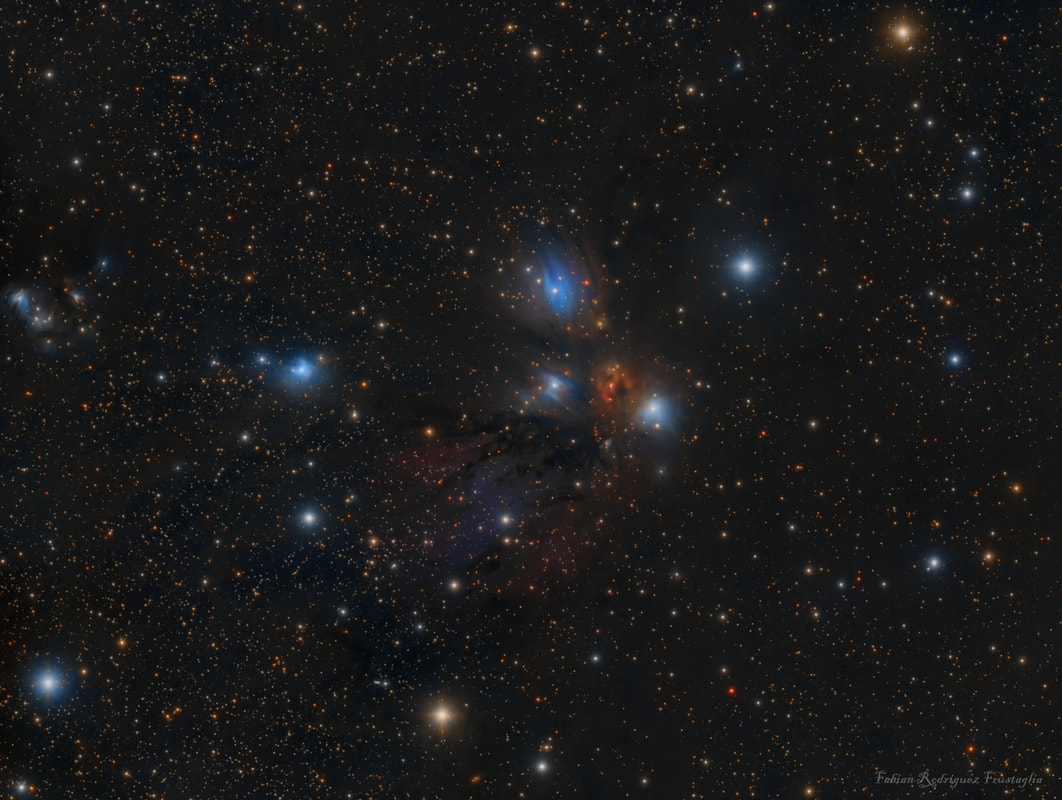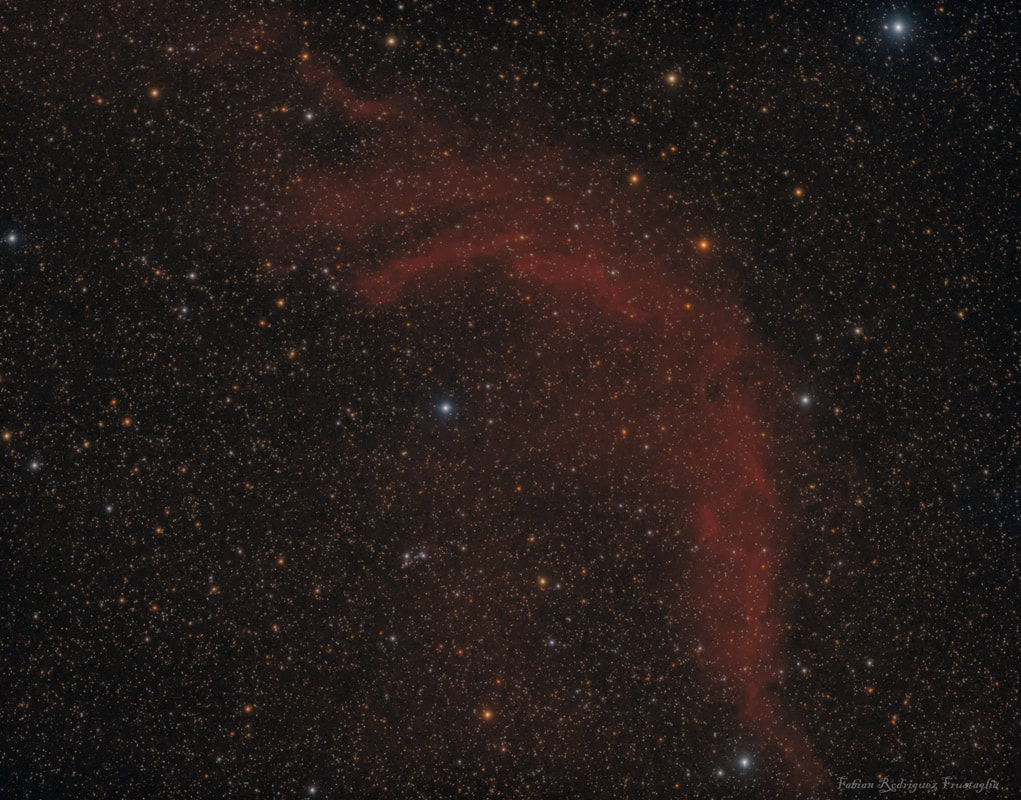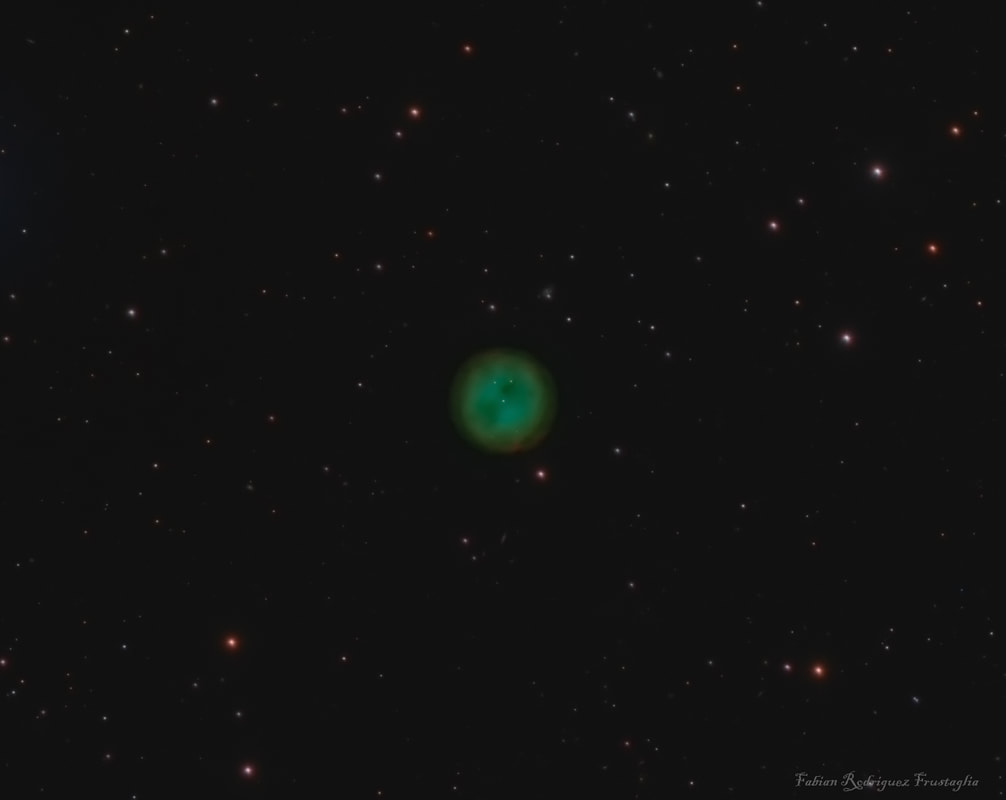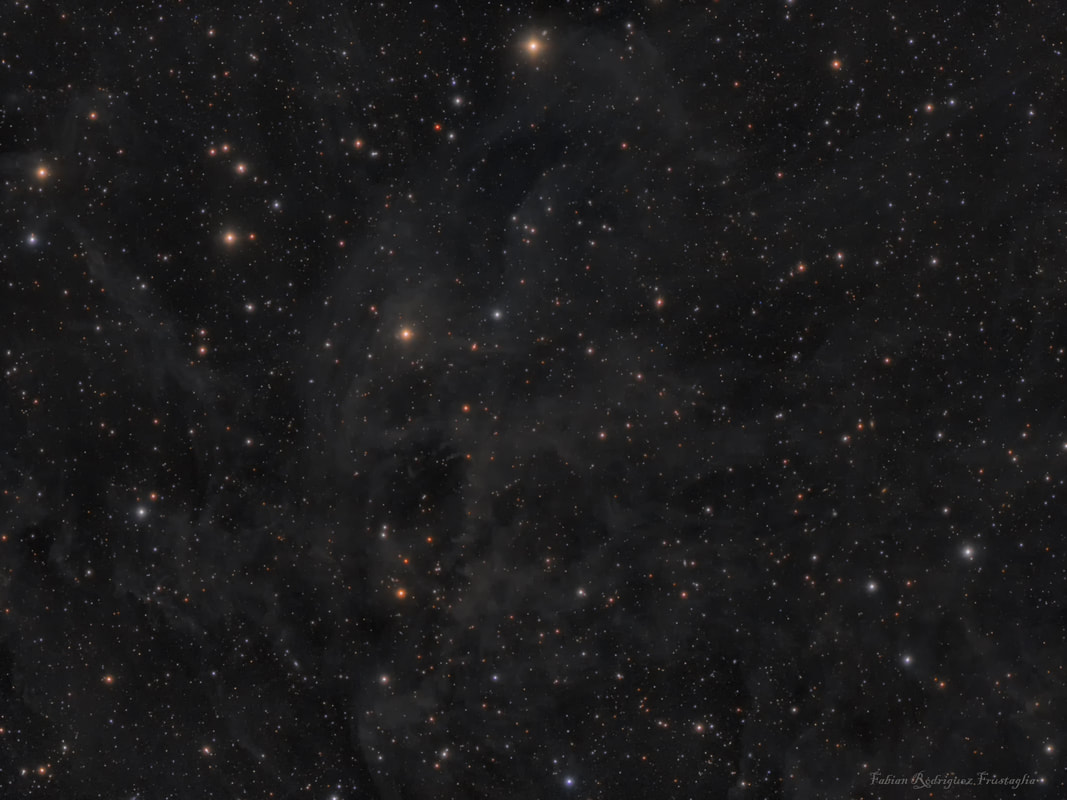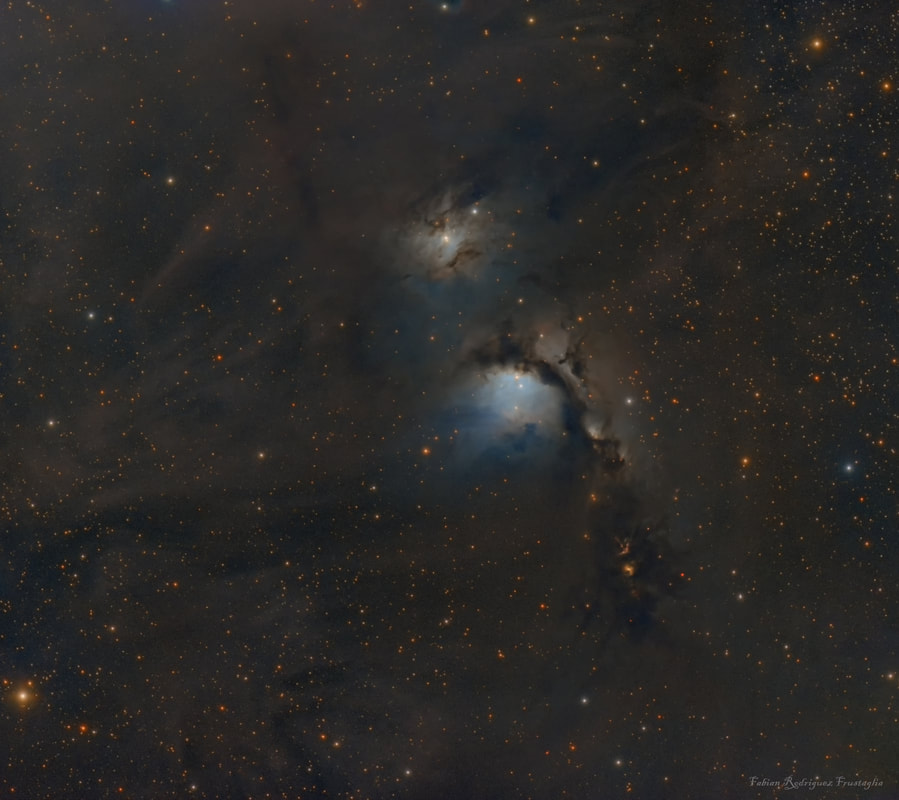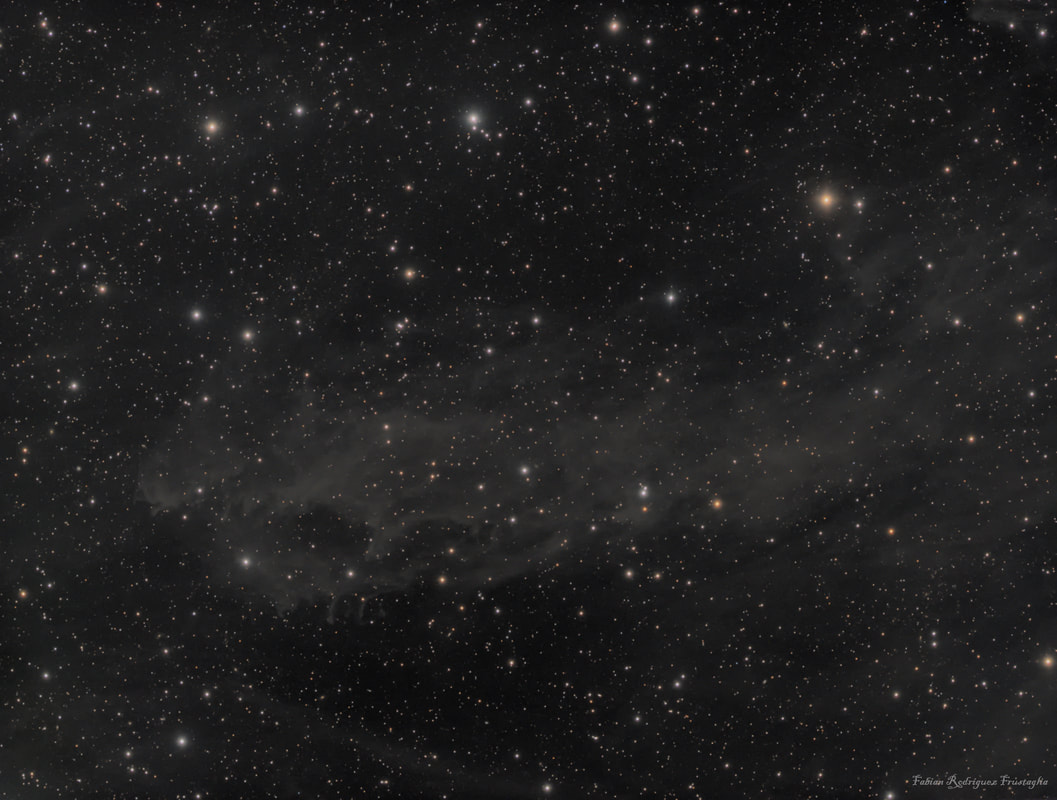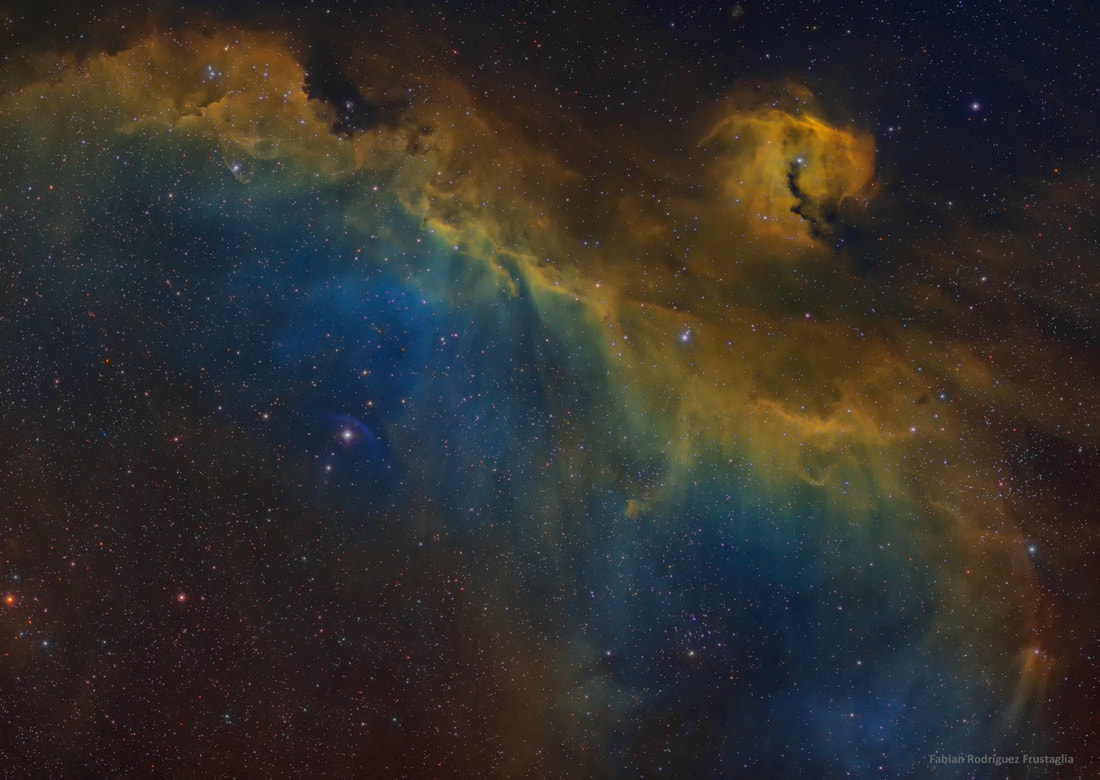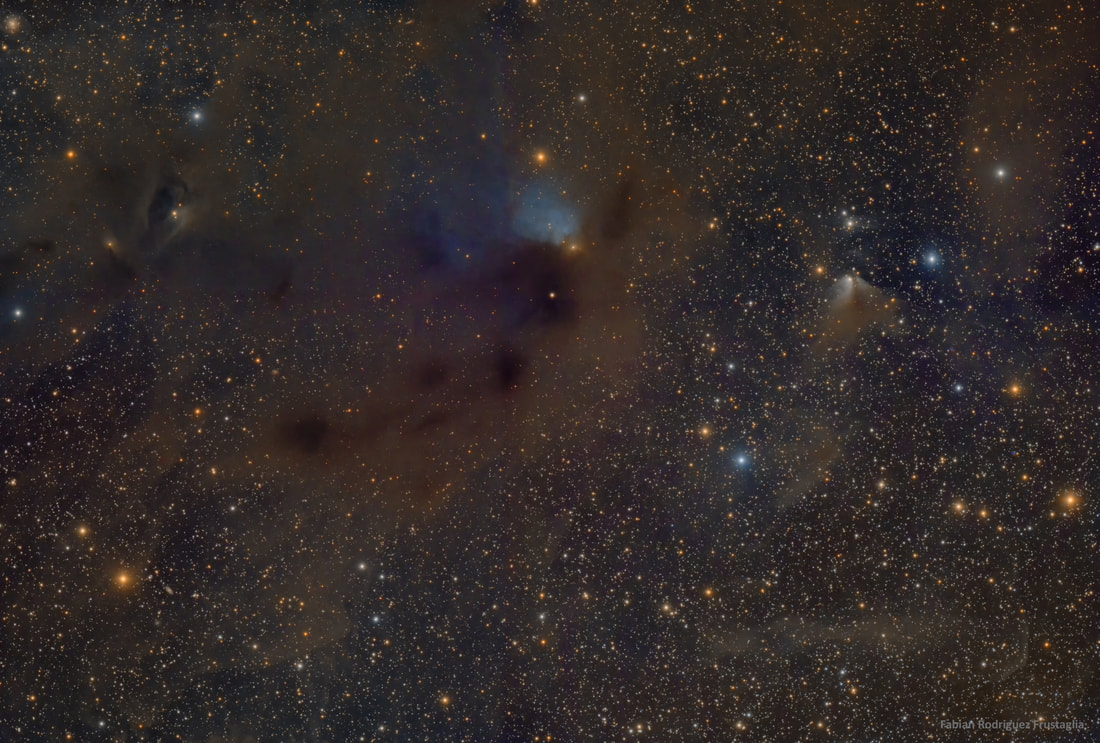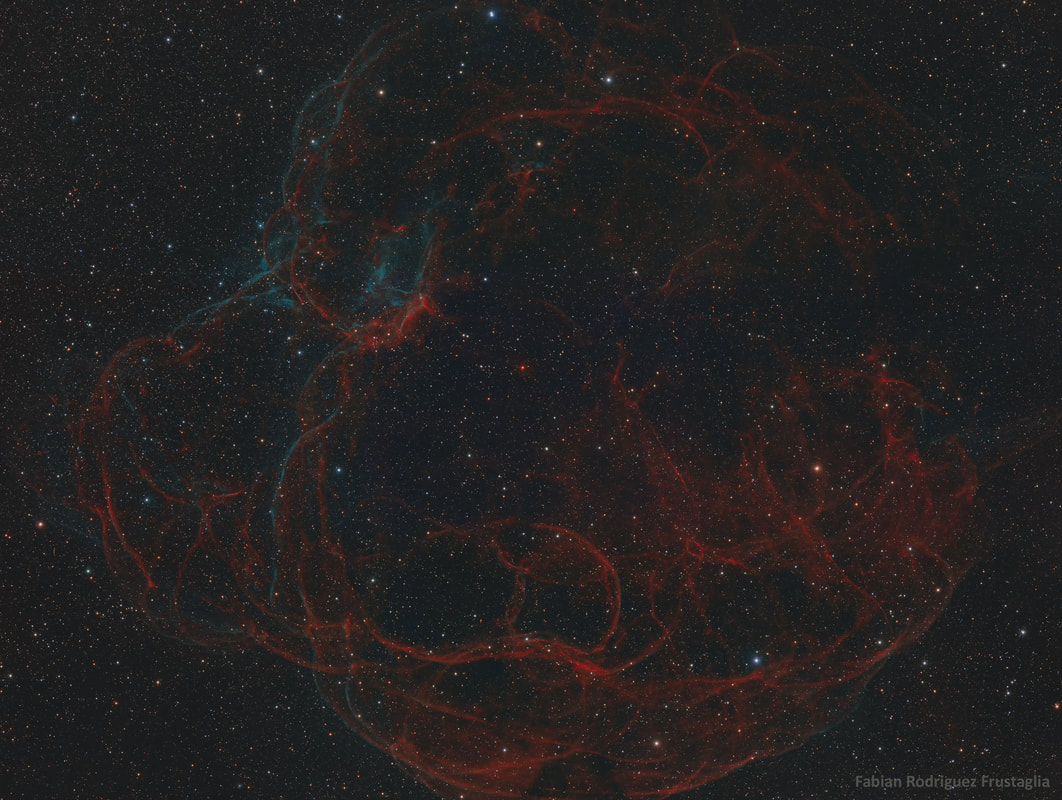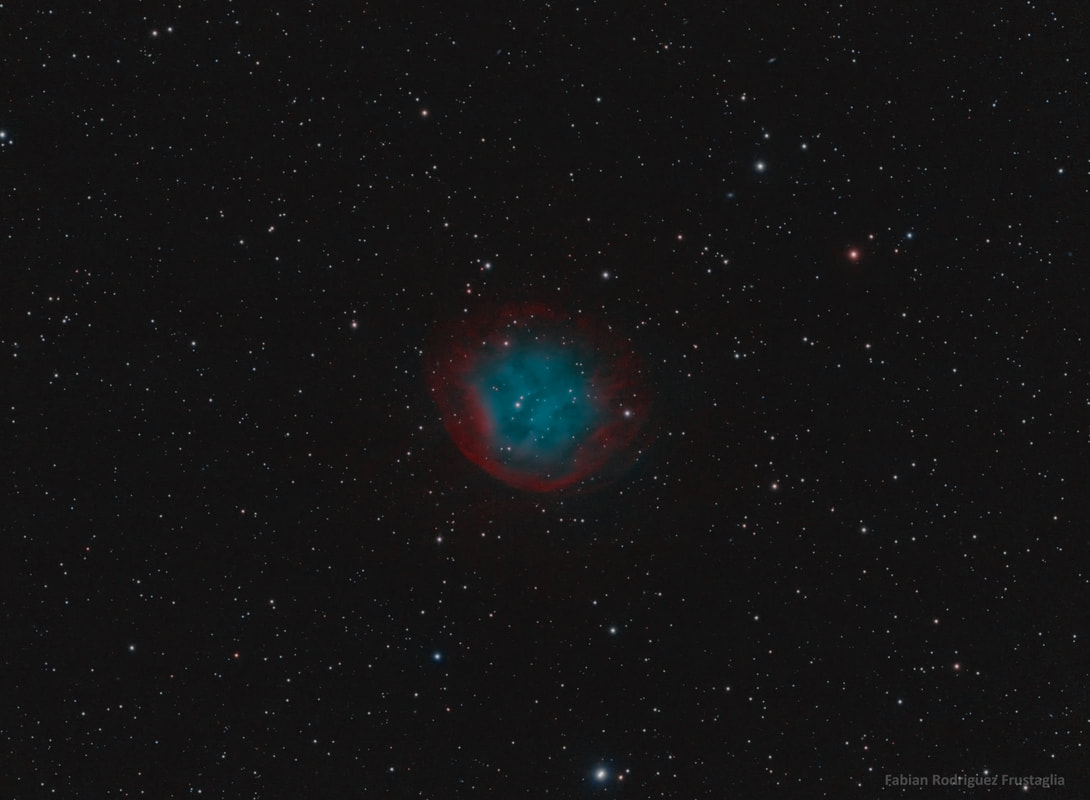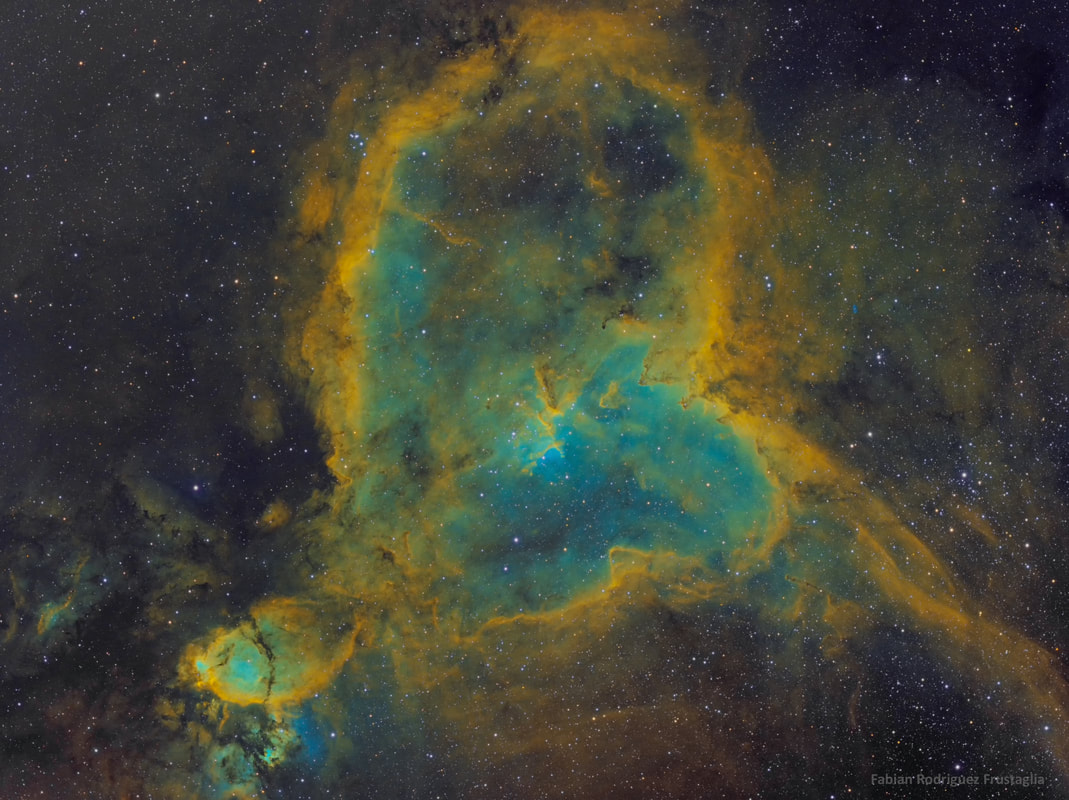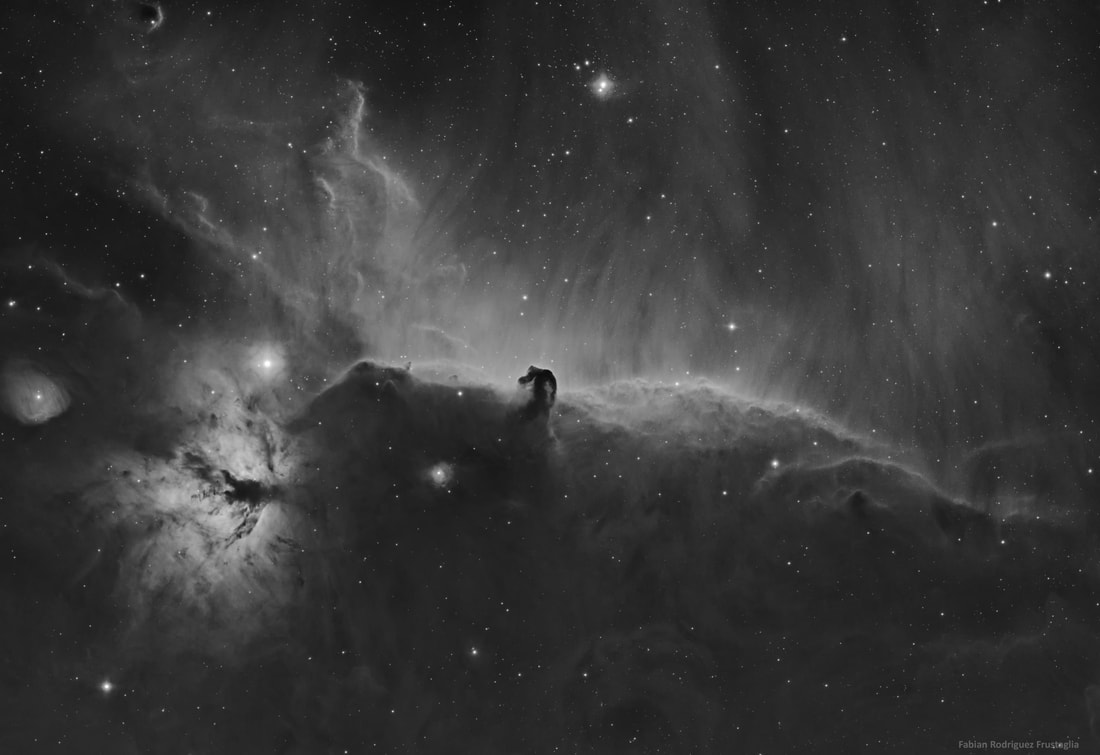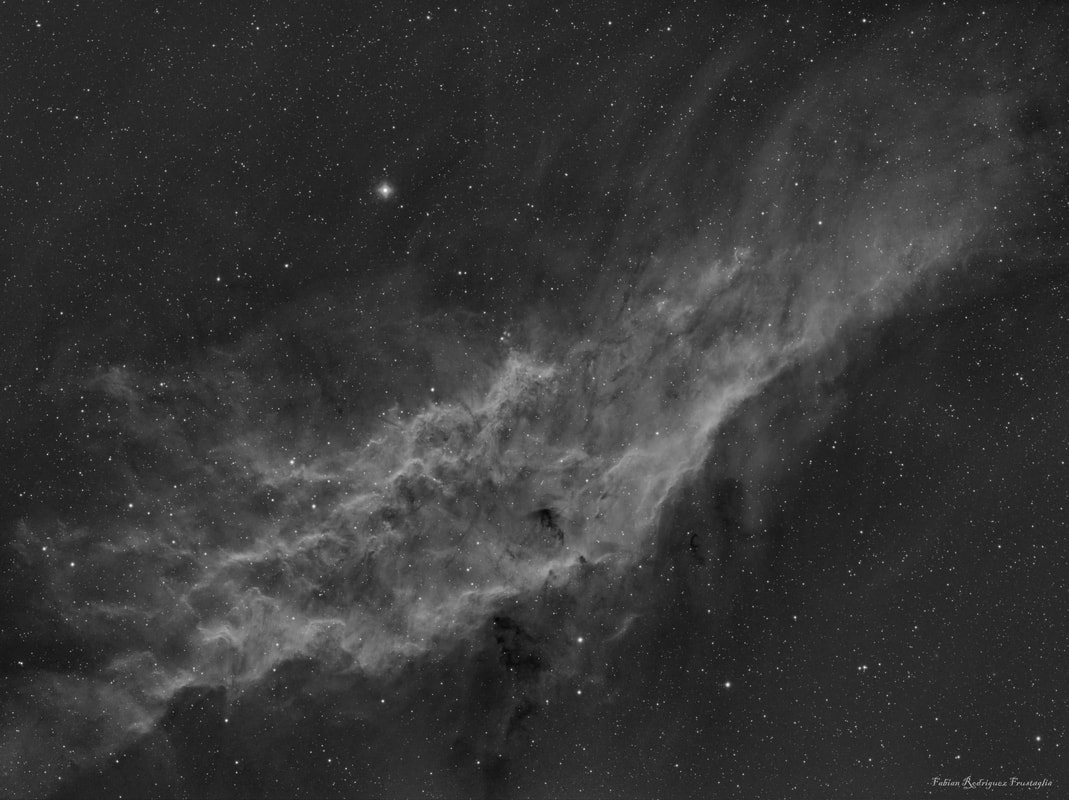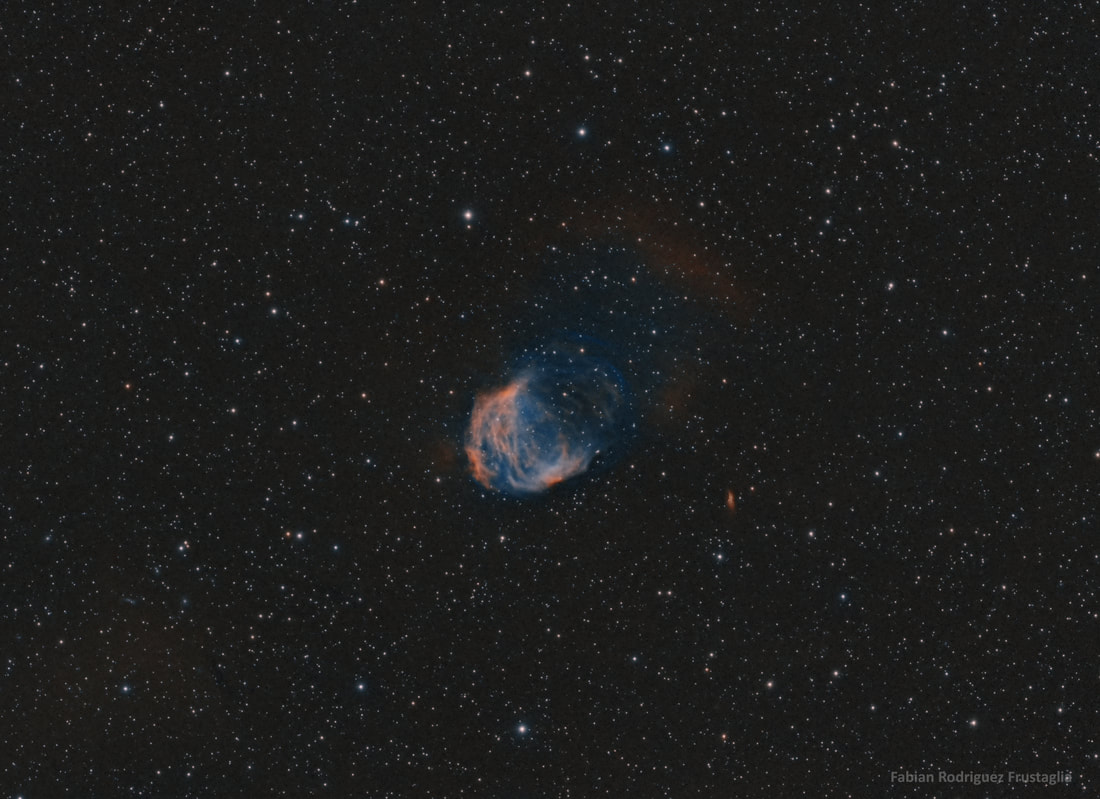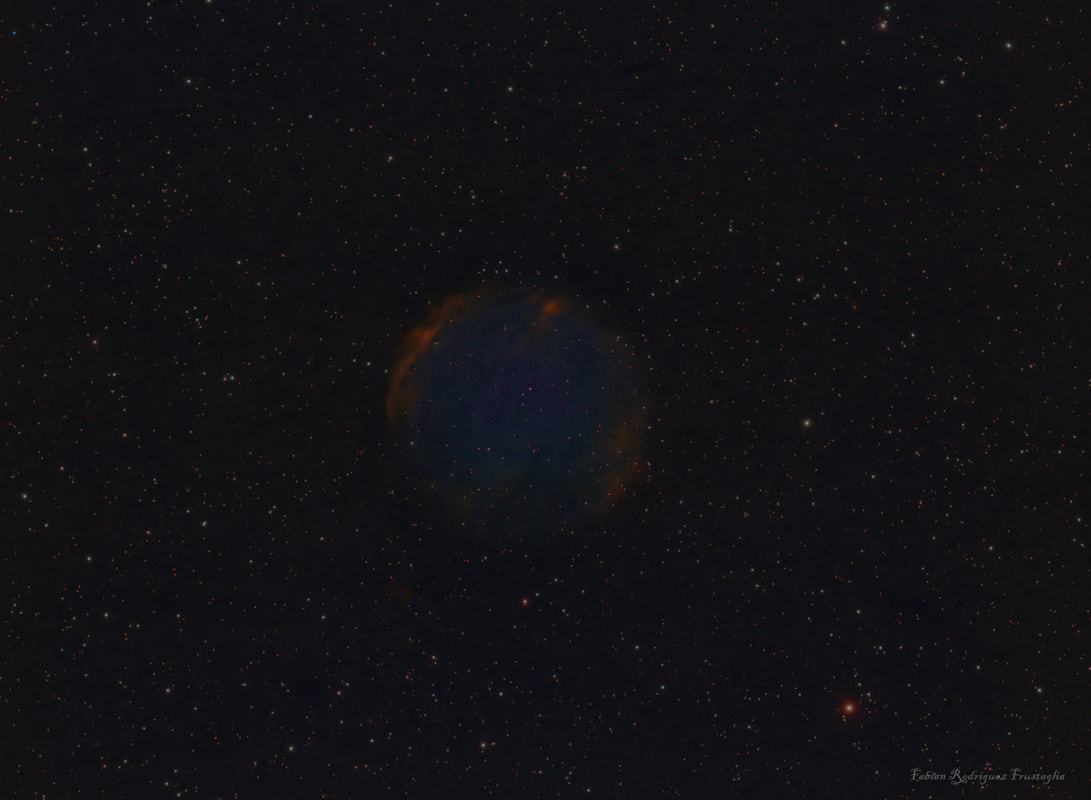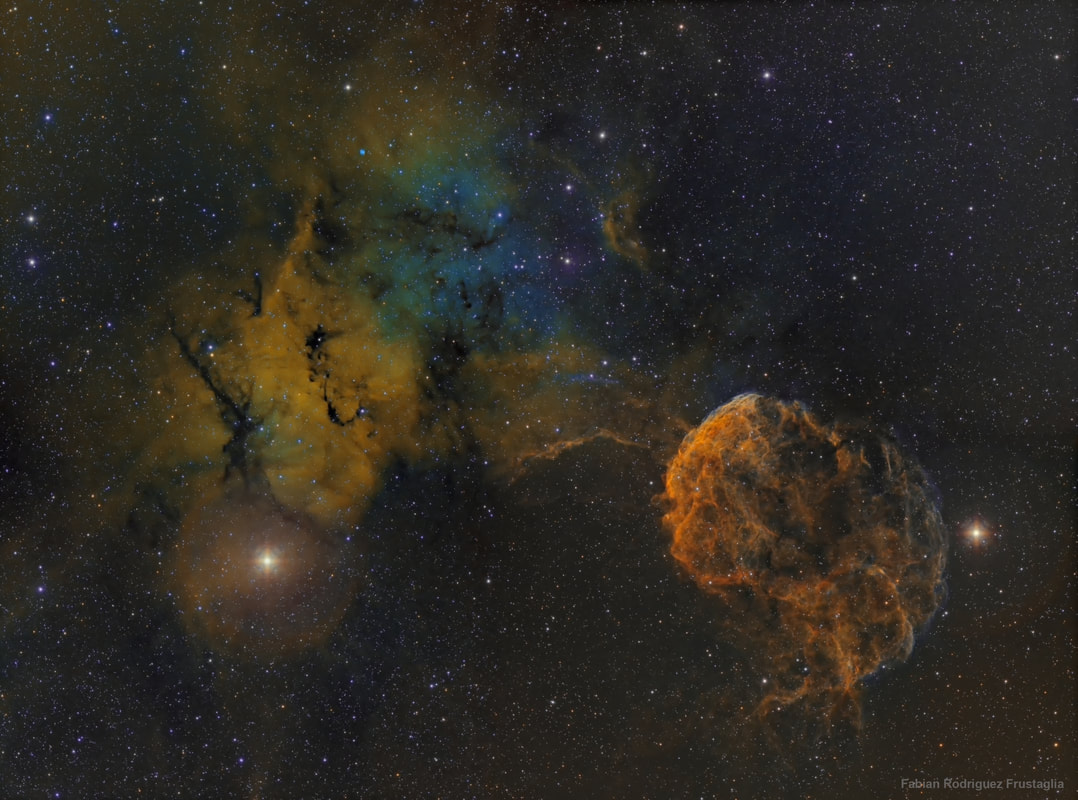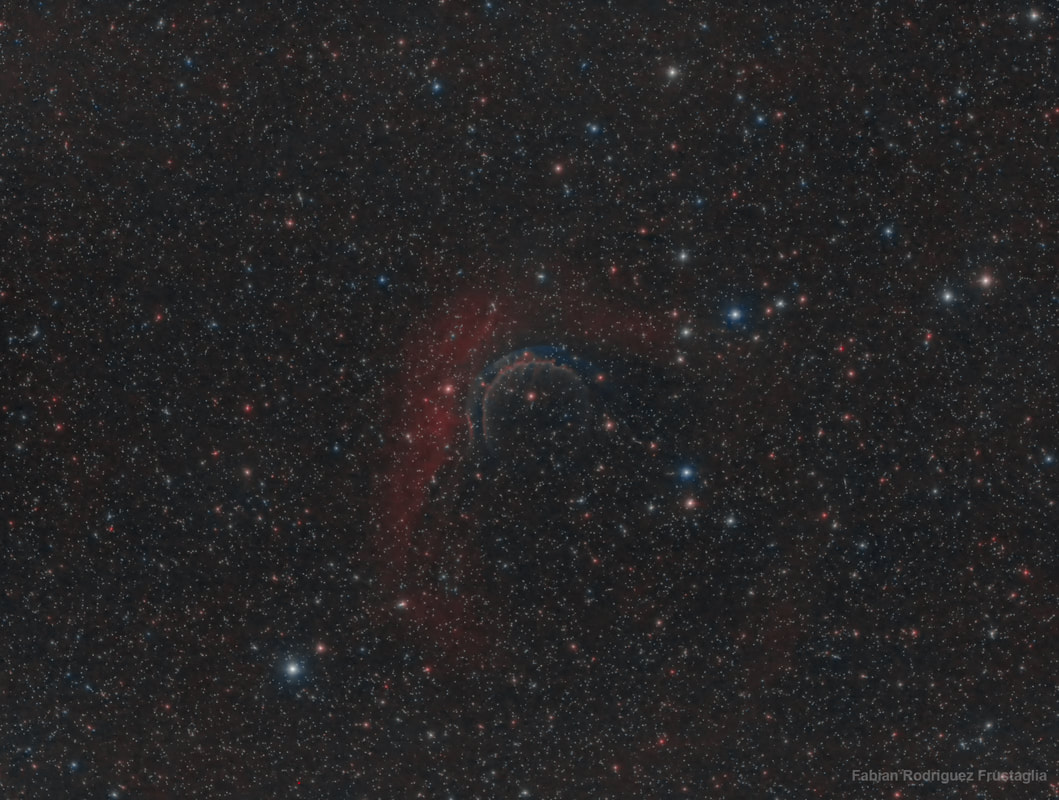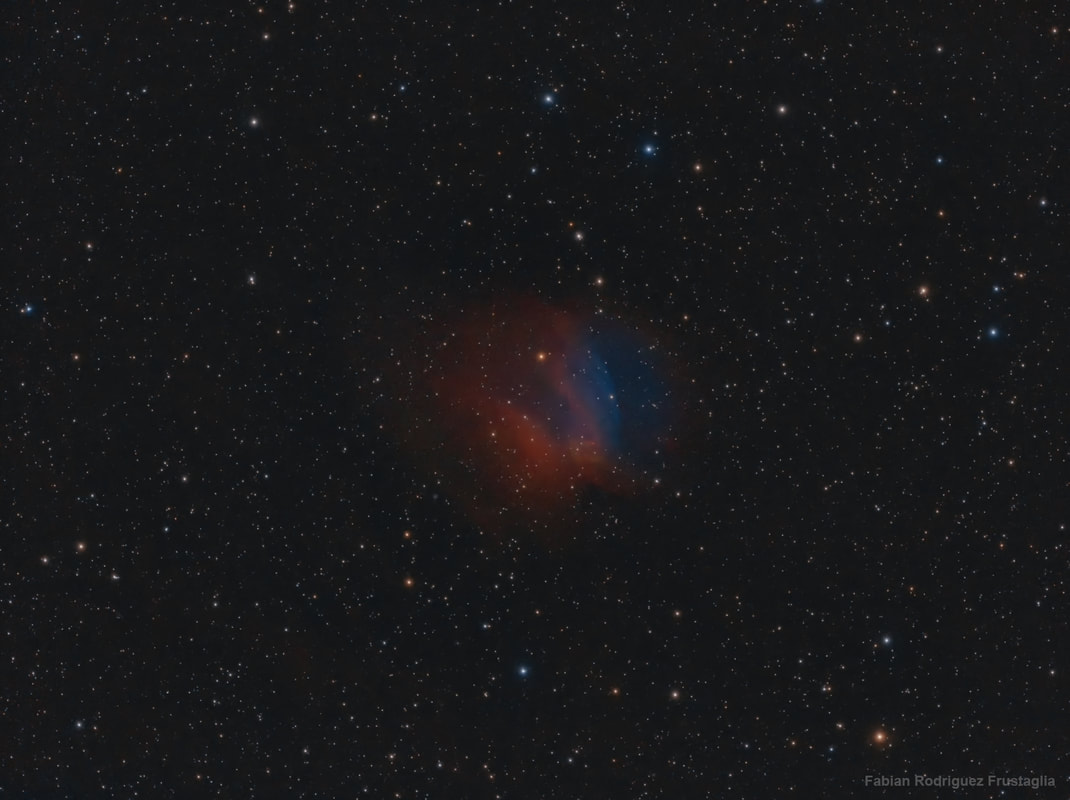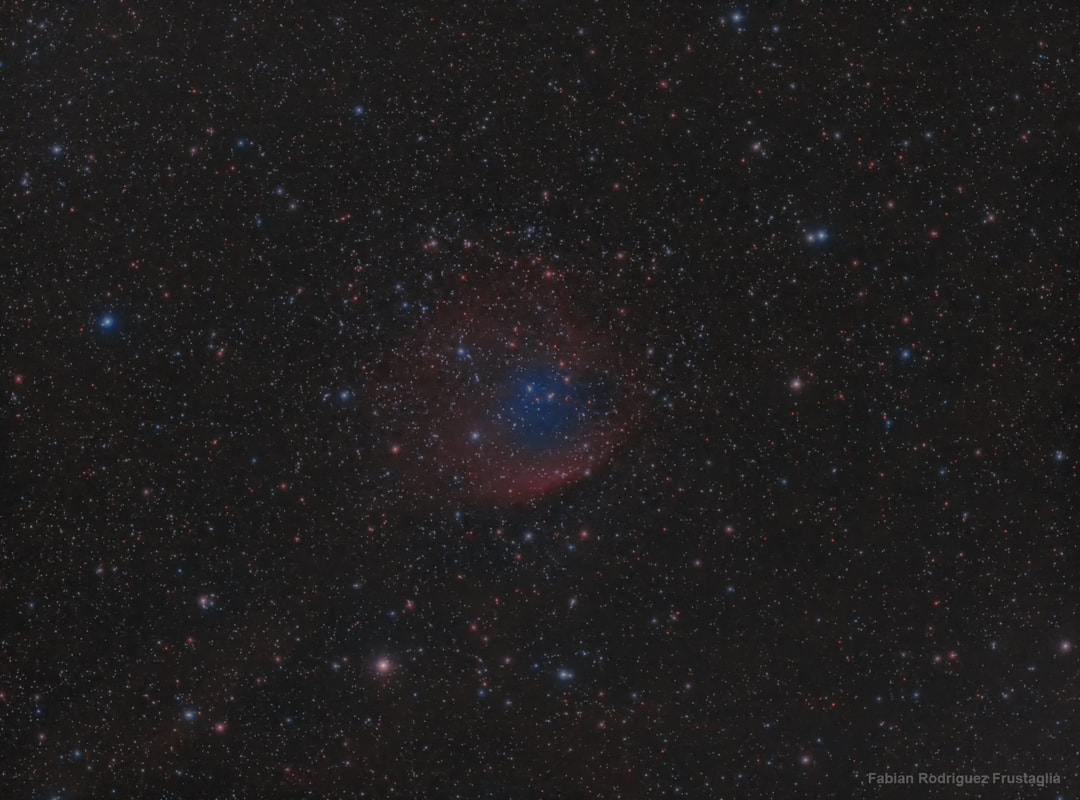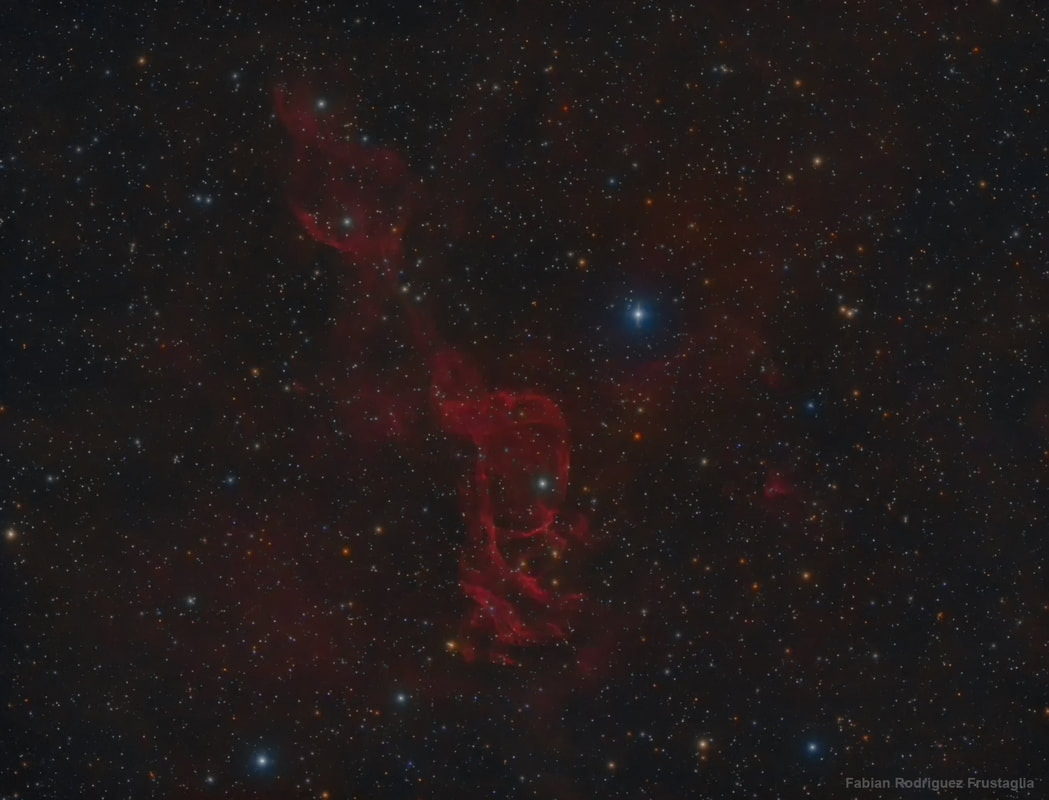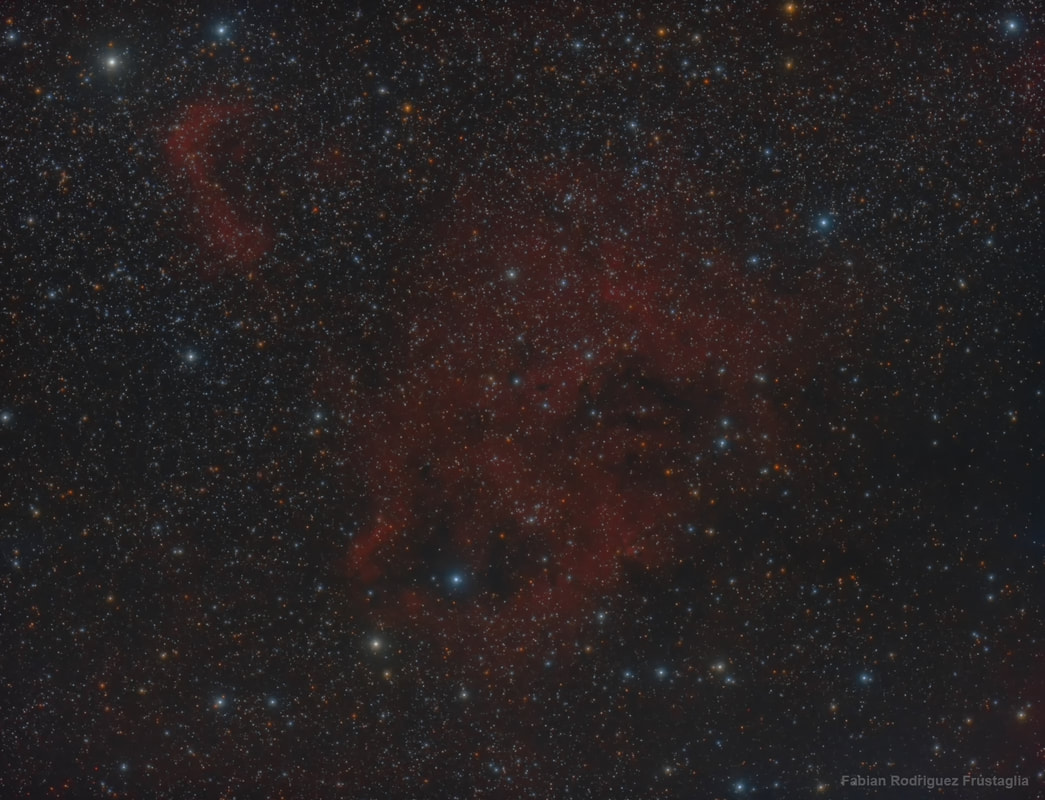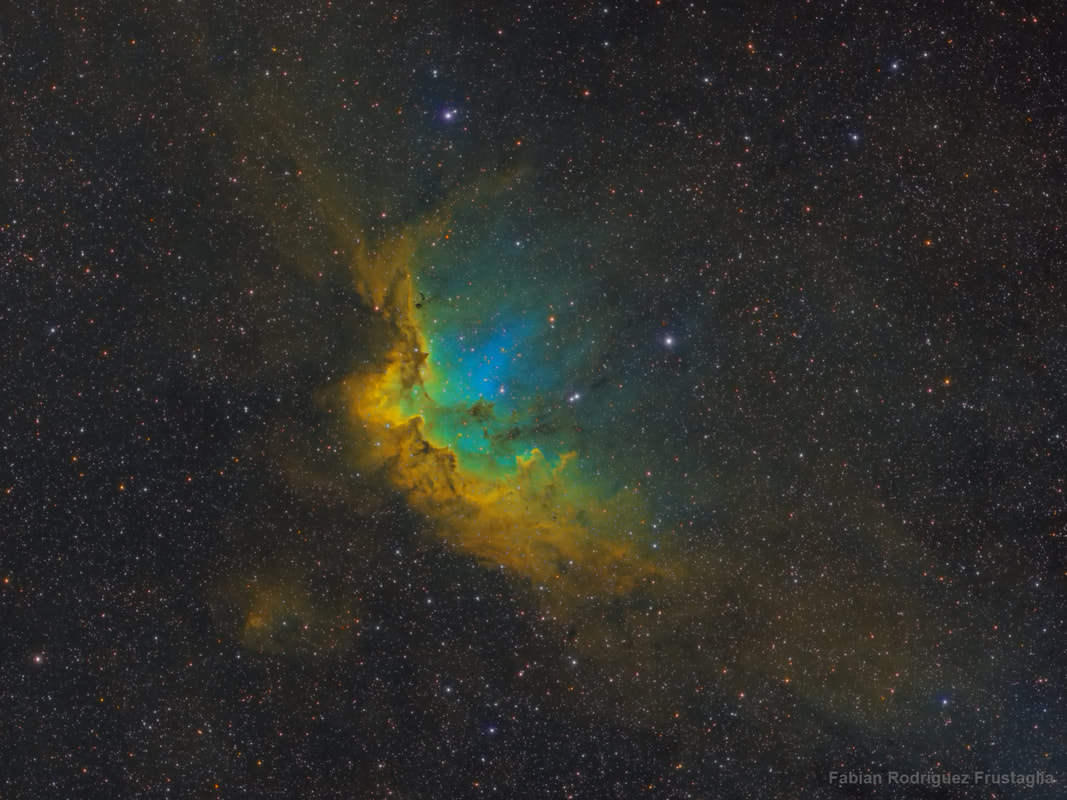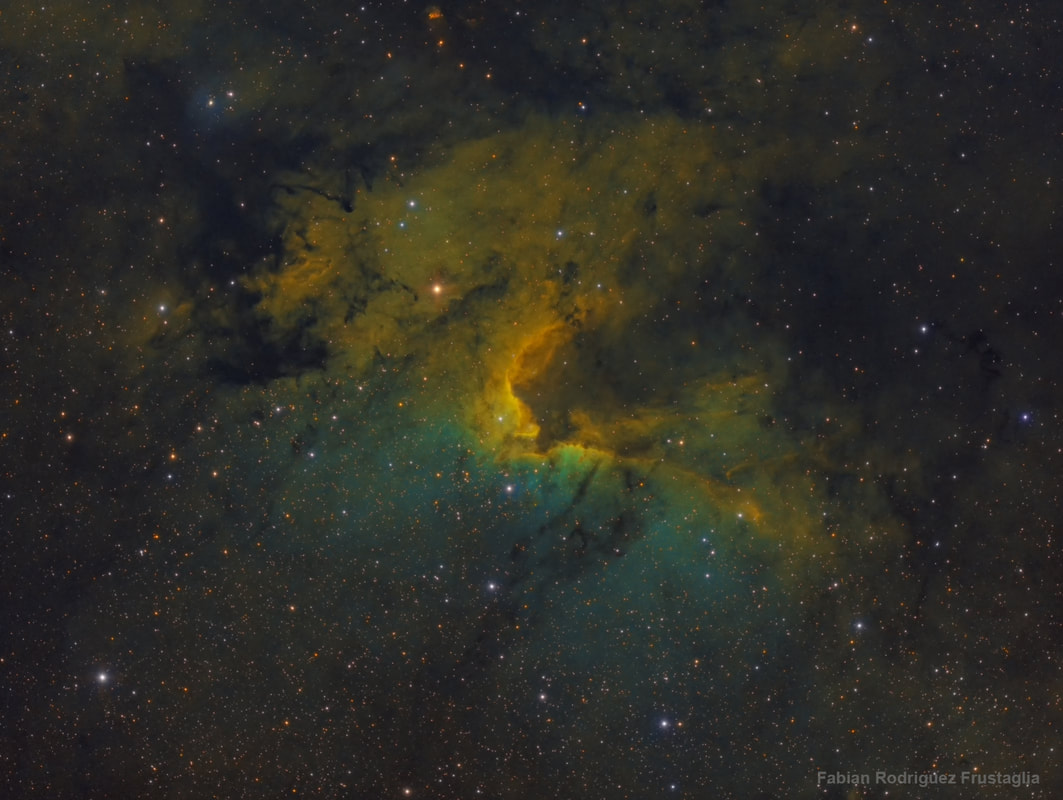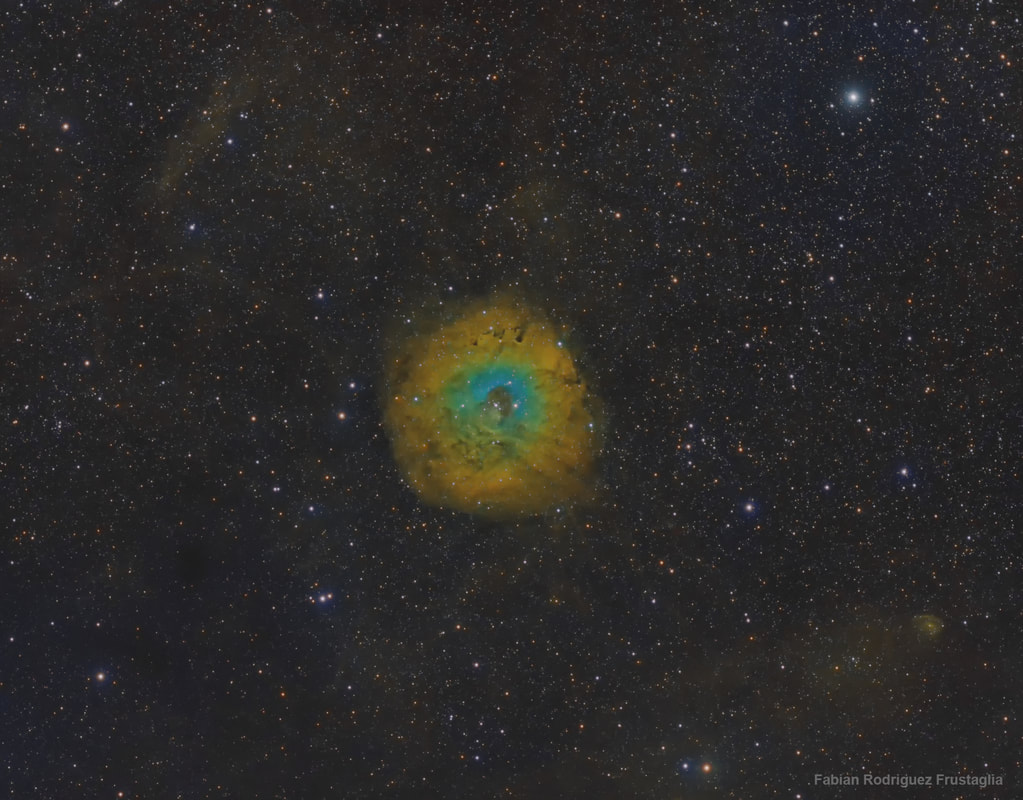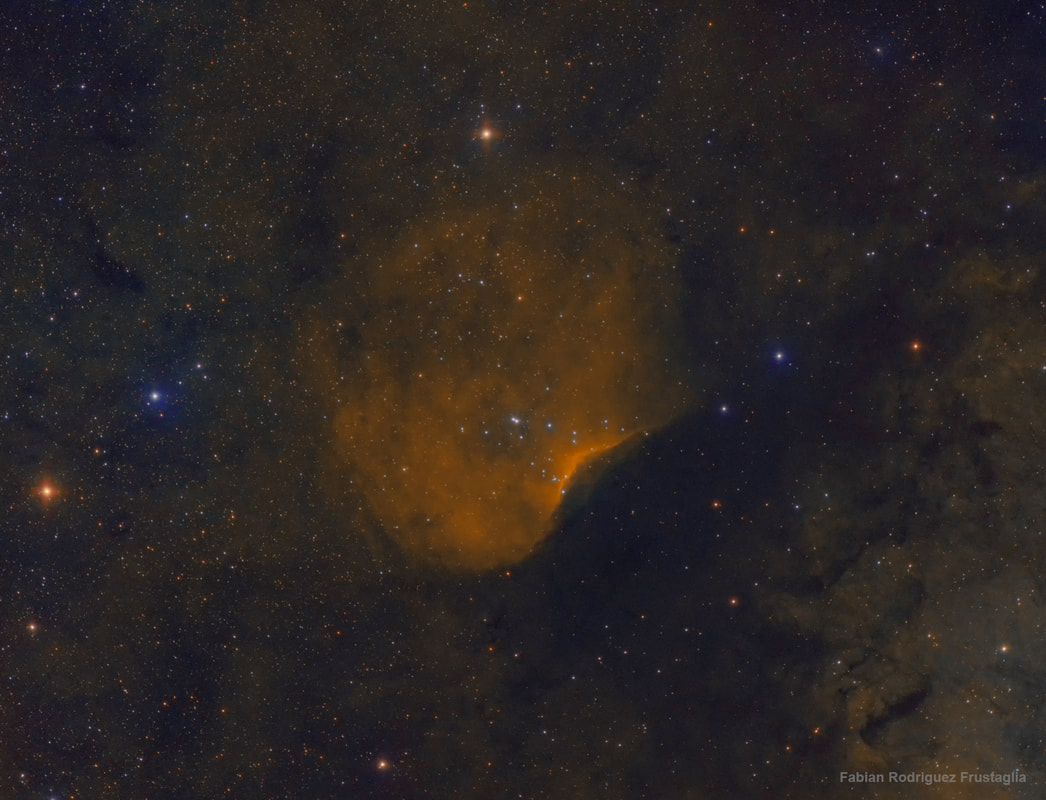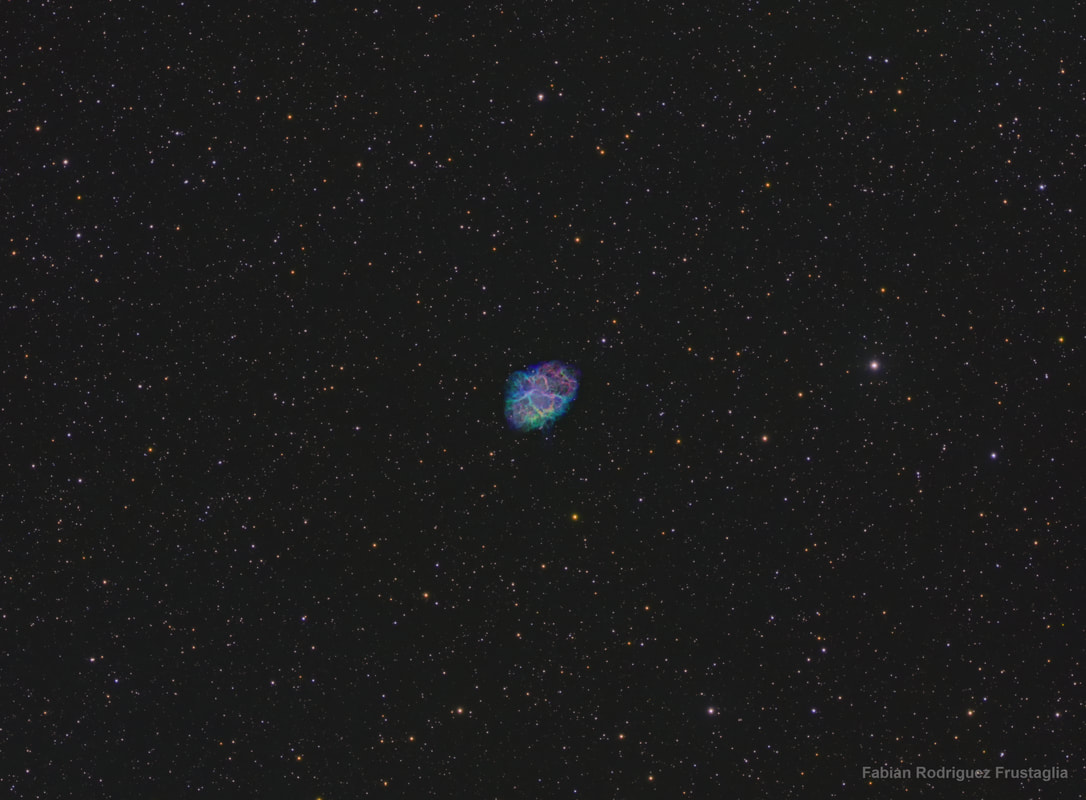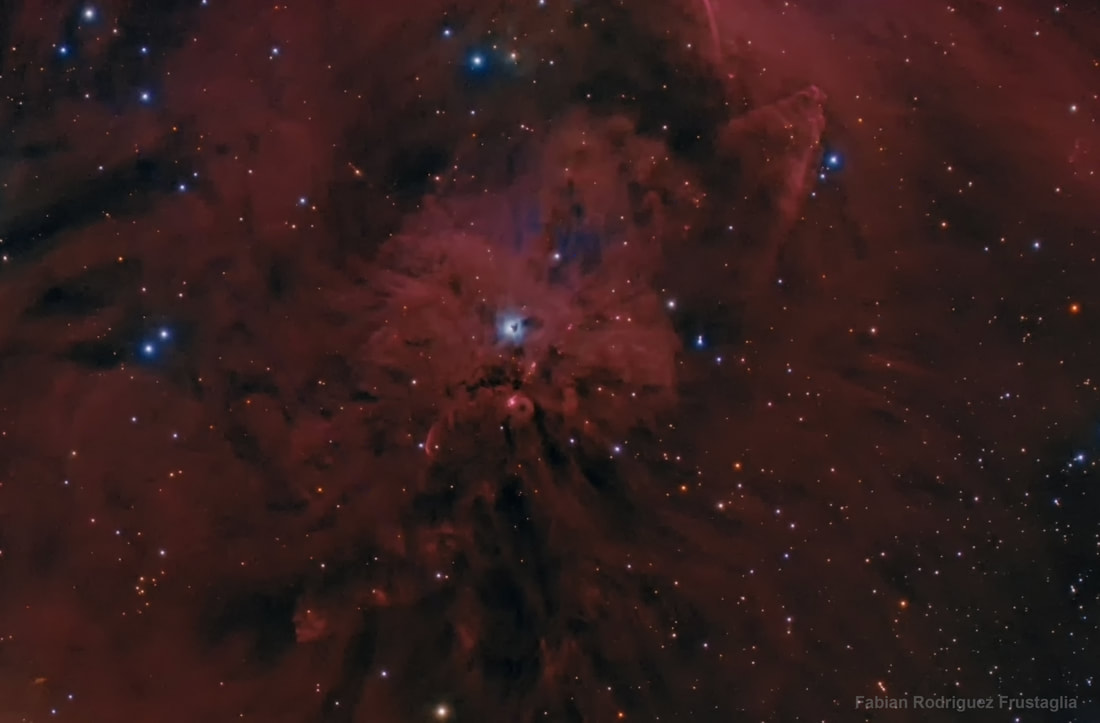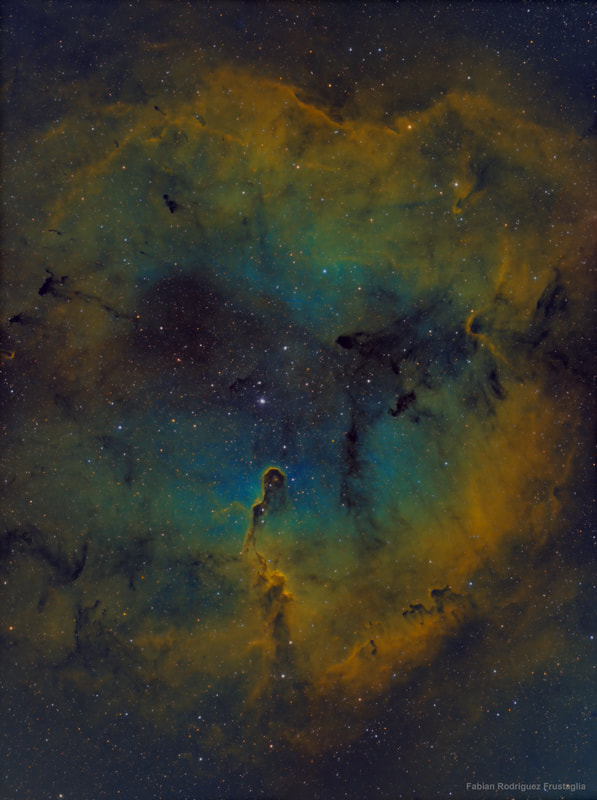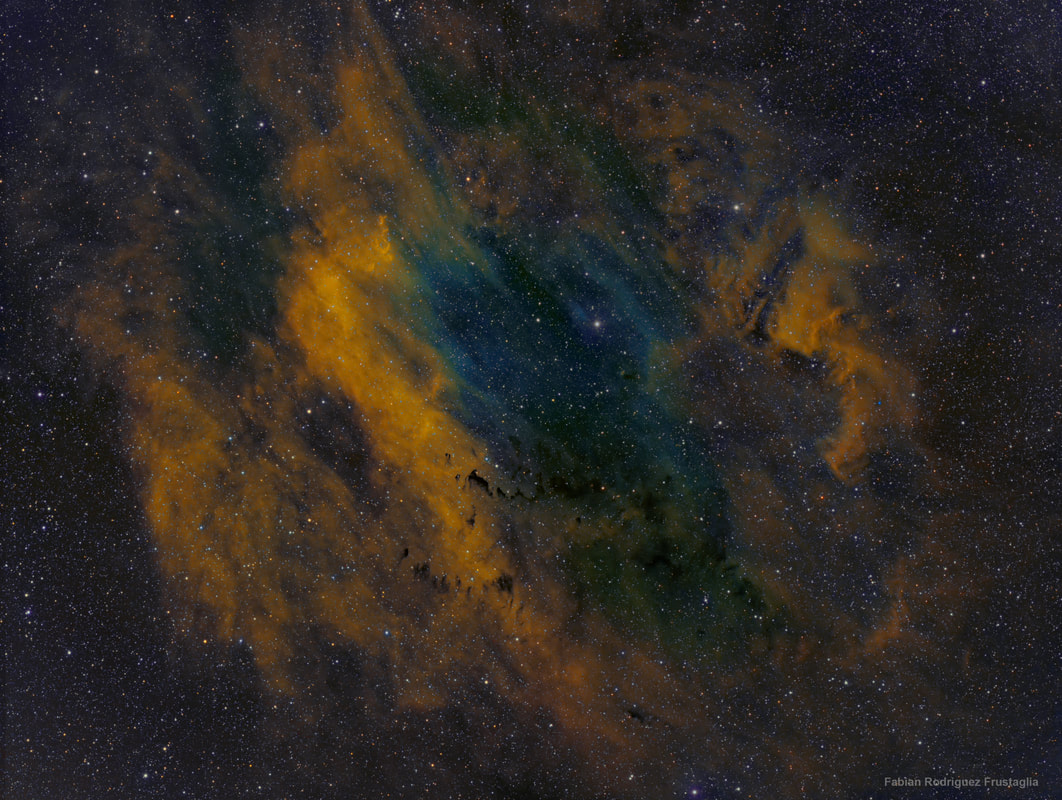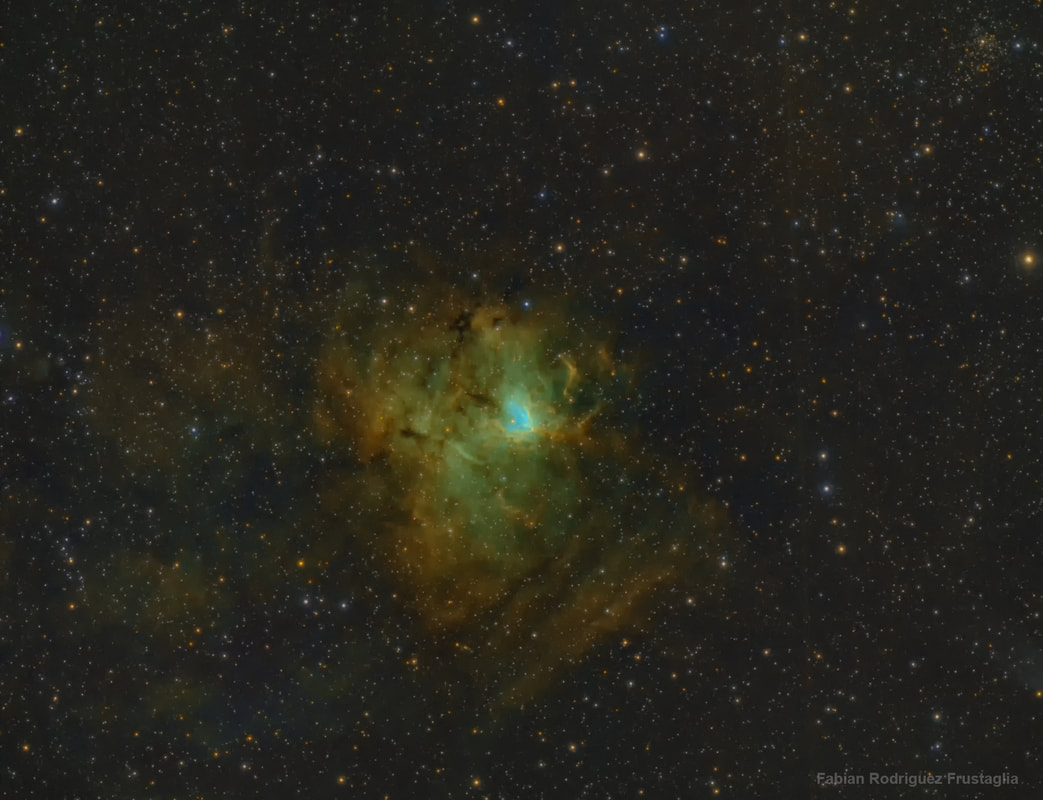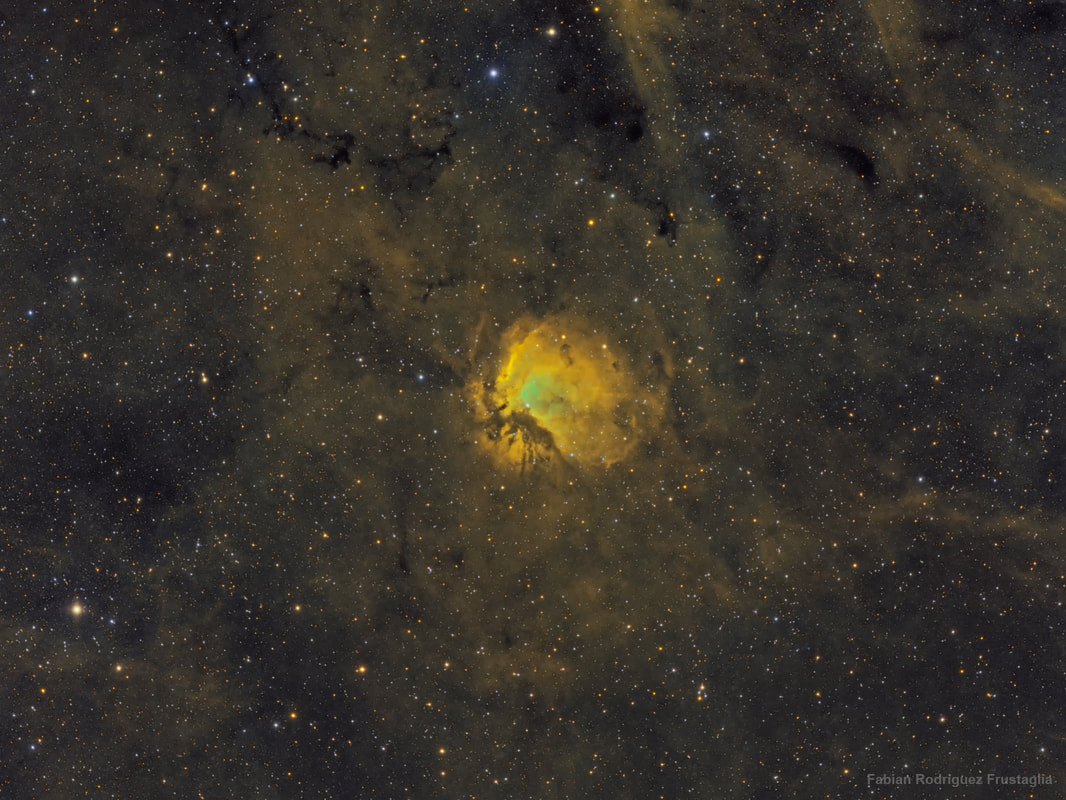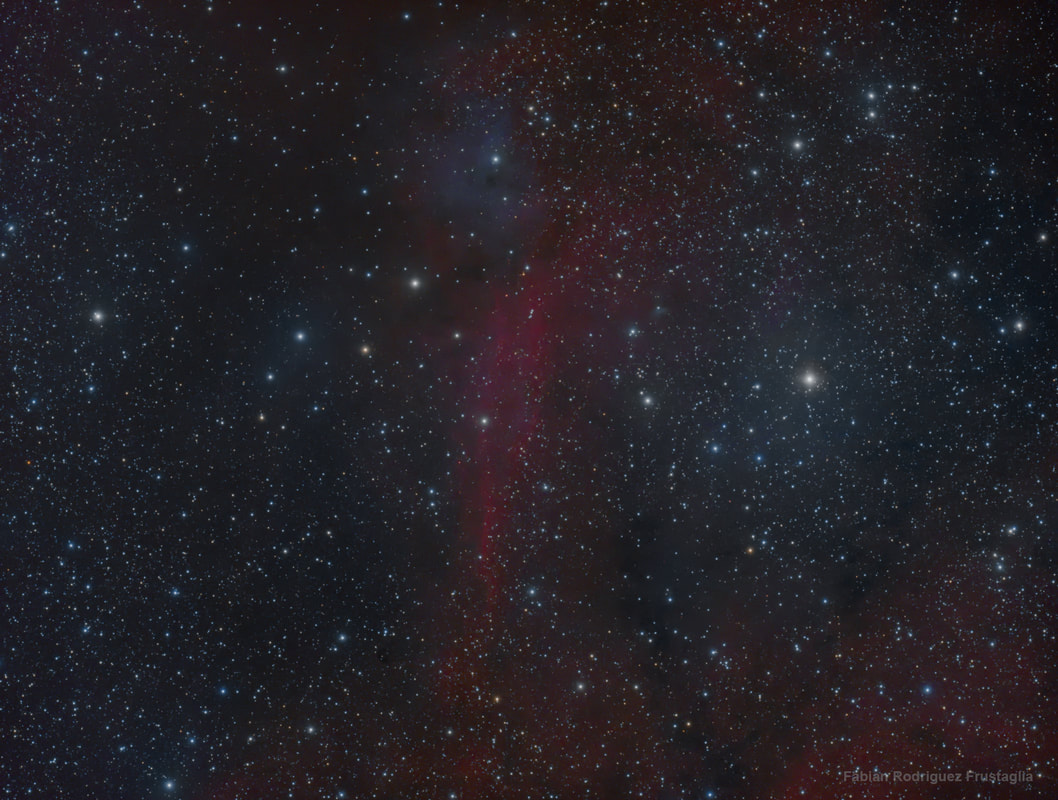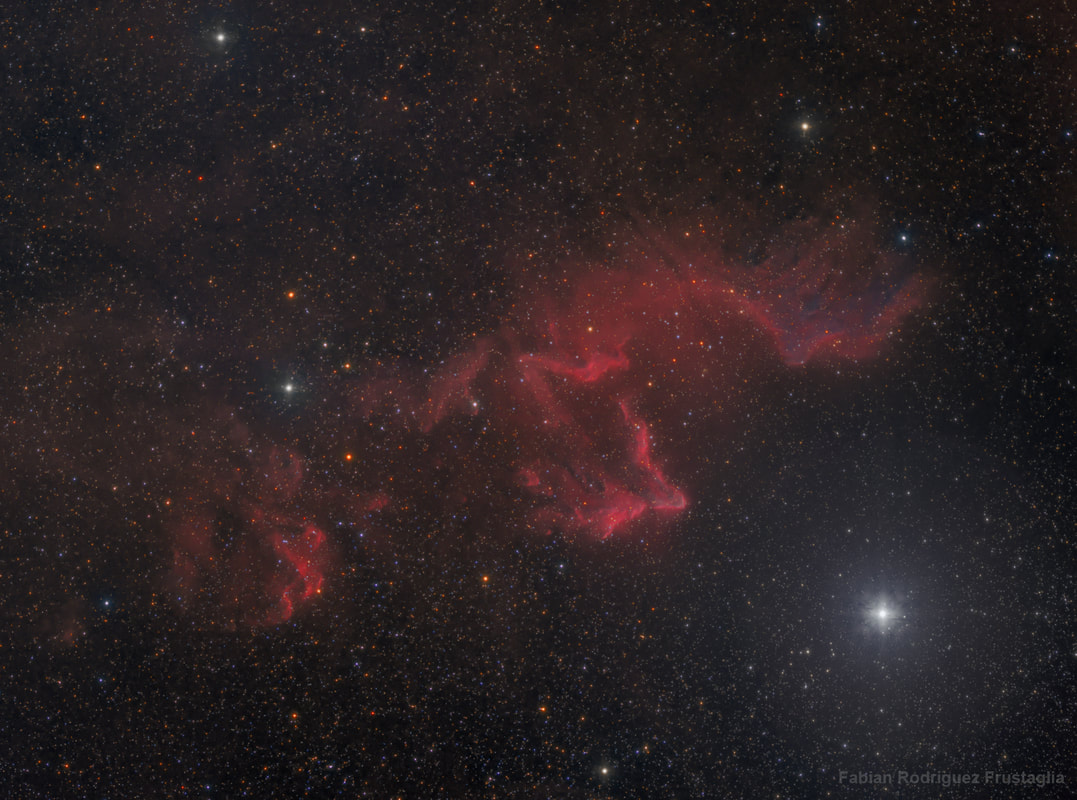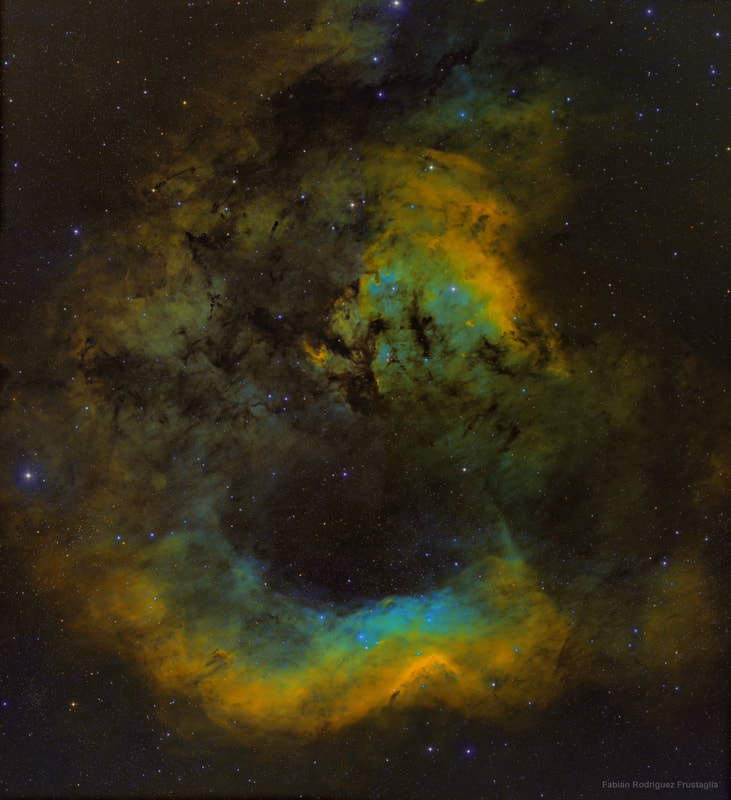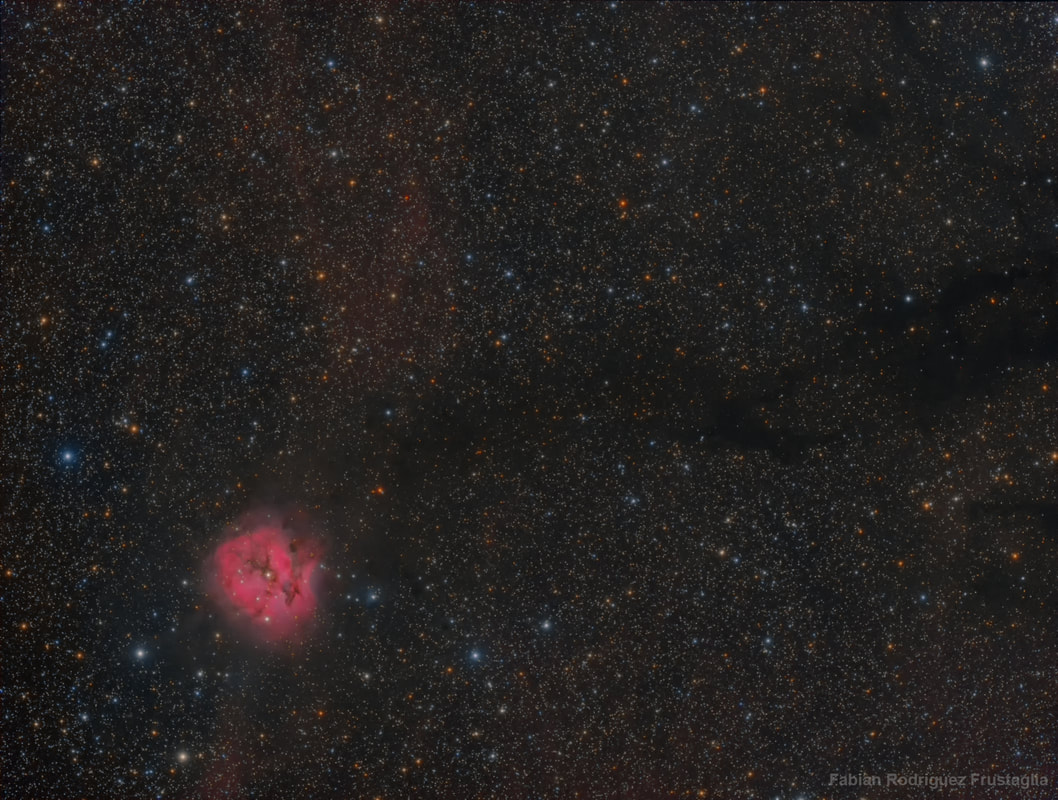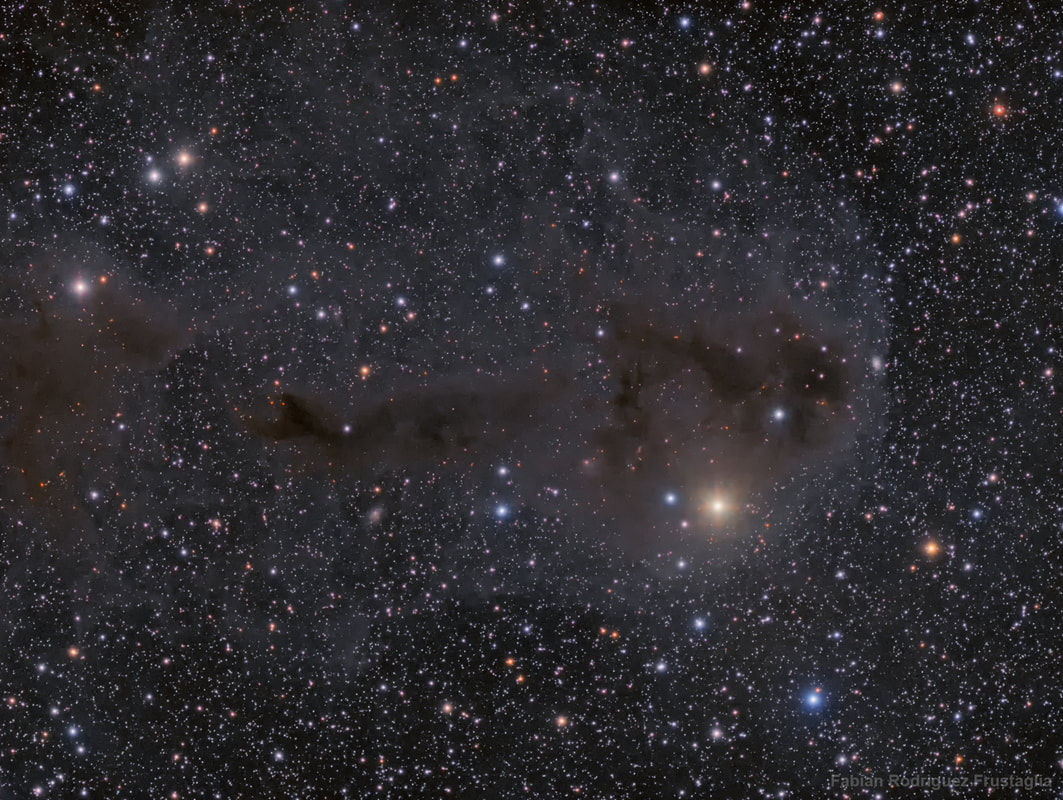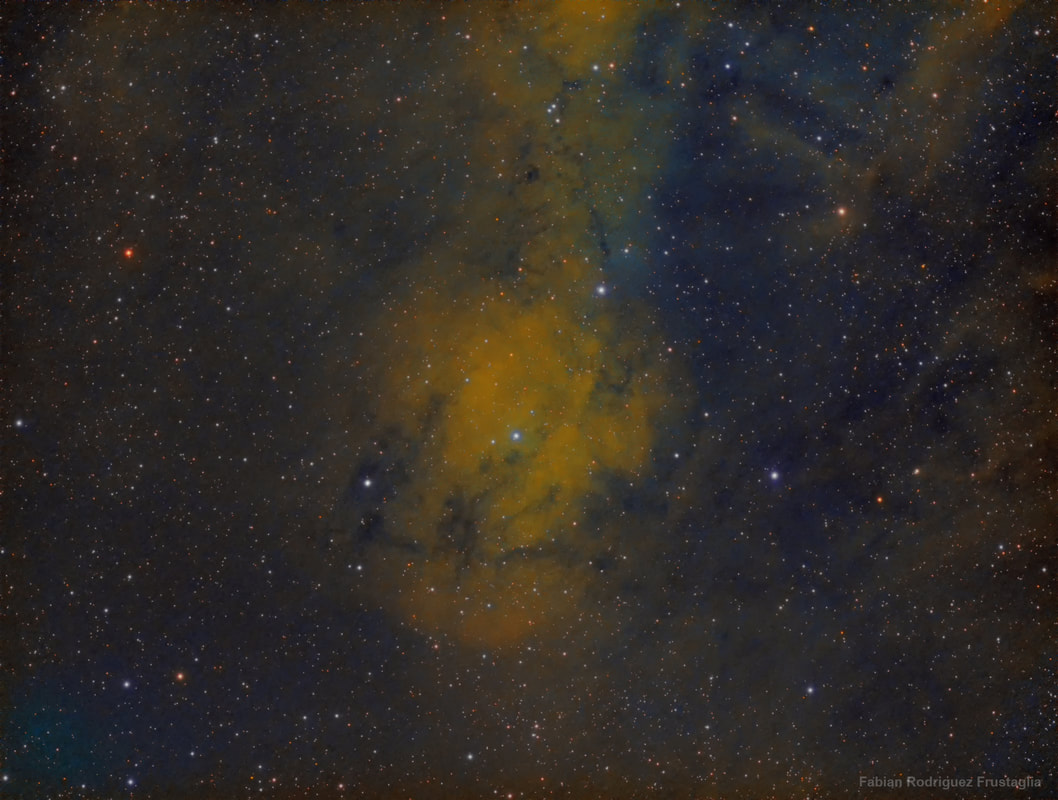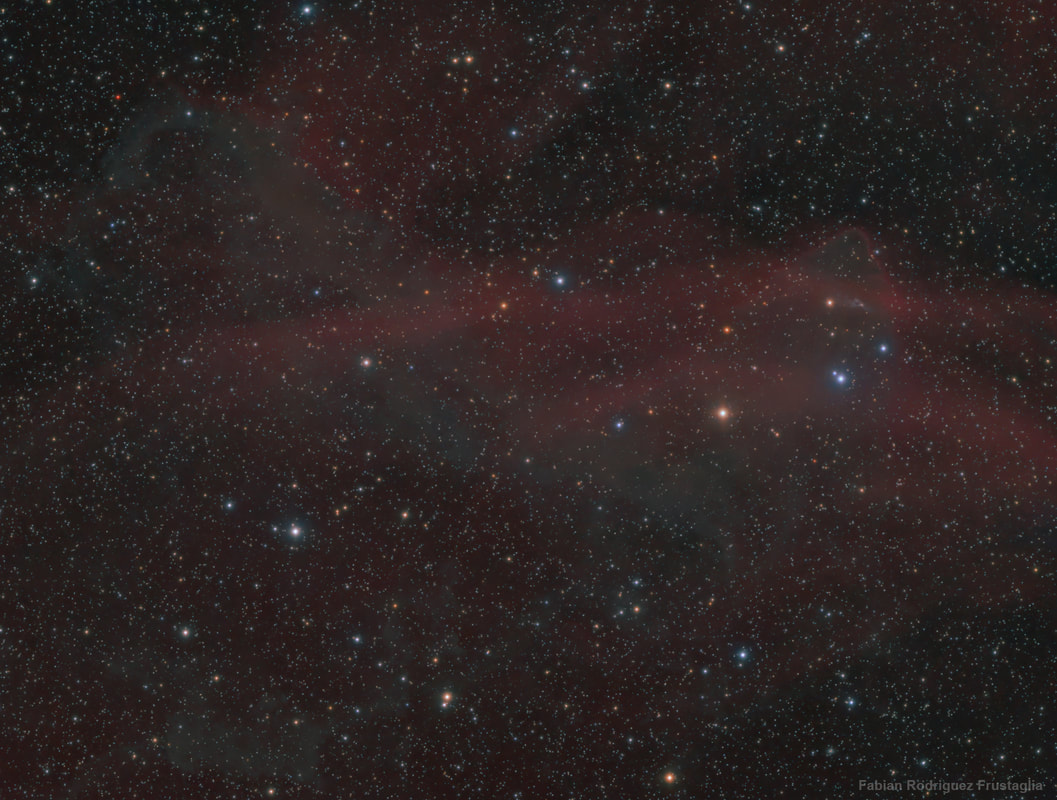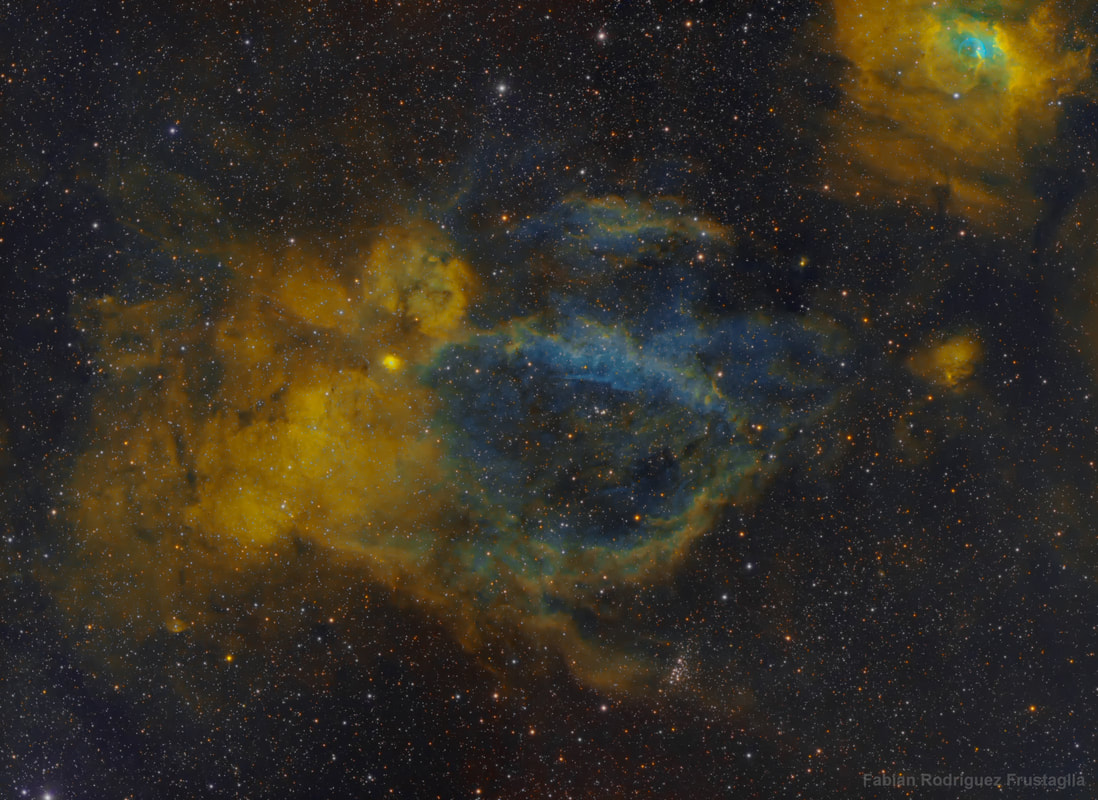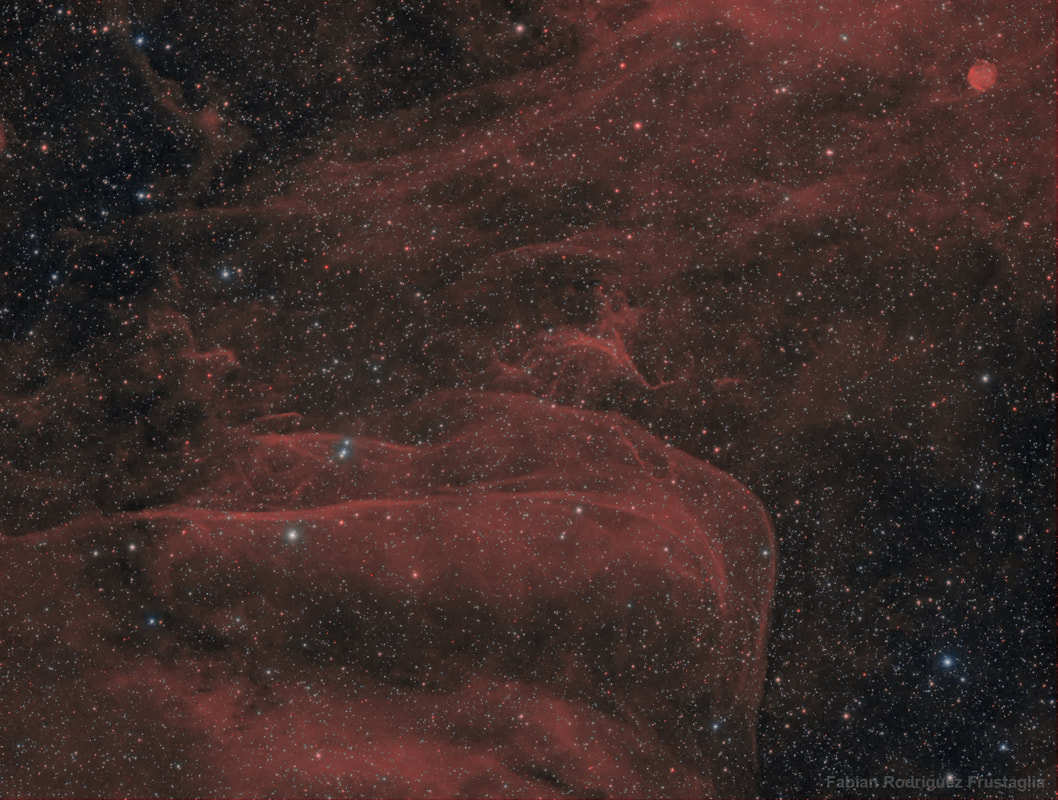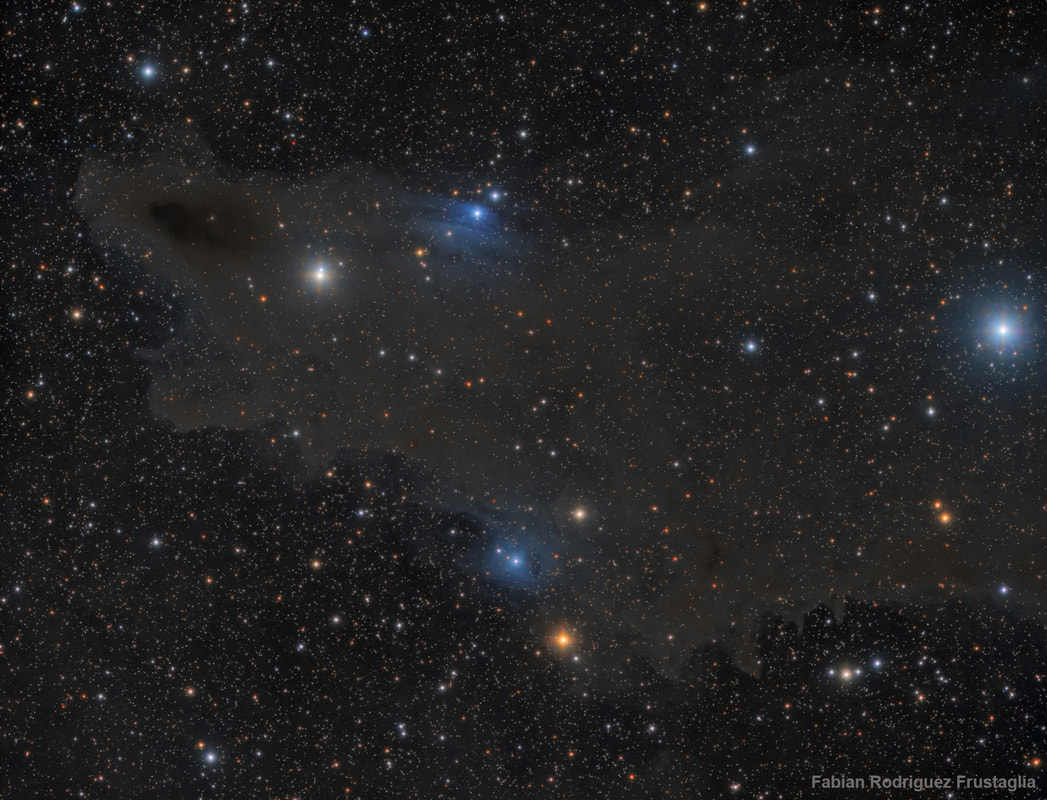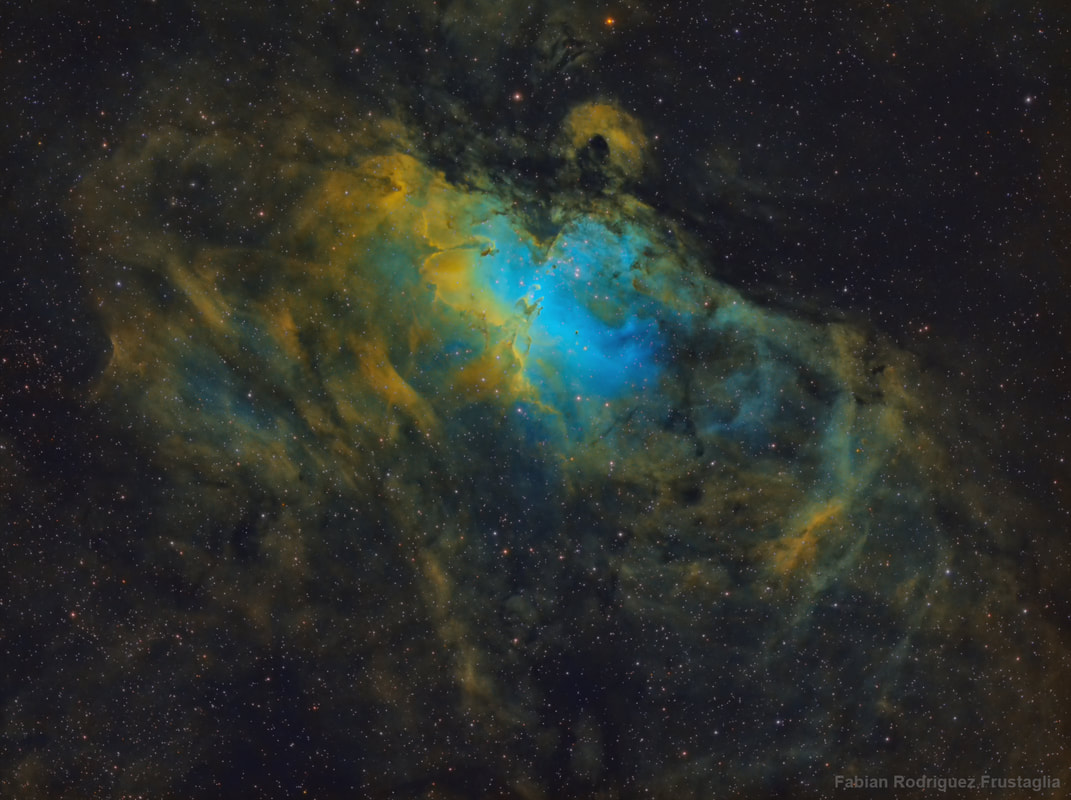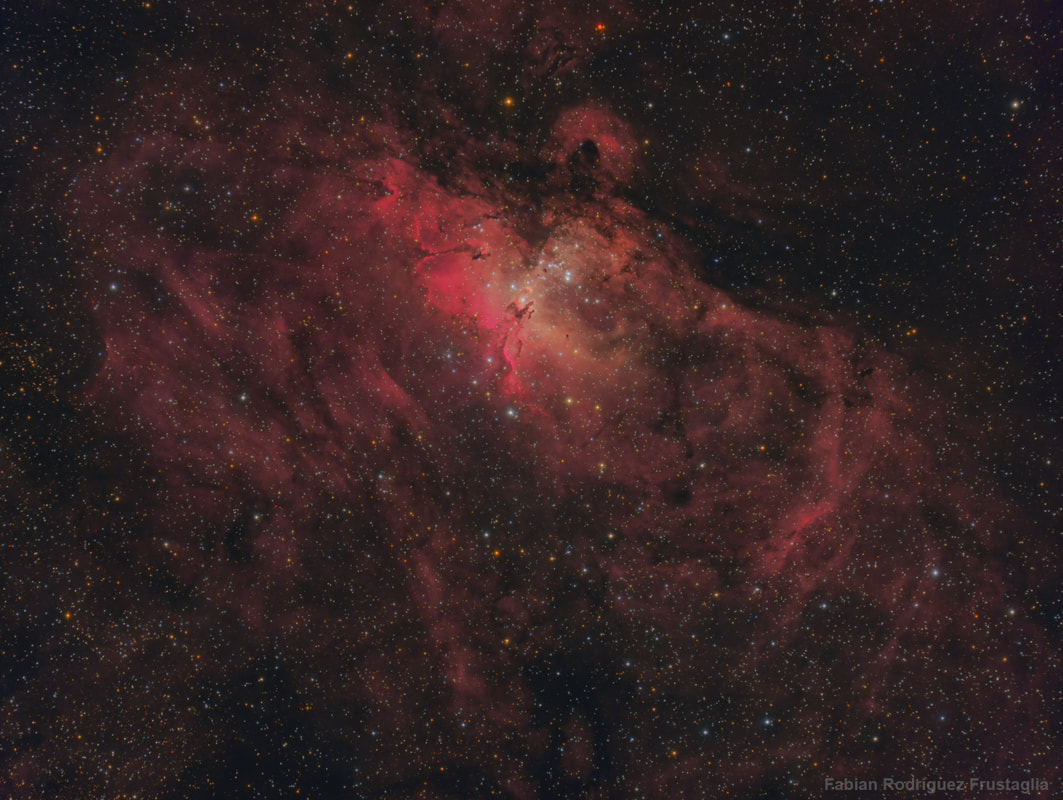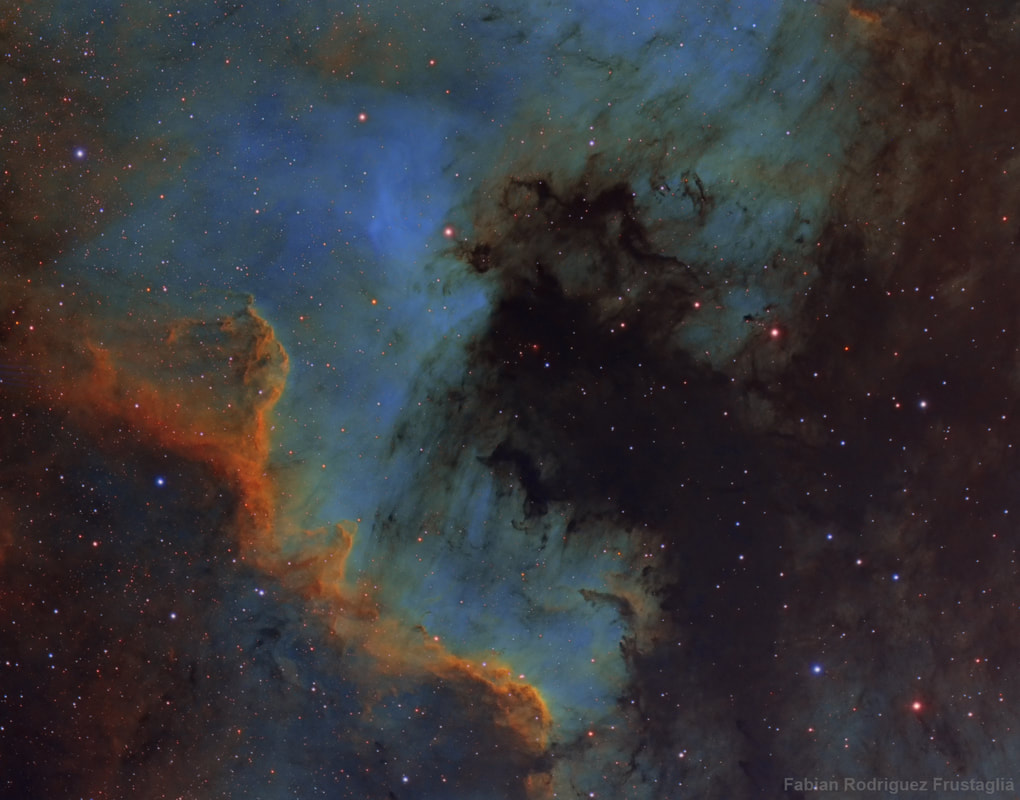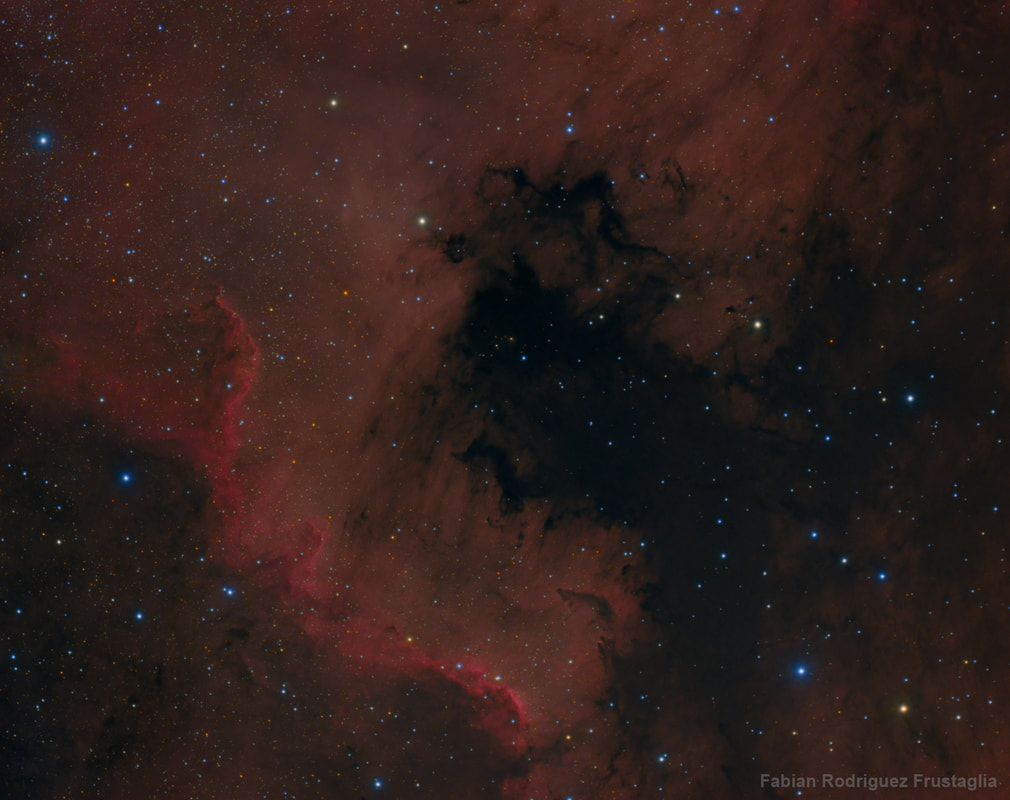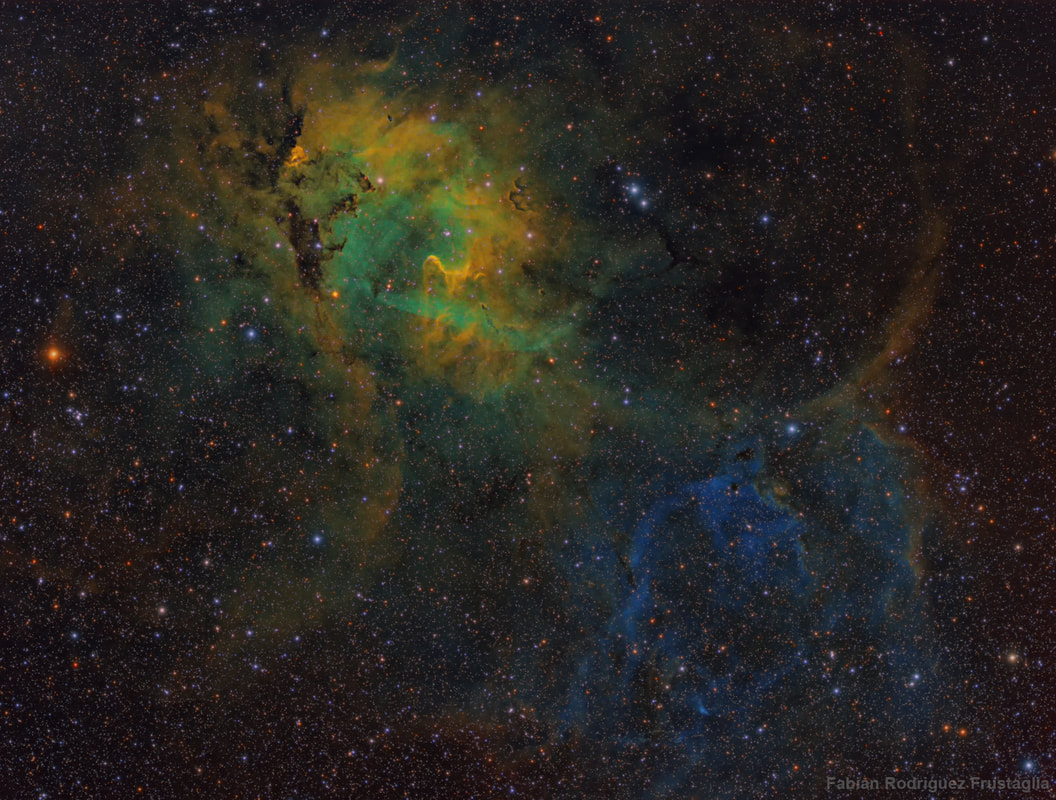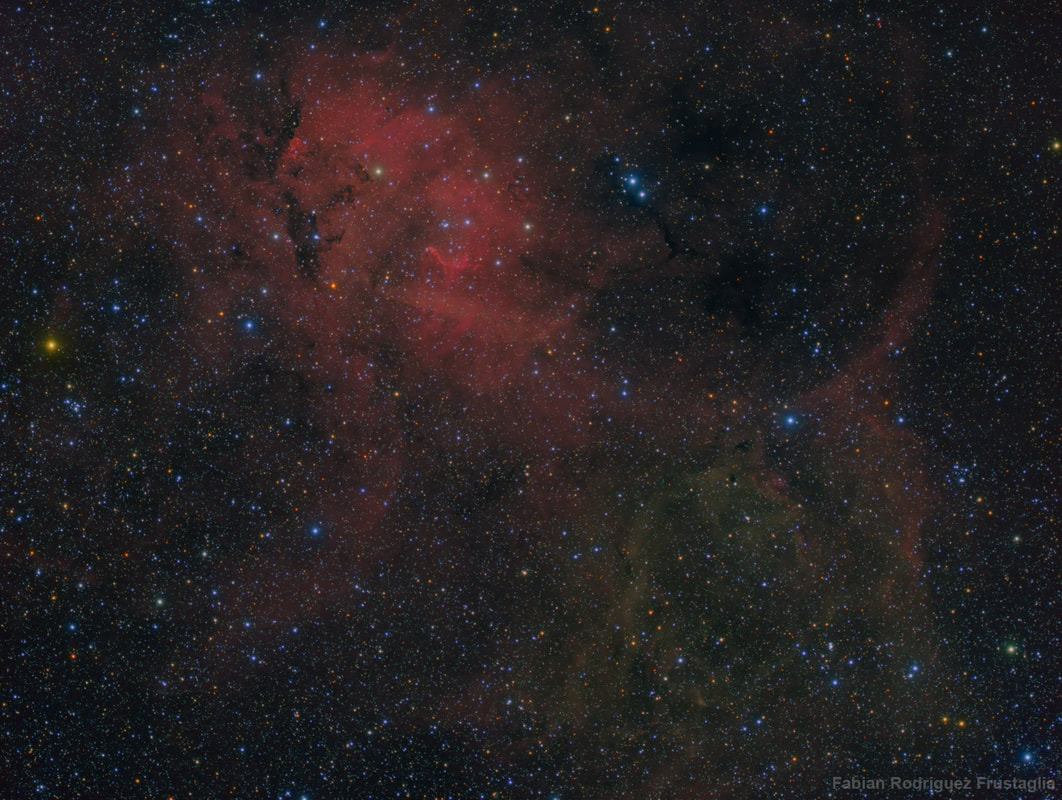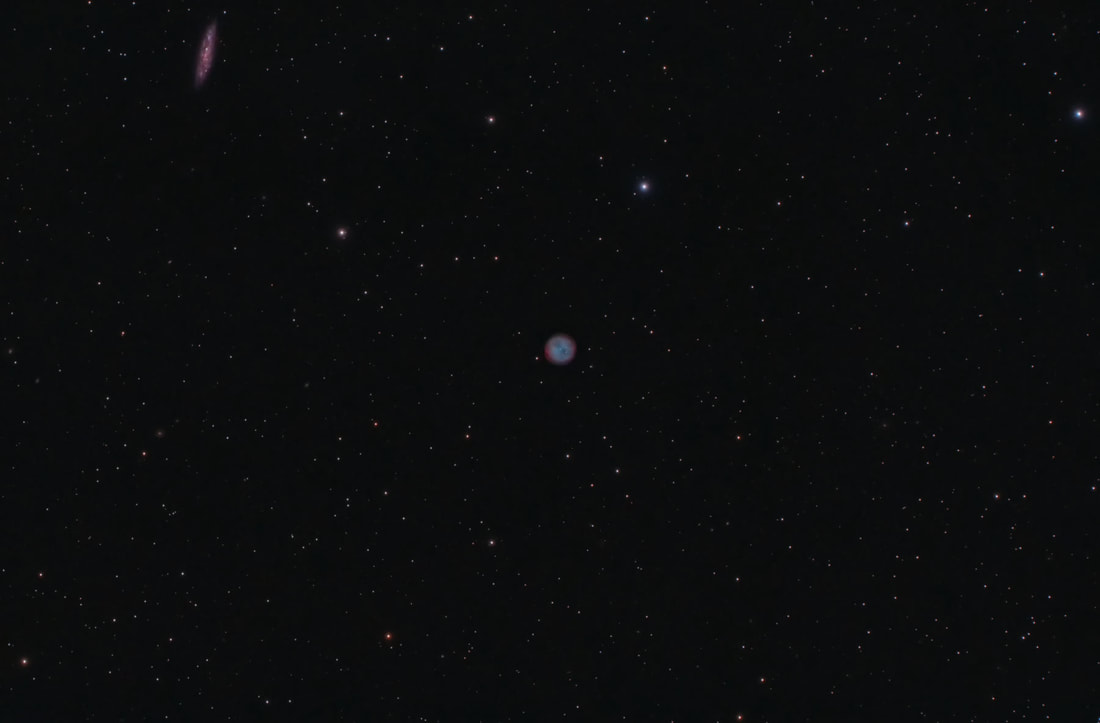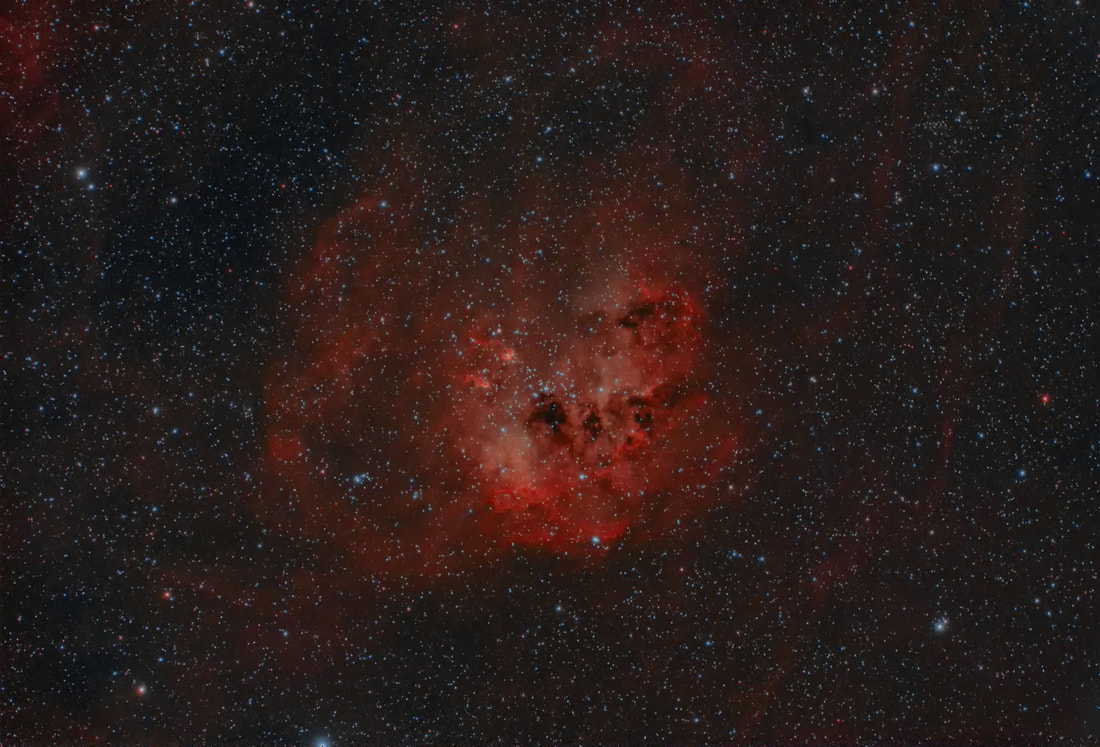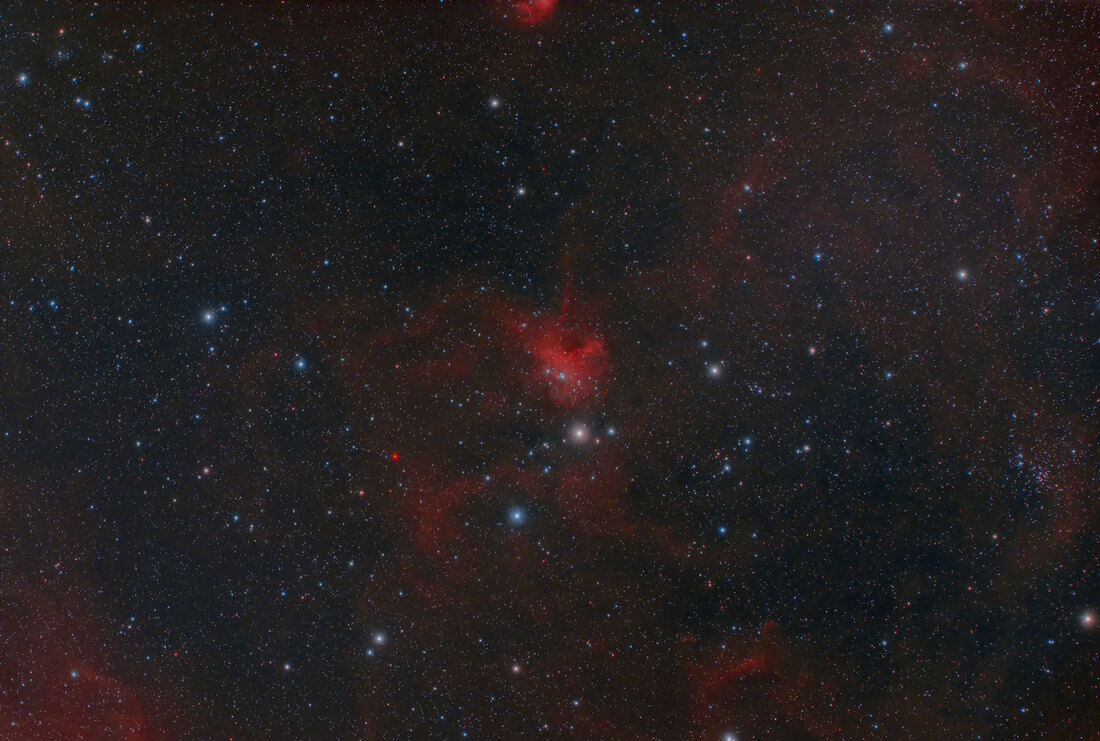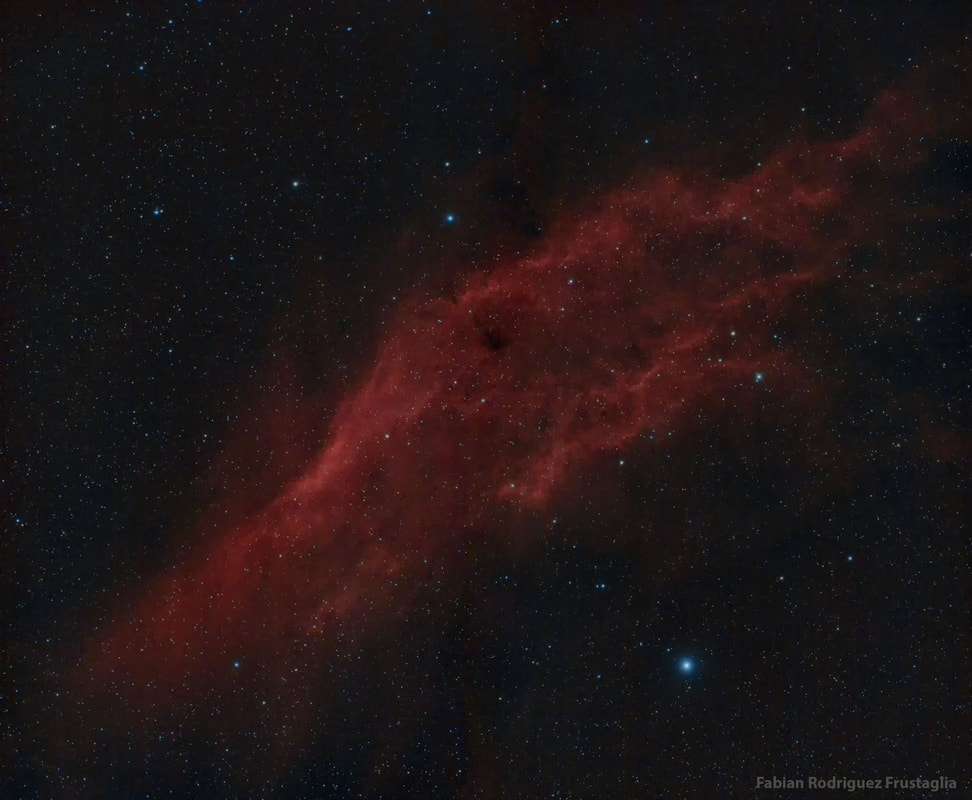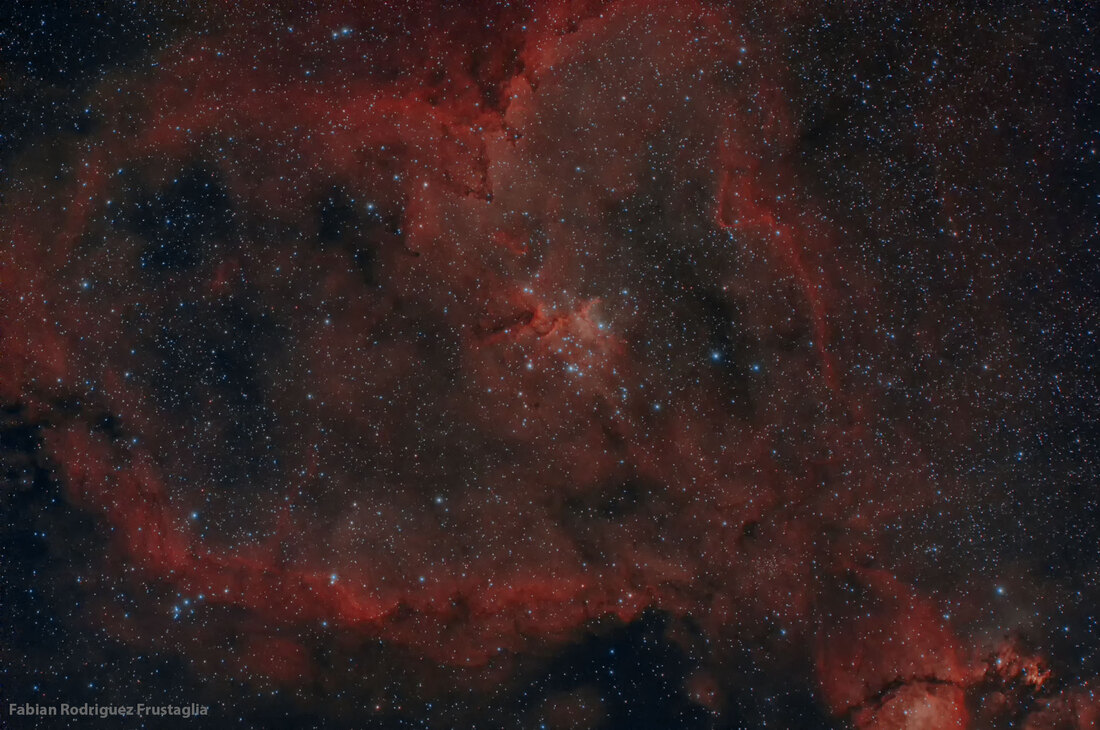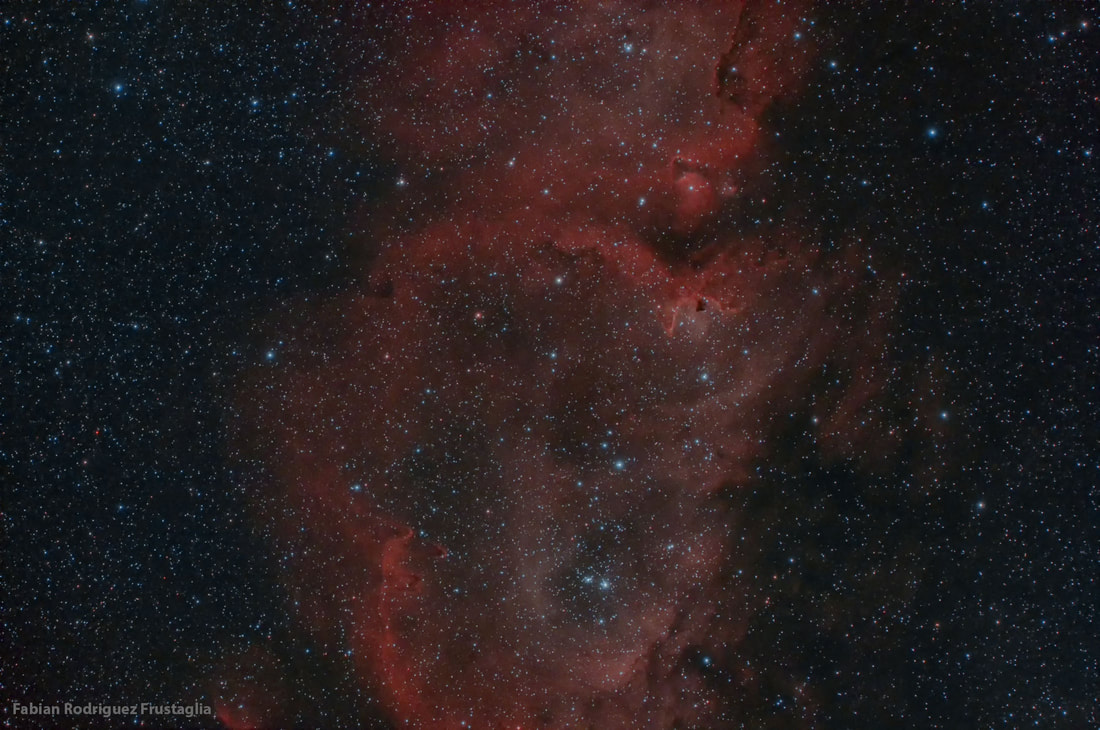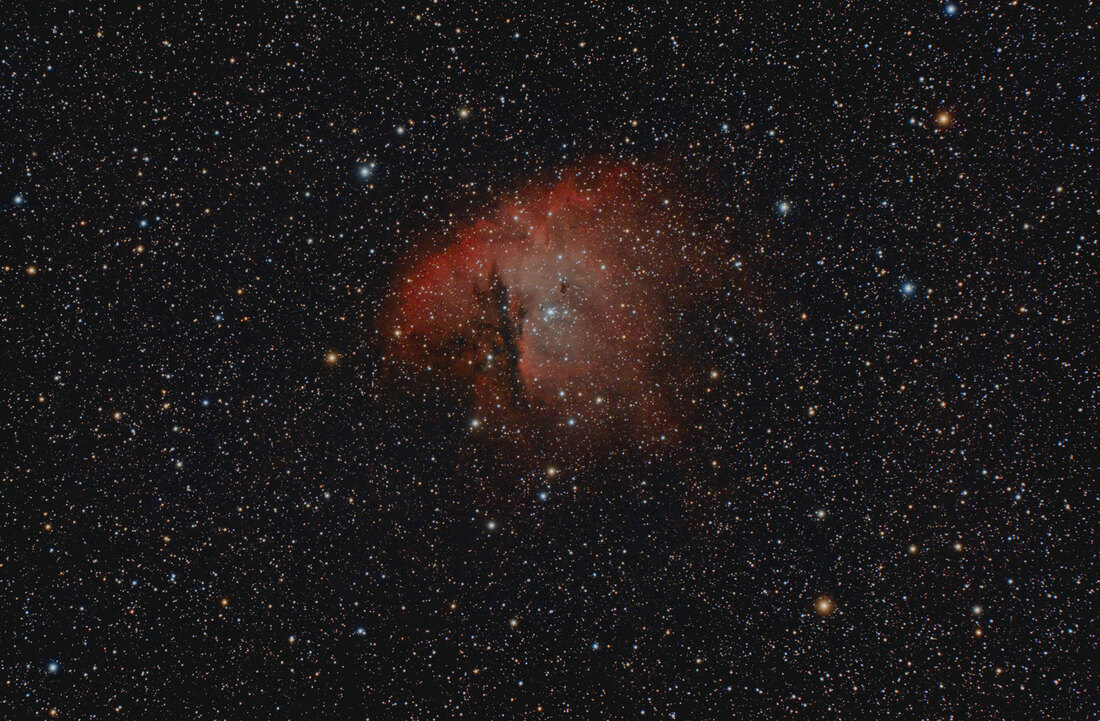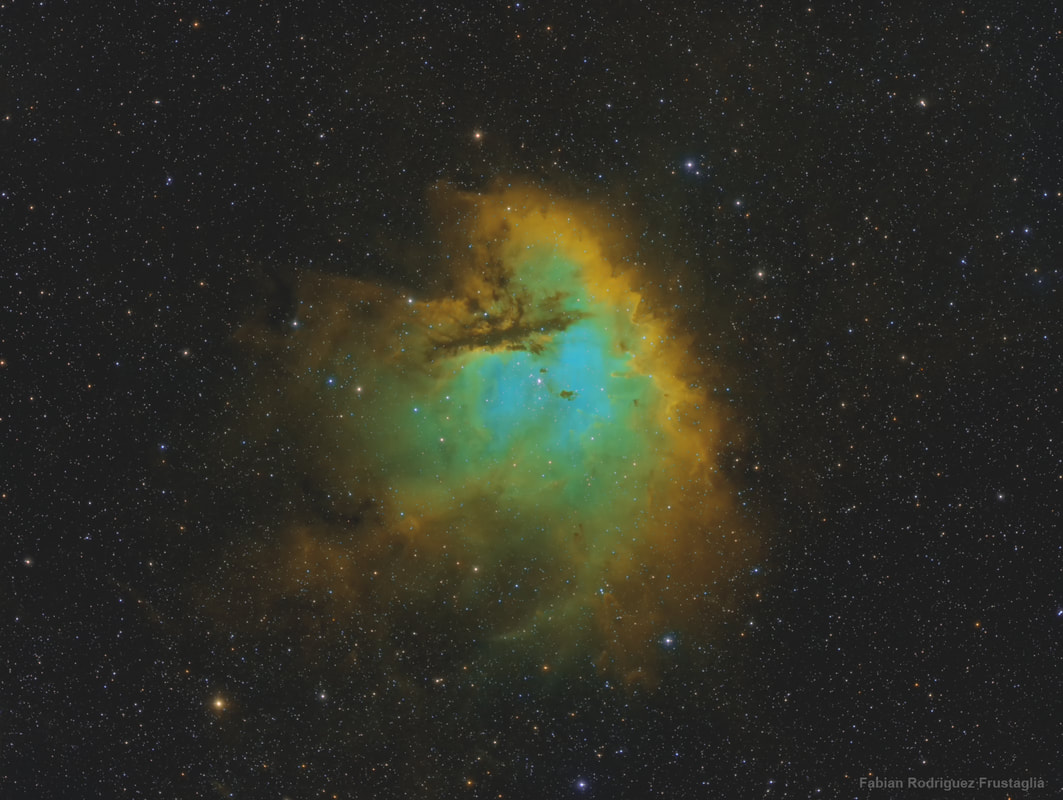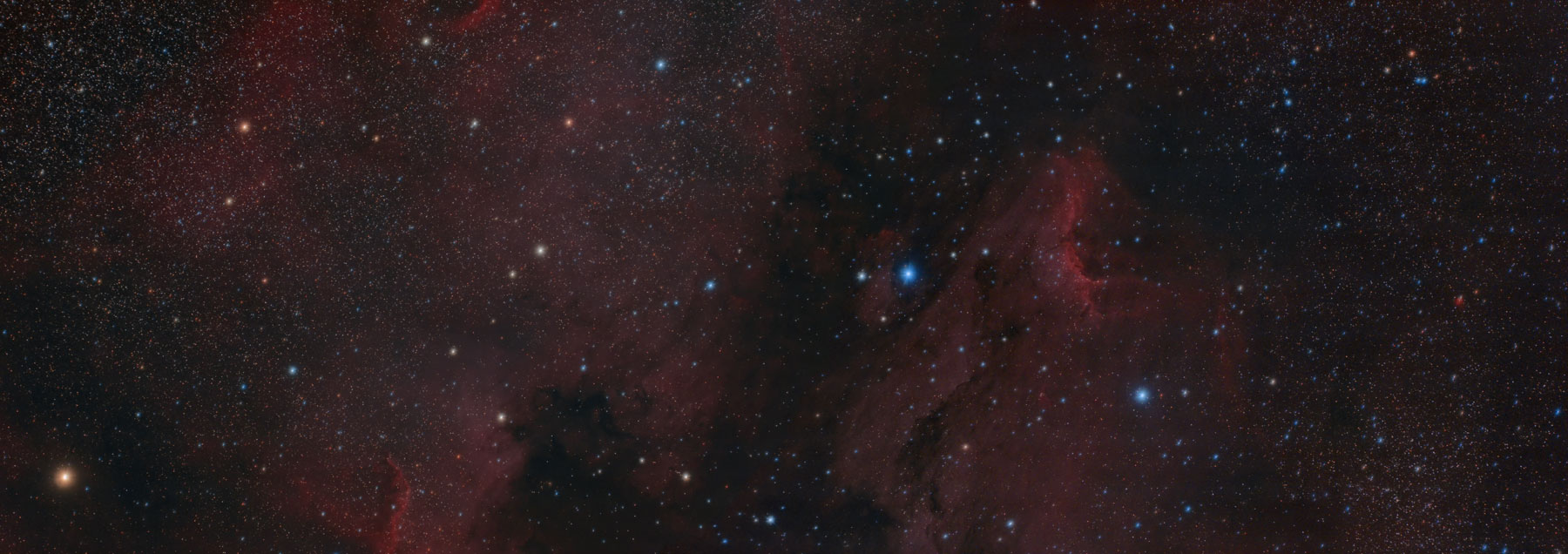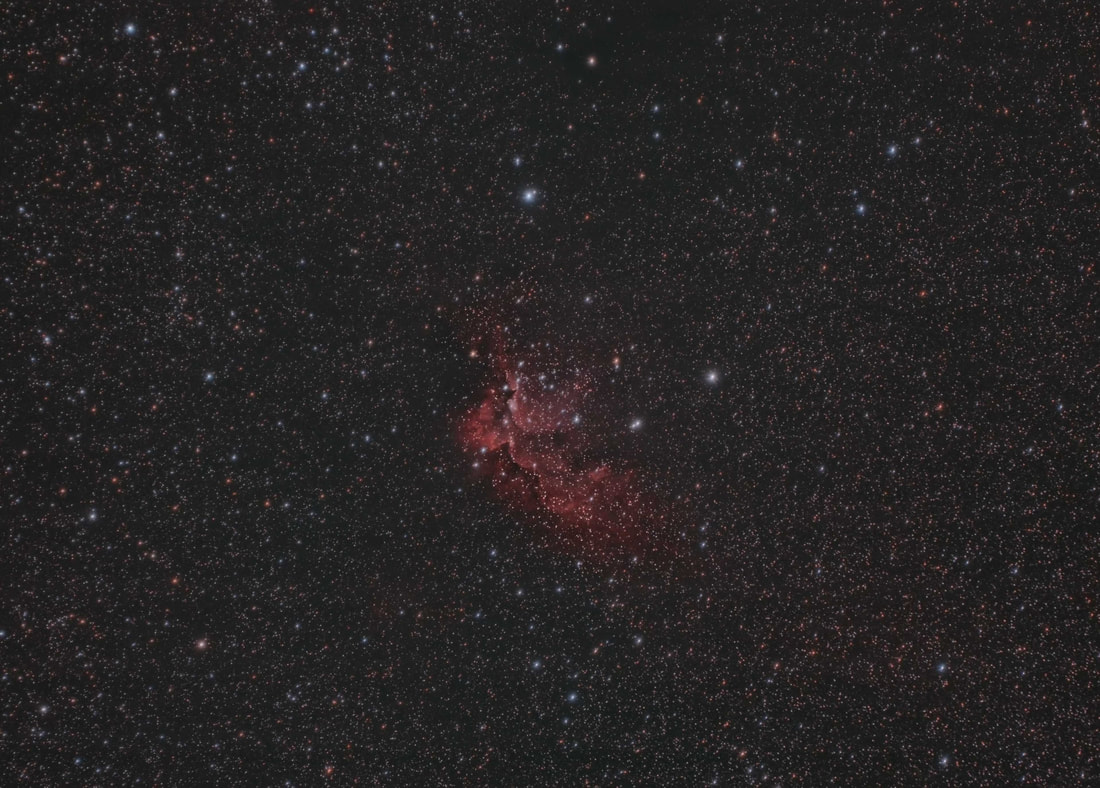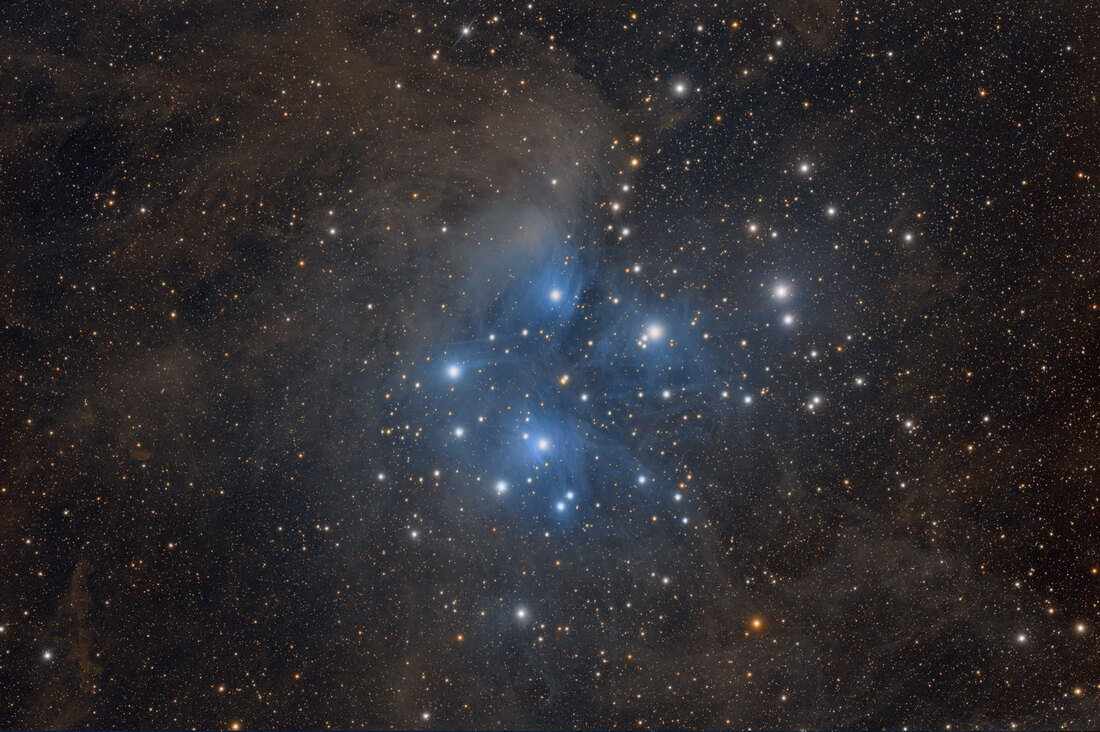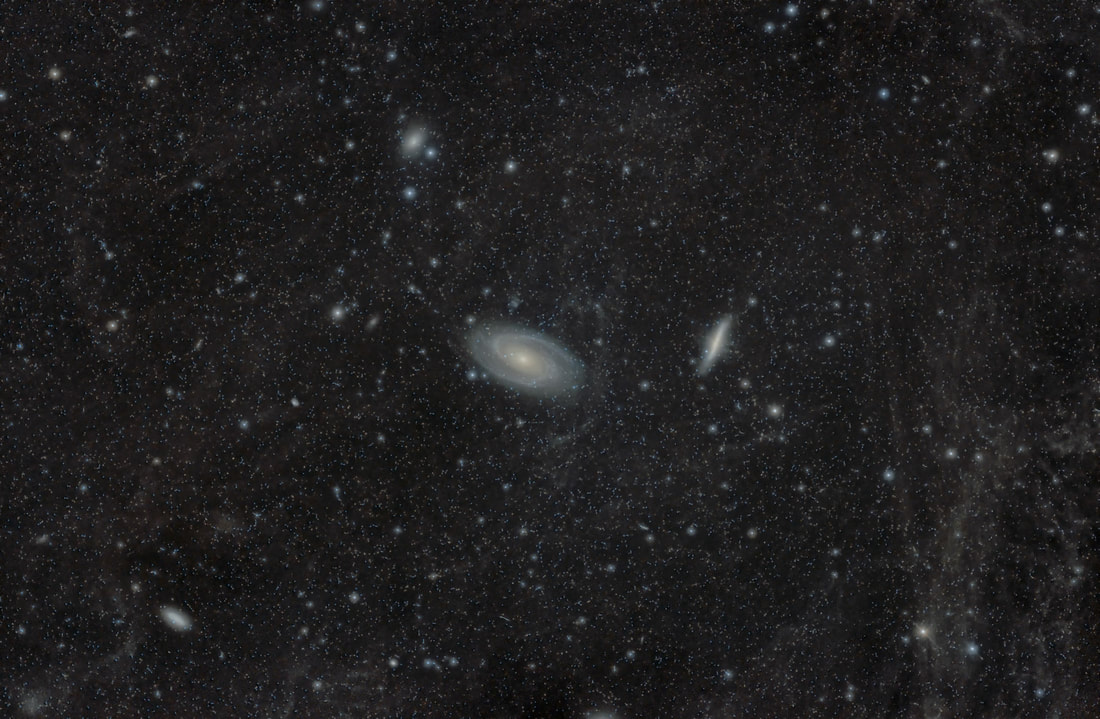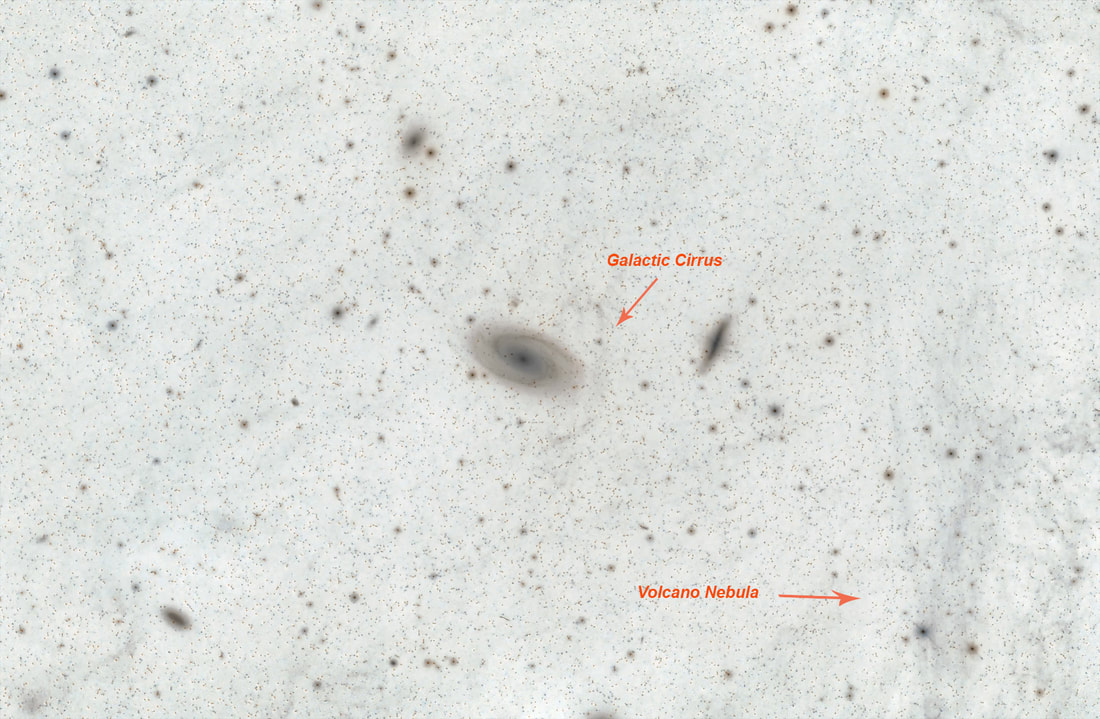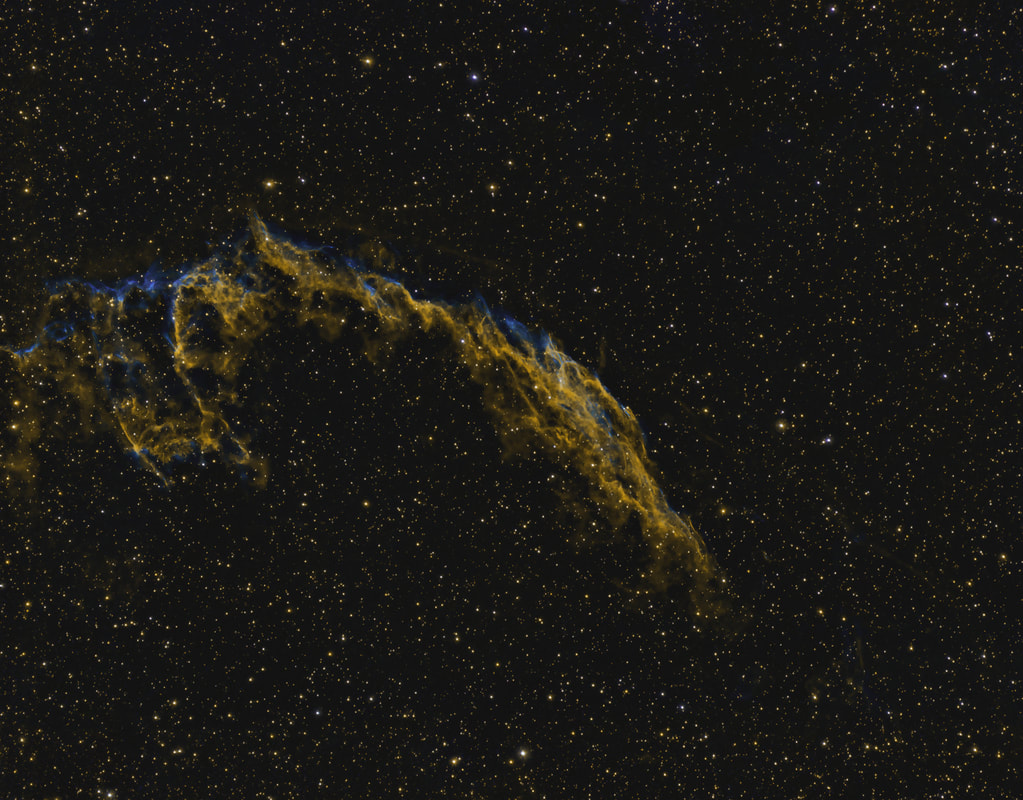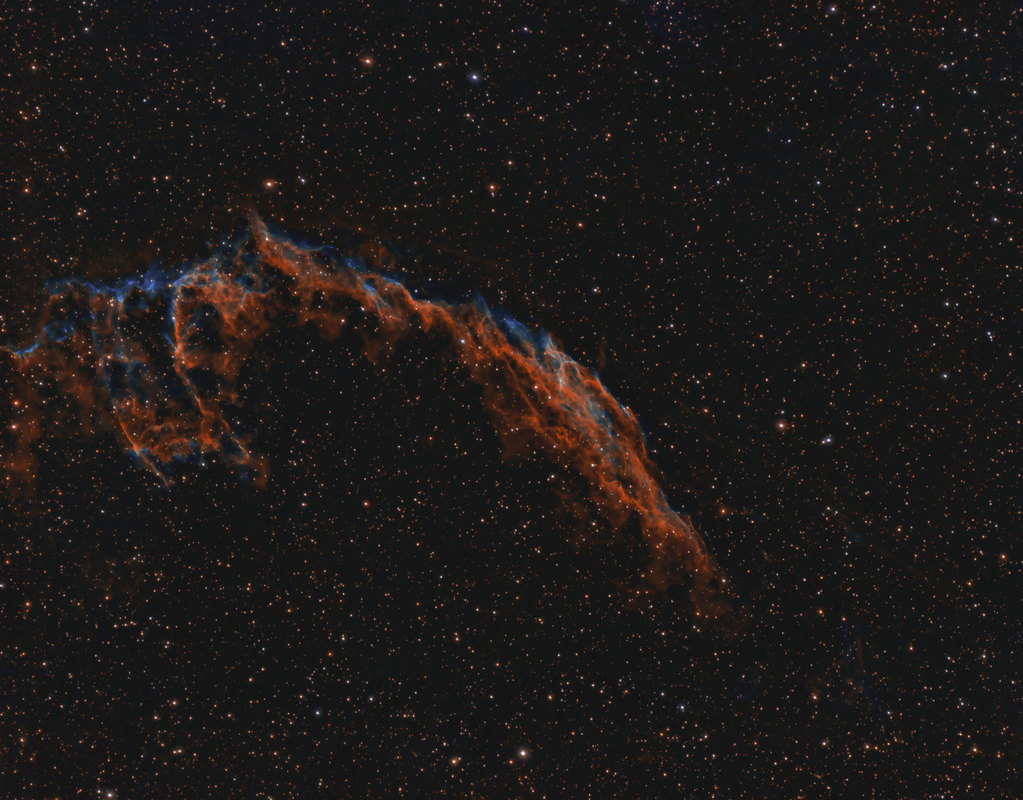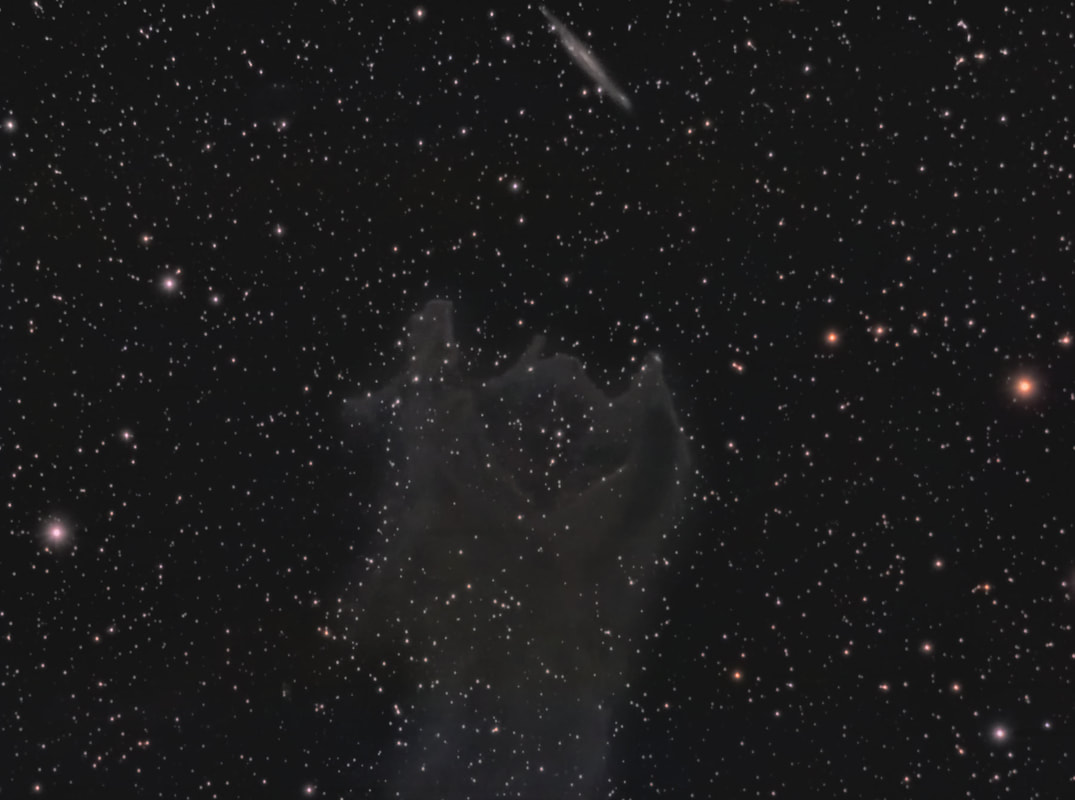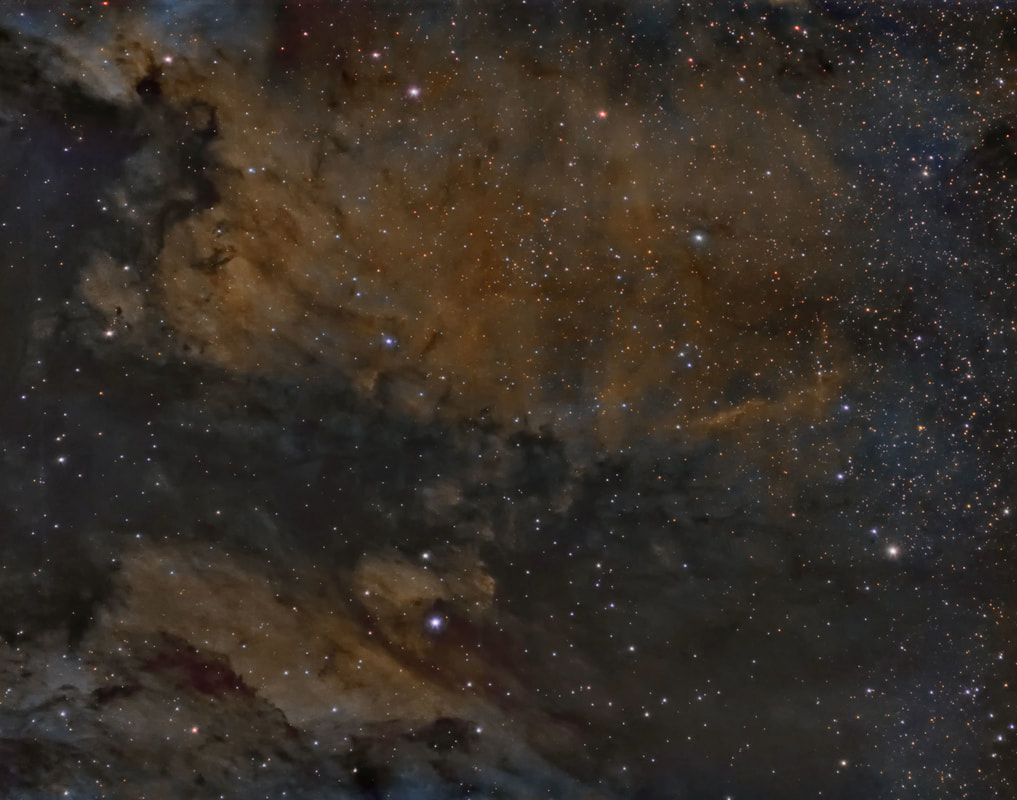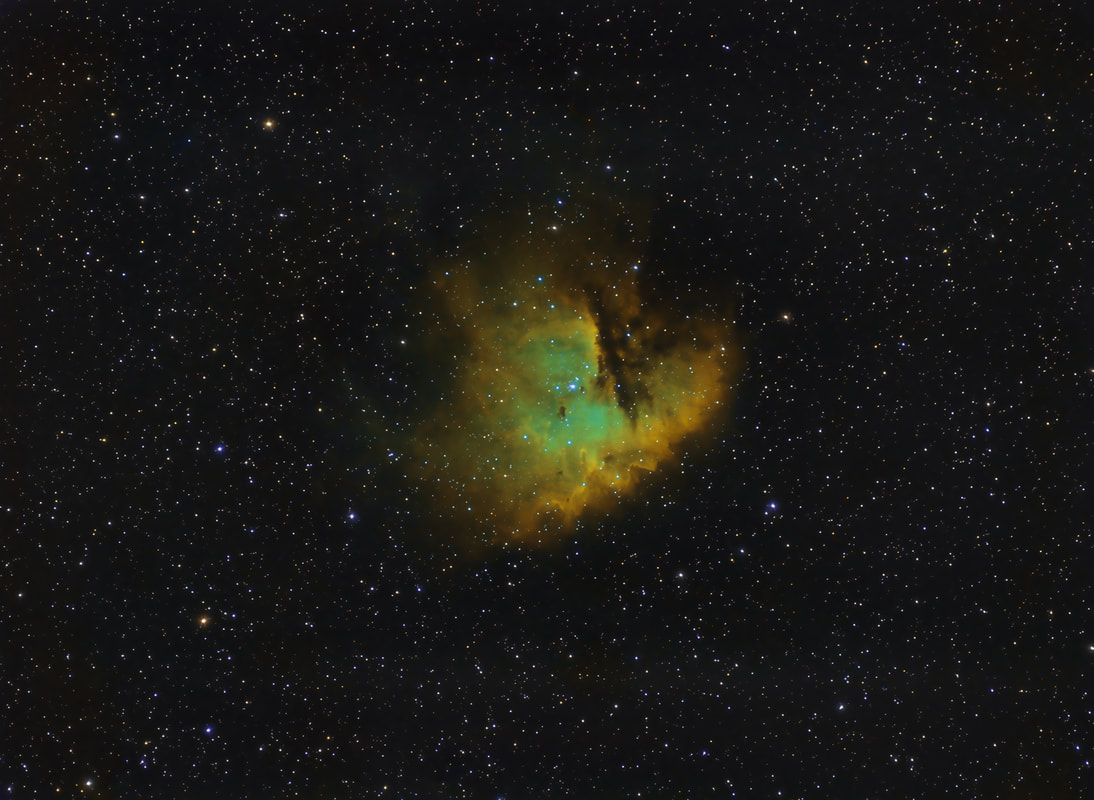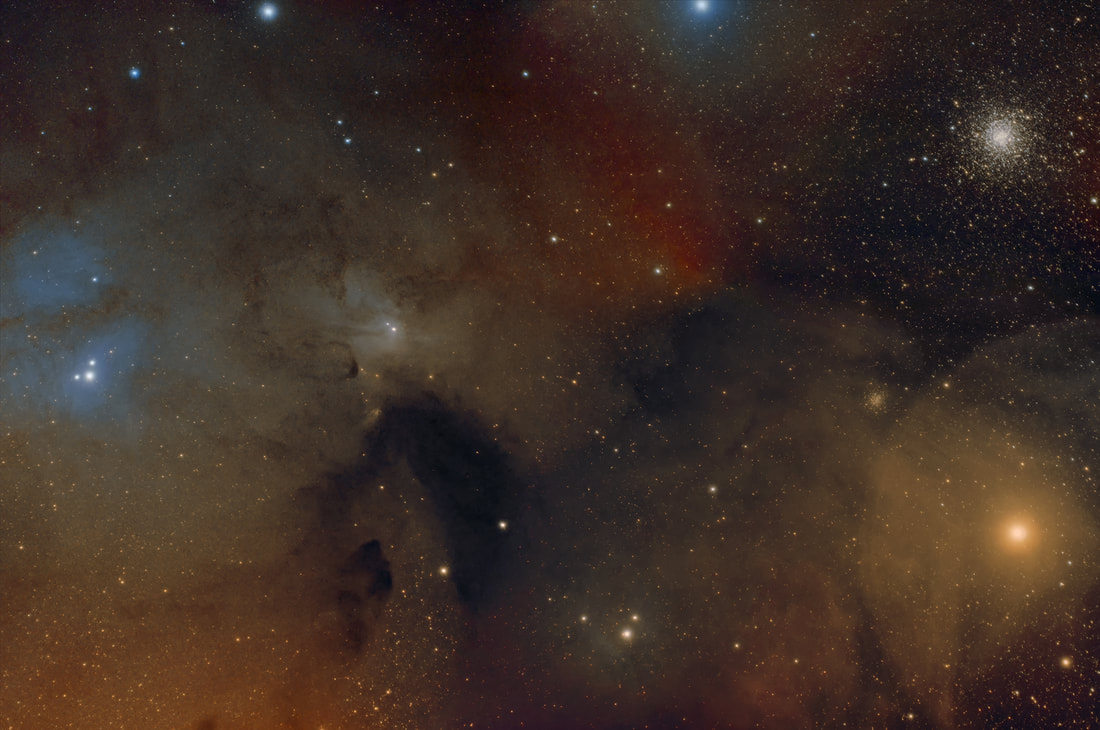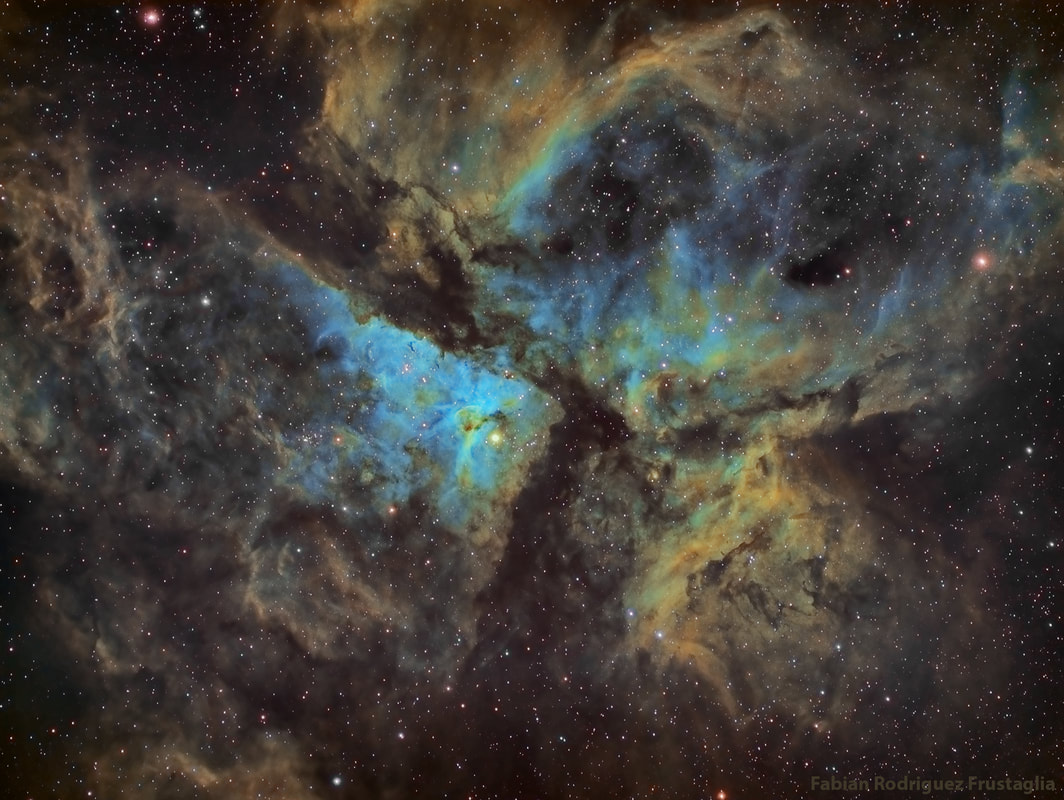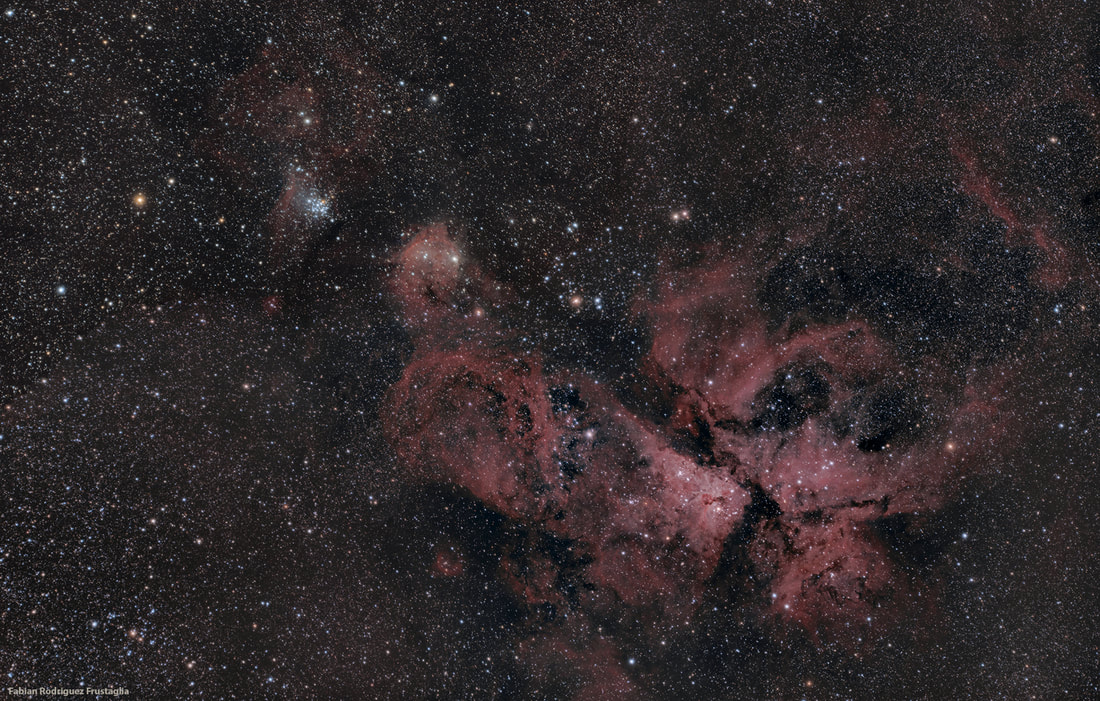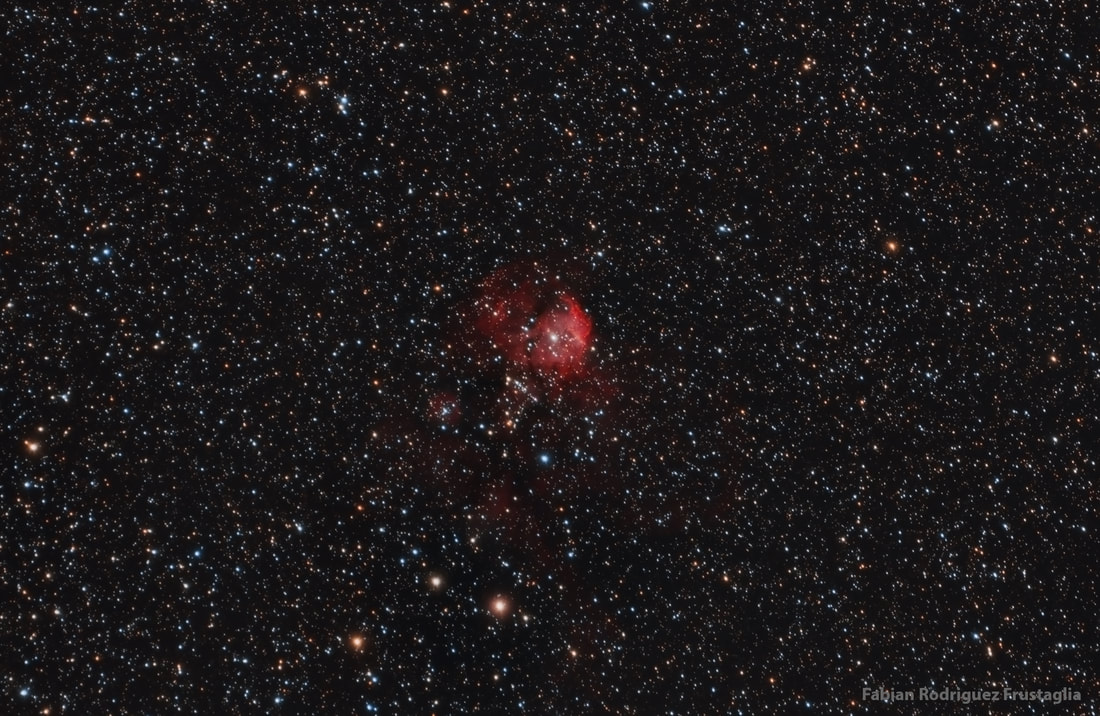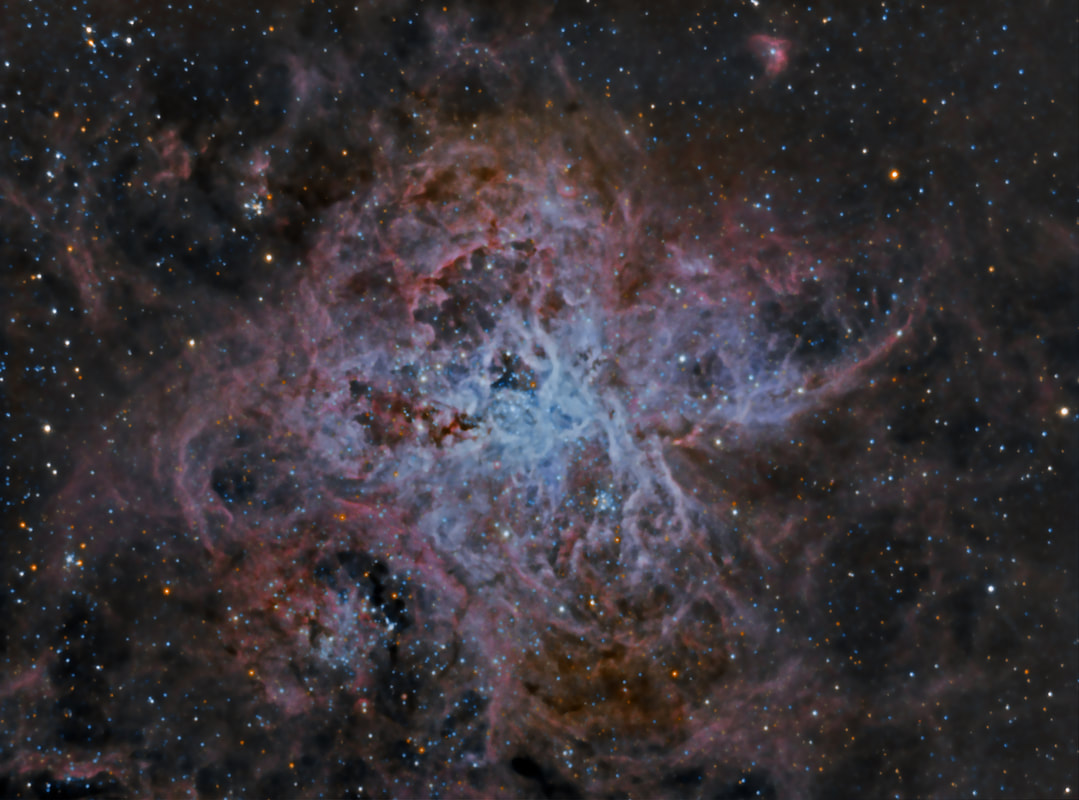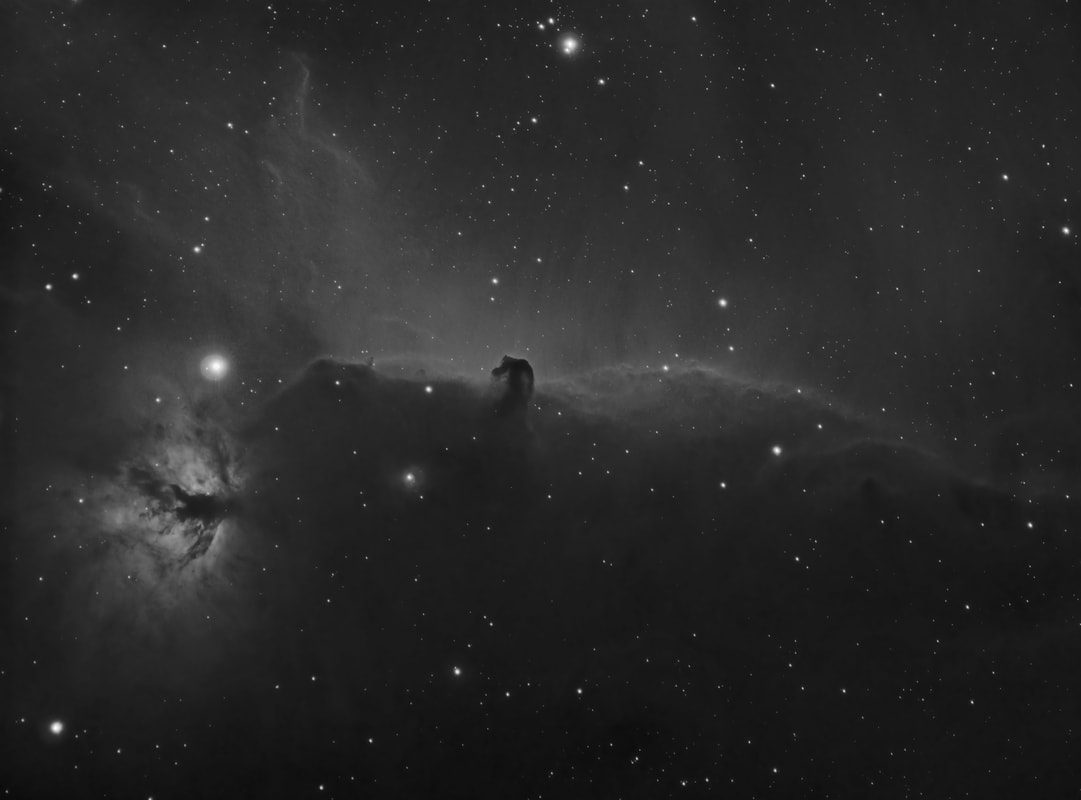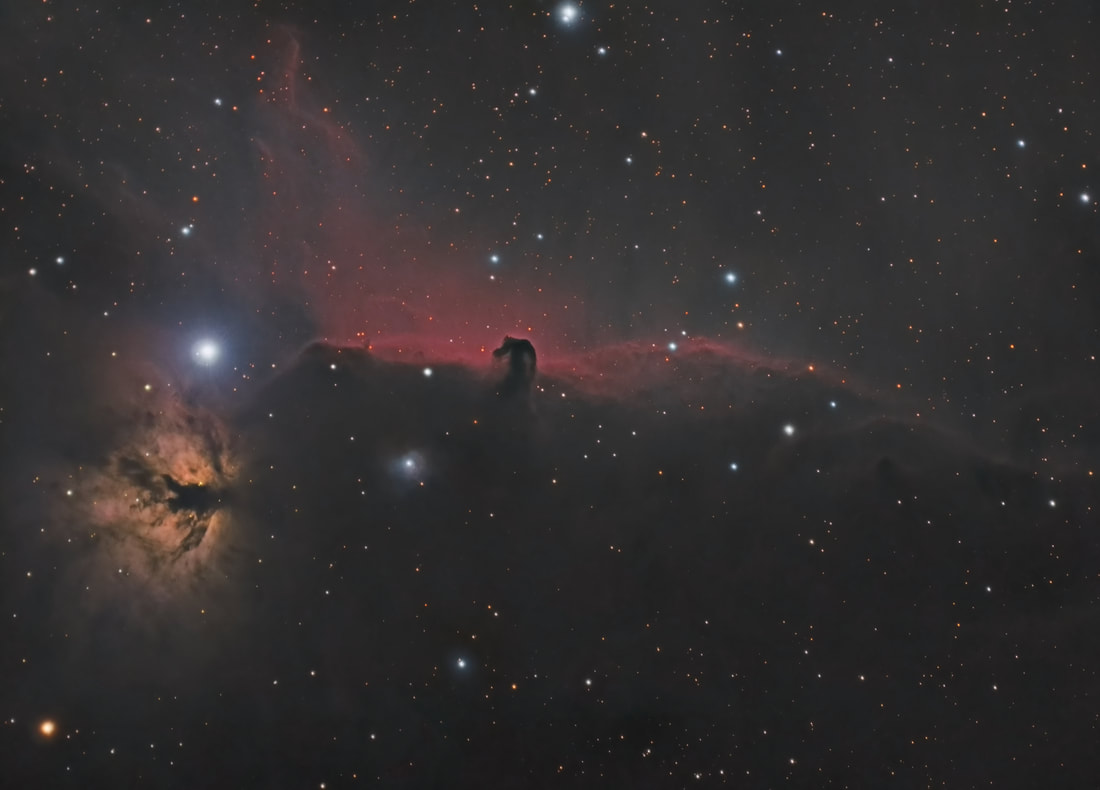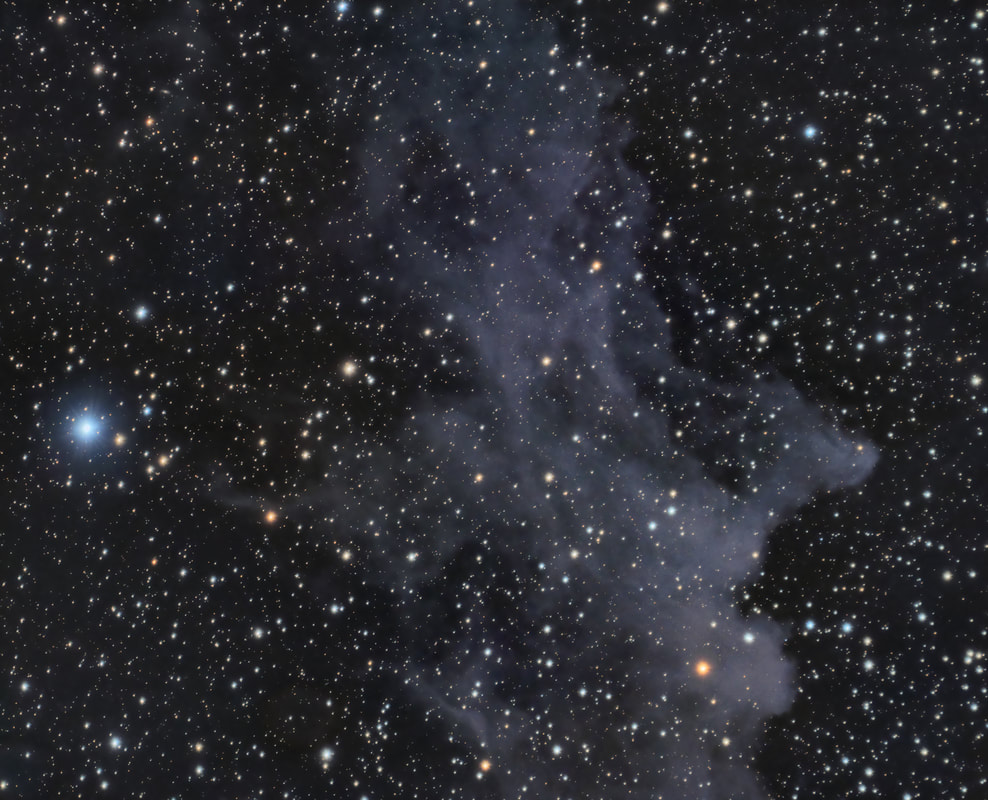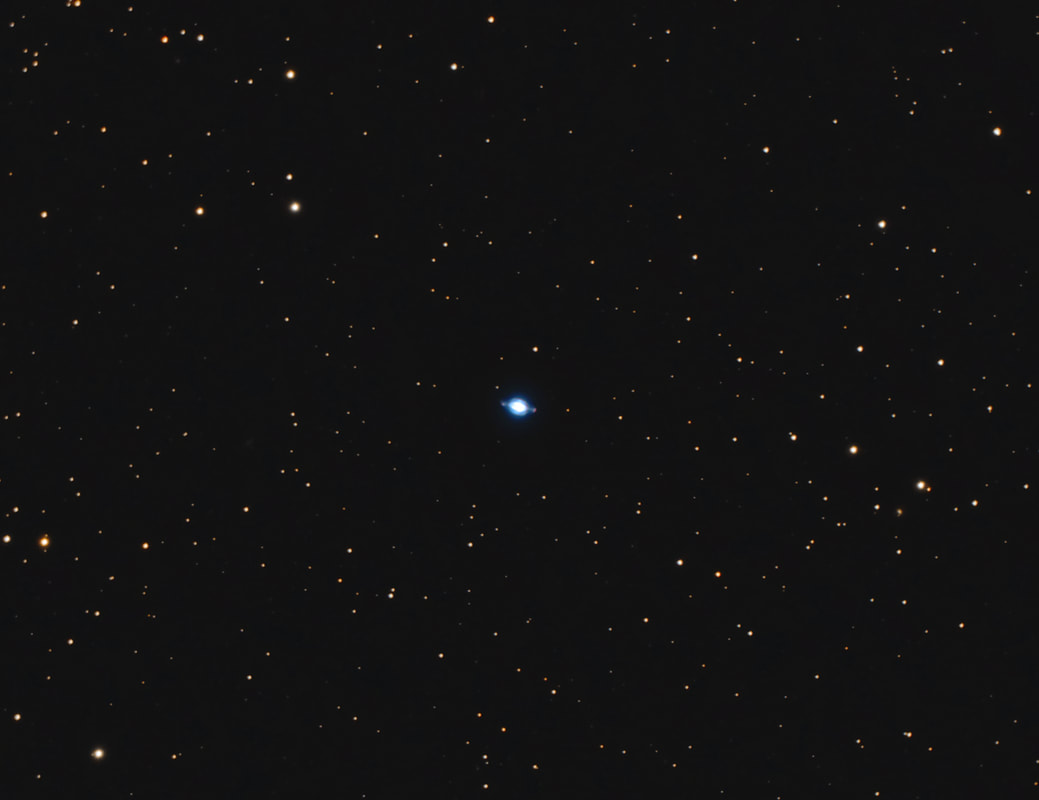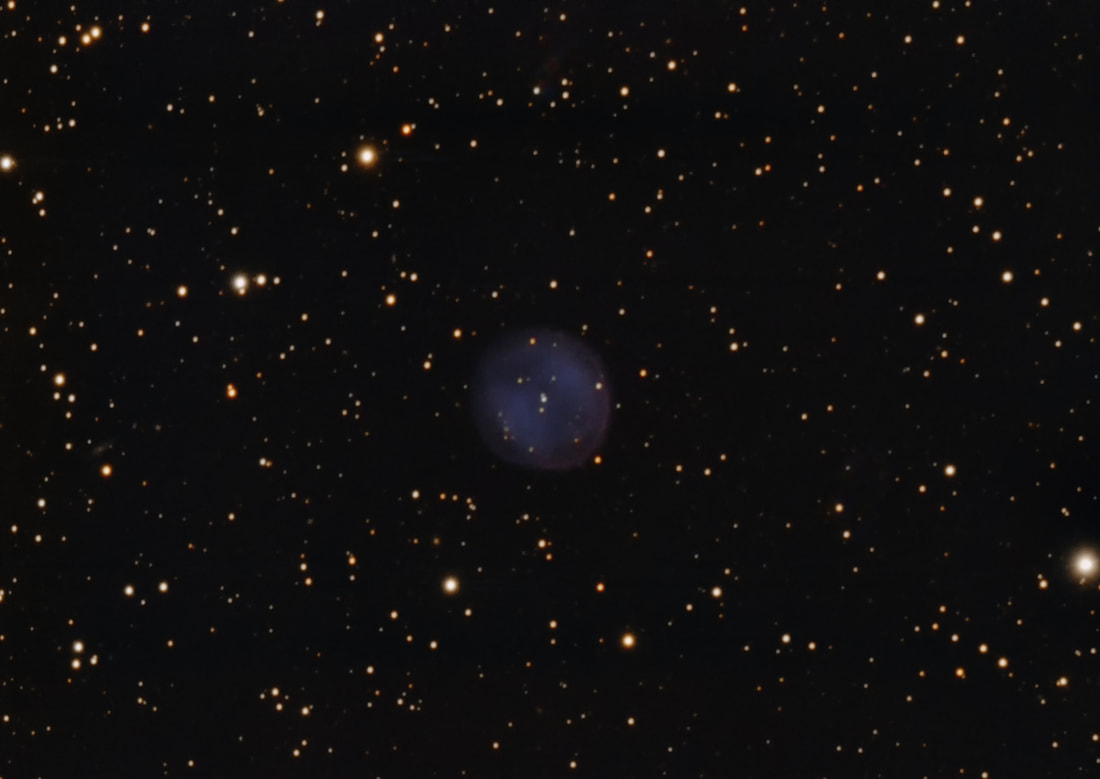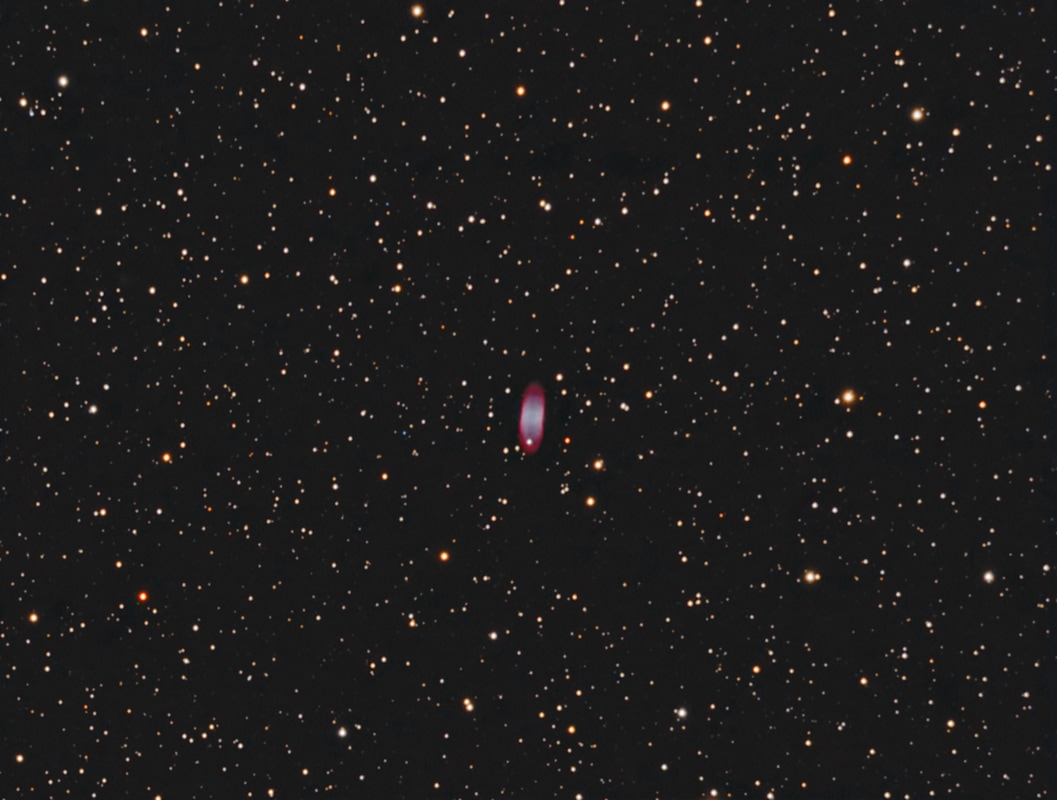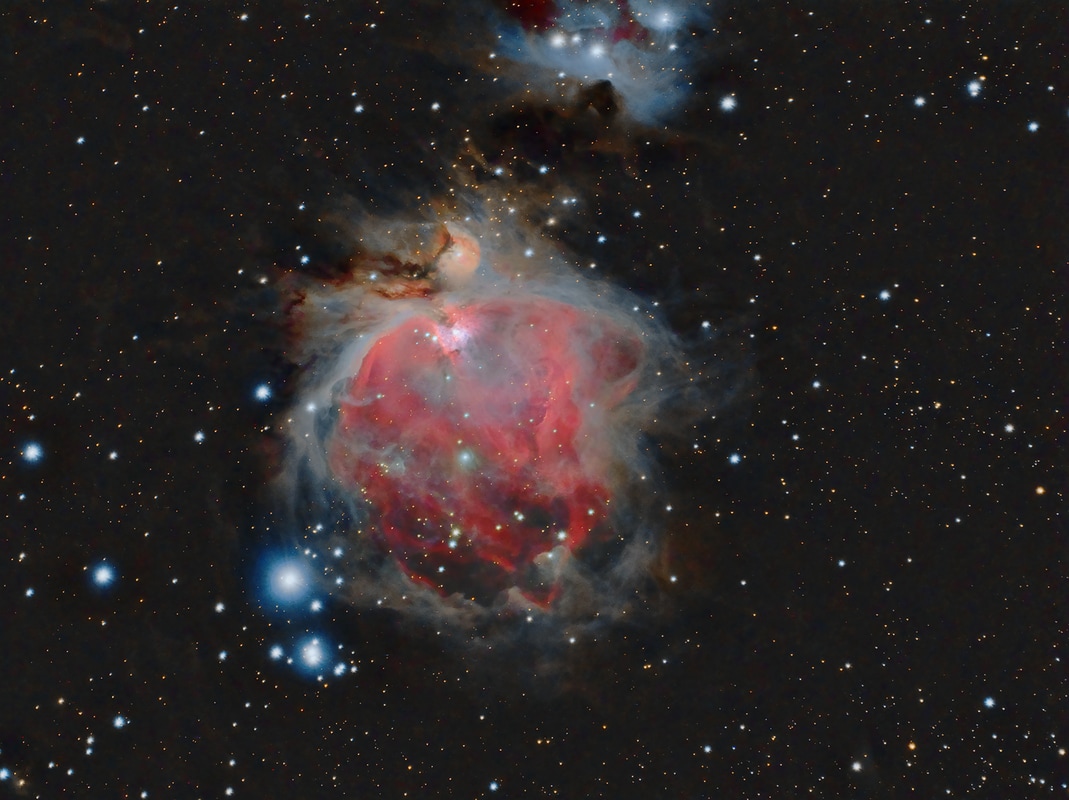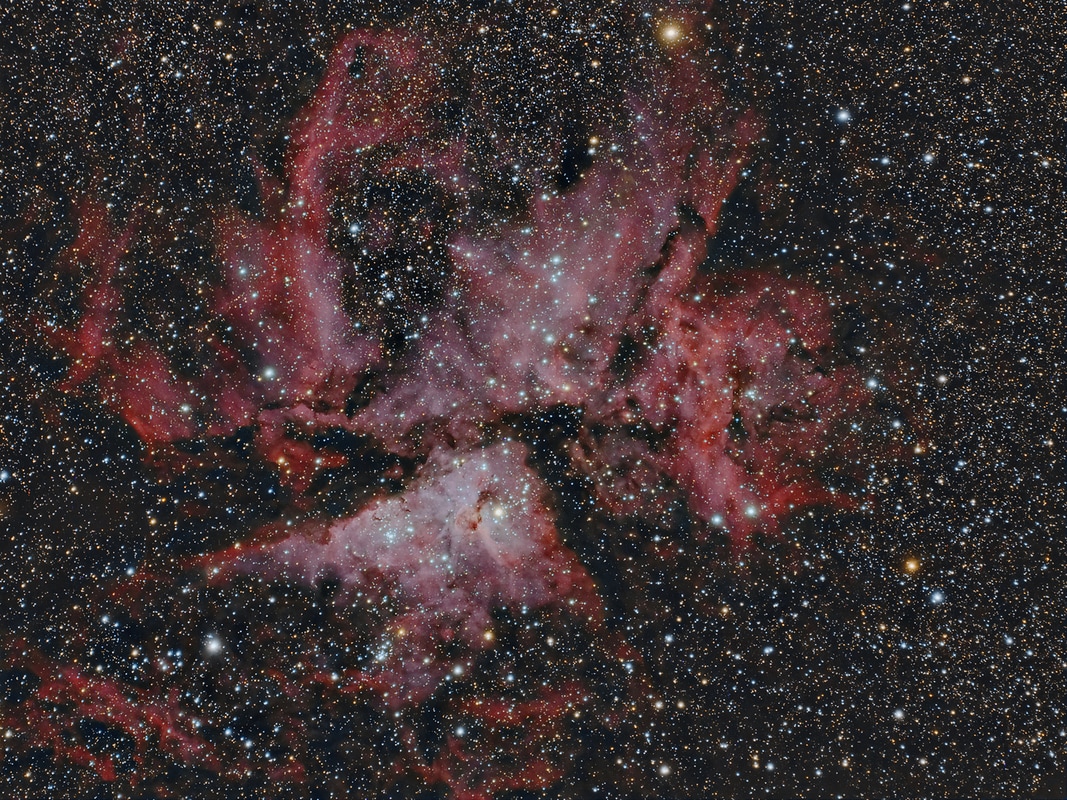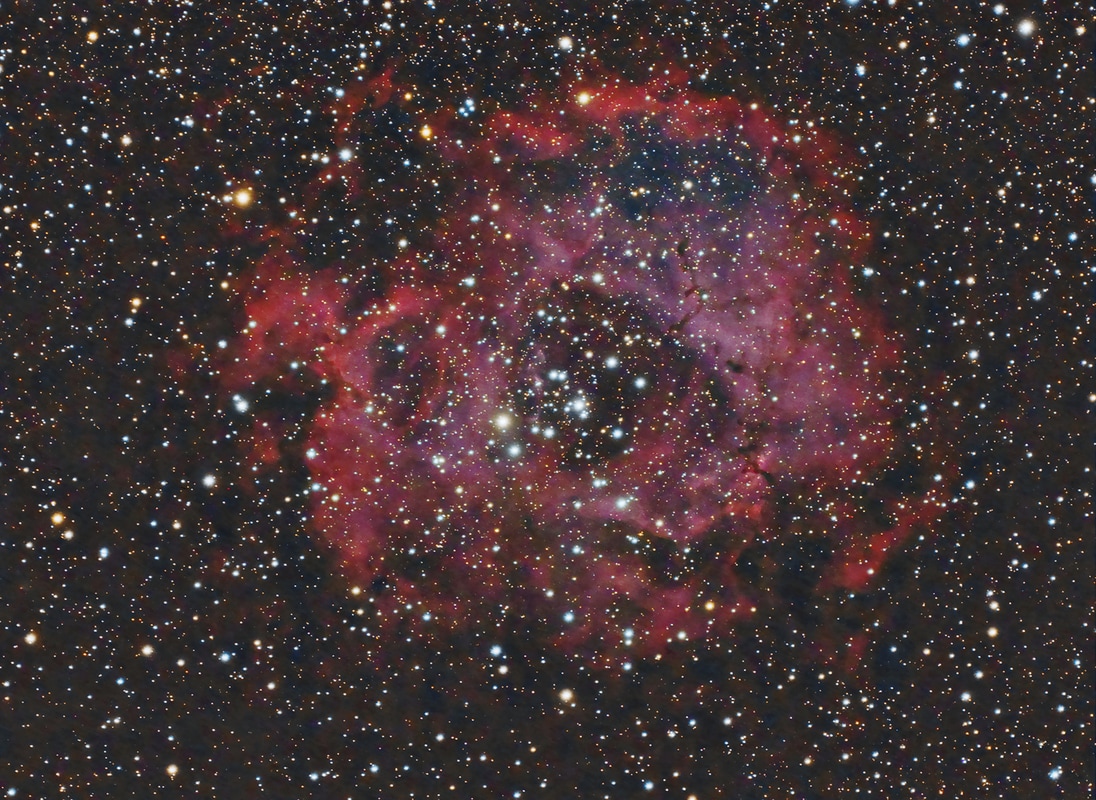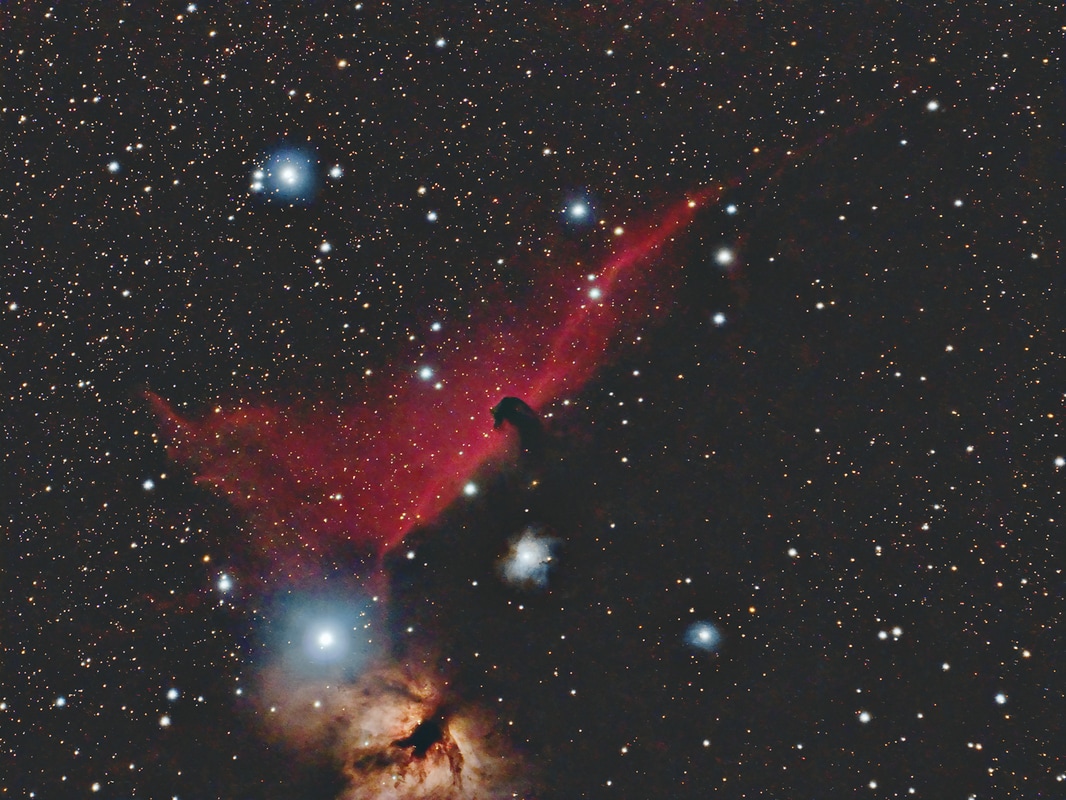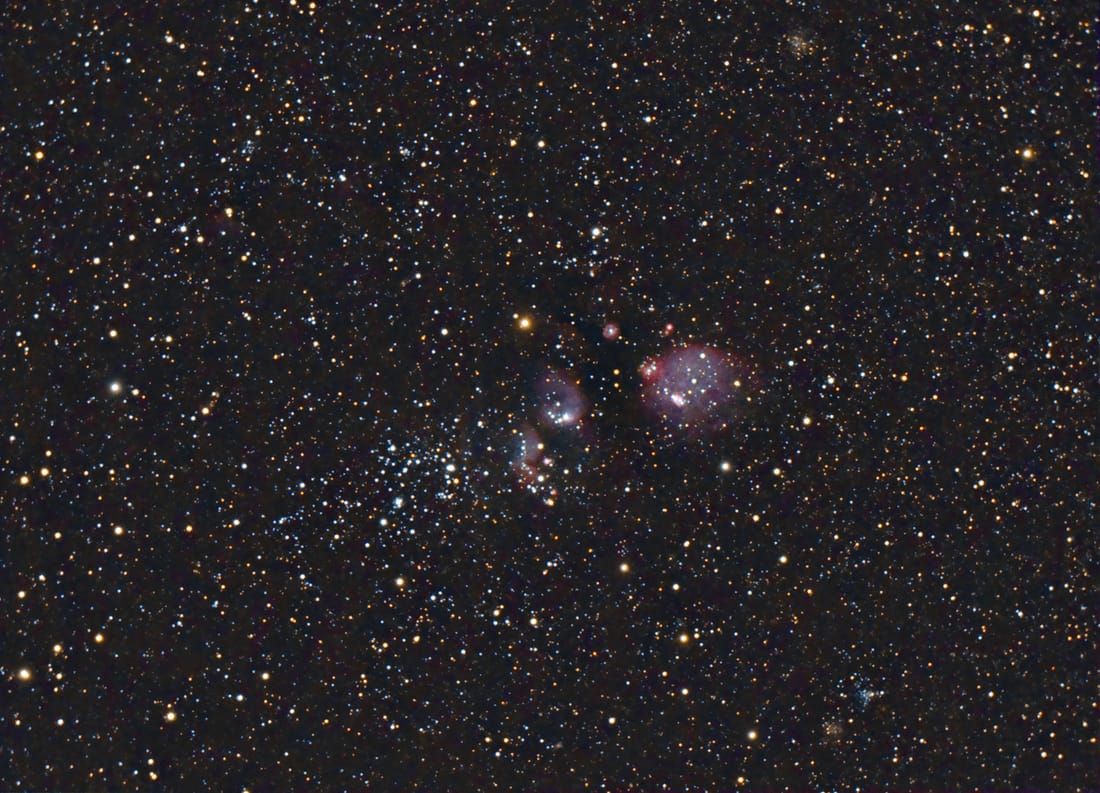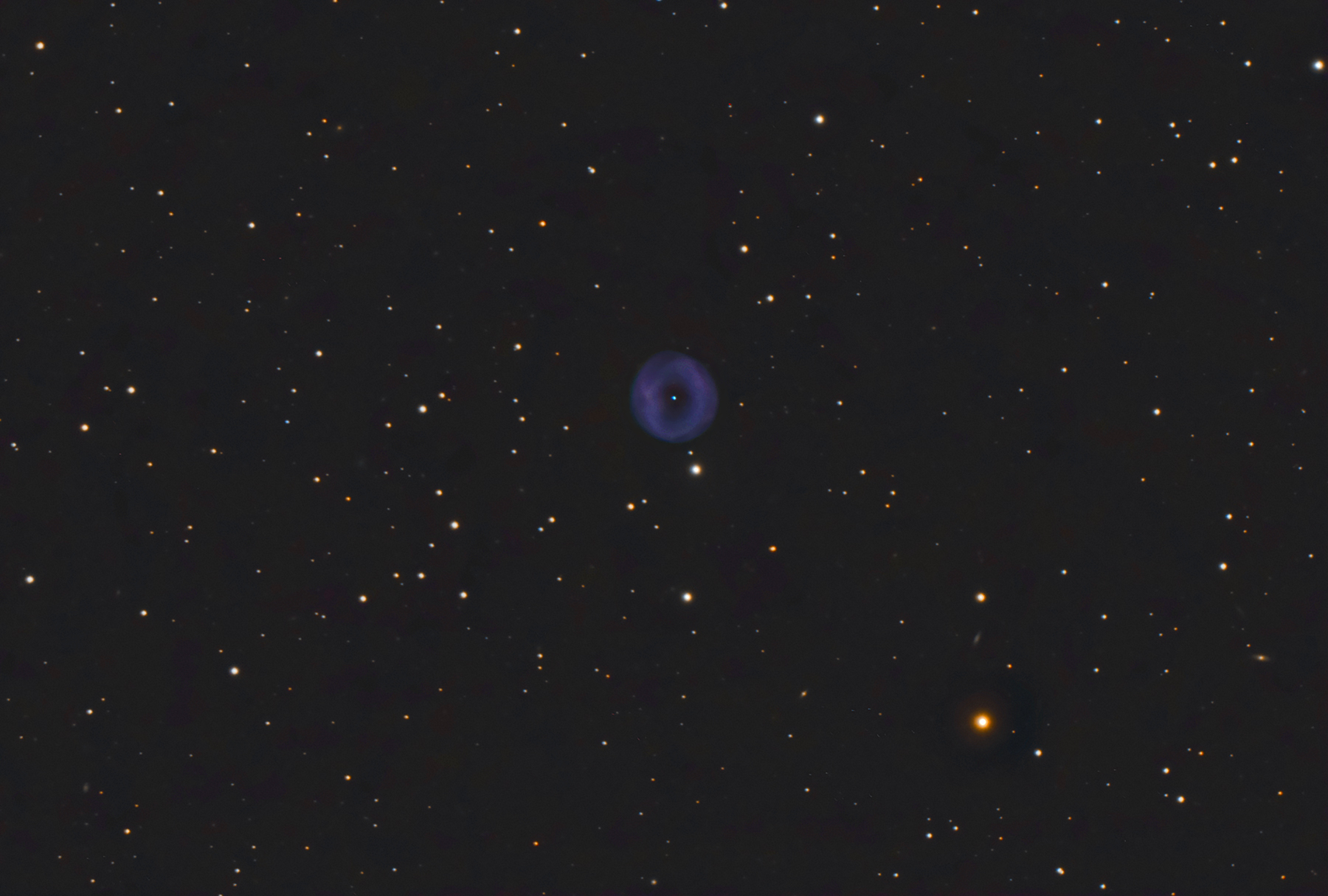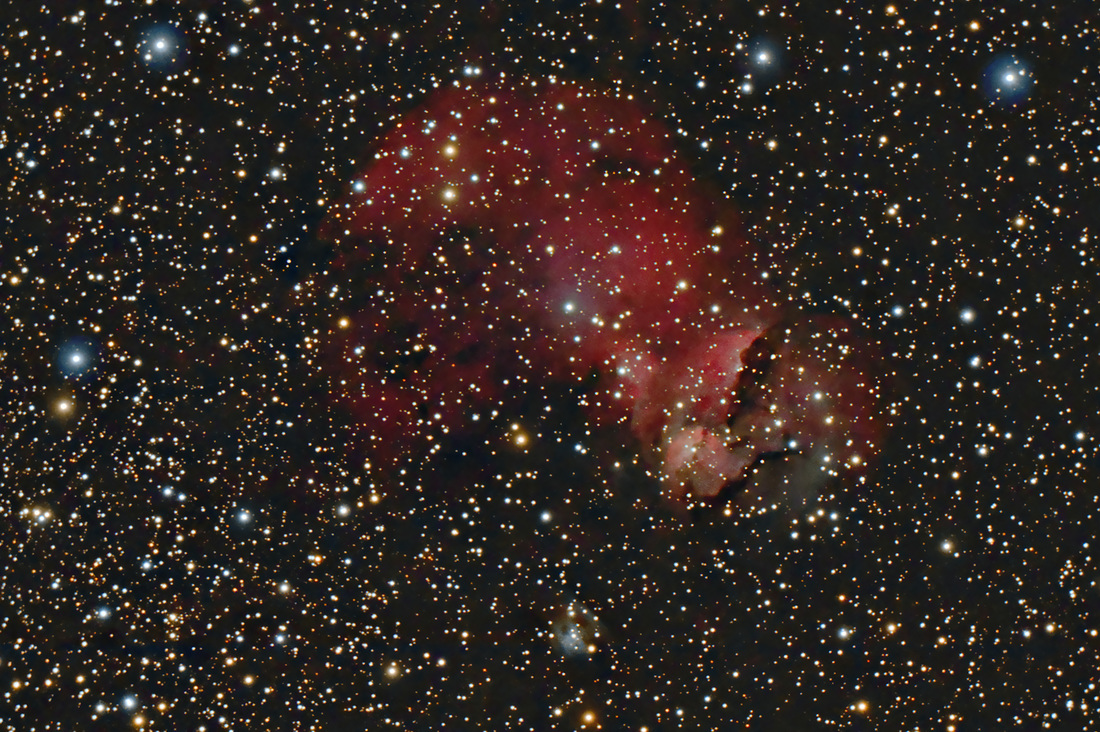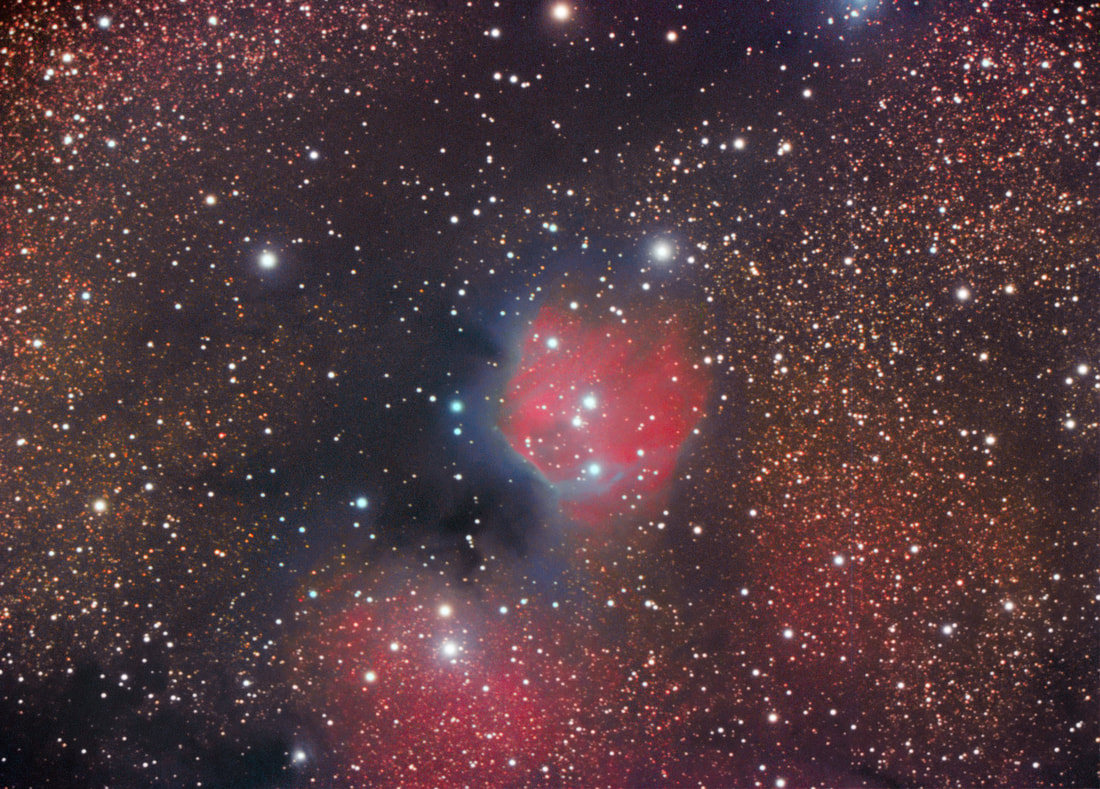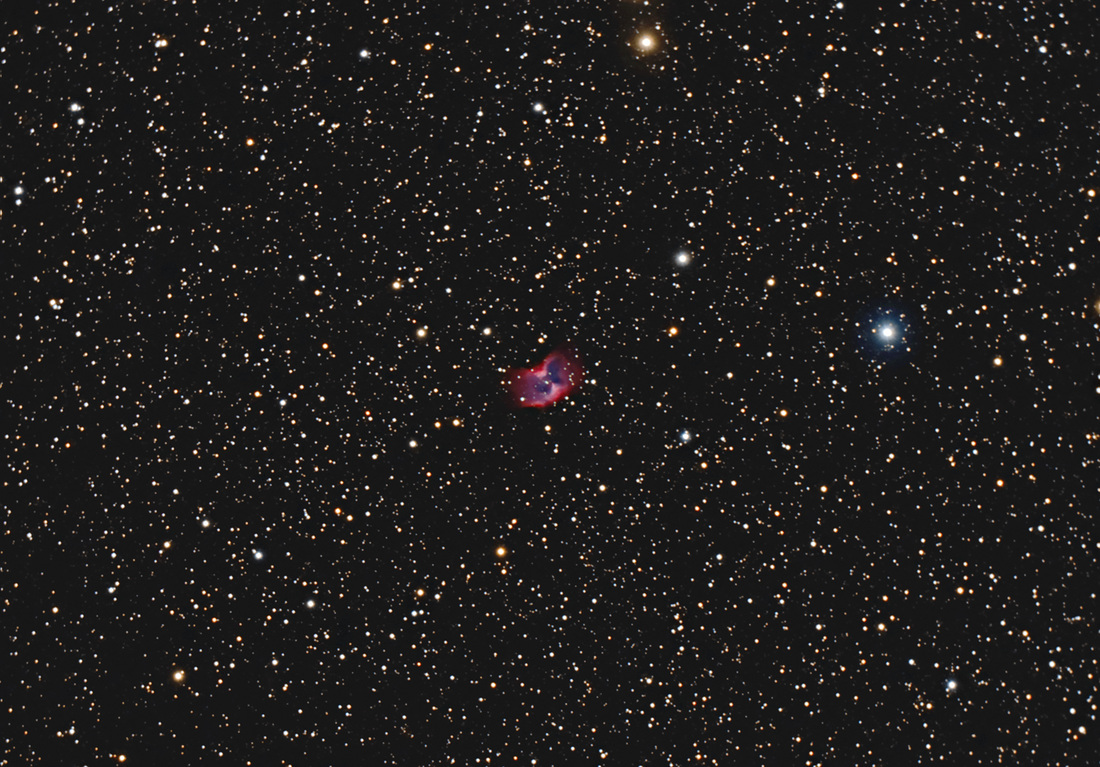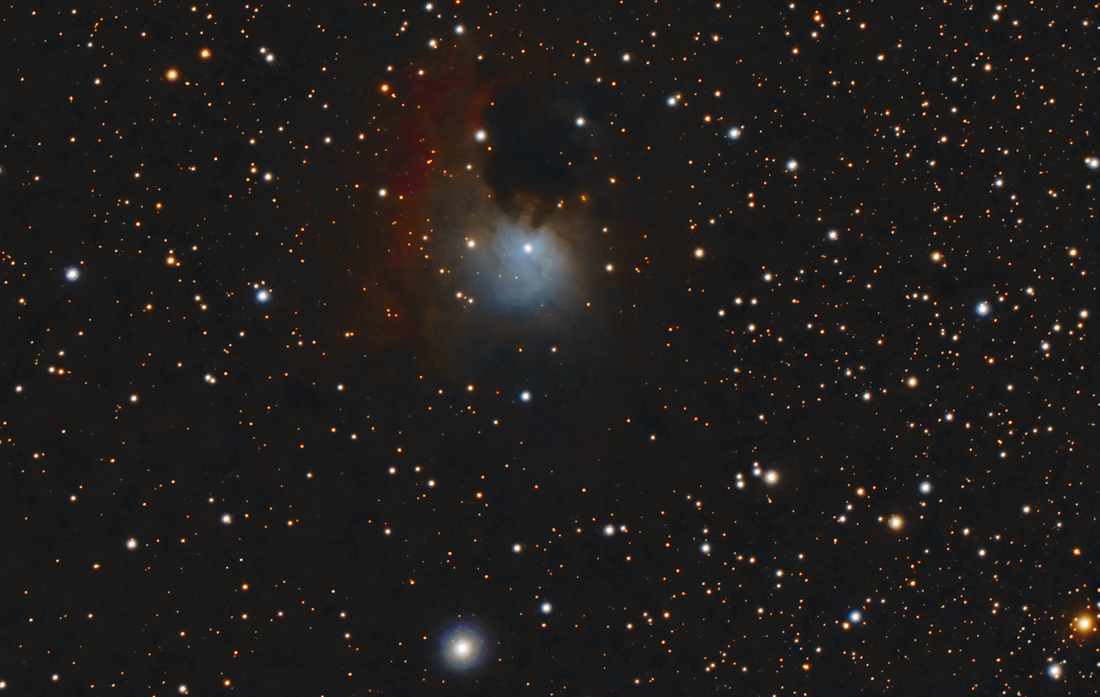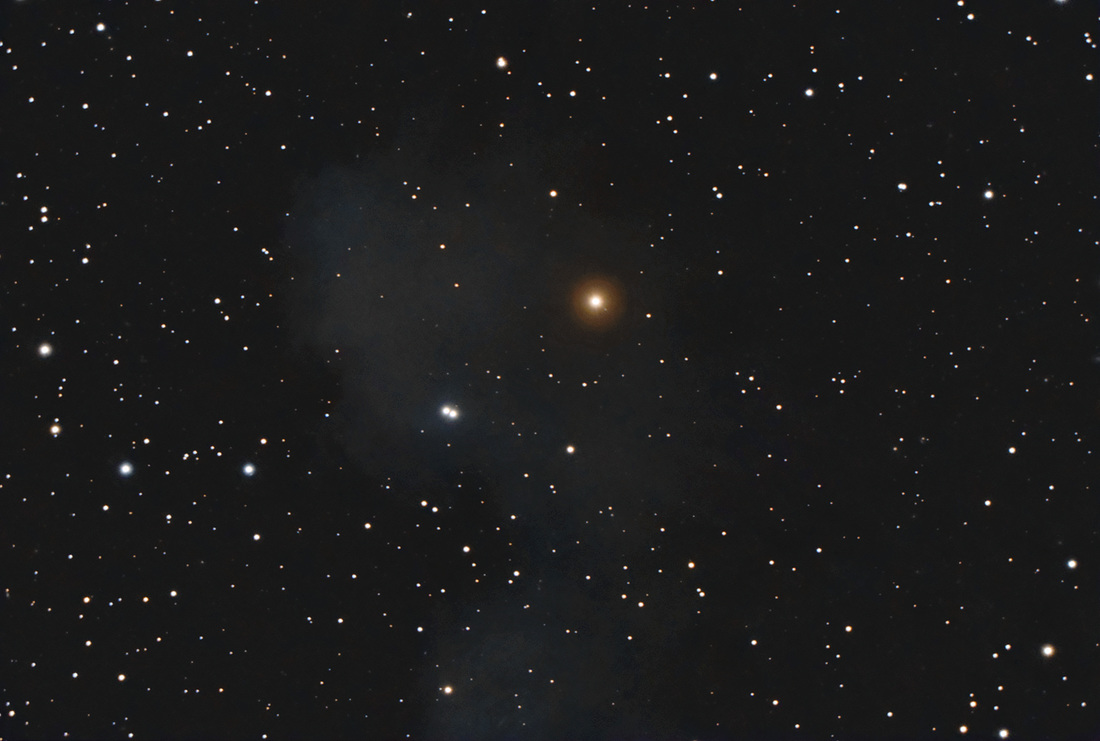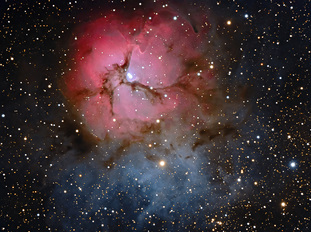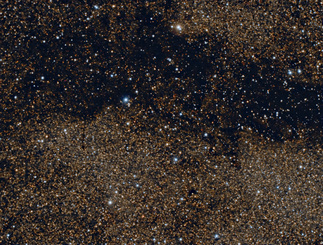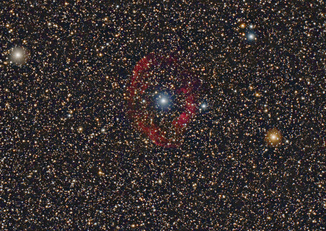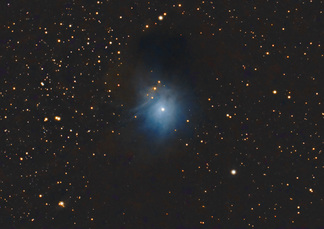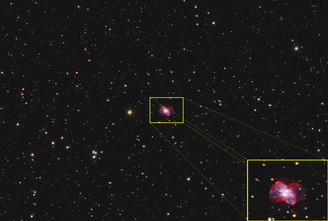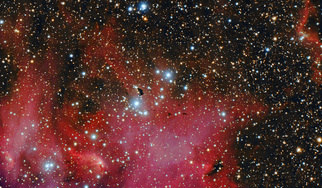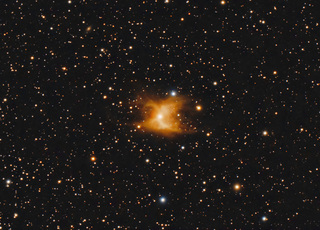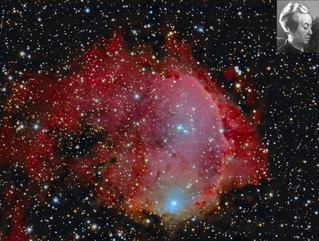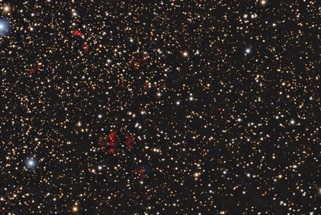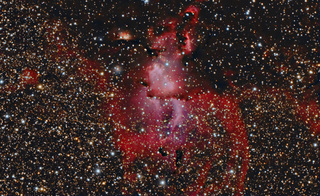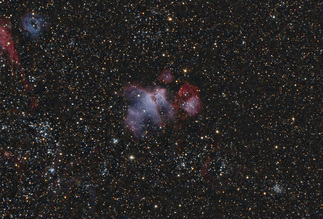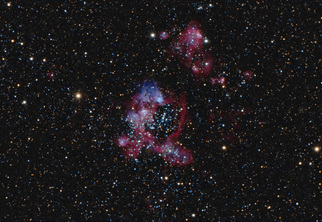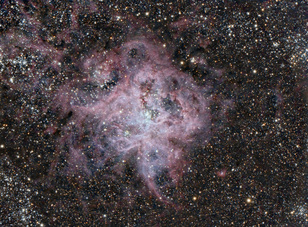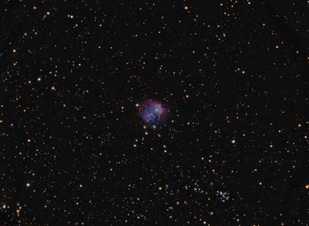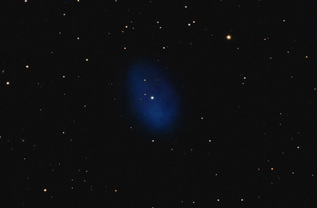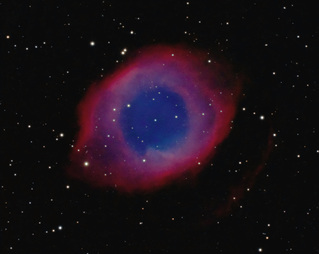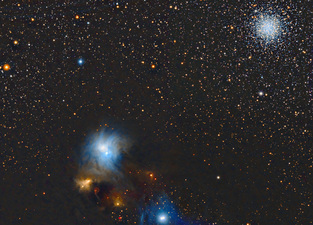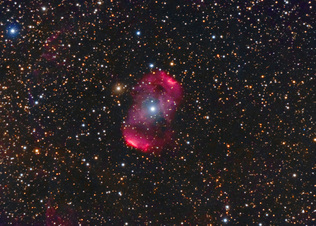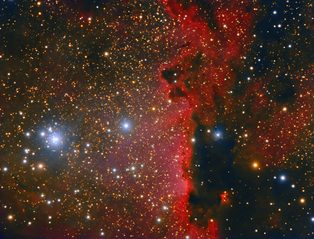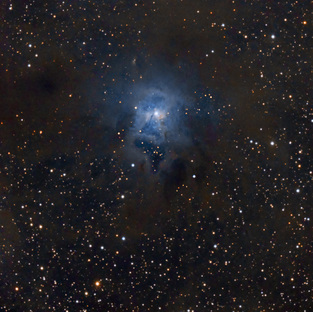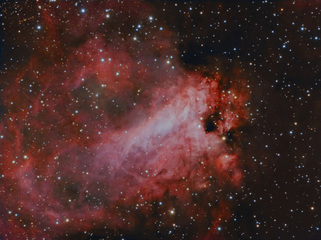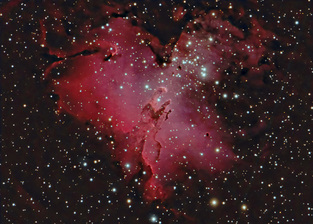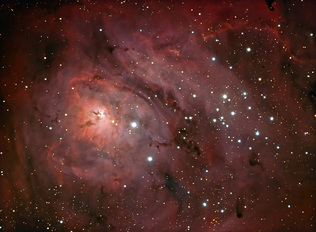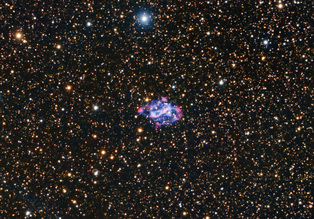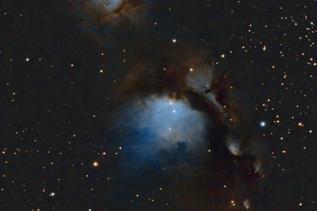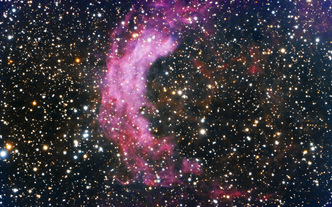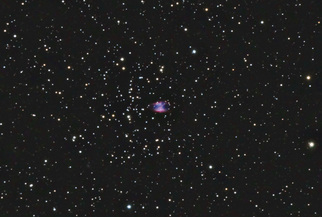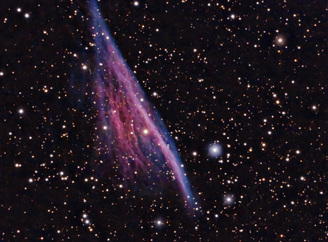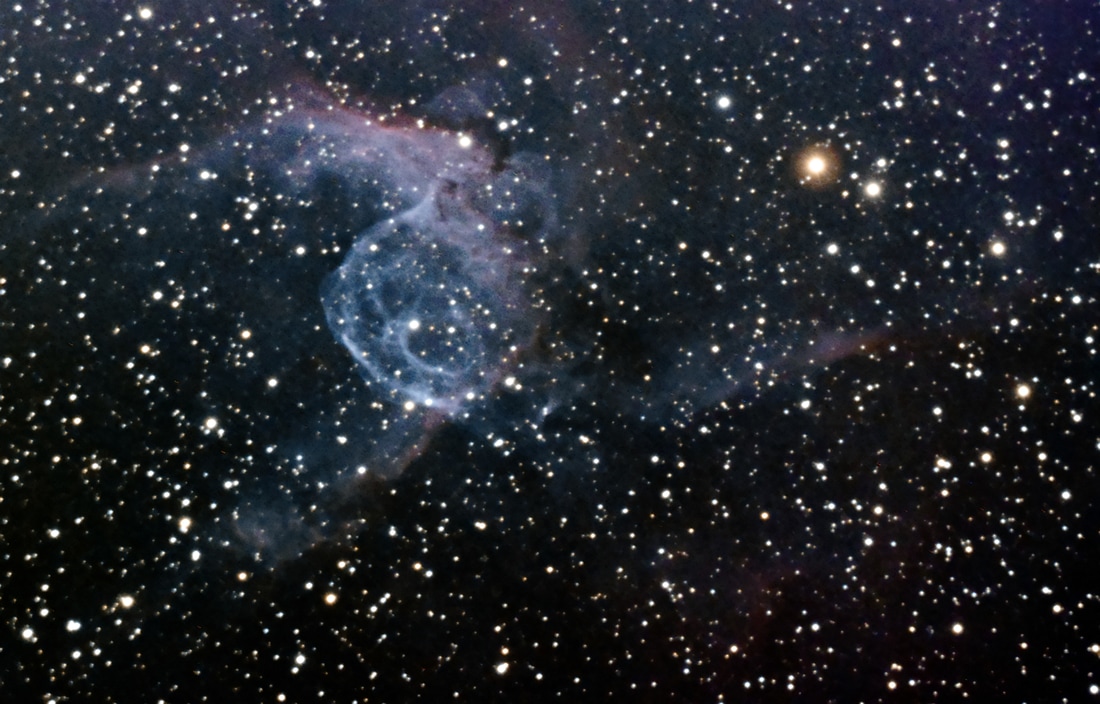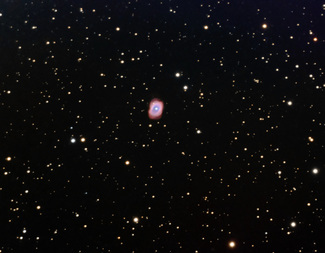Nebulaes
CLICK ON AN IMAGE TO VIEW IT AT FULL RESOLUTION
|
Messier 42&43 - Orion Complex
The Orion Nebula M 42 together with its "annex" M 43 (Mairan's Nebula) is probably the largest galactic emission nebula in the northern sky. It is found in Orion's sword, that is, in the constellation Orion, and at least the sword is usually visible to the naked eye. M 43 was formerly considered as a separate nebula, but today it is regarded as part of M 42. In winter, M 43 (Mairan's Nebula) is located slightly above M 42. It is said that the Orion Nebula can be seen with the naked eye. This definitely depends on the viewing conditions, but the sword can be seen shimmering in any case when it is dark enough. It is difficult to tell for me what exactly is the the nebula in all this shimmering... Using binoculars, one can already see the nebula well and within it two bright stars. One of them is the Trapezium, an arrangement of 4 closely spaced stars at the center of the nebula. I was, however, able to resolve the Trapezium only at higher magnifications in the telescope. In simple terms, the Orion Nebula has approximately the same size as the Moon or Sun (25 'x 30'). How extended it actually appears depends, on the one hand, on the viewing conditions and, on the other hand, on the dark adaptation of one's own eyes. This is a 2-panel mosaic image. Site: Entre Encinas y Estrellas, Spain Telescope: Meade Series 6000 115mm APO f/5.6 Camera: ZWO2600m Filters: RGB + HaFilters Date: January 2023 Exposure: 240x300" + 80x600" = 33.33 hrs |
|
Cederblad 51 - Angelfish Nebula
Sharpless 264, also known as the Lambda Orionis Ring, is a molecular cloud and H II region, which can be seen in the northern region of the Orion molecular cloud complex (OMCC), in the constellation of Orion. The OMCC is one of the best-known star formation regions and the closest sector of the Milky Way to the Solar System where high-mass stars are born. The nebula is named after its main star, λ Orionis, a blue giant responsible for the ionization of the surrounding material. It is also sometimes called the Angelfish Nebula due to its resemblance as to its lighter areas (pink to peach colour) to an angelfish. In the infrared its ionized boundaries are that which appears, instead. Site: Entre Encinas y Estrellas, Spain Telescope: Meade Series 6000 115mm APO f/5.6 Camera: ZWO2600m Filters: RGB + HaFilters Date: January 2023 Exposure: 153x270" + 14x600" = 13.8 hrs |
|
Barnard 33 - Horsehead Nebula
The Horsehead Nebula (also known as Barnard 33) is a small dark nebula in the constellation Orion. The nebula is located just to the south of Alnitak, the easternmost star of Orion's Belt, and is part of the much larger Orion molecular cloud complex. It appears within the southern region of the dense dust cloud known as Lynds 1630, along the edge of the much larger, active star-forming H II region called IC 434. The Horsehead Nebula is approximately 422 parsecs or 1,375 light-years from Earth. It is one of the most identifiable nebulae because of its resemblance to a horse's head. Telescope: Meade LX850 12" f/8 Camera: QHY268m Filters: RGB + Ha Date: December 2022 Exposure: RGB 67 x 5' + Ha 41 x 10' = 12.42 hrs |
|
Sh2-188
The image is of Sharpless 2-188 (Sh2-188), an unusual planetary nebula located in the constellation Cassiopeia. The expanding gas from the planetary nebula is colliding with ambient gas in the interstellar medium. The nebula is nearly circular in shape but is much brighter to the southeast (lower left) because the central star is moving rapidly in that direction. Faint wisps of gas can also be seen in the opposite direction. Telescope: Meade LX850 12" f/8 Camera: QHY268m Filters: RGB + HO Date: December 2022 Exposure: 24x300" + 45x600" = 9.50 hrs |
|
Sh2-239 and LDN 1551
Sh2-239 is a distinct nebula in which stars have been forming for quite some time. It contains two clusters of highly embedded very young stars as well as many stars that are more evolved. The many outflows are visible as bright red knots and jets, particularly in the cavity at the center-top of the image. Telescope: Meade LX850 12" f/8 Camera: QHY268m Filters: LRGB Date: December 2022 Exposure: 168x300" = 14.0 hrs |
|
NGC 7635 - Bubble Nebula
NGC 7635, also known as the Bubble Nebula, Sharpless 162, or Caldwell 11, is an H II region emission nebula in the constellation Cassiopeia. It lies close to the direction of the open cluster Messier 52. The "bubble" is created by the stellar wind from a massive hot, 8.7 magnitude young central star, SAO 20575 (BD+60°2522). The nebula is near a giant molecular cloud which contains the expansion of the bubble nebula while itself being excited by the hot central star, causing it to glow. It was discovered in 1787 by William Herschel. The star BD+60°2522 is thought to have a mass of about 44 M☉. The top image is process with a SHO palette and the bottom one in HOO palette. Site: Entre Encinas y Estrellas, Spain Telescope: Meade LX850 12" f/5.6 Camera: QHY268m Filters: RGB + SHO Date: September 2022 Exposure: 43x300" + 280x600"= 50.25 hrs |
|
LDN 1448
LBN 603 is a very faint nebula (brightness index 6 which means dimmest) in the constellation Cassiopeia. Also in the field are some dark nebulae from B. Lynd's dark nebula catalog (LDN 1295, 1296) and from the Tokyo Gakugei University catalog (TGU). Unfortunately, little is known about this region. In any case, this object is rarely photographed. Site: Entre Encinas y Estrellas, Spain Telescope: Meade Series 6000 115mm APO f/5.6 Camera: ZWO1600m Filters: LRGB Filters Date: November 2022 Exposure: 200x300" = 16.6 hrs |
|
Sh2-261 - Lower's Nebula
Lower's nebula (Sh2-261) is found on the outermost edge of our Milkyway between the Orion and Perseus arm. Sh2-261 is a large faint region of predominantly ionized hydrogen. The nebula is named after Harold and Charles Lower who discovered this nebula in 1939. Embedded within Sh2-261 is LBN 862 and LBN 864. Also there are several dark nebulae in this field. Site: Entre Encinas y Estrellas, Spain Telescope: Meade Series 6000 115mm APO f/5.6 Camera: ZWO1600m Filters: RGB + Ha Filters Date: January 2023 Exposure: 78x300" + 24x300" = 10.5 hrs |
|
LBN 603
LBN 603 is a very faint nebula (brightness index 6 which means dimmest) in the constellation Cassiopeia. Also in the field are some dark nebulae from B. Lynd's dark nebula catalog (LDN 1295, 1296) and from the Tokyo Gakugei University catalog (TGU). Unfortunately, little is known about this region. In any case, this object is rarely photographed. Site: Entre Encinas y Estrellas, Spain Telescope: Meade Series 6000 115mm APO f/5.6 Camera: ZWO1600m Filters: LRGB Filters Date: November 2022 Exposure: 200x300" = 16.6 hrs |
|
Sh2-216 & 221
Sharpless 216 is a huge and dim planetary nebula, the bubble at right in this picture. Sharpless 221 is an ancient Supernova remnant, even dimmer at left, typically built up of lots of filaments. Both are glowing at Hydrogen and Oxygen lines, and their distinctly different appearance make for a great motiv. The intense red blob north of 221 is Sh2-217 and the smaller one next to 221 is Sh2-219. Between the two majors here sits another medium size H-Alpha region without Sharpless number, dubbed BFS44, that contains a dark nebula called B25. The whole region is very near to bright Capella, which resides just left of the field. This image is a 9-panel mosaic. Site: Entre Encinas y Estrellas, Spain Telescope: Meade Series 6000 115mm APO f/5.6 Camera: ZWO1600m Filters: Ha, OIII, SII, RGB Filters Date: October 2021 Exposure: 9x9x600" + 3x9x300" = 47.25 hrs |
|
Messier 57 - Ring Nebula
The Ring Nebula (also catalogued as Messier 57, M57 and NGC 6720) is a planetary nebula in the northern constellation of Lyra. Such a nebula is formed when a star, during the last stages of its evolution before becoming a white dwarf, expels a vast luminous envelope of ionized gas into the surrounding interstellar space. Telescope: Meade LX850 12" f/8 Camera: QHY268m Date: August 2022 Exposure: RGB 113 x 5' + HO 55 x 10' = 18.60 hrs |
|
NGC 6888 - Crescent Nebula
The Crescent Nebula (also known as NGC 6888, Caldwell 27, Sharpless 105) is an emission nebula in the constellation Cygnus, about 5000 light-years away from Earth. It was discovered by William Herschel in 1792. It is formed by the fast stellar wind from the Wolf-Rayet star WR 136 (HD 192163) colliding with and energizing the slower moving wind ejected by the star when it became a red giant around 250,000 to 400,000[citation needed] years ago. The result of the collision is a shell and two shock waves, one moving outward and one moving inward. The inward moving shock wave heats the stellar wind to X-ray-emitting temperatures. It is a rather faint object located about 2 degrees SW of Sadr. For most telescopes it requires a UHC or OIII filter to see. Under favorable circumstances a telescope as small as 8 cm (with filter) can see its nebulosity. Larger telescopes (20 cm or more) reveal the crescent or a Euro sign shape which makes some to call it the "Euro sign nebula". Upper image is the classic SHO Hubble palette while the bottom one is a HOO palette. Site: Entre Encinas y Estrellas, Spain Telescope: Meade LX850 12" f/5.6 Camera: QHY268m Filters: Ha, OIII, SII, RGB Filters Date: July 2022 Exposure: 22x300" + 285x600" = 49.33 hrs |
|
WR 134
WR 134 is a variable Wolf-Rayet star located around 6,000 light years away from Earth in the constellation of Cygnus, surrounded by a faint bubble nebula blown by the intense radiation and fast wind from the star. It is five times the radius of the sun, but due to a temperature over 63,000 K it is 400,000 times as luminous as the Sun. WR 134 was one of three stars in Cygnus observed in 1867 to have unusual spectra consisting of intense emission lines rather than the more normal continuum and absorption lines. These were the first members of the class of stars that came to be called Wolf-Rayet stars (WR stars) after Charles Wolf and Georges Rayet who discovered their unusual appearance. It is a member of the nitrogen sequence of WR stars, while the other two (WR 135 and WR 137) are both members of the carbon sequence that also have OB companions. WR 134 has a spectrum with NIII and NIV emission between two and five times stronger than NV, leading to the assignment of a WN6 spectral type. The spectrum also shows strong HeII emission and weaker lines of HeI and CIV. Site: Entre Encinas y Estrellas, Spain Telescope: Meade Series 6000 115mm APO f/5.6 Camera: ZWO2600m Filters: Ha, OIII, RGB Filters Date: July 2022 Exposure: 135x600" + 18x300" = 23.25 hrs |
|
Sh2-187
The centre of this image shows the diaphanous Sh2-187, a mix of emission, reflection and dark nebulae. It lies about 4,700 light years away in Cassiopeia. The nebula is surrounded by a large molecular cloud containing hydrogen, dust and soot. This is evidenced by the dark lanes throughout the image as well as the brighter patches around the nebula. Some of the dark nebula in this image have entries in the Lynd’s Dark Nebulae (LDN) catalogue, but others do not Telescope: Meade Series 6000 115mm APO f/5.6 Camera: ZWO2600m Filters: LRGB + Ha Date: October 2022 Exposure: 184x300" + 19x600"= 16.83 hrs |
|
NGC 7129
NGC 7129 is a reflection nebula located 3,300 light years away in the constellation Cepheus. A young open cluster is responsible for illuminating the surrounding nebula. A recent survey indicates the cluster contains more than 130 stars less than 1 million years old. NGC 7129 is located just half a degree from nearby cluster NGC 7142. The nebula is rosebud-shaped; the young stars have blown a large, oddly shaped bubble in the molecular cloud that once surrounded them at their birth. Upper image was take with Meade LX while the bottom one was imaged with Maede APO. Site: Entre Encinas y Estrellas, Spain Telescope: Meade LX850 12" f/5.6 Camera: QHY268m Filters: LRGB Date: August 2022 Exposure: 269x300" = 22.42 hrs Telescope: Meade Series 6000 115mm APO f/5.6 Camera: ZWO2600m Filters: LRGB Date: August 2022 Exposure: 230x300" = 19.17 hrs |
|
Sh2-284
Sh2-284 is a giant HII region. Inside of it is an open star cluster, whose light is energizing the hydrogen gas in the nebula. Stellar winds from the star cluster are clearing out the center of the nebula, giving it a distinctive hollow spherical shape. Site: Entre Encinas y Estrellas, Spain Telescope: Meade Series 6000 115mm APO f/5.6 Camera: ZWO2600m Filters: Ha, OIII, SII, RGB Filters Date: March 2022 Exposure: 44x600" + 9x300" = 8.08 hrs |
|
Sh2-134
The Sh2-134 complex in Cepheus is a vaste emission nebula that extends around the star λ Cephei . It is characterized by a diffuse Ha and Sii emissions and a much weaker Oiii region that surrounds the star. Site: Entre Encinas y Estrellas, Spain Telescope: Meade Series 6000 115mm APO f/5.6 Camera: ZWO2600m Filters: Ha, OIII, SII, RGB Filters Date: March 2022 Exposure: SHO 84x600" + RGB 21x300" = 15.5 hrs |
|
Sh2-223 & 224
SH2-223 is an emission nebula visible in the constellation Auriga. It is located about one degree east of η Aurigae; it has the appearance of a faint fuzzy arc oriented in the north-south direction, of which a greater densification is located at the centre of the arc itself. Cloud declination is moderately north, it can be easily observed mainly from the northern hemisphere regions, where it occurs circumpolar to mid-temperate latitudes. The object was considered to be a highly developed (and thus highly scattered) supernova remnant, located at a distance of 8000 well parsecs (26100 light-years), namely on the outer edge of the Milky Way, in the direction of the outer arm; it was given the acronym OA 184, as a supernova remnant, and its radio wave emissions were studied extensively. Sh2-224 is a very faint supernova remnant located approximately 14,700 lightyears distant in the constellation Auriga. This unusual celestial object is also designated VRO 42.05.01. The nebula created by the supernova explosion is composed of two visual parts. It is postulated the supernova explosion created a bubble like structure, visible in the top of the image. As the shockwave from the explosion progressed into a very low density region of the interstellar medium, a "wing" component was expelled, visible in the bottom of the image. Site: Entre Encinas y Estrellas, Spain Telescope: Meade Series 6000 115mm APO f/5.6 Camera: ZWO2600m Filters: Ha, OIII, SII, RGB Filters Date: November 2021 Exposure: 33x600" + 9x300" /panel = 25.00 hrs |
|
PK167+31-1 - Headphone Nebula
Jones-Emberson 1 (PK 164+31.1), also known as the Headphone Nebula, is a 14th magnitude planetary nebula in the constellation Lynx at a distance of 1600 light years. It is a larger planetary with low surface brightness. The 16.8-magnitude central star is a very blue white dwarf. Site: Entre Encinas y Estrellas, Spain Telescope: Meade LX850 12" f/8.0 Camera: QHY268m Filters: Ha, OIII, RGB Filters Date: February 2022 Exposure: 116x600" + 9x300" = 20.08 hrs |
|
K1-16 & Quasar KUV 18217+6419
Kohoutek 1-16 is a planetary nebula in the constellation Draco with a low surface brightness and a diameter of about 1.6 arcmin. The central star of this planetary nebula is a very hot pulsating star, known as DS Dra. The object identification image shows the 14 mag quasar [HB89] 1821+643 near the southeastern edge of PN K 1-16. This quasar is embedded in a ~4.0 billion light-years distant galaxy cluster. To the east of PN K 1-16 one can find an extremely reddish star. This star is known as IY Dra, a pulsating Mira variable. Quasar KUV 18217+6419 - Continuing analyzing the expansion of the Universe, we'd recorded the spectum of this quasar in order to measure its red shift. The published Red Shift in the web is z=0.297, our measurement shows z=0.299636 (4,126 MLY) So, the light arriving to our sensor left the object when Earth was undergoing it formation !!! Site: Entre Encinas y Estrellas, Spain Telescope: Meade LX850 12" f/8.0 Camera: QHY268m Filters: RGB + Ha, OIII Date: June 2022 Exposure: 9x300" + 164x600" = 28.08 hrs |
|
NGC 6543 - Cat's Eye Nebula
The Cat's Eye Nebula (also known as NGC 6543 and Caldwell 6) is a planetary nebula in the northern constellation of Draco, discovered by William Herschel on February 15, 1786. It was the first planetary nebula whose spectrum was investigated by the English amateur astronomer William Huggins, demonstrating that planetary nebulae were gaseous and not stellar in nature. Structurally, the object has had high-resolution images by the Hubble Space Telescope revealing knots, jets, bubbles and complex arcs, being illuminated by the central hot planetary nebula nucleus (PNN). It is a well-studied object that has been observed from radio to X-ray wavelengths. Site: Entre Encinas y Estrellas, Spain Telescope: Meade LX850 12" f/5.6 Camera: QHY163m Filters: Ha, OIII, RGB Filters Date: June 2021 Exposure: 70x600" + 105x300" = 39.50 hrs |
|
MWP1
MWP 1 is a rarely-imaged faint bi-polar planetary nebula in the constellation of Cygnus. It is also known as The Methuselah Nebula. It is 4,500 light years from Earth. It is estimated to be 150,000 years old. MWP1 is a very usually shaped, unusually large, and unusually old, planetary nebulae. The progenitor star is also one of the hottest stars known, so hot it is producing large amounts of X-rays. Site: Entre Encinas y Estrellas, Spain Telescope: Meade LX850 12" f/8.0 Camera: QHY268mm Filters: RGB + Ha, OIIIFilters Date: June 2022 Exposure: 9x300" + 60x600" = 10.75 hrs |
|
NGC 2371
NGC 2371-2 is a dual lobed planetary nebula located in the constellation Gemini. Visually, it appears like it could be two separate objects; therefore, two entries were given to the planetary nebula by John Louis Emil Dreyer in the New General Catalogue, so it may be referred to as NGC 2371, NGC 2372, or variations on this name. It has also been called the double bubble nebula. The central star of the planetary nebula has a spectral type of [WO1], indicating a spectrum similar to that of an oxygen-rich Wolf–Rayet star. Site: Entre Encinas y Estrellas, Spain Telescope: Meade LX850 12" f/8.0 Camera: QHY268mm Filters: RGB + Ha, OIII Filters Date: January 2022 Exposure: 9x300" + 58x600" = 6.26 hrs |
|
Abell 78
Abell 78 is a planetary nebula located in the constellation of Cygnus. It has a fainter halo consisting mostly hydrogen, and an inner elliptical ring that is mostly made of helium. The central star of the planetary nebula has a spectral type of [WC5], similar to that of a carbon-rich Wolf–Rayet star. Site: Entre Encinas y Estrellas, Spain Telescope: Meade LX850 12" f/8.0 Camera: QHY268mm Filters: RGB + Ha, OIII Filters Date: July 2022 Exposure: 9x300" + 79x600" = 13.92 hrs |
|
Abell 33
Abell 33 is a planetary nebula located 2700 light years away in the constellation of Hydra. It lies just behind the star HD 83535. Site: Entre Encinas y Estrellas, Spain Telescope: Meade LX850 12" f/8.0 Camera: QHY268mm Filters: RGB + Ha, OIII Filters Date: May 2022 Exposure: 9x300" + 31x600" = 5.92 hrs |
|
NGC 2261 - Hubble Variable Nebula
NGC 2261 (also known as Hubble's Variable Nebula or Caldwell 46) is a variable nebula located in the constellation Monoceros. The nebula is illuminated by the star R Monocerotis (R Mon), which is not directly visible itself. Site: Entre Encinas y Estrellas, Spain Telescope: Meade LX850 12" f/8.0 Camera: QHY268mm Filters: RGB Filters Date: February 2022 Exposure: 72x300" = 6.0 hrs |
|
NGC 1514
NGC 1514 is a planetary nebula in the constellation Taurus. Discovered on 13 November 1790 by William Herschel, it was described by him as a "singular phenomenon". Until then Herschel had been convinced that all nebulae were stars too distant to be resolved, but in this object he observed "a star with a faintly luminous atmosphere of circular shape". Photographs taken by Luboš Kohoutek in 1968 showed two nearly symmetrical bright condensations within the nebula in a northwest and southeast direction. The central star of this nebula differs from that found in other objects of this type: markedly bright (apparent magnitude +9.3) it shows an O-type spectrum as well as spectral characteristics of an A0 III-type star.2 It is currently thought to be an ellipsoidal shell with bright droplets within it along the polar axis. The nebula is believed to come from a common shell of a binary star. The orbital period of the system is estimated to be about 10 days with an initial mass of the parent star around 4.5 solar masses. Presumably the gas escapes from the largest star in the system. Site: Entre Encinas y Estrellas, Spain Telescope: Meade LX850 12" f/8.0 Camera: QHY268mm Filters: Ha, OIII, SII, RGB Filters Date: December 2022 Exposure: 37x600" + 9x300" = 8.42 hrs |
|
Messier 76 - Little Dumbell Nebula
The Little Dumbbell Nebula, also known as Messier 76, NGC 650/651, the Barbell Nebula, or the Cork Nebula, is a planetary nebula in northern constellation Perseus. It was discovered by Pierre Méchain in 1780 and included in Charles Messier's catalog of comet-like objects as number 76. It was first recognized as a planetary nebula in 1918 by the astronomer Heber Doust Curtis. However, there is some contention to this claim, as Isaac Roberts in 1891 did suggest that M76 might be similar to the Ring Nebula (M57), being instead as seen from the side view.[2] The structure is now classed as a bipolar planetary nebula (BPNe), denoting two stars which have burst, leaving neutron star or white dwarf remnants and luminous envelopes. Distance to M76 is currently estimated as 780 parsecs or 2,500 light years,[4] making the average dimensions about 0.378 pc. (1.23 ly.) across. Site: Entre Encinas y Estrellas, Spain Telescope: Meade LX850 12" f/8.0 Camera: QHY268mm Filters: Ha, OIII, SII, RGB Filters Date: December 2022 Exposure: 55x600" + 9x300" = 9.92 hrs |
|
Sh2-280
Sh2-280, as listed in the Sharpless Catalog of HII regions, is located in the constellation Monoceros approximately 5,500 light years from the Earth. It is a very near, about 2 degrees south, of the more famous Rosette Nebula. According to research, the nebula is illuminated and ionized by the bright, type O7, star, HD 46573, located near the center of Sh2-280. An interesting feature is the blue shock front located to the right of the star. This structure stands out in the OIII filtered image. I, however, have not found any literature, or research, describing this feature. Site: Entre Encinas y Estrellas, Spain Telescope: Meade Series 6000 APO 115mm f/5.6 Camera: ZWO2600m Filters: Ha, OIII, SII, RGB Filters Date: November 2021 Exposure: 42x600" + 9x300" = 7.75 hrs |
|
Sh2-200
HDW 2 (Hartl-Dengl-Weinberger 2) is an old planetary nebula in Cassiopeia. The popular name is Bearclaw Nebula and it has the number Sh2-200 in the Sharpless catalogue. Site: Entre Encinas y Estrellas, Spain Telescope: Meade Series 6000 115mm APO f/5.6 Camera: ZWO2600m Filters: Ha, OIII, SII, RGB Filters Date: November 2021 Exposure: 101x600" + 9x300" = 17.58 hrs |
|
LBN 219
The blue reflection nebula at center left is vdB 33; surrounded by the emission nebula LBN 219 in the constellation Cygnus. Site: Entre Encinas y Estrellas, Spain Telescope: Meade Series 6000 115mm APO f/5.6 Camera: ZWO2600m Filters: Ha, OIII, SII, RGB Filters Date: October 2021 Exposure: 54x600" + 9x300" = 9.75 hrs |
|
Sh2-115 & 116
Sh2-115 is a faint emission nebula cataloged by S.Sharpless in 1959. It is located in Cygnus, just 1 and 2 degrees northwest of Deneb, the brightest star of that constellation. Sh2-116 or Abell 71 is the designation of the small round patch of emission nebulosity to the bottom left of Sh2-115. It is also known as Sh2-116 and PK85+4.1. The latter being designated as a planetary nebula, but it has more recently been described as a small patch of emission nebula. Site: Entre Encinas y Estrellas, Spain Telescope: Meade Series 6000 115mm APO f/5.6 Camera: ZWO2600m Filters: Ha, OIII, SII, RGB Filters Date: October 2021 Exposure: 75x600" + 9x300" = 13.25 hrs |
|
NGC 1893
NGC 1893 is an open cluster in the constellation Auriga. It is about 12,400 light years away. The star cluster is embedded in the HII region IC 410. Images of the star cluster by the Chandra X-ray Observatory suggest that it contains approximately 4600 young stellar objects. Site: Entre Encinas y Estrellas, Spain Telescope: Meade Series 6000 115mm APO f/5.6 Camera: ZWO2600m Filters: Ha, OIII, SII, RGB Filters Date: November 2021 Exposure: 72x600" + 9x300" = 12.75 hrs |
|
NGC 1333
NGC 1333 is a reflection nebula located in the northern constellation Perseus, positioned next to the southern constellation border with Taurus and Aries. The nebula is visible as a hazy patch in a small telescope, while a larger aperture will show a pair of dark nebulae designated Barnard 1 and Barnard 2. It is associated with a dark cloud L1450 (Barnard 205). Estimates of the distance to this nebula range from 980–1,140 ly . This nebula is in the western part[of the Perseus molecular cloud and is a young region of very active star formation,[6] being one of the best-studied objects of its type. It contains a fairly typical hierarchy of star clusters that are still embedded in the molecular cloud in which they formed, which are split into two main sub-groups to the north and south. Most of the infrared emission is happening in the southern part of the nebula. A significant portion of the stars seen in the infrared are in the pre-main sequence stage of their evolution. Site: Entre Encinas y Estrellas, Spain Telescope: Meade Series 6000 115mm APO f/5.6 + Meade LX850 12" Camera: ZWO2600m + QHY163m Filters: RGB Filters Date: December 2021 Exposure: 273x300" = 22.25 hrs |
|
WR-174
WR-134 is a variable Wolf-Rayet star located around 6,000 light years away in the constellation Cygnus, surrounded by a faint bubble nebula blown by the intense radiation and fast wind from the star. It is five times the radius of the sun, but due to a temperature over 63,000K it is 400,000 times as luminous as the Sun. Site: Entre Encinas y Estrellas, Spain Telescope: Meade Series 6000 115mm APO f/5.6 Camera: ZWO1600m Filters: Ha, OIII, SII, RGB Filters Date: August 2021 Exposure: 45x600" + 9x300" = 8.25 hrs |
|
Sh2-108 - Sard Region
The Sadr Region (also known as IC 1318 or the Gamma Cygni Nebula) is the diffuse emission nebula surrounding Sadr (γ Cygni) at the center of Cygnus's cross. The Sadr Region is one of the surrounding nebulous regions; others include the Butterfly Nebula and the Crescent Nebula. It contains many dark nebulae in addition to the emission diffuse nebulae. Sadr itself has approximately a magnitude of 2.2. The nebulous regions around the region are also fairly bright. This is a 9-panel mosaic of this beautiful region in the sky. Site: Entre Encinas y Estrellas, Spain Telescope: Meade Series 6000 115mm APO f/5.6 Camera: ZWO1600m Filters: Ha, OIII, SII, RGB Filters Date: August 2021 Exposure: 45x600" + 9x300" /panel = 74.25 hrs |
|
Sh2-101 - Tulip Nebula
Sharpless 101 (Sh2-101) is a H II region emission nebula located in the constellation Cygnus. It is sometimes also called the Tulip Nebula because it appears to resemble the outline of a tulip when imaged photographically. It was catalogued by astronomer Stewart Sharpless in his 1959 catalog of nebulae. It lies at a distance of about 6,000 light-years from Earth. Site: Entre Encinas y Estrellas, Spain Telescope: Meade Series 6000 115mm APO f/5.6 Camera: ZWO1600m Filters: Ha, OIII, SII, RGB Filters Date: August 2021 Exposure: 45x600" + 9x300" = 8.25 hrs |
|
NGC 6888 - Crescent Nebula
This image is the first one combining photons captured with the two telescopes at the same time. While the Meade LX850 12" with QHY163m was capturing 600" exposures in narrowband; the Meade Series 6000 115mm APO with ZWO1600m was capturing 120" exposures in RGB. So, the result is a combination of 18.5hs in narrowband and 14hs in broadband, taking advantage of the 1.5deg x 1.0deg FOV of the refractor to insert the 30' FOV of the SCT.. Site: Entre Encinas y Estrellas, Spain Telescope: Meade Series 6000 115mm APO f/5.6 + Meade LX850 12" f/5.6 Camera: ZWO1600m + QHY163m Filters: Ha, OIII, SII, RGB Filters Date: July 2021 Exposure: 111x600" + 421x120" = 32.50 hrs |
|
NGC 7000 Region - North America & Pelican Nebulas
The North America & Pelican Nebulas’ region sorroundings had been frequently underestimated. Faint dust lanes in their outerskirts worse to be shown. So, we’d decided to make a big effort to capture the full picture. We’d planned a 12 panel mosaic in order to cover ~4.5 x ~4.0 deg of the Cygnus Molecular Cloud. To achieve it, our Meade Series 6000 115mm APO was devoted to 16 full imaging nights. The system carries a ZWO1600 camera and Astrodon narrowband filters. Each of the 12 panels contains: Ha 15x600” OIII 15x600” SII 12x600” RGB 3x300”/filter (only for the stars) That makes a total of 93 hours integration time !!! I was amazed about the small details that can be seen, particularly the little planetary nebula NGC 7027 (only 0.3’) on the bottom left of the image, just to name one… Hope you enjoy the final result as much as I do. Site: Entre Encinas y Estrellas, Spain Telescope: Meade Series 6000 115mm APO f/5.6 Camera: ZWO1600m Filters: Ha, OIII, SII, RGB Filters Date: August 2021 Exposure: 504x600" + 72x300" = 93.00 hrs |
|
Sh2-103 - Veil Supernova Remnant Nebula
The Veil Nebula is a cloud of heated and ionized gas and dust in the constellation Cygnus. It constitutes the visible portions of the Cygnus Loop, a supernova remnant. The source supernova was a star 20 times more massive than the Sun which exploded between 10,000 and 20,000 years ago. At the time of explosion, the supernova would have appeared brighter than Venus in the sky, and visible in daytime. The remnants have since expanded to cover an area of the sky roughly 3 degrees in diameter (about 6 times the diameter, and 36 times the area, of the full Moon). In order to capture it in its full splendor, a 9-panel mosaic was necessary, as well as more that one week to get the required data. The final image has been processed as a bi-color (Ha + OIII) and RGB stars. Site: Entre Encinas y Estrellas, Spain Telescope: Meade Series 6000 115mm APO f/5.6 Camera: ZWO1600m Filters: Ha, OIII, RGB Filters Date: August 2021 Exposure: 216x600" + 36x300" = 40.50 hrs |
|
Messier 27 - Dumbbell Nebula
The Dumbbell Nebula (also known as the Apple Core Nebula, Messier 27, and NGC 6853) is a planetary nebula (nebulosity surrounding a white dwarf) in the constellation Vulpecula, at a distance of about 1360 light-years. It was the first such nebula to be discovered, by Charles Messier in 1764. At its brightness of visual magnitude 7.5 and diameter of about 8 arcminutes, it is easily visible in binoculars. Site: Entre Encinas y Estrellas, Spain Telescope: Meade LX 12" f/5.6 Camera: QHY163m Filters: Ha, OIII, RGB Filters Date: July 2021 Exposure: 252x600" + 36x300" = 45.00 hrs |
|
NGC 2170 - Angel Nebula
NGC 2170 is a reflection nebula in the constellation Monoceros. It was discovered on October 16, 1784 by William Herschel. Site: Entre Encinas y Estrellas, Spain Telescope: Meade Series 6000 APO 115 f/5.6 Camera: ZWO ASI1600 Filters: Ha, LRGB Filters Date: March 2021 Exposure: 15x600" + 188x300" = 18.16 hrs |
|
Sh2-204
Sh2-204 is avisible emision nebula in the constellation Camelopardalis. It is located in the southern part of the constellation, in an area devoid of flashy stars and strongly obscured; the most suitable period for its observation in the evening sky falls between the months of September and February and is considerably facilitated for observers located in the regions of the terrestrial northern hemisphere, where it is circumpolar up to the warm temperate regions. Site: Entre Encinas y Estrellas, Spain Telescope: Meade Series 6000 APO 115 f/5.6 Camera: ZWO ASI1600 Filters: Ha, RGB Filters Date: March 2021 Exposure: 36x600" + 18x300" = 7.50 hrs |
|
Messier 97
The Owl Nebula (also known as Messier 97, M97 or NGC 3587) is a starburst planetary nebula approximately 2,030 LY away in the constellation Ursa Major. The estimated age of the Owl Nebula is about 8,000 years. It is approximately circular in cross-section with faint internal structure. It was formed from the outflow of material from the stellar wind of the central star as it evolved along the asymptotic giant branch. The nebula is arranged in three concentric shells/envelopes, with the outermost shell being about 20–30% larger than the inner shell. A mildly owl-like appearance of the nebula is the result of an inner shell that is not circularly symmetric, but instead forms a barrel-like structure aligned at an angle of 45° to the line of sight. Site: Entre Encinas y Estrellas, Spain Telescope: Meade Series 6000 APO 115 f/5.6 Camera: ZWO ASI1600 Filters: Ha, OIII, RGB Filters Date: March 2021 Exposure: 50x600" + 45x300" = 23.33 hrs |
|
LBN 691
Lynds Bright Nebula 691 (MBM 32) is a molecular cloud in Ursa Major, a dense core of high galactic cirrus cloud. A molecular cloud, is a type of interstellar cloud, the density and size of which permit the formation of molecules, most commonly molecular hydrogen (H2). The molecular cloud MBM 32 was first catalogued as LBN 691 by Lynds (1965) and later as MBM32 by MBM (1985). It is located in the complex known as the Ursa Major cirrus cloud. This cloud is one of the first cirrus clouds where H2CO and NH3 organic compounds were detected. Site: Entre Encinas y Estrellas, Spain Telescope: Meade Series 6000 APO 115 f/5.6 Camera: ZWO ASI1600 Filters: LRGB Filters Date: March 2021 Exposure: 193x300" = 16.08 hrs |
|
Messier 78
M78 or NGC 2068 is a reflection in the constellation Orion, discovered by Pierre Mechain in 1780. This bright diffuse reflection nebula is part of the Orion Molecular Cloud Complex and is about 1,600 light-years from Earth. I had been always fascinated by this object, after the image I took in Perth in 2016, now this one in 2021 that shown the dusty surrounding nebulosity. Site: Entre Encinas y Estrellas, Spain Telescope: Meade Series 6000 APO 115 f/5.6 Camera: ZWO ASI1600 Filters: Ha, RGB Filters Date: February 2021 Exposure: 17x600" + 87x300" = 10.92 hrs |
|
Sh2-292 (Seagull Nebula)
IC 2177 is a region of nebulosity that lies along the border between the constellation Monoceros and Canis Major. It is a roughly circular H II region centered on the Be star HD 53367. This nebula was discovered by Welsh amateur astronomer Isaac Roberts and was described by him as "pretty bright, extremely large, irregularly round, very diffuse." The name Seagull Nebula is sometimes applied by amateur astronomers to this emission region, although it more properly includes the neighboring regions of star clusters, dust clouds and reflection nebulae. This latter region includes the open clusters NGC 2335 and NGC 2343. NGC 2327 is located in IC 2177. It is also known as the Seagull's Head, due to its larger presence in the Seagull nebula. Site: Entre Encinas y Estrellas, Spain Telescope: Meade Series 6000 APO 115 f/5.6 Camera: ZWO ASI1600 Filters: Ha, OIII, SII Filters Date: January 2021 Exposure: 72x600" = 12.0 hrs |
|
Sh2-275 (Rosette Nebula)
The Rosette Nebula (also known as Caldwell 49) is an H II region located near one end of a giant molecular cloud in the Monoceros region of the Milky Way Galaxy. The open cluster NGC 2244 (Caldwell 50) is closely associated with the nebulosity, the stars of the cluster having been formed from the nebula's matter. The cluster and nebula lie at a distance of 5,000 LY from Earth and measure roughly 130 light years in diameter. The radiation from the young stars excites the atoms in the nebula, causing them to emit radiation themselves producing the emission nebula we see. The mass of the nebula is estimated to be around 10,000 solar masses. Site: Entre Encinas y Estrellas, Spain Telescope: Meade Series 6000 APO 115 f/5.6 Camera: ZWO ASI1600 Filters: Ha, OIII, SII Filters Date: December 2020 Exposure: 144x600" = 24.0 hrs |
|
LBN 782
This colorful 4 panel mosaic shows the dusty region in the constellation Taurus that is part of the Taurus molecular cloud. The bright blue reflection nebula in the middle is Cederblad 30, also known as LBN 782, is categorized as bright nebula because within its structure there is an area of luminous nebulosity reflecting light from bright stars nearby. Additionally, there are Barnard dark nebulae, such as Barnard 7, which is the dark nebula around the bright blue LBN 782. This dusty structures are estimated to be about 400 light years away from earth. Site: Entre Encinas y Estrellas, Spain Telescope: Meade Series 6000 APO 115 f/5.6 Camera: ZWO ASI1600 Filters: LRGB Filters Date: January 2021 Exposure: 216x300" = 18.0 hrs |
|
Sh2-240 - Simeis 147 (Spaghetti Nebula)
This image is a crazy 9 panel mosaic featuring Simeis 147, also known as the Spaghetti Nebula, SNR G180.0-01.7 or Sharpless 2-240, is a supernova remnant (SNR) in the Milky Way, straddling the border between the constellations Auriga and Taurus. Discovered in 1952 using a 25-inch SCT, it is difficult to observe due to its extremely low brightness.The nebulous area is fairly large with an almost spherical shell and filamentary structure. The remnant has an apparent diameter of approximately 3 degrees, an estimated distance of approximately 3000 (±350) LY, and an age of approximately 40,000 years. It is believed that after its stellar explosion a rapidly spinning neutron star known as pulsar PSR J0538+2817 was left behind in the nebula core, emitting a strong radio signal. Site: Entre Encinas y Estrellas, Spain Telescope: Meade Series 6000 APO 115 f/5.6 Camera: ZWO ASI1600 Filters: RGB, Ha, OIII Filters Date: December 2020 Exposure: 81x300" + 115x600" = 25.92 hrs |
|
Sh2-290 (Abell 31)
Abell 31 is an ancient planetary nebula in the constellation Cancer. It is estimated to be about 2,000 LY away. Although it is one of the largest planetary nebulae in the sky, it is not very bright. Site: Entre Encinas y Estrellas, Spain Telescope: Meade Series 6000 APO 115 f/5.6 Camera: ZWO ASI1600 Filters: Ha, OIII Filters Date: December 2021 Exposure: 24x600" = 6.0 hrs |
|
Sh2-190 (Heart Nebula)
THIS IMAGE HAS BEEN PUBLISHED IN "SKY & TELESCOPE" MAGAZINE JUNE 2021 !!!!!!!!!!!!!!!! This image is a 4 panel mosaic featuring the Heart Nebula, IC 1805, Sharpless 2-190 that lies some 7500 LY away from Earth and is located in the Perseus Arm of the Galaxy in the constellation Cassiopea. It is an emission nebula showing glowing ionized hydrogen gas and darker dust lanes. The brightest part of the nebula (a knot at its western edge) is separately classified as NGC 896, because it was the first part of the nebula to be discovered. The nebula's intense red output and its morphology are driven by the radiation emanating from a small group of stars near the nebula's center. This open cluster of stars, known as Collinder 26 or Melotte 15, contains a few bright stars nearly 50 times the mass of our Sun, and many more dim stars that are only a fraction of our Sun's mass. Site: Entre Encinas y Estrellas, Spain Telescope: Meade Series 6000 APO 115 f/5.6 Camera: ZWO ASI1600 Filters: Ha, OIII, SII Filters Date: December 2020 Exposure: 144x600" = 24.0 hrs |
|
Barnard 33 (Horsehead & Flame Nebula2)
The Horsehead Nebula (also known as Barnard 33) is a small dark nebula in the constellation Orion. The nebula is located just to the south of Alnitak, the easternmost star of Orion's Belt, and is part of the much larger Orion Molecular Cloud Complex. It appears within the southern region of the dense dust cloud known as Lynds 1630, along the edge of the much larger, active star-forming H II region called IC 434. The Flame Nebula, designated as NGC 2024 and Sh2-277, is an emission nebula in the constellation Oreion. It is about 900 to 1,500 LY away. Site: Entre Encinas y Estrellas, Spain Telescope: Meade Series 6000 APO 115 f/5.6 Camera: ZWO ASI1600 Filters: Ha Filter Date: January 2021 Exposure: 25x600" = 4.16 hrs |
|
NGC 1499 (California Nebula)
This 2 panel mosaic shows the California Nebula, an emission nebula located in the constellation Perseus. It is so named because it appears to resemble the outline of the US State of California on long exposure photographs. It is almost 2.5° long on the sky and, because of its very low surface brightness, it is extremely difficult to observe visually. It can be observed with a Ha filter (isolates the Hα line at 656 nm) or Hβ filter (isolates the Hβ line at 486 nm) in a rich-field telescope under dark skies. It lies at a distance of about 1,000 LY from Earth. Its fluorescence is due to excitation of the Hβ line in the nebula by the nearby prodigiously energetic O7 star, Xi Persei (also known as Menkib). Site: Entre Encinas y Estrellas, Spain Telescope: Meade Series 6000 APO 115 f/5.6 Camera: ZWO ASI1600 Filters: Ha Filter Date: December 2020 Exposure: 48x600" = 8.0 hrs |
|
Sh2-274 (Medusa Nebula)
The Medusa Nebula is a planetary nebula in the constellation of Gemini. It is also known as Abell 21 and Sharpless 2-274. It was originally discovered in 1955 by UCLA astronomer George Abell, who classified it as an old planetary nebula. Site: Entre Encinas y Estrellas, Spain Telescope: Meade Series 6000 APO 115 f/5.6 Camera: ZWO ASI1600 Filters: Ha, OIII, SII Filters Date: January 2021 Exposure: 36x600" = 6.0 hrs |
|
PuWe1
PuWe1 (PNG 158.9 + 17.8), in Lynx, is one of the largest PN, that has an apparent diameter of 20'. It has been discovered by Purgathofer & Weinberger in 1980 on a Palomar sky survey print. As almost all this kind of old diluted PN, it is very faint and requires long exposures to get details. The Halpha signal is the strongest and draws a ring with several details in the structure while the OIII signal is extremely faint with a disc shape and no visible structure. Site: Entre Encinas y Estrellas, Spain Telescope: Meade Series 6000 APO 115 f/5.6 Camera: ZWO ASI1600 Filters: Ha, OIII Filters Date: January 2021 Exposure: 72x600" = 12.0 hrs |
|
IC 443 & Sh2-249 (Jellyfish Nebula)
This image is a 4 panel mosaic featuring the Jellyfish Nebula, a supernova remnant, in the constellation Gemini, interacting with surrounding molecular clouds. IC 443 is at an estimated distance of 5,000 light-years. The large nebula, to the left and to the top of the image, is the emission nebula Sh2-249 at a distance of approximately 5,200 light years. The Hubble palette image is composed by 23.5 hours though narrowband filters and covers an area of 3º by 2º of sky. Site: Entre Encinas y Estrellas, Spain Telescope: Meade Series 6000 APO 115 f/5.6 Camera: ZWO ASI1600 Filters: Ha, OIII, SII Filters Date: October 2020 Exposure: 141x600" = 23.5 hrs |
|
HWD3 (Empanada Nebula)
Hartl-Dengel-Weinberger 3 (HDW3), is an extremely faint nebula in Perseus, rarely imaged, someone decided to call it "Empanada Nebula" and I fully agree, this field is covering ~1.5deg by ~1deg. This image combines the 26.5 hours exposure through Ha & OIII filters for an HOO result. Site: Entre Encinas y Estrellas, Spain Telescope: Meade Series 6000 APO 115 f/5.6 Camera: ZWO ASI1600 Filters: Ha, OIII Filters Date: November 2020 Exposure: 159x600" = 26.5 hrs |
|
Sh2-174 (Valentine's Rose Nebula)
Sh2-174, the Valentine's Rose Nebula is the northernmost object in the Sharpless catalog, this field is covering ~1.5deg by ~1deg. The 6.0 hours exposure through narrowband filters had been mapped as HSO Site: Entre Encinas y Estrellas, Spain Telescope: Meade Series 6000 APO 115 f/5.6 Camera: ZWO ASI1600 Filters: Ha, OIII, SII Filters Date: December 2020 Exposure: 36x600" = 6.0 hrs |
|
IsWe 1
Ishida-Weinberger 1, IsWe1, is a very faint and rarely imaged planetary nebula in Perseus, this field is covering ~1.5deg by ~1deg. This image combines 13.0 hours exposure through Ha & OIII filters for a HOO result. Site: Entre Encinas y Estrellas, Spain Telescope: Meade Series 6000 APO 115 f/5.6 Camera: ZWO ASI1600 Filters: Ha, OIII Filters Date: October 2020 Exposure: 76x600" = 12.66 hrs |
|
Sh2-260
This is a very faint in the constellation Orion. What is responsible for its twisted, double-lobed structure is unknown, although it might be related to the giant lambda Orionis molecular right to the east. Site: Entre Encinas y Estrellas, Spain Telescope: Meade Series 6000 APO 115 f/5.6 Camera: ZWO ASI1600 Filters: Ha, RGB Filters Date: November 2020 Exposure: 66x300" = 5.5 hrs |
|
Sh2-183 (Monkfish Nebula)
A very faint nebula from the Shapeless catalogue. It has no name what I know but it reminds me of some kind of ugly monkfish about to swallow a blue star. Site: Entre Encinas y Estrellas, Spain Telescope: Meade Series 6000 APO 115 f/5.6 Camera: ZWO ASI1600 Filters: Ha, RGB Filters Date: November 2020 Exposure: 72x300" = 6.2 hrs |
|
Sh2-142 (Wizard Nebula)
NGC 7380 is a young open cluster of stars in the northern constellation of Cepheus. The surrounding emission nebulosity is known colloquially as the Wizard Nebula, which spans an angle of 25′. German-born astronomer William Herschel included his sister's discovery in his catalog, and labelled it H VIII.77. The nebula is known as S 142 in the 1959 Sharpless catalog (Sh2-142). It is extremely difficult to observe visually, usually requiring very dark skies and an O-III filter. The NGC 7380 complex is located at a distance of approximately 8,500 light-years from the Sun, in the Perseus Arm of the Milky Way. Site: Entre Encinas y Estrellas, Spain Telescope: Meade Series 6000 APO 115 f/5.6 Camera: ZWO ASI1600 Filters: Ha, OIII, SII Filters Date: October 2020 Exposure: 52x600" = 8.66 hrs |
|
Sh2-155 (Cave Nebula)
Sh2-155 (also designated Caldwell 9, Sharpless 155 or S155) is a diffuse nebula in the constellation Cepheus, within a larger nebula complex containing emission, reflection, and dark nebulosity. It is widely known as the Cave Nebula, though that name was applied earlier to Ced 201, a different nebula in Cepheus. Sh2-155 is an ionized HII region with ongoing star formation activity, at an estimated distance of 725 parsecs (2400 light-years) from Earth. Site: Entre Encinas y Estrellas, Spain Telescope: Meade Series 6000 APO 115 f/5.6 Camera: ZWO ASI1600 Filters: RGB + Ha, OIII, SII Filters Date: November 2020 Exposure: 68x600" = 11.33 hrs |
|
Sh2-170 (Little Rosette Nebula)
THIS IMAGE HAS BEEN PUBLISHED IN "SKY & TELESCOPE" MAGAZINE MARCH 2021 !!!!!!!!!!!!!!!! The Small Rosette Nebula (Sharpless 170) is located in the Perseus arm of our galaxy, about 7,500 light years away from Earth. In its center is a small, young cluster of stars, Stock 18. The bright star in the center of the nebula ionizes the surrounding hydrogen gas and causes the nebula to glow. The nebula has about 2/3 of the diameter of the full moon. Site: Entre Encinas y Estrellas, Spain Telescope: Meade Series 6000 APO 115 f/5.6 Camera: ZWO ASI1600 Filters: Ha, OIII, SII Filters Date: October 2020 Exposure: 56x600" = 9.33 hrs |
|
Messier 1 (Crab Nebula)
The Crab Nebula (catalogue designations M1, NGC 1952, Taurus A) is a supernova remnant and pulsar wind nebula in the constellation of Taurus. The common name comes from William Parsons, who observed the object in 1840 using a 36-inch telescope and produced a drawing that looked somewhat like a crab. The nebula was discovered by English astronomer John Bevis in 1731, and it corresponds with a bright supernova recorded by Chinese astronomers in 1054. The nebula was the first astronomical object identified that corresponds with a historical supernova explosion. Telescope: Meade Series 6000 115mm f/5.6 Camera: ZWO ASI 1600 Filters: Ha, OIII, SII Astrodon filters. Date: November 2020 Exposure: 36 x 600" = 6.0 hrs |
|
NGC 1999
NGC 1999 is a dust-filled bright nebula with a vast hole of empty space represented by a black patch of sky, as can be seen in the photograph. It is a reflection nebula, and shines from the light of the variable star V380 Orionis. It was previously believed that the black patch was a dense cloud of dust and gas which blocked light that would normally pass through, called a dark nebula. Analysis of this patch by the infrared telescope Herschel (October 9, 2009), which has the capability of penetrating such dense cloud material, resulted in continued black space. This led to the belief that either the cloud material was immensely dense or that an unexplained phenomenon had been detected. Site: Entre Encinas y Estrellas, Spain Telescope: Meade Series 6000 APO 115 f/5.6 Camera: ZWO ASI1600 Filters: Ha, RGB Filters Date: November 2020 Exposure: 72x600" = 6.00 hrs |
|
IC 1396 (Elephant's Trunk Nebula)
The Elephant's Trunk Nebula is a concentration of interstellar gas and dust within the much larger ionized gas region IC 1396 located in the constellation Cepheus about 2,400 light-years away from Earth. The piece of the nebula shown here is the dark, dense globule IC 1396A; it is commonly called the Elephant's Trunk nebula because of its appearance at visible light wavelengths, where there is a dark patch with a bright, sinuous rim. The bright rim is the surface of the dense cloud that is being illuminated and ionized by a very bright, massive star (HD 206267) that is just to the east of IC 1396A. (In the Spitzer Space Telescope view shown, the massive star is just to the left of the edge of the image.) The entire IC 1396 region is ionized by the massive star, except for dense globules that can protect themselves from the star's harsh ultraviolet rays. This is a 4 panel mosaique. Site: Entre Encinas y Estrellas, Spain Telescope: Meade Series 6000 APO 115 f/5.6 Camera: ZWO ASI1600 Filters: Ha, OIII, SII Filters Date: October 2020 Exposure: 180x600" = 30.0 hrs |
|
IC 1848 (Soul Nebula)
Westerhout 5 (Sharpless 2-199, LBN 667, Soul Nebula) is an emission nebula located in Cassiopeia. Several small open clusters are embedded in the nebula: CR 34, 632, and 634 and IC 1848. The object is more commonly called by the cluster designation IC 1848. Small emission nebula IC 1871 is present just left of the top of the head, and small emission nebulae 670 and 669 are just below the lower back area. This complex is the eastern neighbor of IC 1805 (Heart Nebula) and the two are often mentioned together as the "Heart and Soul". This is a 4 panel mosaique. Site: Entre Encinas y Estrellas, Spain Telescope: Meade Series 6000 APO 115 f/5.6 Camera: ZWO ASI1600 Filters: Ha, OIII, SII Filters Date: October 2020 Exposure: 180x600" = 30.0 hrs |
|
Sh2-119
Sh2-119, or Sharpless 119, is a large complex of emission nebulosity in Cygnus constellation, about 2 degrees east of the North American Nebula. It is located just around 68 Cygni, a quite bright star of magnitude 5. The nebula was catalogued by astronomer S. Sharpless in his famous "Catalogue of HII Regions", published in 1959. Sharpless described it as a large (have an apparent diameter of about 2 degrees) and "bright" nebula. The nebula is crossed by several dark dust lanes and globules, especially on the southern part. This is a 4 panel mosaique. Site: Entre Encinas y Estrellas, Spain Telescope: Meade Series 6000 APO 115 f/5.6 Camera: ZWO ASI1600 Filters: Ha, OIII, SII Filters Date: October 2020 Exposure: 109x600" = 18.3 hrs |
|
Sh2-206 (Fossil Footprint Nebula)
NGC 1491 (also designated Sharpless SH2-206) is a bright emission nebula and HII region, located on the edge of a vast cloud region of neutral gas, about 10,700 light-years away in the Perseus arm of our Milky Way galaxy. The stellar wind from the O5V 11.2 magnitude star (BD +50 886) at its centre is forming a blister in the gas clouds immediately surrounding it while also eroding the gas clouds. Site: Entre Encinas y Estrellas, Spain Telescope: Meade Series 6000 APO 115 f/5.6 Camera: ZWO ASI1600 Filters: Ha, OIII, SII Filters Date: October 2020 Exposure: 72x600" = 9.0 hrs |
|
Sh2-112
This small but bright nebula is a good object for those with a small field of view. Using a larger telescope will reveal the fine details and structure. Site: Entre Encinas y Estrellas, Spain Telescope: Meade Series 6000 APO 115 f/5.6 Camera: ZWO ASI1600 Filters: Ha, OIII, SII Filters Date: October 2020 Exposure: 72x600" = 12.0 hrs |
|
Sh2-150
This image shows Sh2-150, the red object towards the centre side of the image, and vdB-154, the blue object on top of it. The abbreviation “vdB” refers to the van den Bergh catalogue of reflection nebulae. Sh2-150 lies about 2900 light years away in the constellation Cepheus.. Site: Entre Encinas y Estrellas, Spain Telescope: Meade Series 6000 APO 115 f/5.6 Camera: ZWO ASI1600 Filters: Ha, LRGB Filters Date: October 2020 Exposure: 54x600" = 9.0 hrs |
|
Sh2-173 (Phantom of the Opera Nebula)
SH2-173 is a HII region with a diameter of 77 light years, approximately 8800 light-years away from Earth. It is located in the constellation of Cassiopeia in the Perseus arm, on of the main arms of our Milky Way. Site: Entre Encinas y Estrellas, Spain Telescope: Meade Series 6000 APO 115 f/5.6 Camera: ZWO ASI1600 Filters: Ha, OIII, SII Filters Date: October 2020 Exposure: 52x600" = 8.6 hrs |
|
IC 59 & IC 63 (Ghost of Cassiopeia Nebula)
These bright rims and flowing shapes look ghostly on a cosmic scale. A telescopic view toward the constellation Cassiopeia, the colorful skyscape features the swept-back, comet-shaped clouds IC 59 (left) and IC 63. About 600 light-years distant, the clouds aren't actually ghosts, but they are slowly disappearing under the influence of energetic radiation from hot, luminous star gamma Cas. Gamma Cas is physically located only 3 to 4 light-years from the nebulae, just off the top right edge of the frame. Slightly closer to gamma Cas, IC 63 is dominated by red H-alpha light emitted as hydrogen atoms ionized by the star's ultraviolet radiation recombine with electrons. Farther from the star, IC 59 shows proportionally less H-alpha emission but more of the characteristic blue tint of dust reflected star light. The field of view spans about 1 degree or 10 light-years at the estimated distance of gamma Cas and friends. Site: Entre Encinas y Estrellas, Spain Telescope: Meade Series 6000 APO 115 f/5.6 Camera: ZWO ASI1600 Filters: Ha, LRGB Filters Date: September 2020 Exposure: 120x600" = 11.5 hrs |
|
Sh2-171 (Teddy Bear Nebula)
Sharpless2-171 is part of a bigger nebula, NGC 7822, in Cepheus. It is an emission nebula with elephant trunks, or pillars, carved by stellar winds of the hot bright stars within the nebula. However, to me, this nebula looks like a teddy bear staring straight at us from space. The two brightest stars are its eyes, it has large, round red ears, a brown nose, and an inverted V-shaped mouth line. This image is a 6 panels mosaique !!! Site: Entre Encinas y Estrellas, Spain Telescope: Meade Series 6000 APO 115 f/5.6 Camera: ZWO ASI1600 Filters: Ha, OIII, SII Astrodon Filters Date: September 2020 Exposure: 377x600" = 62.8 hrs |
|
IC 5146 + Barnard 168 (Cocoon Nebula)
IC 5146 (also Caldwell 19, Sh 2-125, and the Cocoon Nebula) is a refletion/emission nebula and Caldwell object in the constellation Cygnus. The NGC description refers to IC 5146 as a cluster of 9.5 mag stars involved in a bright and dark nebula. The cluster is also known as Collinder 470. It shines at magnitude +10.0/+9.3/+7.2. Its celestial coordinates are RA 21h 53.5m, dec +47° 16′. It is located near the naked-eye star Pi Cygni, the open cluster NGC 7209 in Lacerta, and the bright open cluster M39. The cluster is about 4,000 ly away, and the central star that lights it formed about 100,000 years ago; the nebula is about 12 arcmins across, which is equivalent to a span of 15 light years. When viewing IC 5146, dark nebula Barnard 168 (B168) is an inseparable part of the experience, forming a dark lane that surrounds the cluster and projects westward forming the appearance of a trail behind the Cocoon. Site: Entre Encinas y Estrellas, Spain Telescope: Meade Series 6000 APO 115 f/5.6 Camera: ZWO ASI1600 Filters: Ha, RGB Filters Date: September 2020 Exposure: 110x300" = 9.1 hrs |
|
This image has been awarded AMATEUR ASTRONOMY PICTURE OF THE DAY on 26 Oct 2020 !!!!
Amateur Astronomy Picture of the Day : https://www.aapod2.com/blog/lynds-dark-nebula-1251 |
LDN 1251
Stars are forming in Lynds Dark Nebula 1251. About 1,000 light-years away and drifting above the plane of our Milky Way galaxy, the dusty molecular cloud is part of a complex of dark nebulae mapped toward the Cepheus flare region. Across the spectrum, astronomical explorations of the obscuring interstellar clouds reveal energetic shocks and outflows associated with newborn stars, including the telltale reddish glow from scattered Herbig-Haro objects seen in this sharp image. Distant background galaxies also lurk on the scene, visually buried behind the dusty expanse. The deep telescopic field of view imaged with broadband filters spans about two full moons on the sky, or 17 light-years at the estimated distance of LDN 1251. Site: Entre Encinas y Estrellas, Spain Telescope: Meade Series 6000 APO 115 f/5.6 Camera: ZWO ASI1600 Filters: LRGB Filters Date: September 2020 Exposure: 80x300" = 9.1 hrs |
|
Sh2-205 (Peanut Nebula)
Sh2-205 is a dimmed but vast reddish H-alpha nebula spread around the border of Perseus and Camelopardalis. The nebula has a visual size of about 2 degrees in north south direction and a degree in east west. Site: Entre Encinas y Estrellas, Spain Telescope: Meade Series 6000 APO 115 f/5.6 Camera: ZWO ASI1600 Filters: Ha, OIII, SII Astrodon Filters Date: September 2020 Exposure: SHO: 120x600" = 18.3 hrs |
|
This image has been awarded AMATEUR ASTRONOMY PICTURE OF THE DAY on 05 Sep 2020 !!!!
Amateur Astronomy Picture of the Day : https://www.aapod2.com/blog/flying-bat-and-squid-nebulas |
Sh2-129 & Ou4 (Flying Bat & Squid Nebulas)
Very faint but also very large on planet Earth's sky, a giant Squid Nebula cataloged as Ou4, and Sh2-129 also known as the Flying Bat Nebula, are both caught in this cosmic scene toward the royal constellation Cepheus. Discovered in 2011 by French astro-imager Nicolas Outters, the Squid Nebula's alluring bipolar shape is distinguished here by the telltale blue-green emission from doubly ionized oxygen atoms. Though apparently completely surrounded by the reddish hydrogen emission region Sh2-129, the true distance and nature of the Squid Nebula have been difficult to determine. Still, a recent investigation suggests Ou4 really does lie within Sh2-129 some 2,300 light-years away. Consistent with that scenario, Ou4 would represent a spectacular outflow driven by HR8119, a triple system of hot, massive stars seen near the center of the nebula. The truly giant Squid Nebula would physically be nearly 50 light-years across. This object has been in my bucket list for a while; I could finally shoot it in 2 panels. It's been processed as a (modified) bi-color image with Ha in the red channel and OIII in the green and blue channels. RGB image was only used to replace the stars. Site: Entre Encinas y Estrellas, Spain Telescope: Meade Series 6000 APO 115 f/5.6 Camera: ZWO ASI1600 Filters: RGB + Ha, OIII, SII Astrodon Filters Date: August 2020 Exposure: RGB: 240x2' = 8.0 hrs HOO: 2557x2' = 85.2 hrs. |
|
Sh2-157 (Lobster Claw) + Sh2-161 (Bubble Nebula)
Sharpless 157, also known as the Lobster Claw Nebula, is a bright emission nebula in the constellation Cassiopeia. It lies just south of the better-known Bubble Nebula (Sh2-161 or NGC 7635). Within this image are a few other objects. Planetary Nebula PLN 110-0.1 is located near the center of the lower-left quadrant. The bright nebular spot near the center of the image is Lynd's Bright Nebula 537 (LBN537), also known as Sharpless 157a. The small cluster of stars just below the top pincer is Markarian 50 and the bright cluster of stars located below the bottom pincer is open cluster NGC 7510. Site: Entre Encinas y Estrellas, Spain Telescope: Meade Series 6000 APO 115 f/5.6 Camera: ZWO ASI1600 Filters: Ha, OIII, SII Astrodon Filters Date: August 2020 Exposure: SHO: 90x600" = 15.0 hrs |
|
LBN 380 + Sh2-116
This H II region is part of the western Cygnus X complex. Three emission nebulas are listes in the DWB-Catalogue ("A list of optically visible HII regions" by Dickel, Wendker and Bieritz, 1969): DWB 191, DWB 192 and DWB 193. Several emission nebulas are listed in the Lynds' Catalogue of Bright Nebulae (LBN). This catalogue is not very accurate in this area, the coordinates does not point to the brightest nebula parts but in between. In the annotated image I have tried to correct this as it seems right to me. Sh2-116, also known as Abell 71 is a small, round shaped nebula. Abell 71 has a really weird history. First it was catalogued in 1955 by G.O. Abell as a planetary nebula and then someone decided it was an emission nebula but then people have realised it is actually an old, but true PN. Site: Entre Encinas y Estrellas, Spain Telescope: Meade Series 6000 APO 115 f/5.6 Camera: ZWO ASI1600 Filters: RGB + Ha Astrodon Filters Date: August 2020 Exposure: RGB+Ha: 80x300" = 6.7 hrs |
|
Lynds' Bright Nebula 546
LBN 546 is combination region with reflexion nebula, dark nebula and dust in Cepheus constellation. Do you think it looks like a Shark? Site: Entre Encinas y Estrellas, Spain Telescope: Meade Series 6000 APO 115 f/5.6 Camera: ZWO ASI1600 Filters: LRGB Date: August 2020 Exposure: LRGB: 215x5' = 17.9 hrs |
|
Messier 16 - Eagle Nebula
The Eagle Nebula (catalogued as Messier 16 or M16, and as NGC 6611, and also known as the Star Queen Nebula and The Spire) is a young open cluster of stars in the constellation Serpens, discovered by Jean-Philippe de Cheseaux in 1745–46. Both the "Eagle" and the "Star Queen" refer to visual impressions of the dark silhouette near the center of the nebula, an area made famous as the "Pillars of Creation" imaged by the Hubble Space Telescope. The nebula contains several active star-forming gas and dust regions, including the aforementioned Pillars of Creation. The Eagle Nebula is part of a diffuse emission nebula, or HII region, which is catalogued as IC 4703. This region of active current star formation is about 5700 light-years distant. A spire of gas that can be seen coming off the nebula in the northeastern part is approximately 9.5 light-years. Site: Entre Encinas y Estrellas, Spain Telescope: Meade Series 6000 APO 115 f/5.6 Camera: ZWO ASI1600 Filters: RGB + Ha, OIII, SII Astrodon Date: July 2020 Exposure: RGB: 128x2' = 4.3 hrs SHO: 228x2' = 7.6 hrs |
|
Cygnus Wall and The Gulf of Mexico
The portion of the nebula resembling Mexico and Central America is known as the Cygnus Wall. This region exhibits the most concentrated star formation. The North America Nebula and the nearby Pelican Nebula (IC 5070) are parts of the same interstellar cloud of ionized hydrogen (H II region). Between the Earth and the nebula complex lies a band of interstellar dust that absorbs the light of stars and nebulae behind it, and thereby determines the nebula's apparent shape. The distance of the nebula complex is not precisely known, nor is the star responsible for ionizing the hydrogen so that it emits light. If the star inducing the ionization is Deneb, as some sources say, the nebula complex would be about 1,800 light-years' distance, and its absolute size (6° apparent diameter on the sky) would be 100 light-years. Site: Entre Encinas y Estrellas, Spain Telescope: Meade Series 6000 APO 115 f/5.6 Camera: ZWO ASI1600 Filters: RGB + Ha, OIII, SII Astrodon Date: July 2020 Exposure: RGB: 213x2' = 7.1 hrs SHO: 257x2' = 8.6 hrs |
|
This image has been awarded PICTURE OF THE DAY by Astronomy Magazine !!!!
|
Sh2-132 - The Lion Nebula
This target encompasses the "first light" of the astronomical system Daniel Plathey and I just install in 'Entre Encinas y Estrellas' at Fregenal de la Sierra in Spain. This giant HII region, which I call the Dragon or Lion Nebula, is ionised by two WR stars (WR 152 and WR153) and OB stars in several embedded clusters. WR 153 and an O 8.5 star lie near the middle of the radio shell associated with this nebula. Available distance estimates locate Sh 2-132 in the Cep OB1 association within the Perseus arm. This nebula is also prominent in radio and infrared images. The first image is in narrowband light and the process followed the Hubble palette SII as red, Ha as green and OIII as blue. The second image is in visible light or just Red, green and blue, I added Ha to the red channel to enhance the nebulosity in this band. Site: Entre Encinas y Estrellas, Spain Telescope: Meade Series 6000 APO 115 f/5.6 Camera: ZWO ASI1600 Filters: RGB + Ha, OIII, SII Astrodon Date: July 2020 Exposure: RGB: 216x2' = 7.2 hrs SHO:470x2' = 15.7 hrs |
|
Messier 97 - Owl Nebula
The Owl Nebula (also known as Messier 97, M97 or NGC 3587) is a planetary nebula located approximately 2,030 light years away in the constellation Ursa Major. The nebula is approximately 8,000 years old. It is approximately circular in cross-section with a little visible internal structure. It was formed from the outflow of material from the stellar wind of the central star as it evolved along the asymptotic giant branch. The nebula is arranged in three concentric shells, with the outermost shell being about 20–30% larger than the inner shell. The owl-like appearance of the nebula is the result of an inner shell that is not circularly symmetric, but instead forms a barrel-like structure aligned at an angle of 45° to the line of sigh. Messier 108 galaxy can by seen at the upper left of the image. Telescope: Meade Series 6000 APO 115 f/5.6 Camera: QHY-168C Filter: Optolong L-Pro Date: March 2020 Exposure: 29 x180" = 1.5 hrs |
|
IC 410 - Tadpoles Nebula
This close up shows off the otherwise faint emission nebula IC 410. It also features two remarkable inhabitants of the cosmic pond of gas and dust below and left of center, the tadpoles of IC 410. Partly obscured by foreground dust, the nebula itself surrounds NGC 1893, a young galactic cluster of stars. Formed in the interstellar cloud a mere 4 million years ago, the intensely hot, bright cluster stars energize the glowing gas. Composed of denser cooler gas and dust, the tadpoles are around 10 light-years long and are likely sites of ongoing star formation. Sculpted by winds and radiation from the cluster stars, their heads are outlined by bright ridges of ionized gas while their tails trail away from the cluster's central region. IC 410 lies some 10,000 light-years away, toward the nebula-rich constellation of Auriga. Telescope: Meade Series 6000 APO 115 f/5.6 Camera: QHY-168C Filter: Optolong L-enHance Date: March 2020 Exposure: 48 x 240" = 3.2 hrs |
|
IC 417 - Spider Nebula
Bright clusters and nebulae abound in the ancient northern constellation of Auriga. The region includes the open star cluster M38, emission nebula IC 410 with Tadpoles, Auriga's own Flaming Star Nebula IC 405, and IC 417. An imaginative eye toward the expansive IC 417 suggests a cosmic spider. About 10,000 light-years distant, represents young, open star clusters formed in interstellar clouds and still embedded in glowing hydrogen gas. Telescope: Meade Series 6000 APO 115 f/5.6 Camera: QHY-168C Filter: Optolong L-enHance Date: March 2020 Exposure: 68 x 240" = 4.5 hrs |
|
IC 405 - Star Flaming Nebula
IC 405 (also known as the Flaming Star Nebula, SH 2-229, or Caldwell 31) is an emission and reflection nebula in the constellation Auriga, surrounding the bluish star AE Aurigae, it shines at magnitude +6.0. It surrounds the irregular variable this star and is located near the emission nebula IC410, the open clusters M38 and M36, and the K-class star Iota Aurigae. The nebula measures approximately 37.0' x 19.0', and lies about 1,500 light-years away from Earth. It is believed that the proper motion of the central star can be traced back to the Orion's Belt area. The nebula is about 5 light-years across. Telescope: Meade Series 6000 APO 115 f/5.6 Camera: QHY-168C Filter: Optolong L-enHance Date: March 2020 Exposure: 41 x 240" = 2.7 hrs |
|
NGC 1499 - California Nebula
The California Nebula is an emission nebula located in the constellation Perseus. It is so named because it appears to resemble the outline of the US State of California on long exposure photographs. It is almost 2.5° long on the sky and, because of its very low surface brightness, it is extremely difficult to observe visually. It can be observed with a Hβ filter (isolates the Hβ line at 486 nm) in a rich-field telescope under dark skies. It lies at a distance of about 1,000 light years from Earth. Its fluorescence is due to excitation of the Hβ line in the nebula by the nearby prodigiously energetic O7 star (also known as Menkib, seen at center below it in the inset at right). Telescope: Meade Series 6000 APO 115 f/5.6 Camera: QHY-168C Filter: Optolong L-enHance Date: February 2020 Exposure: 2 x 30 x 240" = 4.0 hrs |
|
IC 1805 - Heart Nebula
The Heart Nebula, IC 1805, Sharpless 2-190, lies some 7500 light years away from Earth and is located in the Perseus Arm of the Galaxy in the constellation Cassiopeia. It is an emission nebula showing glowing ionized hydrogen gas and darker dust lanes. The benefits of the Optolong L-enHance filter can be seen as Ha region are very prominent. The brightest part of the nebula (a knot at its western edge) is separately classified as NGC 896, because it was the first part of the nebula to be discovered. The nebula's intense red output and its morphology are driven by the radiation emanating from a small group of stars near the nebula's center. This open cluster of stars, known as Melotte 15, contains a few bright stars nearly 50 times the mass of our Sun, and many more dim stars that are only a fraction of our Sun's mass. Telescope: Meade Series 6000 APO 115 f/5.6 Camera: QHY-168C Filter: Optolong L-enHance Date: January 2020 Exposure: 94 x 240" = 6.3 hrs |
|
IC 1871 -Soul Nebula
Westerhout 5 (Sharpless 2-199, LBN 667, Soul Nebula) is an emission nebula located in Cassiopeia. Several small open clusters are embedded in the nebula: CR 34, 632, and 634 and IC 1848. The object is more commonly called by the cluster designation IC 1848. Small emission nebula IC 1871 is present just left of the top of the head, and small emission nebulae 670 and 669 are just below the lower back area. This complex is the eastern neighbor of IC 1805 (Heart Nebula) and the two are often mentioned together as the "Heart and Soul". Telescope: Meade Series 6000 APO 115 f/5.6 Camera: QHY-168C Filter: Optolong L-enHance Date: January 2020 Exposure: 62 x 240" = 4.1 hrs |
|
NGC 281 - Pacman Nebula
This is my first image taken from Maisons-Laffitte, and now also the first taken with my new Meade Series 6000 APO 115mm. NGC 281, IC 11 or Sh2-184 is a bright emission nebula and part of an H II region in the northern constellation of Cassiopeia and is part of the Milky Way's Perseus Spiral Arm. The second and narrowband image has been take with the same telescope though Ha, OIII, SII filters from e-EyE. Shot in October 2020 with 9.8 hrs exposure time. Telescope: Meade Series 6000 APO 115 f/5.6 Camera: QHY-168C Filter: Optolong L-Pro Date: December 2019 Exposure: 62 x 240" = 4.1 hrs |
|
NGC 7000 + IC 5070 - North America &
Pelican Nebulas The North America Nebula (NGC 7000 or Caldwell 20) is an emission nebula in the constellation Cygnus, close to Deneb (the tail of the swan and its brightest star). The remarkable shape of the nebula resembles that of the continent of North America, complete with a prominent Gulf of Mexico. It is sometimes incorrectly[citation needed] called the "North American Nebula". The Pelican Nebula (also known as IC 5070 and IC 5067) is an H II region associated with the North America Nebula in the constellation Cygnus. The gaseous contortions of this emission nebula bear a resemblance to a pelican, giving rise to its name. The Pelican Nebula is located nearby first magnitude star Deneb, and is divided from its more prominent neighbour, the North America Nebula, by a molecular cloud filled with dark dust. So, taking advantage of these two beauties in the sky, I made a two panel mosaic !!! Telescope: William Optics GTF-81 Camera: QHY168C Filter: Optolong L-Pro Date: September 2019 Exposure: 88 + 76 x 240"= 11.0 hrs |
|
NGC 7380 - Wizard Nebula
NGC 7380 (also known as the Wizard Nebula) is an open cluster discovered by Caroline Herschel in 1787. This reasonably large nebula is located in Cepheus. Located 7200 light years away, the Wizard nebula, surrounds developing open star cluster NGC 7380. Visually, the interplay of stars, gas, and dust has created a shape that appears to some like a fictional medieval sorcerer. The active star forming region spans about 100 light years, making it appear larger than the angular extent of the Moon. The Wizard Nebula can be located with a small telescope toward the constellation of the King of Aethiopia (Cepheus). Although the nebula may last only a few million years, some of the stars being formed may outlive our Sun. Telescope: William Optics GTF-81 Camera: QHY168C Filter: Optolong L-Pro Date: September 2019 Exposure: 55 x 240" = 3.7 hrs |
|
NGC 6888 - Crescent Nebula
The Crescent Nebula (also known as NGC 6888, Caldwell 27, Sharpless 105) is an emission nebula in the constellation Cygnus, about 5000 light-years away from Earth. It was discovered by William Herschel in 1792. It is formed by the fast stellar wind from the Wolf-Rayet star WR 136 (HD 192163) colliding with and energizing the slower moving wind ejected by the star when it became a red giant around 250,000 to 400,000 years ago. The result of the collision is a shell and two shock waves, one moving outward and one moving inward. The inward moving shock wave heats the stellar wind to X-ray-emitting temperatures. Telescope: William Optics GTF-81 Camera: QHY168C Filter: Optolong L-Pro Date: September 2019 Exposure: 89 x 240" = 6.0 hrs |
|
Messier 45 - The Pleiades
This image is my first created from two different sets of data in collaboration. The first one was collected in Gingin, Australia with my William Optics GTF-81 and QHY9 on November 2017. The second is courtesy from my friend Terry Hancock and was collected in Grand Mesa, USA with his Takahashi FSQ130 and QHY367C. Thanks Terry !!! Telescope: Takahashi FSQ130 + WO GTF-81 Camera: QHY367C + QHY9 Date: November 2017 Exposure: ~4.0 + 4.0 hrs |
|
IFN - Interflux Nebula
My friends from CAV (Chiefland Astronomical Village) in Florida, USA invited me to spend the April's New Moon sharing time at their facilities. Bill Williams and his family, not only invite Cynthia and I to stay in their astroranch and also to use theirs observatory. For some years I was wondering if I could image the IFN, which is a very, very faint nebulosity. From the Mandel-Wilson Catalogue, Steve Mandel described it thus: "Integrated Flux Nebulae is the term I've coined to describe high galactic latitude nebulae that are illuminated not by a single star (as most nebula in the plane of the Galaxy are) but by the energy from the integrated flux of all the stars in the Milky Way. These nebulae clouds, an important component of the Interstellar Medium, are composed of dust particles, hydrogen and carbon monoxide and other elements." I'm extremely happy with the result, we're able to show the faint IFN around Messier 81 and 82 with only five hours exposure time !!! Thanks Bill !!!! Telescope: Vixen 100mm f/3.8 Astrograph Camera: QHY168C Date: April 2019 Exposure: 30x10' = 5.0 hrs |
|
NGC 6992 - Western Veil Nebula
The Veil Nebula is a cloud of heated and ionized gas and dust in the constellation Cygnus. It constitutes the visible portions of the Cygnus Loop, a supernova remnant, many portions of which have acquired their own individual names and catalogue identifiers. The source supernova was a star 20 times more massive than the Sun, which exploded around 8,000 years ago. The analysis of the emissions from the nebula indicate the presence of oxygen, sulfur, and hydrogen. The Cygnus Loop is also a strong emitter of radio waves and x-rays. I took the license of coloring the Ha data in both yellow and red. Which one you like best? Telescope: Meade LX850 12" f/8.0 Camera: QHY9 Filters: Optolong Ha, SII, OIII Date: October 2018 Exposure: 28x15' = 7.0 hrs |
|
Cometary Globule 4 - God's Hand
Last year the great astronomer and friend Richard Tonello gave me a challenge: "Go out there and get an image of the Cometary Globule 4 (CG4) referred to as God's Hand !!!" So on 21/03/18 while still in Perth, I pointed my gear to it. Richard Tonello this is for you Mate !!! CG 4, commonly referred to as God's Hand, is a star-forming region located in the Puppis constellation, about 1,300 light-years from Earth. It is one of several objects referred to as "cometary globules", because its shape is similar to that of a comet. It has a dense head formed of gas and dust, which is around 1.5 ly in diameter, and an elongated faint tail around 8 ly in length. CG 4, and the nearby cometary globules, generally point away from the Vela Supernova Remnant, located at the center of the Gum Nebula. The galaxy at 12 o'clock is PGC 21338 shinning at 14.55 mag. Telescope: Meade LX850 12" f/8.0 Camera: QHY9 Filters: Optolong LRGB Date: March 2018 Exposure: 23x15' = 5.7 hrs |
|
NGC 281 - Pacman Nebula
This is my first image taken from Maisons-Laffitte, a very light polluted Paris suburb. DarkSky measures the sky brightness at 18.7 smq, my app says 16.8 sqm, I guess that the dozens of street lights surrounding my backyard are influencing the measurement. Anyway, I think that I'll only be able to get narrowband images from here... NGC 281, IC 11 or Sh2-184 is a bright emission nebula and part of an H II region in the northern constellation of Cassiopeia and is part of the Milky Way's Perseus Spiral Arm. Telescope: William Optics GTF-81 f/5.9 Camera: QHY9 Filters: Optolong Ha, SII, OIII Date: September 2018 Exposure: 34x15' = 8.5 hrs |
|
Rho Ophiuchi Cloud Complex
This is my last image taken from Perth before leaving the wonderful Australia. The Rho Ophiuchi cloud complex is a dark nebula of gas and dust that is located 1° south of the star ρ Ophiuchi of the constellation Ophiuchus. At an estimated distance of 131 ± 3 parsecs, this cloud is one of the closest star-forming regions to the Solar System. Antares, alpha Scorpii, is laying at bottom right of the image that also includes NCG 6121 and NCG 6144 globular clusters. Telescope: William Optics GTF-81 f/5.9 Camera: QHY168C Filters: Optolong L-Pro Date: April 2018 Exposure: 4 panels 30x5' = 10 hrs |
|
NGC 3272 - Eta Carina Nebula (Narrowband)
This is my first serious attempt to image in narrowband. The beautiful Eta Carina Nebula was a great model for it. Telescope: William Optics GTF-81 f/5.9 Camera: QHY9 Filters: Baaden Ha, OIII, SII Date: April 2018 Exposure: Ha 9x15', OIII 6x15', SII 6x15' = 5.25 hrs |
|
NGC 3293 to 3272 - Eta Carina Nebula (Wide field)
The Carina Nebula is a large, complex area of bright and dark nebulosity in the constellation Carina, and is located in the Carina–Sagittarius Arm. The nebula lies at an estimated distance between 6,500 and 10,000 light-years (2,000 and 3,100 pc) from Earth. This is a 4 panel mosaic covering ~3º by ~4º of this fantastic region of the Milky Way. Telescope: William Optics GTF-81 f/5.9 Camera: QHY168C Filters: Optolong L-Pro Date: April 2018 Exposure: 4 panels 60x5' = 20.0 hrs |
|
NGC 2467
NGC 2467 is a star-forming region, popularly known as the "Skull and Crossbones nebula," whose appearance has occasionally also been likened to that of a colorful mandrill. It includes areas where large clouds of hydrogen gas incubate new stars. Telescope: William Optics GTF-81 f/5.9 Camera: QHY168C Filters: Optolong L-Pro Date: March 2018 Exposure: 52x5' = 4.3 hrs |
|
IC 434 - Horse Head Nebula
The Horsehead Nebula (also known as Barnard 33) is a dark nebula in the constellation Orion. The nebula is located just to the south of the star Alnitak, which is farthest east on Orion's Belt, and is part of the much larger Orion Molecular Cloud Complex. This is my first attempt to image in Ha. Also is the first light of my new 'Optolong' RGB filter mounted in my QHY9. Telescope: William Optics GTF-81 f/5.9 Camera: QHY9 Ha + RGB Optolong filters Date: December 2017 Exposure: Ha 12x10' + RGB 4x10' = 4.0 hrs |
|
NGC 1909 - Witch Head Nebula
NGC 1909 or IC 2118 (also known as Witch Head Nebula due to its shape) is an extremely faint reflection nebula believed to be an ancient supernova remnant or gas cloud illuminated by nearby supergiant star Rigel in Orion. It lies in the Eridanus constellation, about 900 light-years from Earth. The nature of the dust particles, reflecting blue light better than red, is a factor in giving the Witch Head its blue color. Telescope: William Optics GTF-81 f/5.9 Camera: QHY9 LRGB filters Date: December 2017 Exposure: L 11x10' + RGB 4x10' = 3.8 hrs |
|
NGC 2264 - Cone Nebula
NGC 2264 is the designation number of the New General Catalogue that identifies two astronomical objects as a single object:
Telescope: William Optics GTF-81 f/5.9 Camera: QHY9 LRGB+Ha filters Date: December 2017 Exposure: L 12x5' + RGB 4x10' + Ha 12x10' = 5.0 hrs |
|
NGC 7009 - Saturn Nebula
The Saturn Nebula or NGC 7009 is a planetary nebula in the constellation Aquarius. The nebula was originally a low-mass star that ejected its layers into space, forming the nebula. The central star is now a bright white dwarf star of apparent magnitude 11.5. The Saturn Nebula gets its name from its superficial resemblance to the planet Saturn with its rings nearly edge-on to the observer. Telescope: Meade LX850 12" f/5.7 Camera: SBIB STF-8300C Date: October 2017 Exposure: RGB: 23x10' = 3.8 hrs |
|
ESO 378-1
This extraordinary bubble, glowing like the ghost of a star in the haunting darkness of space, may appear supernatural and mysterious, but it is a familiar astronomical object: a planetary nebula, the remnants of a dying star. Nicknamed the Southern Owl Nebula, this shimmering orb is a planetary nebula with a diameter of almost four light-years. Its informal name relates to its visual cousin in the northern hemisphere, the Owl Nebula. ESO 378-1, which is also catalogued as PN K 1-22 and PN G283.6+25.3, is located in the constellation of Hydra (The Female Water Snake). This is my first image adding narrowband date to LRGB channels. Telescope: Meade LX850 12" f/8 Camera: QHY9 - LRGB + Ha, OIII filters Date: May 2017 Exposure: RGB: 62x5' + HaOIII 36x5'= 8.2 hrs |
|
IC 4406
IC 4406 is a planetary nebula near the western border of the constellation Lupus, the Wolf. It has dust clouds and has the shape of a torus. Despite this, it looks somewhat rectangular because it is seen from its side as viewed from Earth, almost in the plane of its equator. Telescope: Meade LX850 12" f/8 Camera: QHY9 - LRGB filters Date: April 2017 Exposure: RGB: 36x5' = 3.0 hrs |
|
NGC 6334 - Cat's Paw Nebula
NGC 6334 (also known as the Cat's Paw Nebula, Bear Claw Nebula and Gum 64) is an emission nebula and star-forming region located in the constellation Scorpius. It was discovered by astronomer John Herschel in 1837, who observed it from the Cape of Good Hope in South Africa. Image taken at GDC Observatory in Gingin, WA. Telescope: William Optics GTF-81 f/5.9 Camera: SBIG STF-8300C Date: April 2017 Exposure: 12 x 10' = 2.0 hrs |
|
NGC 2359 - Thor's Helmet - Revisited in LRGB
NGC 2359 is an emision nebula that lies 12,000 far from Earth in the constellation Canis Major. The central star is a Rayet-Wolf type, an extremely hot giant thought to be in the pre-supernova stages of evolution, interaction with a neaby large molecular cloud are thought to have contributed to its complex shape and curved bow-shock structure. Telescope: Meade LX850 12" f/8 Camera: QHY9 - LRGB filters Date: March 2017 Exposure: L: 16x5' + RGB: 18x5' = 2.8 hrs |
|
Messier 42 - Orion Nebula
The Orion Nebula (also known as Messier 42, M42, or NGC 1976) is a diffuse nebula situated in the Milky Way, being south of Orion's Belt in the constellation of Orion. It is one of the brightest nebulae, and is visible to the naked eye in the night sky. M42 is located at a distance of 1,344 ± 20 light years and is the closest region of massive star formation to Earth. The M42 nebula is estimated to be 24 light years across. It has a mass of about 2000 times the mass of the Sun. Older texts frequently refer to the Orion Nebula as the Great Nebula in Orion or the Great Orion Nebula. Telescope: Meade WO GT-81 3.2" f/5.9 Camera: SBIG STF-8300C Date: February 2017 Exposure: 18 x 1' + 22 x 5' = 2.1 hrs |
|
NGC 3372 - Eta Carina Nebula
The Carina Nebula (catalogued as NGC 3372; also known as the Grand Nebula, Great Nebula in Carina, or Eta Carinae Nebula) is a large, complex area of bright and dark nebulosity in the constellation Carina, and is located in the Carina–Sagittarius Arm. The nebula lies at an estimated distance between 6,500 and 10,000 light-years (2,000 and 3,100 pc) from Earth. Telescope: Meade WO GT-81 3.2" f/5.9 Camera: SBIG STF-8300C Date: February 2017 Exposure: 43 x 5' = 3.5 hrs |
|
NGC 2237 - Rosette Nebula
The Rosette Nebula (also known as Caldwell 49) is a large, spherical (circular in appearance), H II region located near one end of a giant molecular cloud in the Monoceros region of the Milky Way Galaxy. The open cluster NGC 2244 (Caldwell 50) is closely associated with the nebulosity, the stars of the cluster having been formed from the nebula's matter. Telescope: Meade WO GT-81 3.2" f/5.9 Camera: SBIG STF-8300C Date: February 2017 Exposure: 46 x 5' = 3.8 hrs |
|
IC 434/NGC 2024 - Horsehead + Flame Nebulas
IC 434 is a bright emission nebula in the constellation Orion. It was discovered on February 1, 1786 by William Herschel. The Horsehead Nebula is a dark nebula silhouetted against it. The Flame Nebula, designated as NGC 2024 and Sh2-277, is an other emission nebula located at about 900 to 1,500 light-years away. This image constitutes the First Light of the William Optics GT-81 !!! Telescope: Meade WO GT-81 3.2" f/5.9 Camera: SBIG STF-8300C Date: February 2017 Exposure: 19 x 5' = 1.6 hrs |
|
NGC 460 - NGC 456 - NGC 465
NGC 460 is a bright nebula inside the Small Magellan Cloud in the constellation Tucana. It contains sevral HII regions with irregular structure. Most are active in star forming. Here the open cluster is surrounded by a complex array of nebulosity comprising of hydrogen (red) and oxygen (blue/teal). The bright oxygen shell to the right of the cluster is NGC 456 and the open cluster to the left is NGC 465. NGC 460 was discovered by John Herschel in 1834. Telescope: Meade LX850 12" f/5.7 (telecompressor Lepus 0.62X) Camera: SBIG STF-8300C Date: Decembre 2016 Exposure: 69 x 5' = 5.7 hrs |
|
NGC 267
NGC 267 is an open cluster with nebulosity in the Small Magellan Cloud in the constellation Tucana. Discovered by John Herschel in 1834 lays at 199,000 light-years from Earth. Telescope: Meade LX850 12" f/5.7 (telecompressor Lepus 0.62X) Camera: SBIG STF-8300C Date: Octobre 2016 Exposure: 60 x 5' = 5.0 hrs |
|
IC 5148
Nicknamed the Spare-tyre nebula, IC 5148 is a planetary nebula located around 1 degree west of Lambda Gruis in the constellation of Grus (The Crane). Around 3000 light-years distant, it is expanding at a rate of 50 kilometres a second, one of the fastest of all planetary nebulae. Telescope: Meade LX850 12" f/5.7 (telecompressor Lepus 0.62X) Camera: SBIG STF-8300C Date: Octobre 2016 Exposure: 60 x 5' = 5.0 hrs |
|
IC 1274
This dusty region in Sagittarius is probably associated with the brighter and better-known Lagoon and Trifid Nebulae which are nearby in the sky and part of the same molecular cloud. IC 1274 is the bright, circular nebula at the top center of the image. Just below is the fainter circular nebula IC 1275. Between the two is situated a wide dark nebula Barnard 91. Telescope: Meade LX850 12" f/5.7 (telecompressor Lepus 0.62X) Camera: SBIG STF-8300C Date: September 2016 Exposure: 47 x 5' = 3.9 hrs |
|
NGC 2899
NGC 2899 is a planetary nebula in the constellation Vela at a distance of nearly 6500 light years which lies in a moderate rich star zone. It was discovered by John Herschel in 1835. Telescope: Meade LX850 12" f/5.7 (telecompressor Lepus 0.62X) Camera: SBIG STF-8300C Date: May 2016 Exposure: 33 x 10' = 5.5 hrs |
|
NGC 2626
NGC 2626 is a reflection nebula in the constellation Vela. As a reflection nebula, it receives most, but not all, of its light from an embedded B1 V star. NGC 2626 is contained within the large H ii region RCW 27. A major contributor to the ionization of RCW 27 is the O star HD 73882, 40 west of NGC 2626. NGC 2626 is joined to a dark dust cloud cataloged as DC 259.94−0.0. Several Hα emission‐line stars were already known in the surroundings of NGC 2626, some are faint and are likely T Tauri stars Telescope: Meade LX850 12" f/5.7 (telecompressor Lepus 0.62X) Camera: SBIG STF-8300C Date: April 2016 Exposure: 29 x 10' = 4.8 hrs |
|
NGC 1909 - Witch Head Nebula
NGC 1909 or IC 2118 (also known as Witch Head Nebula due to its shape), is an extremely faint reflection nebula believed to be an ancient supernova remnant or gas cloud illuminated by nearby supergiant star Rigel in Orion. It lies in the Eridanus constellation, about 900 light-years from Earth. The nature of the dust particles, reflecting blue light better than red, is a factor in giving the Witch Head its blue color). In this image, the nose of the witch. Telescope: Meade LX850 12" f/5.7 (telecompressor Lepus 0.62X) Camera: SBIG STF-8300C Date: March 2016 Exposure: 36 x 10' = 6.0 hrs |
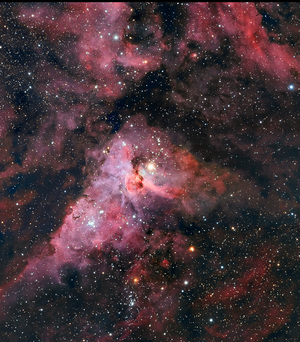
NGC 3372 - Eta Carinae
THIS IMAGE HAS BEEN PUBLISHED IN "AMATEUR ASTRONOMY" MAGAZINE SUMMER 2015 !!!!!!!!!!!!!!!!
The Carina Nebula is a large bright nebula that has within its boundaries several related open clusters of stars. The red star in the center of the image is currently the most luminous star in our Milky Way galaxy, possibly as much as 120 to 150 times the mass of the Sun, and emitting the light of 4,000,000 Suns. The nebula lies between 6,500 and 10,000 light-years from Earth in the constellation of Carina. This nebula is one of the largest diffuse nebulae in our skies. Although is some four times as large and even brighter than the famous Orion Nebula, the Carina Nebula is much less well known, due to its location in the southern sky.
This broad panorama of the Carina Nebula was composed as a 6 frames mosaic - my first mosaic project - for a combined exposure of 18 hours. I think, I had expent almost the same time processing it...
Many features, scattered across a spectacular celestial landscape of gas, dust and young stars have emerged.
Eta Carina is nearing the end of its life, and is surrounded by a huge nebula, cast off by numerous eruptions of stars over the last several centuries; it is expected to explode into supernova at any time. Would be this one of the last images of Eta Carina before the explosion?
Telescope: Meade LX850 12" f/8
Camera: SBIG STF-8300C
Date: April 2015
Exposure: 6 frames mosaic 108 x 10' = 18 hrs
THIS IMAGE HAS BEEN PUBLISHED IN "AMATEUR ASTRONOMY" MAGAZINE SUMMER 2015 !!!!!!!!!!!!!!!!
The Carina Nebula is a large bright nebula that has within its boundaries several related open clusters of stars. The red star in the center of the image is currently the most luminous star in our Milky Way galaxy, possibly as much as 120 to 150 times the mass of the Sun, and emitting the light of 4,000,000 Suns. The nebula lies between 6,500 and 10,000 light-years from Earth in the constellation of Carina. This nebula is one of the largest diffuse nebulae in our skies. Although is some four times as large and even brighter than the famous Orion Nebula, the Carina Nebula is much less well known, due to its location in the southern sky.
This broad panorama of the Carina Nebula was composed as a 6 frames mosaic - my first mosaic project - for a combined exposure of 18 hours. I think, I had expent almost the same time processing it...
Many features, scattered across a spectacular celestial landscape of gas, dust and young stars have emerged.
Eta Carina is nearing the end of its life, and is surrounded by a huge nebula, cast off by numerous eruptions of stars over the last several centuries; it is expected to explode into supernova at any time. Would be this one of the last images of Eta Carina before the explosion?
Telescope: Meade LX850 12" f/8
Camera: SBIG STF-8300C
Date: April 2015
Exposure: 6 frames mosaic 108 x 10' = 18 hrs
|
Messier 20 - Trifid Nebula
THIS IMAGE IS BEING USED BY "MEADE" TO ADVERTISE THE LX850 TELESCOPE IN Sky & Telescope Magazine !!!!!!!!!!!!!!!! The Trifid Nebula (M20 or NGC 6514) is an HII region located in Sagittarius, it was discovered by Charles Messier in 1764. Its name means "divided into three lobes". The object is an unusual combination of an open cluster of stars, an emision nebula (red portion), a reflection nebula (blue portion) and a dark nebula (the 'gaps' in the red portion). At magnitud 6.3, lies 5,200 light-years from Earth. Telescope: Meade LX850 12" f/8 Camera: SBIG STF-8300C Date: July 2015 Exposure: 24 x 10' = 4.0 hrs |
|
RCW 58
This beautiful and faint nebula in the southern constellation of Carina, surrounds and originates from a special type of star, a Wolf-Rayet star, WR40, the bright blue star in the centre of the image. WR stars are huge, perhaps as large as 20 solar masses. They lose mass as they evolve at an incredible rate, producing very strong solar winds. They are very hot with temperatures ranging from 30,000 to 200,000 Kelvin. Most of these WR stars are thought to progress to a supernova explosion. The nebula is referred to as a Ring nebula, due to its open appearance. Telescope: Meade LX850 12" f/5.7 (telecompressor Lepus 0.62X) Camera: SBIG STF-8300C Date: March 2016 Exposure: 34 x 10' = 5.7 hrs |
|
IC 2631
NGC 2440 is a reflexion nebula in the southern constellation Chamaeleon. The nebula is part of a vast complex of gas and dust full of young stars, located at around 500 light-years from us. The central star HD97300 is one of the more young and powerful of the region. Telescope: Meade LX850 12" f/5.7 (telecompressor Lepus 0.62X) Camera: SBIG STF-8300C Date: March 2016 Exposure: 27 x 10' = 4.5 hrs |
|
NGC 2440
NGC 2440 is a planetary nebula, one of many in our galaxy. Its central star, HD62166, is possibly the hottest known white dwarf. The nebula is situated in the Puppis constellation. It was discovered by William Herschel on March 4, 1790. He described it as "a beautiful planetary nebula of a considerable degree of brightness, not very well defined." The nebula is located about 1.23 kiloparsecs (3.79×1019 m) or about 4,000 light years from the Sun. Telescope: Meade LX850 12" f/5.7 (telecompressor Lepus 0.62X) Camera: SBIG STF-8300C Date: April 2016 Exposure: 18 x 10' = 3.0 hrs |
|
IC 2944 - Running Chicken Nebula
IC 2944, also known as the Running Chicken Nebula or the Lambda Centauri Nebula, is an open cluster with an associated emission nebula found in the constellation Centaurus, near the star Lambda Centauri. It features Bok globules (small black patches at the centre of the image), which are frequently a site of active star formation. However, no evidence for star formation has been found in any of the globules in IC 2944. Telescope: Meade LX850 12" f/5.7 (telecompressor Lepus 0.62X) Camera: SBIG STF-8300C Date: March 2016 Exposure: 32 x 10' = 5.3 hrs |
|
IC 2220 - Toby Jug Nebula
IC 2220, also known as the Toby Jug or Buttlerfly Nebula, is a reflection nebula located 1200 light years away in the southern constellation of Carina. Telescope: Meade LX850 12" f/5.7 (telecompressor Lepus 0.62X) Camera: SBIG STF-8300C Date: March 2016 Exposure: 47 x 10' = 7.8 hrs |
|
NGC 3324 - Gabriela Mistral Nebula
NGC 3324 is a star cluster, together with the associated emission and reflection nebulosity, at the northwest corner of the Eta Carina Nebula in the constellation Carina; is also called the Gabriela Mistral nebula, because of the striking resemblance with Nobel Prize winning Chilean poet. Do you think that the nebula resembles her? Telescope: Meade LX850 12" f/5.7 (telecompressor Lepus 0.62X) Camera: SBIG STF-8300C Date: February 2016 Exposure: 49 x 10' = 8.2 hrs |
|
NGC 5367
NGC 5367 is a reflection nebula associated with the cometary globule CG12 in the constellation Centaurus. CG12 "starts" at the image and extends to the upper right for more than 1°. CG12 was dicovered in 1976 on an ESO/SRC Sky Survey plate taken with the UK Schmidt telescope. In contrast to most other CGs, CG12 exists at a place in the Milky Way far away from the galactic disk - it has a galactic latitude of more than 21°. The two bluish stars responsible for the light reflected by the nebula are the double star H4636 (spectral type B4 and B7). Telescope: Meade LX850 12" f/5.7 (telecompressor Lepus 0.62X) Camera: SBIG STF-8300C Date: February 2016 Exposure: 42 x 10' = 7 hrs |
|
Puppis A
Puppis A is a supernova remnant about 100 light-years in diameter and roughly 6,500–7,000 light-years distant. Its apparent angular diameter is about 1 degree. The light of the supernova explosion reached Earth approximately 3,700 years ago. Although it overlaps the Vela supernova remnant, it is four times more distant. This target was not catalogued in TheSkyX, so I'd to manually enter the coordinates; then my 10' exposures shown only a star field, so I was not sure to had captured the faint nebulosity, ... but there it was. Hydrogen and nitrogen emissions can be seen in red, while oxygen filaments are seen in blue-green hues Telescope: Meade LX850 12" f/5.7 (telecompressor Lepus 0.62X) Camera: SBIG STF-8300C Date: February 2016 Exposure: 60 x 10' = 10 hrs |
|
NGC 3581
NGC 3581 belongs to the NGC 3576 complex, also known as "The Statue of Liberty Nebula" (NGC 3579, 3582, 3584 & 3586 are also part of it). It lays in the southern constellation Carina at around 6.000 light-years from Earth in the Sagittarius Arm of the Galaxy. It was discovered by John Herschel in 1834. Telescope: Meade LX850 12" f/5.7 (telecompressor Lepus 0.62X) Camera: SBIG STF-8300C Date: December 2015 Exposure: 16 x 10' = 2.7 hrs |
|
NGC 2035
NGC 2035 is another HII region in the Large Magallenic Cloud. The image shows clouds of gas and dust where hot new stars are being born and are sculpting their surroundings into odd shapes. But the image also shows the effects of stellar death, filaments created by a supernova explosion. At the top left of the image, two other interesting objects can also be seen: red-hued NGC 2014, and its blue neighbour NGC 2020. While they are very different, they were both sculpted by powerful stellar winds from extremely hot newborn stars that also radiate into the gas, causing it to glow brightly. Telescope: Meade LX850 12" f/5.7 (telecompressor Lepus 0.62X) Camera: SBIG STF-8300C Date: December 2015 Exposure: 43 x 10' = 7.2 hrs |
|
NGC 1935
NGC 1935 is an HII region in the Large Magallenic Cloud. This object is very close to NGC2070, the Tarantula nebula, that often gets more attention. It is located in the constellation Dorado at 170,000 light-years fromour system. Telescope: Meade LX850 12" f/5.7 (telecompressor Lepus 0.62X) Camera: SBIG STF-8300C Date: December 2015 Exposure: 28 x 10' = 4.7 hrs |
|
NGC 2070 - Tarantula Nebula
NGC 2070 also know as Taratula Nebula or 30 Dorado is an HII region in the Large Magellanic Cloud (LMC), a satellite galaxy to the Milky Way. The nebula is an extremely luminous non-stellar object, and contains in its centre a compact concentration of massive stars called R136. It is located in the constellation Dorado at 170,000 light-years from Earth. Telescope: Meade LX850 12" f/5.7 (telecompressor Lepus 0.62X) Camera: SBIG STF-8300C Date: November 2015 Exposure: 30 x 10' = 5 hrs |
|
NGC 602
NGC 602 is a young, bright open cluster of stars located in the Small Magellanic Cloud (SMC), a satellite galaxy to the Milky Way. Radiation and shock waves from the stars have pushed away much of the lighter surrounding gas and dust that compose the nebula known as N90, and this in turn has triggered new star formation in the ridges of the nebula. It is located in the constellation Hydrus at 196,000 light-years from Earth. Telescope: Meade LX850 12" f/5.7 (telecompressor Lepus 0.62X) Camera: SBIG STF-8300C Date: November 2015 Exposure: 20 x 10' = 3.3 hrs |
|
NGC 1360 - Robin's Egg Nebula
NGC 1360 is a planetary nebula that lies at 1,145 light-years away in the constelation Fornax, it is also known as Robin's Egg. Discovered in1863 by the german Friedich Winnecke was identified as a planetary nebula due to its strong emissions in OIII (oxygen) band; that is why it's prominent on the blue color. Telescope: Meade LX850 12" f/5.7 (telecompressor Lepus 0.62X) Camera: SBIG STF-8300C Date: December 2015 Exposure: 20 x 10' = 3.3 hrs |
|
NGC 7293 - Helix Nebula
The Helix planetary nebula or NGC 7293 lies at 700 light-years away in the constelation Aquarius, it is also known as the "Eye of God". The nebula was formed after the expulsion of the outer layers from the central star that is in the last stages of its stellar evolution towards a white dwarf. The red color corresponds to hydrogen while the blue is coming from the oxygen. Telescope: Meade LX850 12" f/5.7 (telecompressor Lepus 0.62X) Camera: SBIG STF-8300C Date: October 2015 Exposure: 32 x 10' = 5.3 hrs |
|
NGC 6723 & More
The globular cluster NGC 6723 (upper right) lies 28,400 light-years away in the constellation Sagittarius. Several objects can be found in the bottom half of the image: NGC 6726 (lower part of the bright nebula in the upper middle), NGC 6727 (upper part) and NGC 6729 (middle left) also known as Caldwell 68, is an emission/reflexion nebula, this is one of the closest star-forming regions of the galaxy at 420 light-years from Earth. In addition you can see the Herbig-Haro-Objects HH99 (the small dim red nebula above NGC 6729), HH100 (the "hook") and HH101 (the red nebula below the center). The dark boomerang-shape nebula (bottom left) is Bernes 157, it lies at 520 light-years. This image is a mosaic of 4 frames. Telescope: Meade LX850 12" f/8 Camera: SBIG STF-8300C Date: September 2015 Exposure: 4 x 18 x 10' = 12.0 hrs |
|
NGC 6164
NGC 6164 is an emission nebula located about 4,000 light years away in the constellation Norma. Although the nebula was believed initially to represent a planetary nebula, it is now understood to represent a shell-like ejected nebula, formed by the winds of its young central star. Telescope: Meade LX850 12" f/8 Camera: SBIG STF-8300C Date: September 2015 Exposure: 28 x 10' = 4.6 hrs |
|
NGC 6188 & Caldwell 82
NGC 6188 is an emission nebula located about 4,000 light years away in the constellation Ara. The bright and young open cluster NGC 6193 (left), is responsible for a region of reflection nebulosity within NGC 6188. NGC 6193 (Caldwell 82) and its emission counterpart NGC 6188 are seen in projection along the edge of a molecular cloud and immense expanding bubble of neutral hydrogen gas spanding some 300 light years. Ultraviolet radiation from the O-type giants of NGC 6193 is presently eroding the eastern edge of the parent molecular cloud and may be triggering and sustaining further star formation in other regions within it. Telescope: Meade LX850 12" f/8 Camera: SBIG STF-8300C Date: August 2015 Exposure: 24 x 10' = 4.0 hrs |
|
NGC 7023 - Iris Nebula
The Iris Nebula, is a bright reflexion nebula in the northern constellation Cepheus. NGC 7023 is actually the star cluster within the nebula, LBN 487, and the nebula is lit by a magnitude +7 star. It is located near the bright variable star Beta Cephei (Alphirk). It lies 1,300 light-years away and is six light-years across. This image was taken through a remotly operated telescope owned by iTelescope. The Iris Nebula has been in my list since a long time. Telescope: Takahashi 150 APO f/7.3 Camera: SBIG STF-8300C Date: August 2015 Exposure: 18 x 10' = 3.0 hrs |
|
Messier 17 - Omega Nebula
The Omega Nebula also known as Swan Nebula, is an HII region in the constellation Sagittarius. It was discovered by Philippe Cheseaux in 1745 and Chales Messier catalogued it in 1764. It is located in the rich starfields of the Sagittarius area of the Milky Way. It is considered one of the brightest and most massive star-forming regions of our galaxy. Its local geometry is similar to the Orion Nebula except that it is viewed edge-on rather than face-on. The open cluster NGC 6618 lies embedded in the nebulosity and causes the gases of the nebula to shine due to radiation from these hot young stars. At magnitud 6.0, lies 6,000 light-years from Earth. Telescope: Meade LX850 12" f/8 Camera: SBIG STF-8300C Date: August 2015 Exposure: 18 x 10' = 3.0 hrs |
|
Messier 16 - Eagle Nebula
The Eagle Nebula (M16 or NGC 6611) is a young open cluster of star in the constellation Serpens, it was discovered by Jean-Philippe Cheseaux in 1745. Its name derives from its shape that is thought to resemble an eagle. It contains several active star forming, gas and dust regions, including the famous "Pillars of Creation", photographed by the Hubble Space Telescope. At magnitud 6.0, lies 7,000 light-years from Earth. Telescope: Meade LX850 12" f/8 Camera: SBIG STF-8300C Date: August 2015 Exposure: 23 x 10' = 3.8 hrs |
|
Messier 8 - Lagoon Nebula
The Lagoon Nebula (M8 or NGC 6523) is a giant interstellar cloud in the constellation Sagittarius, it is clasified as an emission nebula and HII region. It is a star forming nebula that can be seen with the naked eye, open cluster NGC 6530 lies in the foreground. The object contains several Bok globules (dark collapsing clouds of protostar material). At magnitud 6.0, lies at 4,100 light-years from our Solar System. Telescope: Meade LX850 12" f/8 Camera: SBIG STF-8300C Date: July 2015 Exposure: 18 x 10' = 3.0 hrs |
|
NGC 5189 - Spiral Nebula
NGC 5189 is a beautiful planetary nebula in the constellation Musca. Seen through the telescope it seems to have an "S" shape, reminiscent of a barred spiral galaxy. NGC 5189 is symmetrical and lies 1,780 light-years from Earth. Telescope: Meade LX850 12" f/8 Camera: SBIG STF-8300C Date: June 2015 Exposure: 27 x 10' = 4.5 hrs |
|
Messier 78
M78 or NGC 2068 is a reflection in the constellation Orion, discovered by Pierre Mechain in 1780. This bright diffuse reflection nebula is part of the Orion Molecular Cloud Complex and is about 1,600 light-years from Earth. I had been always fascinanted by this object, I had patiently waiting until 2016 summer to image it myself. Telescope: Meade LX850 12" f/5.7 (telecompressor Lepus 0.62X) Camera: SBIG STF-8300C Date: March 2016 Exposure: 35 x 10' = 5.8 hrs |
|
NGC 3199
This nebula lies at about 12,000 light-years away, a glowing cosmic cloud in the southern constellation of Carina. NGC 3199 is about 75 light-years across, near the center of the ring is a Wolf-Rayet star, a massive, hot, short-lived star that generates an intense stellar wind. In fact, Wolf-Rayet stars are know to create nebulae. Telescope: Meade LX850 12" f/8 Camera: SBIG STF-8300C Date: April 2015 Exposure: 36 x 10' = 6 hrs |
|
NGC 2818 & Melotte 96
NGC 2818 is a beautiful planetary nebula, the gaseous shroud of a dying sun-like-star. It could well offer a glimpse of the future that awaits our own Sun after spending another 5 billion years or so steadily using up hydrogen at its core, and then finally helium, as fuel for nuclear fusion. The nebula seems to lies within an open cluster, Melotte 96 that is some 10,000 ligth-years distant toward the southern constellation Pyxis. But, truth is that only by chance NGC 2818 is found in the line of sight to the star cluster. Telescope: Meade LX850 12" f/8 Camera: SBIG STF-8300C Date: April 2015 Exposure: 9 x 10' = 1.2 hrs |
|
NGC 2736 - Herschel's Ray
The Pencil nebula is part of the Vela Supernova Remanent, located near the Vela pulsar in the constellation of same name. This faint object resided 815 light-years away from our solar system and it was discovered by John Herschel in 1835. This target was proposed to me by my friend Bruce Pipes that lives in USA and could not image it due to NGC 2736 south latitud. At the time he gave my this challenge, this type of objects was not even in my deepest dreams, but ... here it is !!! Telescope: Meade LX850 12" f/8 Camera: SBIG STF-8300C Date: March 2015 Exposure: 66 x 10' = 11 hrs |
|
NGC 2070 - Tarantula Nebula
The Tarantula Nebula or 30 Doradus is an HII region in the Large Magellanic Cloud that lies 160,000 light-year away from Earth. It is an extremely luminous non-stelar object, its luminosity is so great that if it were as close to our planet as the Orion Nebula , Tarantula would cast shadows. It's also the most starbust region known in the Local Group of galaxies. The closest supernova observed since the invention of the telescope, Supernova 1987A ocurred in the outskirts of Tarantula Nebula. Telescope: Meade LX850 12" f/8 Camera: SBIG STF-8300C Date: March 2015 Exposure: 57 x 3' = 2.8 hrs |
|
NGC 2359 - Thor's Helmet
NGC 2359 is an emision nebula that lies 12,000 far from Earth in the constellation Canis Major. The central star is a Rayet-Wolf type, an extremely hot giant thought to be in the pre-supernova stages of evolution, interaction with a neaby large molecular cloud are thought to have contributed to its complex shape and curved bow-shock structure. Telescope: Meade LX850 12" f/8 Camera: SBIG STF-8300C Date: February 2015 Exposure: 72 x 3' = 3.6 hrs |
|
NGC 3132 - Eight-Burst Nebula
This planetary nebula lies around 2,000 light-year away in the constellation Vela. In shape, size, form and brightness, NGC 3132 compares well with M57, and for that reason it is commonly called Southern Ring. Telescope: Meade LX850 12" f/8 Camera: SBIG STF-8300C Date: February 2015 Exposure: 60 x 3' = 3 hrs |
|
Messier 20 - Trifid Nebula
The Trifid Nebula or NGC 6514 is an HII region located in the constellation Sagittarius at 5,000 ligth-years away from Earth. This object is an unusual combination of open cluster of stars, an emisison nebula, a reflection nebula and a dark nebula. This image was taken through a remote telescope (T3) from iTelescope. Telescope: Takahashi TOA 150 f/7.3 Camera: SBIG STF-8300C Date: November 2014 Exposure: 6 x 10' = 1 hrs |
